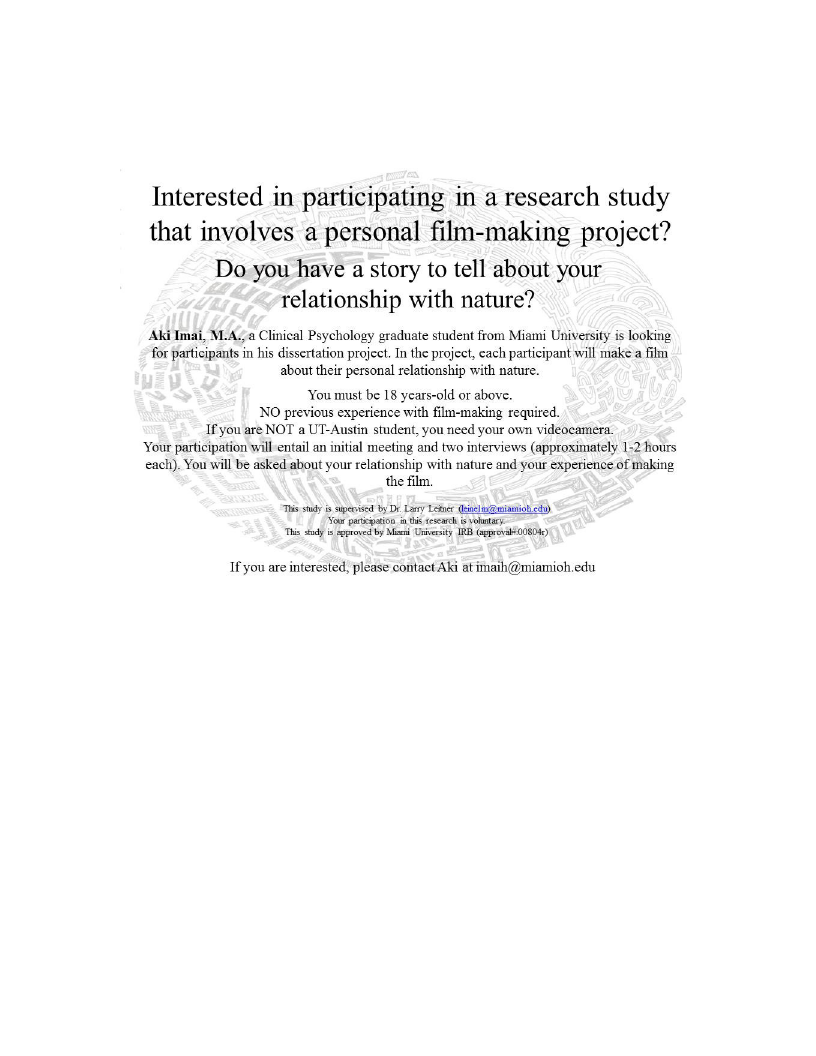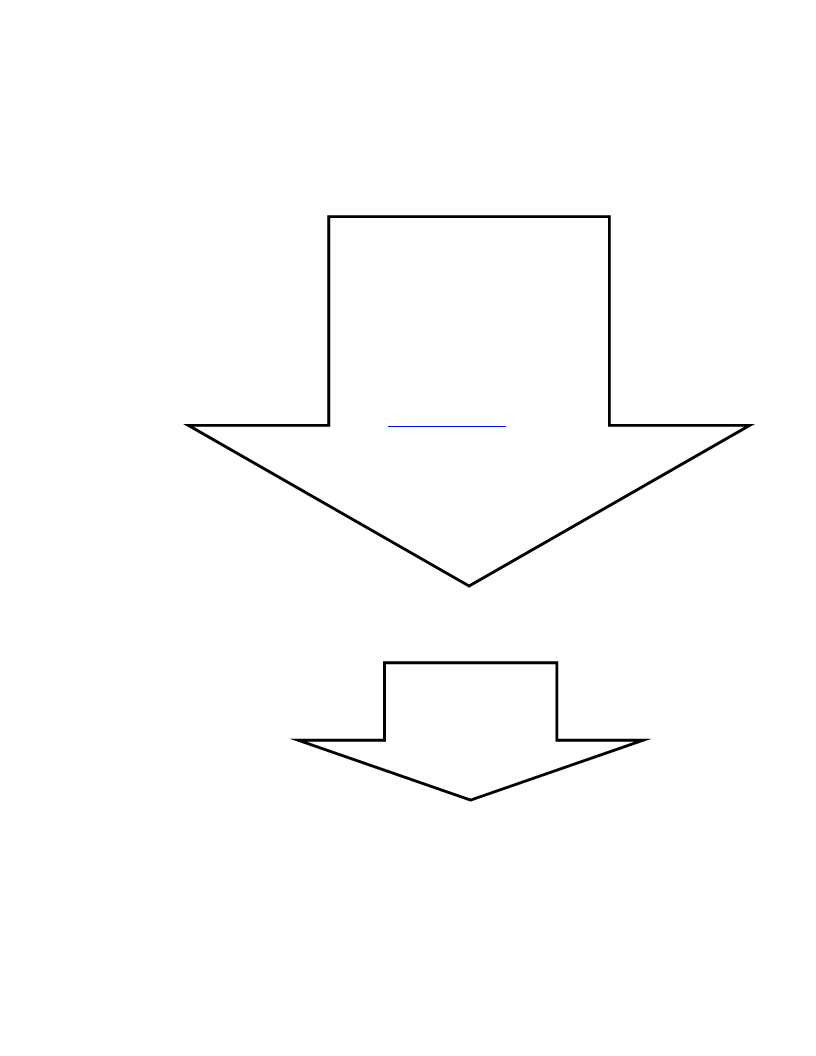
MIAMI UNIVERSITY
The Graduate School
Certificate for Approving the Dissertation
We hereby approve the Dissertation
of
Hideaki Imai
Candidate for the Degree
Doctor of Philosophy
______________________________________
Larry M. Leitner, Ph.D., Chair
______________________________________
Vaishali Raval, Ph.D., Reader
______________________________________
Deborah Wiese, Ph.D., Reader
______________________________________
Ann Fuehrer, Ph.D., Graduate School Representative

ABSTRACT
THE ROLE OF FILM-MAKING IN NATURE-HUMAN RELATIONSHIPS
by
Hideaki Imai
I conceived this study based on the premise that we need to improve our relationship with
the natural world. Based on my literature review, I argued that art-making could be
helpful in improving our nature-human relationships. I then explored the experiences of
four participants who made short films about their relationships with nature. I
interviewed these participants before and after their film-making experience, asking how
their nature-human relationships changed due to the film-making experience. I analyzed
my participants’ experiences using the framework of Experiential Personal Constructivist
Psychology (Leitner, 1985). Participants stated that, due to the film-making experience,
they could deepen the relationships with nature by becoming more aware and
appreciative of the nature in their lives. Participants’ experiences were also consistent
with Attention Restoration Theory (Kaplan, 1995), as they became more aware of
themselves and nature due to their film-making in nature. I discuss several implications
for Experiential Personal Construct Psychology, Attention Restoration Theory, and future
research.

THE ROLE OF FILM-MAKING IN NATURE-HUMAN RELATIONSHIPS
A DISSERTATION
Presented to the Faculty of
Miami University in partial
fulfillment of the requirements
for the degree of
Doctor of Philosophy
Department of Psychology
by
Hideaki Imai
The Graduate School
Miami University
Oxford, Ohio
2018
Dissertation Chair: Larry M. Leitner

©
Hideaki Imai
2018

TABLE OF CONTENTS
Introduction.……………………………………………………………………………….1
The Nature-human Relationship…………………………………………………..2
Experiential Personal Constructivist Psychology………………………………....7
Aesthetics………………………………………………………………………...12
My Own Film…………………………………………………………………….16
My Study…………………………………………………………………………21
Method…………………………………………………………………………………...22
Participants……………………………………………………………………….22
Procedure…………………………………………………………………….......23
Data Analysis…………………………………………………………………….27
Results……………………………………………………………………………………29
Miriam……………………………………………………………………………29
About Miriam…………………………………………………………….29
First interview……………….…………………………………………...29
The film…………………………………………………………………..35
Second interview……………...………………………………………….36
Answers to my research questions……………………………………….40
Alex………………………………………………………………………………41
About Alex……………………………………………………………….41
First interview………………....…………………………………………42
The film…………………………………………………………………..48
Second interview…………………………………………………………48
Answers to my research questions……………………………………….53
Melissa....…………………………………………………………………………55
About Melissa....…………………………………………………………55
First interview……………….…………………………………………...56
The film…………………………………………………………………..59
Second interview……………...………………………………………….62
Answers to my research questions……………………………………….65
Cassy......…………………………………………………………………………67
About Cassy..…………………………………………………………….67
First interview...……………….…………………………………………68
The film.………………………………………………………………….72
Second interview…………………………………………………………73
Answers to my research questions……………………………………….78
Discussion..………………………………………………………………………………79
Experiential Personal Constructivist Psychology (EPCP)…………….....82
Transpersonal reverence…………………………………………84
Transpersonal responsibility..……………………………………89
Clinical implications……………………………………………..90
Participants’ relationships with me………………………………92
Attention Restoration Theory.…………………………………………....93
Film-making about nature..………………………………………94
iii

Limitations and Future Directions………………………………………96
What I Learned..…………………………………………………………99
References………………………………………………………………………………101
Appendix A..……………………………………………………………………………108
Appendix B……………………………………………………………………………..109
Appendix C……………………………………………………………………………..112
Appendix D……………………………………………………………………………..116
Appendix E..……………………………………………………………………………117
iv

ACKNOWLEDGEMENTS
I have many people to thank as I present my dissertation in completion.
First and foremost, I want to thank my participants for being a part of this project. You
have shared with me intimate aspects of your lives and relationships. Without your
participation, I would not have a dissertation that I could present with honor.
I owe much to my family for the bottomless support they have been pouring since my
birth. In particular, I want to thank my late grandfather who was the first person to
encourage me to apply for a Ph.D. program. I want to scream to the heavens that I made
it this far, just as you believed.
I also need to thank my friends, Amy, Anna, Cliff, Jay, Jessica, Joanna, Lisa, Steve,
Tayler, and Xy for being my friends and helping me through challenging times. My
internship cohort, Erin, Chandni, and Janna also shared with me many moments that
fueled me to be a better person. My supervisors, Joey, Julie, Mark, Marla, and Yuko have
blessed me with their support on professional and personal levels. I cannot thank enough
for the many formative years with my graduate school friends including Cat, Emily, Joel,
Julia, Shruti, Suchi and Susan. I also would not be the person that I am today without my
friendship with Kat.
Thank you Larry Leitner for being a core part of my identity as a human being, a
psychotherapist, and now a Doctor of Philosophy. You have changed my career into a
calling.
v

The Role of Film-making in Nature-human Relationships
Human beings and the natural world are intricately connected. As we are in
relationship with nature, we humans need to treat nature well. However, human beings
threaten the health of nature by causing environmental degradation. Furthermore, human
beings depend on nature’s benefits, and will suffer the consequences of environmental
degradation if we do not improve our treatment of nature.
If we seek to improve our treatment of nature, we need to recognize our bond with
non-human beings. In this study, I provide a relational conceptualization of deepening
our relationship with nature. In doing so, I used previous literature to identify the key role
of aesthetics in our relationship with the natural world. Many researchers, theorists, and
artists discussed how aesthetics, our sense of beauty and ugliness, have the potential to
provoke our hearts to be passionate about our relationship with the natural world. Based
on the literature and my own experience, I found that one can practice one’s sense of
aesthetic in ecological art-making. I believe film-making to be an apt form of ecological
art-making, given that film-making helps us integrate our various senses in our
exploration of the natural world. I conducted a study where I asked participants to make a
short film about their relationship with nature and provided a relational conceptualization
of their film-making. Although many scholars have investigated ways to improve our
relationship with the natural world, no scholar has looked at film-making about nature
through a relational lens.
Before describing this study in detail, I will review the literature on how human
life and happiness depend on the benefits that nature offers to support the premise that we
are indebted to the natural world. I also will raise the problem that, even though nature
offers us benefits, our current treatment of nature is troublesome, as we have contributed
to environmental degradation. Giving examples of environmental degradations, I will
show the predicament of the planet and its effects on human beings. I then will introduce
some research with possible explanation about why humans have not treated nature
better. Afterwards, I will argue for the need to improve our treatment of nature.
After I establish that there is a relationship between human beings and the natural
world, I will present the theoretical rationale for paying further attention to the nature-
human relationship. Specifically, I will discuss Leitner’s (1985) Experiential Personal
1

Constructivist Psychology (EPCP) as a theoretical foundation to understand our
connection with the natural world. As EPCP primarily concerns interpersonal
relationships, I will explore the challenges of applying EPCP to our relationship with
nature. I then will discuss a premise in EPCP that the universe is interconnected,
including external events and internal processes. I will argue that, in the interconnected
universe, the beauty in the external world connects with our internal sense of aesthetics.
Based on my discussion of aesthetics, I will suggest that art-making about nature could
help people realize nature’s beauty and value. Specifically, I will introduce a study in
which the participants used film as the medium to enhance our relationship with nature.
Finally, I will offer a personal example of ecological art-making in the form of a
film about my relationship with nature. I discuss my own creative process to provide an
example of film-making that can be used in a psychological study. In doing so, I will
provide a detailed summary of the video, a thorough account of the process in which I
created the video, and how it helped me reconstruct my relationship with nature.
Before I move into my theoretical rationale and literature review, I often use the
terms “nature” “natural world” to refer to the sum of beings and things that are not
human, such as the flora, fauna, and the land itself. Furthermore, I will not be using “his
or her” whenever I describe a generic person to avoid the gender binary. Instead, I will be
using gender-neutral terms, such as “one’s” or “a person” to refer to persons with
unknown gender.
The Nature-human Relationship
Oxygen is a basic human necessity; it is also a result of photosynthesis by plants.
During the process, the trees capture sunlight, turning it into sugar. Adding carbon
dioxide, the plants make oxygen that enables animal life to survive on earth (Suzuki,
2012). Furthermore, our interaction with natural light is responsible for our circadian
rhythm (Mantler & Logan, 2015). Human life depends on the health of the planet.
Humans also have power over the state of nature, as we can protect the environment
through conservation efforts or destroy non-human communities through industrialization
and urbanization (Jensen, 2011). As such, the nature-human relationship is symbiotic. We
need to care for our relationships with the non-human lives on this planet, because
2

nature-human relationships keep both sides alive and healthy. If we can continue to help
non-humans exist, we can continue to enjoy the necessities we need to survive.
In the context of psychology, Wilson (1984) discussed a psychological dimension
of the nature-human relationship in the form of the “biophilia” hypothesis: human beings
have an “innate emotional affiliation to other living organisms” (p. 56). Supporting
Wilson’s hypothesis, 55% of households in the United States have animals (Beck &
Meyers, 1996), many of whom we consider as close family members, especially when we
include them in core family activities, such as sleeping in the same bed or confiding
secrets (Beck & Katcher, 2003). Thompson and Gullone (2003) found that a child’s
direct contact with animals predicts nourishing empathy and prosocial behavior as an
adult.
In addition to non-human animals, we also have an emotional affiliation with the
environment. We experience psychological benefits if we immerse ourselves in the
wilderness. For example, Capaldi, Dopko, and Zelenski (2014) conducted a meta-analysis
in which they found that people experience less depression and anxiety when they report
high subjective connection with nature. Dutch scholars also conducted a study where they
found that Dutch residents who lived far away from green areas were 25% more at risk
for feeling depressed and anxious than those who lived in predominantly green areas
(Maas, Verheij, de vries, Spreeunberg, Schellevis, & Groenewegen, 2009). Greenway
(1995) conducted a study in which he examined 1,400 participants who went through a
two-week long wilderness course. Based on interviews and questionnaires, he found that
the participants experienced an enhanced sense of aliveness, well-being, and energy.
Finally, Kuo and Sullivan (2001) found that living in a nature-abundant environment is
associated with prosocial behavior for residents in urban public housing developments.
Those who live in areas with trees showed better communication skills, stronger bonds
with their neighbors, and a higher solidarity with their overall community in comparison
to residents who preferred treeless areas. From their results, Kuo and Sullivan concluded
that our bonds with the nature extend to our human-to-human interactions.
Despite the physical and psychological benefits offered by the natural world,
human influence often leads to environmental degradation (Stokols, Misra, Runnerstrom,
& Hipp, 2009). For example, the Intergovernmental Panel on Climate Change (IPCC,
3

2014) associated climate change with an increase in intense hurricanes, droughts, and the
rise of sea levels. IPCC surmised that human activity likely caused more than half of the
rise in global average surface temperature from 1951 and 2010. We now have the
warmest climate ever recorded (National Aeronautics and Space Administration, 2016).
Jensen (2011) stated that our economic system is one factor in climate change; we seek to
expand our “growth-based” economy by excessively consuming and expending natural
resources. As we consume energy, we burn excessive fossil fuels, releasing CO2 in the
atmosphere, changing the global climate. However, we allow, through economic
incentives like our tax policy, corporations that facilitate such consumption to ignore the
extent of their pollution, and contribute to climate change without accountability
(Leonard, 2010). Without mending our ways, we could further contribute to climate
change with hazardous consequences.
As another example, dryland salinity degrades the environment. The term refers
to the high accumulation of salts in the land and water. Through urbanization and
agriculture, humans have contributed to higher salt levels in the soil and water
(Speldewinde, Cook, Davies & Weinstein, 2009). As the saline level makes it difficult for
plants to absorb water, native vegetation and biodiversity deteriorate (New South Wales
Department of Water and Energy, 2009). The National Land and Water Resources Audit
found dryland salinity in 1 million hectors of the southwest agricultural zone of Australia
and predicted it will increase to 5.4 million by 2050 (NLWRA, 2001). Speldewinde,
Cook, Davies and Weinstein (2009) investigated the mental health impact of dryland
salinity by examining multiple health databases of a particularly affected region. They
found that residents in areas with high dryland salinity were more likely to experience
psychiatric hospitalizations. The authors provided one theory to explain their results:
given the salinity, the land became unsuitable for farming, compromising the livelihood,
land values, and productivity of the residents and farmers, thereby affecting the mental
health of the community.
Researchers have found other evidence of human influence in environmental
degradation in the phenomena of droughts. Similar to dryland salinity and climate change,
droughts are slow but devastating in the long-term (Vins, Bell, Saha & Hess, 2015).
Droughts destroy biodiversity and have hazardous effects for plants, animals, and human
4

beings, with effects such as increased risk for asthma, poor hygiene, loss of agricultural
productivity and endangered food security. Vins et al. (2015) also reviewed 82 journal
articles about the mental health effects of drought exposure. They found that participants
in these studies often experienced depression and anxiety due to drought exposure. From
the aggregate findings, they identified a common pattern in droughts’ effects on mental
health: droughts often necessitated participants to migrate from their home environment
and pose economic difficulties, leading to changes in their sense of community.
Thus, human-influenced environmental degradation has hazardous effects both
for non-humans and humans. In fact, researchers have found that our psychological well-
being diminishes as we degrade the natural world further. Albrecht et al. (2007)
examined the relationship between psychopathology and environmental degradation. The
authors observed that people often lose the link to their homes as their local environments
deteriorate. They coined the term “psychoterratic” illness and defined it as “earth-related
mental illness where people’s mental well-being (psyche) is threatened by the severing of
‘healthy’ links between themselves and their home/territory” (p. 95). We lose our “homes”
as we change our familiar landscapes and biodiversity through urban development. The
authors used the term “solastalgia,” to refer to the longing for our homes that we lost,
because the place has changed so much due to incessant development.
For example, residents and workers of New South Wales in Australia experienced
solastalgia when the coal-mining and power industries expanded and changed the
environment. Energy companies had built large power stations in the region for decades;
they polluted the regional landscape, sickening the residents and the workers who were
exposed to toxins. One of the respondents said that she received a doctor's advice to flee
the area, due to ingesting black smoke and hurting her respiratory system. Another
respondent reported that she also had to escape her hometown; because she felt married
to the land, she now feels like she is going through a “divorce.” As the power-industries
expanded, respondents saw their beloved land become polluted and unlivable. As a result,
the respondents experienced a loss in their sense of place.
Broto, Burningham, Carter, and Elghali (2010) also reported that environmental
degradation has hazardous consequences for one’s place-based identity. Specifically, they
presented a case study of coal ash pollution in Tuzla, a town in North-East Bosnia where
5

industrial development has been on the rise since the 1960s. The authors conducted semi-
structured interviews with 51 residents. Many interviewees complained of the coal ash
pouring into their houses. Before the development of the coal ash industry, greenery was
a major characteristic of Tuzla; growing vegetables in the garden was a popular
household activity. In their downtime, citizens of Tuzla commonly enjoyed drinking tea
in their gardens. However, now they cannot enjoy such activities without the ash falling
into their cups of tea. One interviewee expressed her sense of loss. Her flowers are now
all gone, and “now everything is unhealthy” (p.11). Another interviewee also lamented
the stigma that now is associated with Tuzla. He said that others make fun of his town for
losing the greenery that it once had. The authors concluded that the coal ash industry
altered the relationship between the town and its place. Thus, the Tuzla residents
experienced a detrimental impact of environmental degradation on their psyches.
Because nature helps human lives, I was confused about why we have not stopped
contributing to environmental degradation. Interestingly, researchers have found that
people who appreciate the environment do not necessarily act to protect it. For example,
Thompson and Barton (1994) claimed that there are two attitudes towards the
environment: ecocentrism and anthropocentrism. One is ecocentric when one hopes to
protect the environment for its own sake. The ecocentric person believes that the
environment has intrinsic value. In contrast, one is anthropocentric when one hopes to
protect the environment for the sake of human beings. The authors predicted that those
who lean towards anthropocentrism would engage in less environment-protective
behaviors than those who lean towards ecocentrism. They distributed short questionnaires
to 129 persons in an American airport. The short questionnaire assessed participants’
beliefs, behavior, affiliation with environmental organizations, and the reasons for their
environmental concern. From the results, the authors concluded that ecocentric
participants endorsed more conservational behaviors, belonged to environmental
organizations, and reported less environmental apathy. In contrast, participants with
anthropocentric attitudes endorsed less conserving behavior and less affiliations with
environmental groups, thus supporting their predictions.
Nisbet and Zelenski (2011) also explored why many people are less inclined to
engage with nature. The authors hypothesized that people hesitate from interacting with
6

nature because they underestimate the benefit they gain from interacting with natural
environments. To test this hypothesis, the authors assigned two groups of participants to
walk in an indoor path (a tunnel), or an outdoor path (arboretum), respectively, and
measured how much positive affect participants anticipated by walking on the two paths.
After the participants walked in the two paths, the authors then measured the extent to
which the participants felt positive affect due to their walks. In the results, the authors
found a statistical interaction: the outdoors group experienced more positive affect than
they anticipated. In contrast, the indoor path group experienced less positive affect than
they anticipated. The authors concluded that people tend to underestimate the benefits of
walking outdoors and engaging with the natural scenery and thus often hesitate from
enjoying the full benefits of nature.
Through human interference, we have become more hurtful and distant in our
relationship with nature. Given that our environment is under threat, psychologists need
to investigate how we can overcome environmental apathy and deepen our empathy for
the natural world. Many psychologists have started to investigate the environmental crisis
in a new subfield of psychology, ecopsychology. In ecopsychology, scholars explore the
link between ecology and psychology. They pay attention to humans’ relationship with
nature (e.g. Fisher, 2002). We see that our severed relationship with the environment is
one common theme that emerged from the literature review above (Albrecht et al., 2007;
Broto, Burningham, Carter, & Elghali, 2010; Vins, Bell, Saha & Hess, 2015). In this
study, I will qualitatively explore one way of improving our relationship with nature and
offer a relational conceptualization of how we deepen our ties in the framework of
Experiential Personal Constructivist Psychology (EPCP).
Experiential Personal Constructivist Psychology
EPCP may be an appropriate theory to analyze our relationship with the natural
world, because it attends to the dynamic of diverse beings engaging in deep relationships.
EPCP stems from George Kelly's Personal Constructivism. Kelly (1955) argued that we
are meaning-making creatures who build a “construct system,” a system of meanings
through which we see the world. Kelly’s sociality corollary serves as the basis for EPCP:
“to the extent that one person construes the construction process of another, [that person]
may play a role in a social process involving the other person” (p. 95). Based on the
7

sociality corollary, Leitner (1985) argued that we make meaning together through
relationships. On the one hand, one can engage in a relationship with another, which
could be affirming in profound ways, but with the possible caveat of being hurt as well.
On the other hand, one can stay away from relationships, and be safe from relational
injuries while also missing the richness offered by relationships. In the EPCP framework,
one needs to engage in affirming relationships, “ROLE relationships” to live a rich and
meaningful life (Leitner, 1995, 1999; Leitner & Faidley, 1995). In a ROLE relationship,
two or more persons understand each other’s core constructs and construal processes.
Leitner and Faidley (1995) explained further that one can best understand
another’s construal process by understanding another’s core “ROLE constructs” (p. 263).
They explained that ROLE constructs are “the most important constructs involving our
sense in relation...These constructs form the foundation of the interpersonal world.”
(p.293). In my interpretation, the phrase “interpersonal world” (italics added) implied that
meaningful ROLE relationships include interpersonal relationships, human-place
relationships, and human-nature relationships. Furthermore, I contend that Leitner and
Faidley’s phrase “our sense in relation” means our sense of connection with humans and
non-humans, as they do not specify with whom we connect. In fact, many researchers
have found that their participants often express high degrees of feeling connected with
nature (Davis, Green & Reed., 2009; Dutcher, Finley, Luloff, & Johnson, 2007). As an
example, participants in Albrecht et al.’s (2007) study showed that they had intimate
connections with their homeland as they spent much time in one place, knowing its
history, and caring for its future. As mentioned above, one of the participants used the
word “divorce” to describe her escape from a polluted land she once called home,
showing a deep connection with the environment. Jacquet and Stedman (2013) offered
one explanation for how people can have a deep connection with a place. They stated that,
when one has self-defining experiences in one location, the inert landscape changes into a
“symbolic extension of self” (p.1287). Jacquet and Stedman stated that a place becomes
an interconnected network of meanings, as its residents imbue stories to their physical
environments. What is otherwise an inert milieu changes to a part of our meaning making
system.
8

In the framework of EPCP, we run into some problems when we conceptualize
being in a ROLE relationship with a place. To be in a ROLE relationship means for one
to understand the construal process of another, as well as the other person understanding
one’s construal processes. If the other is a place, the place must construe my process and
I must construe the place. However, one may find it hard to think the place can construe
my processes, or that the place has a construal process for me to understand. Two people
in an intimate relationship can feel that they understand each other’s fundamental
worldviews, and perhaps express that they mean a lot to each other. However, a place
will never utter words to me in the human language or indicate that it is “listening.”
Hence, we have two problems: (1) how the place could “understand” our construal
process and (2) how I, a human being, can understand the construal processes of the place
if we could establish that it has anything that resembles “construal processes.”
In response to the problem of how the place could understand one’s construal
process, I will acknowledge simply that I may not be able to show that a place can
understand my construal processes in the way I understand another person’s processes. I
would argue that we engage in a special type of relationship with places, perhaps like the
therapist-client relationship, in that all parties bring vital aspects to the encounter, but in
different forms. In the therapeutic ROLE relationship, Leitner (2006) stated, “The client’s
aliveness is the essential issue here while the therapist’s professional constructions
facilitate the work of the therapy” (p. 91). Clients present their concerns based on the
trust they have for the therapist, while the therapist tries to construe the client. Similarly,
in our ROLE relationship with the environment, we will notice that our environment is
under threat, much like how a therapist construes the client extensively and recognize the
client’s suffering. In turn, a place may not understand our construal process extensively,
much like a client does not understand many aspects of the therapist’s construal
processes. However, this does not change the fact that the place needs help.
In response to the problem of how I can understand the construal process of a
place, I may not be able to prove that a place has a construing process, but I argue that
our construal processes are not too different from the processes in nature. I base my
argument on Kelly’s (1955) observation that natural processes are like our construing
process. For example, Kelly has stated that the “universe is continually changing with
9

respect to itself” (p. 7). About human construing, he stated, “When constructs are used to
predict immediate happenings, they become more susceptible to change or revision”
(p.13). From the statements above, Kelly implies that our construal processes and the
universe both have change as a common characteristic. Furthermore, Kelly went further
than saying they both change, as he pointed out changes in nature is linked with human
construal. He stated,
Perhaps [a person] perceived orderliness in the stately procession that marched
across the night sky. Perhaps [a person] first saw replication in the rolling of a
stone along the ground and, from its rapid succession of events, was able to
construct the notion of cycles and epicycles. (p. 74-75)
In the excerpt above, Kelly stated that perhaps we make constructs based on
changes we see in the universe. According to Kelly, processes in the universe may be a
blueprint for our construct system.
Abram (2010) illustrated a point similar to mine when describing the time that he
hiked in the Rocky Mountains. He found himself in the wilderness, walking through the
woods, and gazing upon the sky. After immersing himself in nature, he realized that the
processes in his mind were intricately tied with the shadow of the woods or movements
of the clouds. His thoughts and the natural world moved together, given that he was
“thinking with [his] senses” (p.112). As the indeterminate clouds peeked in and out of his
vision, so did his thoughts appeared and disappeared from consciousness. He said,
I was beginning to glimpse a complex array of images for mind itself, visible
patterns of mental process far more fitting than neurological categories and
mechanical descriptions…Here, all around me, was a field of patterned metaphors
as precise as one could want for the dynamic life of the psyche” (p.113).
In this quotation, Abram found that his construal processes closely resembled the
objects and movements he perceived in the natural world. He speculated that the things,
living beings, and their interactions in the natural world are the model for our minds.
Abram’s story exemplified the emerging embodied cognition literature (e.g., Anderson,
2003). From the perspective of embodied cognition, our construal processes emerge from
the processes that we see in the natural world. Such natural processes are integral to our
construal process; we make meaning with nature.
10

While this may not mean that we understand nature’s construal processes, we are
looking at processes in nature that resemble our construal processes. One may object that
Abram’s demonstration is not satisfactory to establish that nature has a construal process
for us to understand. However, interpersonal interactions also face the same problem
where we cannot “see” or truly know that others are construing. In interpersonal
interactions too, we can only see processes that seem like our own construal processes.
Therefore, the objection that we need a proof is an impossible criterion to meet, whether
it is for human-nature relationship or interpersonal relationships.
Based upon this, one of the primary questions for my study is whether people can
form ROLE relationships with the natural world. I explored that question based upon my
interviews with participants. As stated above, I needed to find evidence from my
participant’s experience that they construed nature’s processes. In addition, I sought
evidence in participants’ statements about whether nature construed their processes. If I
did not have sufficient evidence, I planned to develop an alternative understanding of the
relationships between humans and nature.
If I can have a ROLE relationship with a place, and care for its well-being, then I
also need to care for the well-being of the planet, as ecological processes in one place are
connected to the planetary ecosystem at large. If I am maltreating nature in one location,
then I am maltreating nature in the planet at large, as the world is an amalgamation of
diverse beings all in interaction with one another, or an interconnected and integral
universe. In the context of constructivist psychology, Kelly (1955) introduced the concept
of integral universe as a philosophical assumption. Others have also discussed similar
ideas (e.g., Cambray, 2006; Richards, 2001). Kelly illustrated his idea of the
interconnected universe stating that there exists a connection between the price of yak
milk in Tibet and his typewriter in Ohio. Though he admits that it is implausible at first,
he concludes, “But...in the long run, all of these events – the motion of my fingers, the
action of the keys, and the price of yak milk – are interlocked.” (Kelly, 1955, p. 7) Kelly,
hence, stated that every action has repercussions throughout the world.
EPCP theorists (Leitner, 2010, 2012; Leitner & Hayes, 2015) elaborated Kelly's
notion of the integral universe. Leitner pointed out that Kelly was opposed to behaviorist
theories, and hence contended that Kelly did not limit “actions” to mean only the “outer”
11

physical movements. Given Kelly’s anti-reductionist views, his definition of “action”
also would include one’s inner experiences. Leitner stated, “My 'actions' then consists of
things I am doing, the things I am thinking, the things I am feeling, and so on. Thus, my
feelings about a person I care for...are even now affecting the universe in ways that I
cannot comprehend” (Leitner, 2010, p. 227). Leitner’s inclusion of thoughts and feelings
has important implications for the human-nature relationship, namely that human beings’
internal processes interconnect with external events that occur in natural world.
Aesthetics
Sewall (2012) called for psychologists to explore art and aesthetics, especially in
the context of deepening our relationship with nature. Sewall stated, “In the context of
widespread environmental degradation, a relevant and responsible psychology must
include whatever inspires and motivates us—making us gasp, weep, and desire. Our
hearts must be triggered, and our bodies and emotions engaged” (p.280). Sewall based
her idea on her observation that we find it difficult to “gasp, weep, and desire” for nature
in modern Western culture. We tend to think and act in individualist and materialistic
ways that shift our attention away from nature. Furthermore, as our technology advances,
we do less exploring and participating, and more passively consume information often
from looking at immobile flat screens in front of us. The more familiar we are with flat
screens, the more we lose the depth perception and attention to appreciate the complex
terrains of the natural landscape. However, Sewall stated that if we commit to viewing
and interacting with the natural world, the rich stimuli therein invoke our attention such
that it restores our capacities for perception and attention. Scholars called such idea the
Attention Restoration Theory (ART; Kaplan, 1995). The theory arose as researchers
demonstrated that nature-related media can restore one’s fatigued general attention. For
example, Hartig, Korpela, Evans, and Garling (1997) found that participants who were
exposed to natural environments showed increased restoration of their attention,
compared to when they were exposed to artificial environments.
In another ART study, Berto (2005) exposed college students to two kinds of
photographs (nature scenes vs. non-nature scenes). She measured the participants’
attention span before and after exposure to the photographs. As one would expect from
ART, Berto found improvement in attention capacity only for students who watched
12

photographs of nature scenes. Adding to Berto’s findings, Sewall spoke from her
personal experiences that she improved her attention capacity and appreciation for nature
by going outside and studying beautiful objects, beings and patterns in the natural world.
Based on research and her personal experience, Sewall stated that the act of finding
beauty will lead us to pay more attention to nature and avoid further degradation.
I need to be clear about what I mean when I use words like “beauty” or
“aesthetics,” as these concepts are central to my project. I do not simply use the word
“aesthetic” to refer to the state of “relating to beauty.” The word “aesthetics” comes from
the Greek words “aisthanesthai (to perceive) and “aistheta” (things perceptible). The
etymology suggests that our sense of aesthetics is historically connected to noticing and
interacting with perceptible things. Of course, each person has different personal, societal
and cultural values that influence what is beautiful or ugly. When one person meets
another, one construes the other person as beautiful or otherwise based on the perceiver’s
unique sense of beauty. At first, one might think that the perception of beauty is one-
sided, as if only the perceiver is construing. However, the perceived person also presents
one’s appearance based on a construal process. In this way, perception of beauty is
interactive. As with any interaction, we have a choice of whether to become closer to an
“other.” As our relationships deepen, we find new aspects of the person. When we find
aspects of another that we find beautiful, we become fonder of the relationship. For these
reasons, I define beauty as the qualities that we find in others, to desire a closer, deeper
relationship.
Conversely, I define ugliness as the qualities that repel us from others. We may at
first notice aspects of a person that we find ugly. However, as the relationship becomes
deeper, we may understand that whatever we judge as ugly is superficial, or that it comes
from injuries. As a case example, Leitner (1985) discussed a client, “Tim,” who
philandered from one woman to another. Tim treated women as an object of conquest. As
soon as he was done sleeping with them, he would cut ties with them. Leitner pointed out
Tim’s way of relating to others was limited, in that he could not understand the
experiences of the women with whom he slept. However, after six months of therapy,
Tim told Leitner that he found a beautiful woman “trapped inside an ugly body” (p.93).
13

As Tim understood relationships in a deeper way, he became able to see the beauty inside
an ugly exterior.
Based on my definition of ugliness, there are countless events that happen in
nature that repel us from the natural world. From natural disasters to mosquito bites, we
experience annoyance, pain, and deaths because of natural forces. In contrast to biophilia,
Macy (1995) stated that some of us may be inclined to be fearful to the point we
disengage with nature to avoid its horrors, using the term “biophobia.” However, as the
“Tim” example shows, if we can learn to relate in meaningful ways, the ugliness that
bothered us may not hinder us from embracing the beauty of nature. Leitner (2009) states
that being in a ROLE relationship means also to understand the construal process of the
other person, even when it might seem ugly. Though we may have many of unpleasant
contacts with nature, we should not immediately decide to turn away. Of course, some
people can be so repulsive that I should avoid them. In a similar way, some parts of
nature could be so ugly that we should not be near them, but we should not be turning
away from nature based on the ugliness of some aspects.
Constructivists also have discussed seeing the world in aesthetic ways. For
example, Thomas and Schlutsmeyer (2004) based their concept of the “aesthetic eye” (p.
316) on their interpretation of Kelly’s (1955) description of construing, when he stated,
“Only when [a person] attunes [one’s] ear to recurrent themes in the monotonous flow
does [one’s] universe start to make sense. Like a musician, [the person] must phrase
[one’s] experience in order to make sense out of it” (p. 52). From Kelly’s statement
“phrasing one’s experience,” we see that the process of construing is an act of abstracting
patterns in the universe. Thomas and Schlutsmeyer interpreted Kelly's attunement as “a
felt sense of being touched by something beyond me, a sense of awareness of my
finiteness in the total cosmos, a sense that something else is there that goes beyond any
universe we can comprehend or ever fully understand” (p. 316). In this way, Thomas and
Schlutsmeyer termed the attunement to the recurrent flow of the universe as the
“aesthetic eye” (p.316). With the aesthetic eye, we see the sensual and artistic side of
others, and gasp at the awe of their processes. Through the aesthetic eye, to be in a ROLE
relationship with another person means to see the beauty in the ways the other makes
meaning of the world. The other person also will shape the world with an aesthetic eye.
14

We can contrast the aesthetic eye to the literal understandings of a human being
that breaks down a person into isolated variables. With the aesthetic eye, one sees another
person as a holistic moving picture. Through the aesthetic eye, we can accept the
mysterious aspects of another human being. If we do not understand one part of a person,
we do not force the differences to conform to our literal framework. In the process, one
becomes impoverished looking for a concrete explanation, eventually feeling distant from
the other person. As opposed to the purely literal attempt, one can wonder at the mystery
with the aesthetic eye.
Kelly (1955) said that to construe is to attune to the recurrent themes of the
universe. A person construes not only their interactions with human others, but the
various processes in the world that are larger than human-to-human interactions. A
person can use the aesthetic eye to see the natural world and respect the mysterious
processes of the natural world therein. Kelly’s premise that every action has
repercussions implies that we cause ripples in places hidden from us, as a large part of the
universe remains mysterious to human beings. However, seen aesthetically, we would
accept the mystery and be humbled by the mysterious forces that are more than human.
Through the aesthetic eye, the ocean would not be a convenient dumping ground
for our toxic waste. The earth would not be a storehouse of resources that exist for human
consumption. With the aesthetic eye towards the planet, we can see the beauty in natural
beings and their connections. The place that I live, the soil that I stand on, or the trees that
surround me will not appear as isolated and static; rather, I will come to see them as an
artistic creation -- developed, created, by something else. I will come to see that the world
is a living art piece made with different materials, patterns, and energies all
interconnected. By noticing the world’s art, I acknowledge that creativity is a force of
nature, human or otherwise.
By using the aesthetic eye and rediscovering nature’s beauty, we can be
enchanted with the significance of nature in the lives of human beings (Berry, 1988). We
could become more willing to relate with nature if we have sensuous experiences in the
natural world. In art-making, we use our bodily senses to create something that we see as
beautiful. Based on my definition of beauty, our art piece will be something with which
we will desire an intimate relationship. If the art piece is about the natural world, we will
15

desire to cultivate a stronger relationship with nature. If we can make art according to our
own sense of beauty, our participation will induce a sensual appreciation for nature’s
beauty (Matilsky, 2000). Many others (e.g. Hillman, 1995; Kidner, 2012; Richards, 2001)
echoed Anderson and Guyas (2012), stating that one can realize the beauty in the
environment with art-making. In art-making, we become attuned to our own unique sense
of aesthetics and become comfortable with whatever material we use. Through art-
making, we could be in a closer relationship the natural world.
Scholars recently have attempted to enhance the connection with nature through
film-making. Harness and Drossman (2011) investigated the role of film-making in
facilitating ecological literacy among at-risk high-school youths.
After film-making, students stated that they became more active in protecting the
environment. According to the students, through the film making experience, they gained
an experiential understanding of caring for and protecting the environment. While other
researchers (Bahk, 2011; Barbas, Paraskevopoulos, & Stamou, 2009; Lowe et al., 2006;
Nolan, 2010; Norman, 2000) investigated the effect of viewing films on the environment,
Harness and Drossman are the only researchers to study the effect of film-making itself
on our relationship with nature. Harness and Drossman stated that there is great potential
in environmental film-making to understand our actions toward the environment. As they
were the first to study the effect of environmental film-making, they urged others to
research further about environmental film-making.
My Own Film
After reading Harness and Drossman (2011), I decided to make a film about my
connection with the natural world, using my own sense of aesthetics. Below, I provide a
detailed account of my film-making process. I have three purposes in telling this account.
One, I will attempt to integrate my scholastic knowledge about nature with my personal
story using my own sense of aesthetics and show that film is a good medium for
combining self-expression and research. Second, because I planned to have my
participants make films, by providing a detailed account of my own experience, I hoped
to have an informative account that I could share with my participants about how they
can make their own films. Third, as a qualitative researcher, I have the responsibility to
tell my own story about how I made my art, when I asked others to use art to tell their
16

stories. I do this in the spirit of acknowledging my own values and perspectives as a
researcher, an important step in qualitative research (Leitner, Hayes & Imai, 2015).
I decided to make an autobiographical film about my relationship with the natural
world. In doing so, I reflected deeply about my past and how I struggled to connect with
natural beings and entities. I attribute my struggle to the five major relocations between
Japan, England and the United States. Torn between different cultures, I became obsessed
with questions about identity and my place in the world. As I moved from one place to
another, I gradually became distant from the natural world. Connecting with nature felt
too real, and I also had to face its fragility – I realized that everything that is alive will
eventually perish, and that with whatever connection I make, I also will risk
disconnection. Eventually, I developed a preference for spending time in industrial
landscapes as I found a sense of invulnerability in their geometric shapes.
However, as I became an adult, I felt increasingly hollow as I lived within these
industrial landscapes. I only recently rediscovered the richness and wonder that
characterize the relationship with the natural world. I found that I can enrich my life by
enrooting myself in my local community. I found my roots stronger and more stable as I
walked the trails behind the Psychology Building and interacted with the natural world
that existed far earlier than the establishment of Miami University. I went to the local
farmer's market, bought food from the local farmers, and realized that the taste in my
mouth and the food in my stomach come from the farmers that I talked to and the land
that I lived on. When I adopted a cat, I realized that I was not alone and that I live on this
planet with other beings. Through these experiences, I felt less detached and alien in this
interconnected universe.
I captured my story in my film, “At home with Kale” (Imai, 2013: viewable at
https://youtu.be/EHPt4JlKFxQ). The film lasts 15 minutes and 51 seconds. I started the
film with footages of my cat, Kale, with a narration stating that I adopted her from a
shelter. In the narration, I stated that she had been in the shelter for 5 years and all her
kittens were adopted during her stay. I also disclosed that, after 2 months of having her,
the veterinarian told me that Kale might have a tumor in her nose, in which case we
would need to put her down. After clips of Kale, I included shots of me walking around
the Psychology Building. In the footage, I show the straight lines in the architecture of
17

the psychology building. I also included clips of skyscrapers in Japan that prominently
feature straight lines. In the narration, I discussed my impressions of the architecture of
the Psychology Building and the skyscrapers of Japan. I also spoke of the parallel
between the straight lines in such architectures and the staleness of mainstream
psychology, including the Diagnostic and Statistical Manual of Mental Disorder (DSM;
American Psychiatric Association, 2013). In addition, I narrated how I discovered EPCP
and how I became open to having relationships with the natural world. As I narrated my
newfound engagement with the natural world, the film cuts to footages of me walking
into the nature trails behind the Psychology Building. I discussed how I find nature to
have beauty, and how I have been missing a connection with nature in the past. I also
made a parallel to my relationship with Kale, a cat, a non-human with whom I recently
connected. Whenever I mention Kale, I show short clips of her. As I walk through the
trails and show the trees, leaves, and other flora, I also included my own drawings. In my
narration, I read excerpts from writers and scholars stating that Psychology needs to be
concerned about new creative ways of engaging with nature, as I discussed my personal
realization that engaging in art and nature have become meaningful in my life. In the
end, I showed a clip of Kale, stating that she has made a “beautiful recovery” after a
week of receiving antibiotics, implying that she has gotten healthy and has not been put
down.
I realized that film would be an ideal medium for telling my story, given that I
could integrate various media, including photography, drawing, and music as well as
story-making in the form of film. With its multimedia format, the film-maker must use
many senses and integrate them into a coherent whole. As such, I used my vision to
capture the beauty, my hearing to coordinate my narration and the accompanying music,
and my sense of kinetics as I moved my camera to take the ideal footage. I went through
three stages in my film-making.
In the first stage of the film making, I explored how I wanted to tell my story. At
first, although I knew that I wanted to explore my transition from the urban to the natural,
I was unsure about how to represent the transition through symbols. I made connections
between themes (e.g., separation from embodied interactions) and locations (e.g., the
Psychology Building) by walking around and making observations in tentative ways. For
18

example, I wondered about the meaning of the colors in the wild. I took mental note of
the various hues of green on the leaves, and the brownness of the dead leaves that I
stepped upon. As the brown leaves informed me about their lifelessness, I felt as if I
could sense an inherent connection between my aesthetic perception and the cycle of life.
Delving deeper, I saw more vivid interconnections: the green leaves were connected to
the brown stems, the stems to the branch, the branch to the tree, the tree to the soil, and so
on. As I paid more attention, I also took note of the complexity of the shapes that
surrounded me. Although everything that I saw was interdependent, each one of them had
its own unique appearance: the branches of the trees, the shapes of the leaves, the flow of
the water, and the slope of hill. None of them was a replica of another, each thing in its
own shape.
In the second stage, I did the actual filming. As the subject matter concerned my
own psychological development, I believed that it was crucial for me to take all footage
from the first-person point of view. So, I recorded all footage by myself; if I were to have
used another person to film me from a third-person point of view, then viewers would be
looking at me, rather than through me. In the third person point of view, viewers would
see me as a separate person, and would not see the story through me (Rosenthal, 2010); I
set out to the places that were familiar to me, including the Psychology Building and the
nature trails behind the building. Prior to filming, I did not have any “script” to follow. I
relied on the sense of being evoked. By “evoked,” I refer to the moments where I could
not help but fix my sight on something because of its beauty, ugliness, or sheer intrigue.
I shot the footage in approximately a month, based on the exploration that I had
done during my first stage. For example, in the Psychology Building, I used the straight
lines to represent the linearity of thought in mainstream psychology, Western industrial
society, as well as the prison that I built for myself to avoid embodied encounters. I
walked around the building and took footages of those lines from whatever perspective
the straight lines and rectangles stood out. Out on the nature trails, I noticed that I had a
different focus; I no longer saw linear architecture. I took shots of the uniquely shaped
flowers, leaves, branches, and roots that I found captivating. Unlike the Psychology
Building where every object was always in the same place, the natural world was always
in flux. I filmed the natural scene more spontaneously than in the Psychology Building –
19

I had unexpected encounters with puddles and fallen branches from a storm that preceded
my visit. I also realized the contrast between the sun and the shades that I did not notice
during the first phase. I took footage of the moving shadows, and their superimpositions
onto the plants. In the Psychology Building, I tried to follow the lines embedded in the
architecture. I would at times shake the camera intentionally to express the distortion and
frustration I felt from feeling forced to follow straight lines.
Before moving into the third phase, I heard the distressing news about Kale. The
veterinarian said euthanasia was a possibility. I found it difficult to describe my feelings
when I found out that my cat might not have much longer to live. I could not do justice to
my grief by using human language. In my grief, I felt the compulsion to integrate the
story about Kale into the film. I used Kale, a natural “other” to represent the natural
world with whom I wanted to reconnect. I thought that I could make meaning of my grief
for Kale if I told a story about her. Hence, I shot footage of Kale and made it a major part
of my narrative. I found that adding footage of Kale added more personal relevance to my
art-making. As I found the theme of relating with the natural-other in both my plans for
the film and my personal relationship with Kale, I chose to interweave Kale’s story with
my own. I realized that I could thereby synthesize the past with the here-and-now.
In the third phase, I engaged in the editing process that took approximately
another month; I found recurrent patterns of camera movements and visual symbols in
my footages. Based on the patterns, I made a visual story as I connected these symbols
and movements. Without any verbal narrative, I organized the visuals to tell a coherent
story. The story-telling involved editing the footage so that one could see that I was
walking around in the Psychology Building → looking outside → going outside. I
interspersed Kale’s story as a parallel to my rekindling with the natural. I shifted between
the past and the present as I told my story; I needed to convey visually that my past story
was interwoven with my present story, but still maintain a sense of flow inherent to my
stream of consciousness. I paid attention to how I was moving my camera – if I was
moving the camera from left to right in one shot, I could use another shot that followed
the same movement, and then connect them together into one extended clip. In this way, I
could write a coherent story through similar camera movements even when one footage is
20

from the Psychology Building in Ohio, and another a view of myself looking down upon
the city of Yokohama.
I added the voiceover after I edited the footage. I then wrote a narrative that made
my internal dialogue explicit as I looked at the visuals. As the scenes progressed, I tried
to continue the oral story while incorporating the feelings that the visual images evoked
in me. As I engaged in this process, I thought of the “presentational symbolism” that used
words in loose and creative ways so that I could represent meanings in a poetic sense
(Guthrie, 1991; Langer, 1951). In doing so, I often used metaphors that resonated with
the visual events in the story. For example, as I saw the straight lines in the Psychology
Building I thought of the abstract lines in the DSM that distinguished between “normal”
and “disorder.” Hence, I discussed the frustrations of working with the DSM as a clinical
psychology student. I also inserted academic examples that helped me to clarify my
internal dialogue. By making my internal dialogue as the running thread of my voiceover,
I made a film that was not just a didactic documentary, but also a personal memoir.
After multiple revisions of the film, I presented the final product to an audience of
approximately five hundred people at a “Creativity and Madness” conference in Santa Fe,
New Mexico (Imai & Leitner, 2013). I was overwhelmed by affirmation. Many audience
members came up to me after my presentation and thanked me for sharing my story.
They shared their own experiences with nature and said that my story moved them. I also
felt that I changed my own relationship with natural beings by making the film. I
appreciated Kale in a deeper way than before. I realize that she had become closer to me
due to my making art with and about her. Furthermore, after making this film, I spend
more time outside. I feel pleasant being outside, as I notice the artfulness embedded in
this universe.
My Study
As I made my own film, I became curious about how others could tell stories
about nature through the medium of film. I wondered whether others’ relationships with
non-human beings could deepen, like mine did, through film-making. I also wanted to see
how people’s engagement with nature, along with their films, fit the conceptual
framework of EPCP. Based on my curiosity and the research reviewed above, I
conducted a study where I asked others to make their own films about the natural world.
21

To see the effects of film-making, I interviewed the participants once before the film-
making, and once afterwards.
Through this study, I aimed to investigate whether others can reexamine and
affirm their relationships with the natural world through a film-making process, and to
analyze the relational dynamics with natural beings through the lens of EPCP. I wanted to
explore whether each participant could deepen a relationship with nature to the point it
was a ROLE relationship or whether I would need to develop an alternative EPCP
conceptualization of the nature-human relationship.
Method
Participants
I recruited a total of four adult participants from universities in Ohio and Texas, as
well as from the community of central Texas. After I started my study in Ohio, I moved
to central Texas to complete my Psychology Internship. I found two of my participants in
Ohio, and another two in central Texas. Although I did not make being a student a
requirement of this study, three of my participants were university students. One
participant was a community member in central Texas.
I recruited participants by posting recruitment advertisements in flyer form
(Appendix A) at University campuses and local establishments. I also posted digital
copies of the fliers in local online groups (e.g., film groups on facebook) as well as online
bulletin boards. I instructed interested individuals to contact me directly at the email
address listed on the flyer. I also went into university classrooms and discussed my study
with students in the class. I informed students about what their potential involvement
would entail. I then answered their questions and handed out a sign-up sheet for
interested students to leave their name and contact information. I e-mailed those who
responded with detailed information about the study and asked if they would like to
participate.
Based on these attempts to recruit, I started with a total of seven participants who
signed the informed consent and the first interview. All seven of them expressed interests
in making a film and shared basic ideas about natural beings they wanted to make the
subject matter. However, after the first interview, three of these participants became non-
responsive despite multiple attempts to reach them. In their first interviews, these three
22

participants shared basic concepts they wanted to explore in the film. Furthermore, the
depths of their relationships with nature did not seem different from the other participants
who completed the film. However, I observed the subject matters of the films were not as
concrete as the four who completed the film. For example, one participant discussed
showing nature as a metaphor for the ways in which one views the world. While this
participant had elaborate philosophical ideas to support his main thesis, he did not have a
plan as to how to film it. I suspect that, after the first interview, participants like him lost
the motivation to visualize the abstract ideas. I needed two interviews from the
participants, one before and another after the film-making, given I was interested in the
effects of film-making, and how it changes the participants’ nature-human relationships.
In the Results section, I will discuss the data from the four participants (Miriam, Alex,
Melissa, and Cassy) who completed their films.
Procedure
In the data-collecting process, I met with the participants for three times: a
meeting to explain the study and sign the informed consent, and two semi-structured
interviews. For all meetings, I met participants where they felt comfortable (e.g.,
university laboratories, libraries, and restaurants). Before the first meeting, I exchanged
contact information with the potential participants via email, as well as a link to my film,
“At home with Kale” so that I could give an example of a film that explored the
relationship between human beings and nature. While I presented my film as an example,
I explained that they would not need to do a film like mine. In addition, I gave them a
description of the method for how they would complete the study in a step-by-step format
(Appendix B). I then reviewed confidentiality with my participants. I explained that I will
not distribute their films publicly, but that I plan to show them to my dissertation
committee as well as other academic avenues. I asked the participants to sign the
informed consent (Appendix C), if they were willing to participate in the study. For three
of the participants (Miriam, Alex, and Cassy), signing the informed consent and the first
interview happened at the same sitting. For these participants, I conducted the interview
immediately after they signed the consent. For Melissa, we met for the first semi-
structured interview later given that she had another commitment after the informed
consent.
23

In the first interview, I often started the interview by asking, “Do you have any
ideas for the film you want to make?” so that I could ask about the relationships they
might showcase. I inquired about what they liked about their experience with natural
beings. For example, with Miriam, I asked, “What do you think it is about nature that
excites you so much?” As Miriam discussed her reasons for liking nature, she started
talking about the history of her relationship with nature. As I heard about her history of
appreciating natural beings, I had the chance to learn about her background. For example,
I would ask something like, “To get a little bit of background, when you were talking
about doing nature things with your family, where did that happen, where are you from?”
With these questions, I could explore my participants’ encounters with natural beings
intertwined with their identities and relationships with other humans.
I also asked about their experience with art-making or film-making. For example,
with Alex I asked, “I also wanted to ask you more about previous experiences in art in
general, whether it’s appreciating art or making art?” With these questions, I wanted to
gauge their comfort level with creating an artistic project, so I could see later whether
their attitudes towards art affect the results. For the first interview, I had a list of
questions ready to use (Appendix D). Examples of these questions were: “Can you talk
about your relationship with something that is not human, something that is from
nature?” “How have you known this [natural] thing?” “How much have you known him
or her (or thing)?” However, I asked them only if the participants could not elaborate on
their relationships with nature. After we finished the interview, I reminded the
participants that the next step was the shooting of footages. I stated that they could use
whatever camera they chose to shoot the film. I offered them a rental camera from a
public library, but all participants stated that they would either use their own camera or
rent a camera on their own.
As I discussed shooting the film, I told participants that that they could film
events in which they spend time with nature or their non-human animal. Some
participants said that they had pictures or videos from past events and footages. I let them
know that they could use previously shot footage in which they interact with nature or
their pets. In shooting new footages, I explained that I am not looking for a “right” or
“correct” footage and encouraged them to shoot whatever footage that captures their
24

relationship with nature. I suggested that they shoot for a minimum of two weeks and a
maximum of two months, approximately the time that I needed to shoot my own
preliminary video. I also encouraged them to shoot at least 30 minutes of footage, so that
they could produce a video ranging from approximately 5 minutes to 20 minutes. I
decided this time frame based on my own film-making experience described above, a 16-
minute video that took me about 2 months to make. Within my suggested time frame,
participants often proposed their own timelines for completing the films. For example,
Cassy told me about her plans to go on a camping trip with her dog, and that she would
take footage from the trip; as such, she let me know that she would not complete the
shooting until her trip was over. I followed participants’ own proposed timelines for my
check-ins; if I did not hear back from them by their own proposed completion date, I
checked-in to ask about the status of the film.
Lastly, I informed the participants that I would be available through email, in
person, on the phone or Skype, if they wished. None of the participants wished for any
additional meetings. As participants told me they were finished shooting the footage, I
offered an appointment in which I could tutor on the basic steps in editing of the film.
Miriam and Alex accepted my offer about tutoring. Melissa and Cassy declined, stating
that they already know how to edit, or that they would learn on their own.
For the optional editing appointment, I met with Miriam and Alex individually in
a public library with computers available for us to use. I tutored the editing process with
the library’s computers, as the library had multiple editing software installed, such as
iMovie and Final Cut Pro. I asked Miriam and Alex to bring the footage they shot, so that
they could use their own footage when they learned the basic steps of editing. I taught
them how to upload the footage onto the hard disc, as well as how to use the interface to
cut and paste together. As I instructed them, I let them know that I did not have
expectations about receiving an expertly edited film. Rather, I explained that editing is
more of an art than a science – if they “felt” that it was right to keep one shot long, then I
instructed them to follow their heart. After instructing them about the editing process, I
gave them another month or two to finish editing the film. Through my personal video
making experience, I found that I easily could edit my recorded footage into an
approximately 5 to 20-minute long video in a month. As with the filming process, I told
25

the participants that I would be available through email, or by in-person or online
appointment.
All participants e-mailed me that they had finished the film between 1-3 months
after our first interview. I asked them to send me the completed film in whatever form
convenient to them. Two of the participants uploaded the films on streaming sites, such
as Vimeo or Youtube. Two other participants sent me their films as e-mail attachments. I
watched their films and took note of points that stood out to me. I noted parts of the films
that intrigued me about what the participant was trying to convey or confused me about
what was going on. For example, I took note of the music that Miriam used in her film,
so that I could ask about her thoughts behind the song choice in the second interview. In
another example, I wrote down quotations that Melissa used in her film, so that I could
ask her why she thought to include quotes. I then contacted the participants about
meeting for the final interview and we decided on the time and place to meet.
In the final interview, I asked participants about general impressions of their film-
making experience (e.g., “How was your experience making the film”). Using the notes I
took while watching their films, I asked about the decision-making process in their film-
making. I asked about reasons why they thought to include or exclude certain materials in
the film, so that I could gain insight about the creative process. For example, I noticed
that Alex’s movie did not contain any voiceover narration. Hence, I asked about his
thinking process behind his decision not to include the narration. Furthermore, I inquired
about stories behind the scenes. Some participants took footage from events that they
planned before they started their participation in their study, and I asked questions about
those events. For example, Cassy shot footage on her camping trip with her pet dog. I
asked Cassy about the camping trip, and what she wanted to shoot versus what she ended
up shooting. (e.g., “So you mentioned that there were images of what you wanted to
shoot, and then there were things that you ended up shooting. Could you go into what
those differences were?”) Other participants shot footage from outings they took solely
for making the film. For example, Melissa went to the park with a relative and had him
take footage of her walking and meditating. For participants like Melissa, I asked about
the reasons why she chose particular locations (e.g., “Could you talk more about reason
behind the choice of choosing that park.”) I also asked about the enjoyable and
26

challenging parts of the film-making (e.g., “Could you talk about what you liked about
making this film?), and whether they would make a short film again, as I was curious
about whether the participants enjoyed making the art.
A main research question was about whether the film-making deepened their
appreciation with nature. Hence, I asked about the changes in their nature-human
relationship directly (e.g., “Did your relationship with nature change due to making the
movie?”) In addition to nature as a whole, I asked participants about their relationship
with their beloved pet, natural entity, or anything else that they made the subject matter
of the film. (“how about your relationship with Cody. Has it deepened because of making
this movie?) As I asked these questions, I paid attention to whether the participant could
understand the process of nature in a deeper way. For example, as Cassy stated that she
took all sounds out of her film to show the perspective of her deaf dog, I asked her, “Let
me ask about the big decision that you made, to have the whole film in mute. You had
talked a little bit about the reason behind that, but if you wouldn’t mind elaborating on
that?” I was interested in how she became attuned to her dog’s process through the film-
making.
Like the first interview, I had prepared questions such as “How did the
relationship with nature change after you made this movie” “How has this project
influenced your well-being?” or “What new things did you learn about yourself by
working on this project?” (Appendix D) However, again, I asked these questions only
when the conversation came to a lull and otherwise allowed for an organic flow in the
conversation. Finally, I thanked them for participating in the project and informed them
that I would let them know when I finish my study.
Data Analysis
After I had completed my data collection, I personally transcribed all recordings
of interviews. I present the interviews in Appendix E. However, I redacted identifying
information to protect the confidentiality of the participants. I also falsified aspects of
their identities and lives to protect their anonymity further. I also removed many fillers
(e.g. “um” “like,” etc.) as they made it hard to read. In all other aspects, I presented the
interviews verbatim. After transcription, I read each interview and took note of themes
that emerged. I chose certain statements as meaningful based on whether they aligned
27

with certain EPCP concepts, such as ROLE relationship or the interconnected universe. I
then compared different participants’ interviews and identified common patterns. I also
reviewed the literature relevant to ecology and art to build a theoretical framework to
understand the responses of the participants. I went through a cyclical process of reading
the interviews and reading the literature, so that I could go through multiple steps of
confirming the coherence between the participants’ experiences and the theories. I did not
conduct a member check (the process of showing the analyses to the participants to see if
my interpretations are valid); if I were to have done the member check, I would have
needed to explain the theory of EPCP for the participants to validate my
conceptualizations. I suspected that such explanation of the theory would affect the
participants’ responses to my questions. Hence, rather than doing a member check, I
repeatedly reviewed the interviews to ensure that my EPCP conceptualizations did not
diverge from the participants’ original statements. Through the cyclical process of
reviewing the interviews and literature, I felt secure in the validity of my interpretations.
Furthermore, in the results, I will provide the reader with concrete illustrations of my
conceptualizations, allowing the reader to form an opinion as to the veracity of my
results.
In the Results below, I present the participants’ account of their experiences in
film-making, along with detailed descriptions of their films. I wrote a section for each
participant, which I will present in the order of recruitment. In each section, I will first
describe the participant. I then will present the data from the first interview. After the
description of the first interview, I will give a detailed description of their film. I then will
present the data from the second interview, with attention to the deepening nature-human
relationship, as well as its EPCP analysis. I will end the section with a summary of
findings. I organized the participants’ responses by themes, so they may not be in the
chronological order in which we spoke. Furthermore, I did not include all relevant
responses given by participants for the sake of eliminating redundancy. However, I will
provide the entire interviews in appendix E.
28

Results
Miriam
About Miriam. Miriam is a white female-identified 20-year old student at a
University in Central Ohio. When I saw her in person for the first time, her excitement
was palpable. Before I started recording, she began to talk about her ideas for the film,
prompting me to ask her to wait until I could turn on the voice recorder. Miriam gave me
the impression that she could not wait to talk about her plans for the short film. She
struck me as extraverted and jovial during our interactions, answering my questions often
with a smile. With her excitement, I found it pleasant to carry on our conversations.
In addition to her sanguine exterior, Miriam impressed me with her intellectual
curiosity and passion. In fact, her academic enthusiasm was already evident in her e-
mails, as she wrote that my study was “extremely fascinating” especially for a
Psychology and Sustainability major like her. Miriam excitedly discussed her interests in
nature throughout the interviews. She stated that her friends also know her to be a nature-
lover as she was often the most enthusiastic about outdoors activities. During interviews,
I found out that Miriam had a strong bond with her family members, as she affably talked
about her parents teaching her about natural processes and taking family trips to nature-
oriented places. She focused on her family trip to Yellowstone National Park during our
interviews, as she sought to use footages from her trip for her film project. Through
Miriam’s participation, I came to know her as a caring person with a deep affection for
her friends and family.
First interview. In the first interview, Miriam discussed studying environmental
sustainability and building a career in finding solutions for environmental problems. She
saw the film project as an example of how she might interest people in becoming more
environment-friendly. Miriam also described her history of affiliating with nature; she
stated that she grew up in a family that taught her about natural beings and their habitats.
She stated that she likes nature as a whole system, rather than a singular component, such
as an animal or a plant. Throughout the first interview, I noticed themes of learning about
natural beings through her human relationships.
29

In the following excerpt, she pointed out the need to connect “science”
(environmental events) and “society” (human behavior), so that human beings can behave
in sustainable ways in the context of problems such as global warming:
I was initially really intrigued by psychology, but then I always had a passion for
science and the outdoors so I wanted to find a way to combine the two. I knew
that with a Psychology major, I had room in my schedule to pursue a
Sustainability major, so then in my science classes I got to learn about nature,
natural forces, natural resources and everything. I also got to pair that with the
human aspect, and I found throughout my studies that there is a strong connection
between. And right now, in the world of sustainability and conserving resources,
for a lot of scientists, the missing link is the connection between science and
society because we have the science that global warming is occurring. We know
that the world is changing, but we don’t know how to get people to be involved
and kind of to dive into the issue
In the excerpt above, Miriam discussed a need for others to be involved in the
issue of global warming, and her motivations were in the intersection between
“psychology” and “natural forces.” With this statement, Miriam touches on the concept
of transpersonal responsibility (Adame & Leitner, 2011), that is, human beings’
responsibility for beings beyond immediate interpersonal relationships. Miriam’s sense of
transpersonal responsibility was the source for her academic goals. She discussed her role
in the gap between science and society, as she says:
I want to be the bridge between science, nature, and humans. Then I also picked
up a marketing minor because I was really interested in digital marketing and the
creative aspects between how we can put information out there in a way that is
psychologically pleasing to people and psychologically swaying. So, combining
green marketing and green marketing strategies with sustainability and
psychology
Through a digital medium, she hoped to show other human beings the wonders of
nature. She was looking for a creative way to encourage people to be more environment-
conscious. She expressed enthusiasm for the video project, as she stated, “I’m excited to
do something that is psychologically pleasing to people in a video form that is therapeutic
30

for me and people who are watching it. And combines nature and psychology.” Miriam’s
reference to showing the environment in a way that is “psychologically pleasing” was
reminiscent of Sewall’s statement that art could trigger our hearts to care for our
relationship with nature. Miriam too identified art as a therapeutic way to communicate
the importance of nature.
She later talked more about her efforts to protect nature: “I have always been
interested in getting involved in nature conservancy and national geographic and their
efforts to preserve and conserve what’s natural, I think one of the reasons why I want to
do that, is so people, humans, future generations can appreciate it too because I have
gotten so much out of it.” Miriam elaborated on her environmentalism, showing her
understanding that whatever benefits her also could benefit others. As she essentially said
that “why I want to [be involved in nature conservancy], is so...future generations can
appreciate it,” she hinted that nature’s condition will deteriorate in the future, if we do not
make efforts to protect it.
Miriam stated that she planned to make her film out of the footages that she shot
during a family vacation in Yellowstone National Park. She described her experience at
Yellowstone National Park as “life changing.” She elaborated, “everything was so
breathtaking and just the expanse of nature that I was able to experience in one week was
unlike anything that I’ve ever been in before.” Here, Miriam stated that the power of the
“expanse of nature” comes from the fact that it was such a unique experience. She later
described this in more detail:
…All throughout the park it’s kind of like one giant volcano basically. And so
that's where the hot springs come from and the geysers and everything. To see
those rising up from the snow in the winter and to see the bison that have been
there forever, and all the wildlife combined together, and to learn about the
natural forces that shaped that part, and the power that rises up from the earth
constantly, that's just the only place in the entire world that's like that. To be able
to experience it in the extreme of winter season, just you know, has really
changed my perspective.
Here, she listed the various non-human beings she saw, while mentioning the
significance of the history (“the bison that have been there forever”). Miriam hinted at a
31

theme she makes more explicit later, that she experiences nature as a system of beings
and forces, not merely as singular being. In the above excerpt, she was experiencing
nature and its inner workings (“the natural forces that shaped that part”) on a bodily level,
as she said she experienced it “in the extreme of winter seasons” which implies she was
feeling the temperature with her body. As she stated that it changed her perspective, her
encounter with nature at Yellowstone had a profound effect on her construct system. Her
understanding of the processes that underlie the nature in Yellowstone, along with the
impact they had on her, suggested that she was construing nature’s processes.
In another statement, Miriam provided more context to the lack of comparable
experiences, saying, “what I have here in ‘the real world,’ a ‘built world’...it’s just so
different than what is natural and what’s real.” Miriam said “real” twice during her
statement. However, she hinted at the differences between her Yellowstone experience
and the “built” world. Her experiences in Yellowstone are natural, in contrast to the built
world. In this way, her experiences in Yellowstone and outside Yellowstone differ in the
level of how natural they are. The video then would be a documentation of Miriam’s
experiences in the natural world that she hopes to bring back to the artificial world.
Miriam also discussed the history of her relationship with nature, saying that
nature has been a part of her life since her childhood. “Nature has always been my outlet
and like my passion. Whenever I see an image of a rainforest, or of natural scenery, it
always excites me. I love National Geographic’s, I love learning that kind of stuff.” She
illustrated the word “nature” with rainforest or natural scenery, but I was not sure if she
was talking about relationships with specific natural beings or nature as a whole. She
clarified, stating the following: “I’ve always loved how different parts of nature
interact…I like ecology, and systems, and the whole environment. I love the idea of the
ecosystem and how all aspects of nature are interrelated…I’ve never been drawn to one
particular being, or one particular aspect of nature.” The “nature” that Miriam loves is not
a singular being, but rather, an interaction. It is the relationship that connects different
beings and make up the environment. I recalled Miriam’s earlier statements in which she
appreciated the interactions in Yellowstone, or the causal relationships in nature she
observed during childhood.
32

I found that Miriam’s passion for nature was intertwined with memories of her
family, as she recounts in the excerpt below:
So, I’m from Ohio. And my mom grew up in Michigan; my dad grew up in
Cincinnati. So, I always grew up in the Midwest. And my dad grew up on a farm
on a hill, living up in the woods with his whole family and so he always spent his
whole childhood running through the woods, and riding horses and doing stuff
outdoors, he always lived outside throughout his whole childhood. So, he would
always take me and my siblings into the woods, and he would take us and teach
us about how the Native Americans lived in the forest because that was a passion
of his, because learning about Native Americans and how they ran and how they
lived off of the land. And he always reminded us of that. So, from a young age I
was always kind of intrigued by that and always wanted to be in nature.
From Miriam’s statements, we can see the connection between nature-human
relationships and human-human relationships. Leitner and Faidley (1995) articulated that
we often grow reverence for non-humans after we learn to revere other human beings. As
such, Miriam discussed how her relationship with her father has been central in
facilitating her relationship with nature. In fact, from Miriam’s descriptions, we see that
her love of nature has been passed down from her father, along with the inclination to
teach others to be aware of nature.
Furthermore, in the following statement, Miriam emphasized how her relationship
with nature was a central force in her academic pursuits: “So whenever I was out in
nature, my parents were always teaching me at the same time…They were always like
‘that's a blue heron, and this is this kind of fish, and they eat that because and rain comes
because’…so there was always a because and an explanation so I always loved like being
able to be out in nature so I could understand and know what was happening and what
was going on.” In this way, Miriam focused on how her relationship with nature involved
learning the names of animals, their diet, and the environment they live in. Furthermore,
Miriam’s love for nature was tied to learning the relationships between the various
elements, as she spoke about how “there was always a ‘because.’” Her learning about
these relationships in nature tied in with her previous statement that, for Miriam, nature is
not one being. Rather, nature is a collection of interactions between various other-than-
33

human beings (bird, fish, rain). Miriam’s observation ties in with the EPCP concept of
the interconnected universe, as she points out how one process leads to another and
comprises the eco-system at large. As she gained more knowledge from her parents, her
intellectual curiosity became a fuel for becoming closer with nature.
Miriam also discussed the aspects of nature that are beneficial to her mood. For
example, she stated, “Just being outside is enough for me to feel better. When I’m sitting
outside on a pretty day, I already feel better, just because the sun is shining and because I
feel like I’m outside. And just like seeing the blue sky or even seeing it on a rainy day,
the weather is an aspect of nature….” She stated that being out in nature has an
immediate impact (“I already feel better’) on improving her moods, echoing researchers
(e.g., Greenway, 1995) who discussed psychological benefits of being outdoors. She
elaborated, “When I haven’t had a lot of time to be outside, then I start to think like, oh I
really need to be outside, I want to be outside doing stuff and it starts to bring me down
because it's a stress release for me to be able to be outside in nature, so it definitely has an
effect on the mood.” As Miriam stated that she feels more unwell (“starts to bring me
down”) without exposure to outdoors, being outside is a need for her emotional wellness,
rather than a luxury. With these statements, Miriam supported Wilson’s (1984) biophilia
hypothesis that human beings have an emotional affiliation towards nature.
Miriam also reported that spending time together with her family was an
important aspect of her experiences at Yellowstone. She said her family served as
witnesses for her experiences in Yellowstone. Her statement spoke to the importance of
validation by others. With having her family as an audience, she could express her unique
experiences at Yellowstone to which others could remind her that her experience was
“real.”
I think that sharing the experience with others was important. I think that if I
experienced it on my own, I would’ve gotten something out of it, but there was a
certain level of frustration in that I couldn’t have the shared experience, like I
want to talk about it with other people but they wouldn’t understand. So, having
my family members there to talk about it, and I can say things and they get what
I’m saying, I think that aspect was important in making me feel good about the
experience.
34

Miriam also stated that she wanted to share experiences of nature with people
other than her family through the film. She stated, “I’m excited to share the footage,
because I think you’ll have a better idea of what it was like...I love being able to share my
experiences with nature with other people. Because I want them to feel the same things
that I’m feeling.” Recall that Miriam enjoyed going outside, as well as being able to learn
about the interactions of processes that occur with animals, plants and the environment.
By sharing her experiences and knowledge in nature, she wanted others to feel connected
to nature. In her intentions, the film will be a medium where viewers could experience
the interconnectedness of the universe.
In fact, Miriam stated that sharing her love for nature is a major motivation for
making the film. By showing her film to others, she hoped to make her experience with
nature more public. She said, “…feedback is important especially when you make
something creative when you can show it to other people and get feedback and re-watch
it and that's why I think is so cool about the video is that whenever I made a video in the
past I always wanted to go back and re-watch it you know? And I feel like it’s something
that you keep wanting to go back to…” Miriam stated that only a few people have had
the opportunity to have the same experience as her, so an other’s response to her
experience may play a significant role. By sharing it with another person, not only will
she be able to have her experience acknowledged by another person, but it may also
affect others in similar ways that nature affected Miriam.
The film. Titled “Here and There,” Miriam’s film lasts 5 minutes and 30 seconds.
In addition to footages from Yellowstone, Miriam included footages she took at her local
University. In the beginning of the film, Miriam is walking in the snow and only her feet
are visible. With the first shot, the music also starts (The song is “No Way” by The
Naked and Famous.) At this point, Miriam is in a field filled with snow, with other
people walking with her. We then see fast cuts of the airport, the airplane, and then a shot
from inside the car. The location then moves to footages from Yellowstone National
Park, including a shot of a river with snow on the ground. The music speeds up, and we
see a view from a snowmobile in a park. Shots alternate between the angle from the skier
and the snowmobile, with the first verse of the song ending in the background.
35

As the second verse starts, Miriam is walking on the snow again. The scene cuts
to Yellowstone with skiers riding on chairlifts, followed by a quick shot of people skiing,
and then to a shot of the river. Bison are walking in the snow up close to the camera. The
music speeds up again, at which point we see a shot of a mountainous area and a river, all
covered in snow. Steam, coming from the ground, goes up in the air. Afterwards, we see
quick cuts of bison walking in the park, and then a close-up shot of a young man on a
snowmobile covered in skiwear. (Miriam later explained that this was her brother.)
Behind, an older man also in a snow gear is taking a picture of the park (Miriam’s father).
After some more shots from the Yellowstone National Park, the music slows
down again. Miriam is walking again, but this time there is no longer snow on the
ground. The camera faces upwards, making it visible that Miriam is walking at a
university campus. As the film ends, the song ends as well. The camera ascends higher to
the point where the viewers can see the trees that surround Miriam.
Second interview. The second interview took place in a private room of a library
in Miriam’s hometown. We met for the interview after the semester had ended, and she
had returned home. During the second interview, she discussed how the task of film-
making required her to watch the footage repeatedly, reminding her of the profound
experience she had in Yellowstone national park. Echoing her comments in the first
interview, Miriam was excited to show her film to others, so that others could notice the
wonders of nature and become more appreciative of them. During the interview, I noticed
the theme of Miriam’s human-human relationships, and how they connect to her nature-
human relationships. Miriam’s enthusiasm was present from the beginning and I did not
need to prompt her to start talking about the film:
...For [fish in the water] to be flowing through the winter is what allows [animals
in the park] to stay alive and what allows any animals to stay alive in the world so
that's why I wanted to focus in the park. And that was one of the highlights of the
park was seeing all the geothermal features, because there are vast flats of
hydrothermal vents, and bacteria field with their real bright colors of water, and
the waters over 200 degrees, but its negative 20 degrees outside, so it’s amazing
that, it was another example of how I felt nature was so much more powerful than
I was.
36

Miriam’s thoughts behind her decision to include these natural features matched
her statement in the first interview that she did not have one favorite being in nature but
liked nature as an interconnected network of relationships. In her film, she needed to
capture the different components of the ecological system at Yellowstone to represent the
inner workings of nature. In addition, Miriam decided to prominently feature her family
members in the film. She stated,
[My family] was a really important part of my experience, and I didn’t want to
completely exclude them. And I knew that the purpose of the project was to tie in
how something in nature, or not human, affected my feelings towards the world,
but I thought it was almost impossible to exclude human influence. Because they
were a really big part of my experience and I think that had I been there alone, I
would’ve gotten a completely different experience compared to if I went with
them.
Miriam’s decision to include her family members reflected her statement in the
first interview that her relationship with nature is connected to her human relationships.
Miriam’s theme in the film also was reminiscent with the EPCP theme that reverence for
other human beings could lead to reverence for transpersonal relationships (Adame &
Leitner, 2011).
I then asked whether the film-making experience changed her relationship with
nature. She replied,
I think that it did, it was heightened by being able to look back on it, to reflect on
it because whenever I am on campus, and thinking about the video, I think about
Yellowstone, so now I automatically connect those two in my mind now, because
I’ve seen it visually paired and I think that a lot of times I get stuck not thinking
about it, but when you have to make a video about it, you’re forced to think about
it, and you’re forced to appreciate it. It’s not a bad “forced”, it's a good “forced.”
By pairing two different experiences, Miriam could find one common “nature”
between two different places, so that whenever she sees nature in one place, she has
access to think about nature in another place. She spoke more about the reminder
function of the film in the following excerpt:
37

…Automatically, I’m going to remember those experiences more, because in
making the video, I had to replay some clips 10 times, 15 times so they’re
ingrained in my brain now and I can automatically go to it in my brain and
remember and think about it. If I hadn’t made the video and hadn’t re-seen that
footage, I would’ve never had that, and I would forget some of the experiences
that I had. And I wouldn’t be thinking about…like now when I step outside, and I
look around, I think, “oh that would be cool in the video” you know? I’m always
thinking about it, because I made a video.
Miriam stated that her way of construing nature changed through her film-
making, as she started to construe her natural surroundings in the framework of making a
film. As she became more perceptive of her natural surroundings through film-making,
Miriam experienced increased attentiveness, consistent with Kaplan’s (1995) Attention
Restoration Theory (ART) that exposure to nature-related media could lead to enhancing
one’s general attentiveness. ART researchers found an increase in people’s ability to
focus when they interact with natural beings and nature-related media (Berto, 2005;
Hartig, Korpela, Evans, & Garling, 1997). Miriam seemed to have enhanced her
appreciation of nature by her increased attentiveness. In addition, she became more
creative as she started thinking about what makes good cinematography. In fact, she
stated that she hopes others would also become aware of their surroundings by watching
the film. She stated:
So this video is to be like “hey look up every once in a while and see what’s
around you and appreciate it”, and I have to remind myself to do that too, because
a lot of the time I’m looking at my feet, I’m looking down and so that's why I
really wanted to start off with [a shot of feet walking on the ground], because
that's what a most people are doing and I get stuck doing, and going on a trip
forces me to look up, and forces me to look around and enjoy it, and so then when
I came back to campus when I’m looking down at my feet I think to look up more
and I think to look around, to really experience it
Miriam stated during her first interview that she would like to inspire people to
care for nature using a creative medium, showing her transpersonal responsibility for
nature. Based on her statement above, her objective seemed to remain the same as she
38

engaged with the film project. She continued, “I feel like a lot of people on campus don’t
take the time to look around and see how pretty it is, and so when all of a sudden it
slowed down in the video and music, then people on campus can be like ‘wow that's
really cool and I should take a minute to stop and smell the roses’ because it really is an
amazing place.” As Miriam shared her intentions for how her audience could feel from
the film, I realized that Miriam intended for viewers to assume her perspective as their
own. As such, she stated, “It was kind of fun to be able to share something that you made
with other people so overall I thought it was a good experience.” Specifically, she told
me that she shared it with her friends at college.
In the excerpt below, she reflects on her screening experience:
I think they understood me more and my experiences because a lot of [my friends]
knew that I went on a trip like this, but they didn’t know that I had experienced
those things, and been that close to the bison, and then done all that with my
family so I was able to share a piece of myself through the video that I wouldn’t
have been able just by explaining it…so to be able to have video footage of my
experiences and share it with them is rewarding because it’s like “ohh they know,
they kind of like know what I’ve done and what I’ve seen and how I think” so
being able to share it through the video I feel like is better than having a
conversation
As she stated that her friends got to know how she thinks through watching her
video, she implied that her internal process is accessible through the film medium.
Miriam’s film was a piece of her past that showed the viewers her constructions of
nature. Miriam also shared her hopes to show her film to her family: “I’m planning on
sharing it with family now that I’m back home. I haven’t yet, but I know that they will
like seeing it a lot…they were the ones in the video. And I think that since they shared
their experience with me, they get a lot more out of it than just my friends watching it.”
From the first interview, I found that love for nature runs deep in her family. As such, I
expect watching the video together will be another validation for her experience, bringing
the family close together through their love of nature. As they strengthen their bonds,
they will remind themselves the crucial role nature played in their relationship, deepening
their nature-human relationship as a result.
39

Answers to my research questions. My research questions in this study were
whether participants could have ROLE relationships with nature and whether they can
reexamine and deepen their relationships with nature through the film-making process. I
gathered evidence that Miriam was in fact construing nature’s processes as discussed her
experience at Yellowstone National Park and felt the inner workings (““the natural forces
that shaped that part”) of the ecology therein. She also discussed how her experiences at
Yellowstone were profound, suggesting that her relationship with nature is impactful. Her
description of her nature-human relationship bore some resemblances to ROLE
relationship in her life, as she suggested awareness of the processes in nature. However,
she did not mention how nature could construe her processes. Given the lack of mutual
intimacy, I could not apply ROLE relationships to describe Miriam’s nature-human
relationship.
While Miriam did not discuss how she believes nature construes her processes,
she discussed how her relationship changed due to film-making. Miriam made statements
that she now looks at her natural surroundings to see how it would look in a film, as well
as that she wants to spend more time to “stop and smell the roses.” I believe the act of
film-making was helpful for reflecting on her relationship with nature, as she stated that
her nature-human relationship was “heightened by being able to look back on [her
experience at Yellowstone], to reflect on it.” Furthermore, consistent with ART theory,
Miriam’s focused efforts on art-making facilitated her awareness of the natural processes
around her. Her awareness of natural processes enhanced and further consolidated her
understanding of nature as an interconnected system, rather than a singular being.
Miriam’s relationship with nature changed in several ways. First, her awareness of nature
was enhanced through repeatedly watching the footages. By viewing the footage “10
times, 15 times,” she reminded herself of the natural phenomena she saw and validated
her own constructions about nature. As a result, she became more familiar with the
natural forces that run through the interconnected ecology of Yellowstone National Park.
In addition, by editing different footages together, Miriam could connect different
places so that she became more aware of the different aspects of nature in universe. Film
editing is a cut-and-paste process in which one can connect disparate pieces. By
combining different footages, one can arrive at a holistic picture of the subject matter. In
40

Miriam’s case, she could examine her relationship with nature at large by combining her
Yellowstone experience with the footage at her college. If she only had footage from
Yellowstone alone, the film would have been just a documentation of her trip. In other
words, through the medium of film, she could consolidate her constructions of individual
natural areas into a global construct of nature. With her film as the summative construct
of nature, she could enhance her awareness of nature and deepen her relationship with
earth’s natural network.
Miriam’s relationships with human beings changed as well. Miriam stated that her
friends know her better by understanding her perspective through watching her film. She
also stated that she had substantial relationships with her family during the first interview
and hoped to enjoy their memories together by watching the film together. I believe that
Miriam’s human relationships deepened, because the film was a genuine reflection of
Miriam’s constructions about nature. Her friends and family could understand Miriam
further, because Miriam gave them access to her deeper constructions through the film.
Her relationships with other humans are relevant to the deepening of her nature-
human relationship for two reasons. First, as Miriam conceptualized nature to be an all-
encompassing system, her human relationships are a part of the larger interconnected
network of nature. Her deepening of her human relationships is a facet of her
relationships with nature becoming more intimate. Second, one may recall Miriam’s
environmentalism, that she hoped to spread wonders of natures to others through film. As
she deepened her relationships with other human beings, she worked toward the goal of
teaching others about the wonders of nature, thereby taking steps towards creating a
better future for non-human beings in nature. Miriam naturally arrived at the method of
progressing her environmentalist goals by spreading her love of nature, because it was
through her human relationships that she grew in her love of nature.
Alex
About Alex. Alex is a 26 year-old white male-identified student at a University in
central Ohio. As I passed around the sign-up sheet in his class, Alex wrote his name and
e-mail. Alex struck me as a quiet person, as he silently nodded when I thanked him for
his interest in my study. During the interviews, Alex initially gave me short answers,
confirming my impressions. As shown later in the interviews, Alex described himself as
41

an “introvert” who tends to keep a distance from others. He added that he often felt
different from others, most notably people with whom he lived. He stated that he felt
uncomfortable living with his religious parents during his childhood, as well as his
extraverted roommates during college. Listening to his discomfort with others, I could
empathize with Alex who struggled with human relationships.
As we spent more time getting to know each other, I came to know Alex as a deep
and sophisticated person. Alex spoke about his relationship with nature in rich and
thoughtful ways. I felt particularly connected to Alex, as we talked about his
philosophical explorations. He disclosed that he had a nihilistic worldview for a brief
period in his adulthood, but eventually came to peace with it. I learned that nature took a
special place in his heart, as he found his favorite walking trails around the time that he
was coming out of his nihilistic phase. As I listened to his life events and worldviews,
Alex grew on me as a genuine person who has a quiet but sincere way of facing struggles
in life.
First interview. In this interview, Alex discussed his favorite nature activity –
taking a walk on the trails behind his University. Alex specifically explained how he
enjoyed looking at the graffiti at the end of his walks. He felt like he is witnessing
different graffiti artists communicate with each other in nature. Alex also discussed not
having an extensive history of appreciating nature. He disclosed that he has an introverted
personality and did not get along with people close to him. He disclosed feeling
miserable and nihilistic, which recently changed as he found nature.
When I asked Alex about his ideas for his film, he talked about his weekly trips to
the nature trails. He stated that the natural areas, including the streams that run along
these trails, are his “favorite nature place” in his neighborhood. He stated that there is a
spot that he particularly likes: “there’s this bridge that has train tracks over it, and there’s
a bunch of graffiti in the tunnel.” He explained why he likes looking at these graffiti:
“Yeah, I feel like [the graffiti artists] make a connection with the place by participating in
something, leaving their mark.” I believed that Alex too was “participating in
something,” as he bore witness to the symbols that the graffiti artists left on his favorite
place. Alex later described looking at the graffiti as a “collective” experience. He stated,
“I guess because they are all going there and contributing and connecting with the same
42

space. It’s not about one person, it’s about the group of people that interact, even if they
don’t necessarily interact at the same time, they could interact at different times, by just
leaving an image.” By finding the place, seeing the many artists’ graffiti, and returning to
the place on a weekly basis, the trails and the graffiti have become a part of his routine. In
this way, he was making a connection with the place as well. Although Alex was not
drawing graffiti himself, he joined the graffiti artists in their journey.
Alex seemed to appreciate these graffiti as ecological art. Artist Heta Kauppinen
(1990) has stated that ecological artists make art in the environment to communicate
about themselves to the world. As Alex stated that his walk involved “the group of people
that interact,” he was witnessing the communication between the graffiti artists. While
the graffiti artists probably had no knowledge the effect they had on Alex, they
influenced Alex through their art. As one artist paints graffiti at one point in time, another
artist would respond to the first artist at another point in time. Alex would come along at
another point in time, witnessing the communication between the two artists. These
individuals, while they may not know each other, cross paths over time. As Leitner
(2010) stated that even the most seemingly disconnected things can influence each other,
Alex saw graffiti paintings and saw that the artists communicated with each other.
As he was thinking about filming the graffiti for his nature film, I wondered about
how Alex interpreted the relationship between the graffiti and nature. I asked:
Aki:
Is there a meaning to the fact that these graffiti are found out in nature?
Alex:
I think there is. Sort of like sharing even more of these experiences with
those people. Because it’s not just like a wall uptown, everyone goes
there, just happens to spray on it. They had to go out of their way to get
there.
Aki:
And it’s that going out of their way [that is meaningful].
Alex:
Yeah like going out of their way. And maybe they were going there to just
find the bridge, but they were also experiencing the same sort of things
that I was experiencing
Aki:
And those experiences are...?
Alex:
Just enjoying the beauty of nature, and relaxing and getting away from
towns. Bureaucracy and capitalism, and that sort of stuff
43

Alex’s relationship with the graffiti artists was based on his belief that he shared
experiences with them on the trails in nature. Alex was sharing a unique experience with
the graffiti artists, in that they all serendipitously discovered a shared destination. I also
heard a theme of escape, as he discussed distancing himself from “bureaucracy and
capitalism.”
I asked Alex about the history of his relationship with nature. Alex replied that his
interactions with nature had increased over the years. He stated that he lived in the same
town all his life. His university is in the same town as well, so he did not need to move
out of town to attend college. When I asked if he had any relationship with nature as a
child, he said, “Sort of. Not like nature per se, but there was a sort of a small forest
behind our house, and then I would be back there with friends. And in the trees and stuff.
But I feel like it’s not really like, you’re not really in nature unless you’re like connecting
with it in some way.” With the last sentence, Alex showed that he has a measure of
nature’s significance to him, as he pointed out that he needs some level of participation
(“connecting with it”) to be “in nature.” Back in his childhood, nature was a playground
that was nearby his house, but he was not engaging with nature at the level he is now.
Alex mentioned that he encountered the nature trails before, stating, “I’ve been
there before in high school, with my girlfriend in high school, and we’ve walked the dogs
back then, so that's when I first discovered the area but then I just forgot about it for a
while.” Alex’s experience in nature did not have a lasting impact, as I believe he still was
not participating in nature. His past experiences with nature, being forgettable, contrasted
with the deeper level of meaning that nature has for him now.
I especially noticed the progression of his appreciation for nature when we
discussed whether his hometown was a part of nature:
Alex:
Recently I’ve been thinking about like there are like couple of ways to
think about [this college town]. To think like a small town with some
nature areas around it or is it like us versus the forest with some buildings
in it.
Aki:
That's really interesting, which one do you think it is, or what do you think
it is?
44

Alex:
I think it really depends. You can pick either one at any given point,
depending on what you are focusing on. If you are looking at the squirrels,
or if you’re not looking at the squirrels.
Aki:
Gotcha, if you look at the squirrels, it’s more like these sets of buildings
and this forest.
Alex:
Yeah.
Aki:
I’m thinking of what it’s like right now, as opposed to how you were
before. Do you feel like it’s more of this forest, do you feel like it’s more
of a town…has it changed over the years?
Alex:
Yeah, I think it’s my awareness of the value of nature, and wildlife, and
animals that are not humans that has increased. I think it’s more of a forest
than a town.
Alex pointed out that his awareness of nature played a role in the perception of his
surroundings, implying that nature has assumed a bigger role in his life than before. The
more aware he became of his natural surroundings, the more he realized that nature was
abundant around him. As his nature-awareness grew, his perspective on his hometown
changed. Alex’s awareness played a key role in how his hometown changed from being a
“small town with some nature areas” to “the forest with some buildings in it.” The two
labels differ in the prominence of nature. In the former “small town” label, he minimizes
nature as he describes it as “some nature areas.” In the “us versus the forest” label, nature
is more dominant as human constructions are minimized as “some buildings.”
Alex spoke more about his change in perspective. Alex stated that the year prior
to the interview was the year in which his relationship with nature rapidly grew. He
stated:
Alex:
[Going out in nature] wasn’t something I did before. I’ve been mostly very
solitary, and staying in my house, or on campus and not really exploring
nature, or not really thinking of myself as a part of nature. But last year,
sort of…discovered nature, and how much it’s very beautiful and just like
also a good way to get away from people. Which could be a lot
sometimes.
Aki:
A lot?
45

Alex:
Just people could be a lot sometimes
Aki:
A lot of?
Alex:
I’m very introverted, so a lot of stress involved with people sometimes.
Aki:
Like socializing or just being around people, talking?
Alex:
All of that. It can be stressful.
The theme of escape became more prominent, as Alex shared more about “getting
away” from human interactions. Nature had a pivotal function in his reducing problems
with other human beings. His statement resembled previous comments that he goes on
nature walks to get away from “bureaucracy and capitalism,” as they both concern how
he sought nature as an escape when Alex became tired of human interactions. Alex could
feel affirmed when he was away from human infrastructures.
Alex shared more about the stress that comes from interacting with the people in
his life.
Aki:
You described yourself as an introvert, and there was this whole thing
about being with people that stresses you out.
Alex:
Yeah, especially the people that I live with, they’re not introverts and
they’re just sort of frustrating sometimes...
Aki:
Are these people your friends?
Alex:
So, when I turned 18, I moved out of my parents’ house, and I moved in
with my brother and his friend. And I lived with my brother and his friend
for like 9 years now, or 8 and a half years. But my brother moved out last
year, and then we have 2 other people who are like his friends’ friends and
I sort of haven’t gotten the chance to leave.
Aki:
And you wanted to.
Alex:
And I want to leave. I mean that's going to happen anyway.
Aki:
Ok, it’s not this hopeless situation of…
Alex:
No, it’s not. It’s just frustrating sometimes. They just drink all the time,
they talk a lot, they take up space in the middle of the house.
Alex’s living situation seems to have been increasingly difficult for him over the
years. Alex’s discomfort with his housemates added to the significance of nature’s
46

function as an escape. Through the trails, he could distance himself from the frustrations
from his human abode, while feeling connected to nature and the graffiti.
Alex disclosed more about his inner state, providing more context for the
significance for the role of nature, as he stated:
Alex:
So, like the first 25-ish years of my life, I was very nihilistic, like not
really believing in any value, and sort of like everything’s basically the
same, but then I sort of identified that as like “ok, this is nihilism, and
that's what it is.” And I started looking into what other people thought
about it, and I guess other people sort of have solutions to the problem,
and they have ways of thinking about it that maybe you can actually value
things.
Aki:
Did you see it as a problem?
Alex:
I did, because it was sort of miserable, I honestly didn’t care about
anything. I was in [college] for 9 years. Didn't really care about anything
but last year, I cared about things, like a lot.
Aki:
Was there a triggering event?
Alex:
I don’t really think so; I think it was sort of a steady rejection. Are you
familiar with Camus?
Aki:
No.
Alex:
I basically read everything that he wrote. And like really enjoyed it and
like all of that makes a whole lot of sense
Aki:
In problematizing nihilism?
Alex:
Sort of rejecting it, getting past it, like recognizing that there is no
meaning, but you haven’t killed yourself, so maybe get on with it. Use that
as a starting place, and then go on from there.
Alex was relieved to find the label of nihilism for his belief system. He could
recognize it, research the topic and read books that resonated with him. In this way,
nihilism became a “starting place” for his self-exploration. Given his earlier statements,
Alex’s nihilism also sounded to me as a retreat from humanity. Adame and Leitner
(2011) discussed how one may retreat from relationships when one experiences
invalidation from others, as Alex seemed to have when he lived with his housemates. I
47

wondered whether finding nature helped him find value in life, thereby overcoming his
nihilism. I asked:
Aki:
Do you think rediscovering nature – that was a result of you rejecting that
nihilism, or do you think that was an active force in getting you out?
Alex:
I think they were happening at the same time. Beginning a better
appreciation for nature, and earth and all that, it sort of happened at the
same time
Alex did not affirm that nature had an active role in alleviating his nihilism.
However, as he stated that rejecting nihilism and rediscovering nature “happened at the
same time,” nature filled the void that his defenses against human interactions left in him.
In this way, nature became very important to Alex.
The film. Titled, “Nature Thingy,” Alex’s film lasts 4 minutes and 4 seconds.
Alex’s film has a linear structure with a first-person perspective, in which the camera
moves through the natural trails behind his University and observes rivers and trees. The
song “Small Blue Thing” by Suzanne Vega starts at the beginning of the film. The film is
essentially a music video in which one song plays during the entirety of the film without
voice-over narration. Alex, holding the camera, walks on a trail in the woods, surrounded
by purple flowers and leaves. He goes across a bridge over a small creek. We see the
camera move across the bridge, eventually zooming in closer to the water. We go through
a series of footages with close shots of the creek where we see little fish swimming
around. In these shots, the water surface is glimmering with sunlight. We see another
series of shots with a smaller creek in broad daylight where there are more rocks than
water.
At the end of the film, we see a footage of a tunnel with water running
underneath, and colorful graffiti are painted on the wall. We see the camera move closer
to the walls and pans across, so that we get a closer look at the many graffiti. We hear the
song stop playing after the shot with graffiti. The film ends with a shot of the flowers
shown in the beginning.
Second interview. In the interview, Alex first expressed disappointment at the
result of his film, stating that he did not feel like he could capture the authentic
experience of interacting with nature. However, Alex realized the importance of
48

authenticity in his relationship with nature through making the film, as he noticed that he
can only experience the true feeling of his walks by engaging in the walks itself. As this
project was his first time using an art form to represent his experiences, he also stated that
he found new ways of expressing himself. Finally, Alex reported that he found nature to
be his “home” through his film-making experience. He elaborated on his frustrations of
growing up in a home where he felt alienated from others.
Alex stated that the film is a straightforward depiction of his routine walks on the
nature trail. Alex went on to state that he initially thought to include voice-over narration,
but he eventually decided not to do it. He stated that the voice-over would be unnecessary
to the purpose of this film: “I think sharing the journey and the graffiti and experience,
and the reflection upon the experience wasn’t so important.” By “reflection upon the
experience” he referred to the voice-over narration, which is separate from his actual
walks in the trail. Alex did not want to be a commentator for the viewers’ experience of
the nature trail. He intended the film to be a virtual reality tour of the nature trails that the
viewers must experience the walk for themselves.
Alex shared initial impressions of his film-making experience: “I really enjoyed
the process of filming, like going out and really looking at everything more closely. But
once I went and looked at the footage that I got, I was sort of disappointed, it wasn’t what
I saw. I don’t know if that's a limitation of me as a filmer.” I felt as though Alex was
describing an attempt to bring back his experience to the screen. As he said that the
footage was not “what [he] saw” in the real walk, I noticed a theme of loss in the
statement. Alex noted the discrepancy between his immediate experience and what he
captured in his film. Alex elaborated on the difficulties:
Aki:
What do you think it was that was different between the filmed one and
your raw experience?
Alex:
I think a lot of it was not experiencing everything, you just see and hear
stuff, and I would watch it without listening to it, and there are extraneous
noises that I didn’t want to put on the film. And it may be just because I
focused on the wrong things with the camera, because it was hard to look
and record at the same time and record the things that you were looking at.
49

Alex did not enjoy the film-making experience as much as the actual walk itself,
as the filming distracted from his interacting with nature. He now had a task to complete,
rather than a simple escape from human interaction. Alex’s experience was different from
Miriam who enjoyed how the film-making experience helped her focus on her natural
surroundings. Perhaps one difference was that Alex intended to capture his experience in
film, whereas Miriam used pre-recorded footages from her family trip. Alex’s ideas about
what he wanted and “didn’t want to put on the film” may have distracted him from
enjoying nature.
Alex also stated that there were physical differences between his regular walks
and shooting. He stated, “there was one point when I had my normal bag, and I had the
camera, and it was too many bags. So, I would lean over and there would be too many
bags, and it would be restrictive having all this equipment with me.” Such physical
demands added to the difficulties in experiencing authentic interactions with nature. Still,
Alex enjoyed parts of the film-making experience:
Alex:
I really liked the filming aspect, I liked putting it together a little bit less,
because it wasn’t a seeing type thing, but filming it and going out there
and looking at everything more closely and appreciating things I hadn’t
appreciated before.
Alex’s statement that the filming involved “going out there and looking at
everything more closely” reminded me of a common theme in making art, that is, when
you are trying to make art in a particular place with particular materials, you become
more familiar with the aesthetics of the materials and the environment. As a result, you
become more attentive to the tools you used to make the art. Alex pointed out an aspect
of Attention Restoration Theory (ART) in his comparison between the production and
postproduction processes. Sewall (1991) discussed, in ART, as one realizes the beauty in
nature, one becomes more careful about registering the details, and hence become more
attentive in the process. Likewise, the distractions of filming notwithstanding, Alex paid
careful attention towards his natural surroundings so that he could find what would be
good to film. Alex also brought up the theme of authenticity as he spoke about the impact
that film-making had:
Alex:
I think it made me appreciate me the authenticity of nature a little bit more
50

Aki:
Authenticity? What do you mean by that?
Alex:
Just like actually being out there and experiencing it for yourself instead of
what someone has captured, which is kind of ironic thing, because you are
going out there and capturing. But it made me appreciate that we can’t get
the whole thing.
I interpreted the “whole thing” to mean the details and the embodied experience
of walking through the trail. Alex expanded on the ART-related observation he made
earlier, as he pointed out the difference between interactions with a natural being and
nature-related media. The subjects of the sentence vary between the phrases
“experiencing it for yourself” and “what someone has...,” illustrating a possible limitation
in using a film to live the experience captured in the film; when the viewer cannot feel
immersed in the film, the film’s perspective becomes foreign to the viewer. In contrast to
Miriam who felt like she could re-live her family trip captured in film, perhaps Alex’s
expectation for authenticity removed him from identifying with his own film. While he
did not capture an authentic account of his walks in the film, he learned from his film-
making experience that only in the immediate contact with nature he can enjoy the
benefits that come from it. Alex learned that he is not able to replicate the experiential
details and realized the value of his walks unmediated by filming tasks.
In addition, Alex stated he had more articulate thoughts about his relationship
with nature by engaging in the film project. He stated, “I think my ideas about nature
before were a little bit more abstract and theoretical, and now it’s more like, ‘this is
actually what I appreciate, and here’s why I appreciate, and I appreciate the rain hitting
the water, because of this’ and it’s like a guttural feeling.” Alex seemed able to
conceptualize and verbalize his relationship with nature in different ways, as his ideas
changed from being “abstract” to “guttural.” He also stated, “I guess I never thought of
myself as an artist in any shape or form, so being able to find something that I really liked
and put it together, and to be able to be shared, instead of having to drag someone out
there, like actually being able to share it was nice.” Like Miriam, Alex brings up the
theme of sharing in his statement. For Alex, sharing his experience is especially
significant, because “sharing with others” stands in contrast to his usual tendency to “get
away” from human interactions. His relationship with nature was deep enough that he
51

could grow further and challenge himself to find new creative ways to communicate his
experiences to others.
Alex also reached a new understanding of what nature meant to him, as he stated,
“I think during the process of making the film, and during the shooting, and thinking
about nature, I came to think of it as a home that I never really had. My home growing up
was ‘meh.’ My home for the last 8 years, has been pretty ‘blech,’ like I didn’t feel free at
home. So, going out in nature is sort of the place I can be myself...” During the first
interview, Alex stated that he grew up in his family’s house until he left for college, at
which point he started living with people with whom he did not feel comfortable. He
stated that nature was an escape to get away from frustrations of interacting with people.
In this interview, he expands upon the notion of nature being an “escape” with the new
definition of nature as his “home.” Through the film project, he realized the extent to
which he feels “free” and “[him]self” in nature. The act of going out in nature is no
longer a mere escape from his daily frustration, it has become a homecoming where he
can finally feel comfortable being his authentic self. Alex’s new construction of nature as
a “home” further confirmed that nature provided a safe relationship that he could not
elsewhere.
Alex elaborated on his experience growing up in a home that never felt familiar:
Alex:
The house I lived in was always fairly messy, and a little dilapidated and
very dark, and I never felt that I could invite friends over to my house, it
was always sort of “No, why would you [invite them], they don’t want to
experience this.” So, I felt always sort of alienated in that way
Aki:
Because your friends wouldn’t come to the house?
Alex:
Right, it felt like that was the social experience that I didn’t ever get to
have. I was also in homeschool for 3 years, so that screwed everything up
too. And my parents were very religious when I was growing up, and
they’re still very religious, but it doesn’t affect me as much, now that I’m
moved up, so just being in that house for 18 years really sucked, sort of in
the same way that being in a house of extraverts really sucked, but for
different reasons
52

Alex’s statement spoke to his frustrations with his companions that occupied his
past homes. With such statements, he illuminated the distance in his relationship between
himself and others who felt different from him. In contrast to his “house of extraverts,”
Alex felt comfortable in nature. Furthermore, unlike his previous homes, Alex was happy
to share the space with others in nature.
I also noticed a similarity between his hesitation in inviting others to his home,
and his purpose in making this film:
Aki:
You mentioned you weren’t able to invite friends, which is an interesting
contrast with the purpose of your film, to kind of invite people, to share
the experience.
Alex:
Yes, I think that is pretty important. You can invite whoever you want in
nature. It’s just there. It’s just nature.
Alex’s relationship with nature may not be a ROLE relationship, as he did not
indicate that he experiences construal processes of nature during these interviews. His
saying “It’s just there” gave the impression that nature “just” passively exists for him.
Still, Alex found a place in which he could feel truthful to himself while sharing his
experiences with others. Again, the theme of invitation and sharing is significant, as he
had difficulties inviting people to his home, or sharing his experience with others. Alex
affirmed my statement that the purpose of his film was to invite people so that he share
his experience. He seemed to become less defensive about relating to the world including
humans and non-humans.
Answers to my research questions. During these interviews, I wanted to see
whether Alex enhanced his awareness and appreciation of his relationship with nature. In
doing so, I wanted to evaluate whether Alex could construe nature’s processes and
believed that nature could construe his constructions. While his nature-human
relationship deepened, I could not conclude that he has a ROLE relationship with nature.
Alex showed that his own construal processes about nature changed, but he did not seem
to show an understanding about nature’s construal processes. In the end of the second
interview, he stated, “You can invite whoever you want in nature. It’s just there.” While I
observed that he could understand nature to be a place where he could welcome others,
the phrase “It’s just there” seemed to imply that nature simply exists without construing.
53

Over all, he showed that nature means a lot to him, but was limited in speaking about his
role in his relationship with nature.
While I could not conclude that he has a ROLE relationship with nature, he
increased awareness of his interactions was nature, as evident from his recollections from
filming. He was frustrated that his footage did not capture his authentic experiences of his
walks; through his frustration, he learned that he could only get the authentic experience
by engaging in his walks unmediated by film-making. I believe his “disappointment” in
failing to capture everything in film accentuated the importance of his interactions with
nature. Alex found out that he could not replace the tangible experience of interacting
with nature merely with the exposure to nature through film.
Watching the footages that he took, Alex realized the value of having an authentic
encounter with nature. In addition, he realized that he could be his authentic self in
nature. Alex stated that, as he developed his conceptualization for the film, he realized
that nature is a comfortable home for him. In this new home, Alex felt like himself unlike
other places that he has lived. I believe his connection came from the fact that things he
found in nature, whether it is the graffiti, trees or the water, appeared inviting to him and
did not impose their values and life styles like his human co-habitants had in his past. His
encounters in his nature walks offered him an accepting environment to feel like he
belonged and invite others, a major feat for a self-described introvert who became
“stressed out” in human environments and used to struggle with finding value in life.
As he shared during the first interview, Alex’s nature-human relationship grew
out of his disconnect from his human relationships. One may say that Alex engaged with
nature at the expense of deepening his bonds with human beings. From this point of view,
Alex’s experience may diverge from EPCP’s thesis about optimal functioning in the
world that one needs to engage in meaningful and validating human relationships. While
this may be true, Alex shared that one purpose of his film is to share his experiences and
connect with people. From this statement, while he did not indicate that he has ROLE
relationships with human beings, one could say that he became more open to connecting
with other humans through his film-making about nature. Perhaps Alex’s growth was
most evident in his statement that he liked articulating his thoughts so that he can share
54

his relationship with others. Film-making could be a catalyst for Alex in sharing his
views with others, so that he can engage in ROLE relationships with others in the future.
Furthermore, he learned how to express his relationship through an unfamiliar
creative medium. As mentioned, Alex stated that he had never made a film before and
was generally unfamiliar with art-making. Although he felt frustrated and disappointed at
times, he made valiant efforts in making art about something that he values. As he
discussed his foray into art-making, Alex also noted a change in the articulateness of his
thoughts, stating his thoughts about nature changed from abstract to guttural, showing
that his construal processes changed during his film-making. A change in his construal
system implied that the film-making experience deepened Alex’s relationship with
nature.
Melissa
About Melissa. Melissa is a 58-year old black female-identified film-maker who
lives in a small town in Texas. In response to a recruitment announcement I posted
online, Melissa expressed her interest and asked for more information. Melissa
maintained a warm vibe from the first time that we met. As later shown in the interviews,
she stated that she would like to help me by participating in my study. As such, her care
and concern were evident during our interactions, as she often asked how my study was
going. She also struck me as considerate, as she always updated me about her status of
filmmaking throughout her participation.
Melissa never shied away from sharing intimate details of her life and was
expressive with her emotions, as she became tearful in both of our interviews. I got the
impression that she trusted me with her vulnerabilities. I felt as though Melissa grew
close to me with her passions about film-making, as she spoke about how film-making
was a tool for her to feel connected with others. Melissa also described herself as a
profoundly spiritual person; she spoke prominently of the role of spirituality in her life
and how it helped her with her depression. Melissa’s love for her husband also was
noticeable, as he appeared prominently in the pictures she featured in the film. He also
accompanied her to the interviews, giving me the impression that they often participate in
activities together. With the vulnerabilities she showed me, along with her love for
55

others, most notably her husband and God, I came to know Melissa as a passionate and
genuine person who works hard to face the struggles in her life.
First interview. In the first interview, Melissa discussed her plans for the subject
matter of her film – natural light. She also shared how she initially became a film-maker.
In doing so, she disclosed her struggles with depression, and how natural light became a
spiritual symbol for God’s love, which helped her fight through her depression.
Melissa stated that sunlight was a natural entity that she thinks about and interacts
with the most, being a film-maker who uses low-key lighting. She talked about her
motivation for the film project. She stated that looking at light “creates the mood and
everyone has different ways of how they deal with certain light coming.” Soon after the
first interview started, she disclosed that she also has a personal interest in lighting,
stating:
Well basically, I am a depressed person. I wake up depressed, I go to sleep
depressed. But what helps me come out of depression is seeing how light hits
certain things. I could be driving, and I can see certain things that normal people
won’t give it a time of day. So just seeing how light just affects people’s mood
and how it hits their skin.
I could tell that the natural light was meaningful, as she said that light is the force
that helps her escape an otherwise all-consuming depression. Melissa then stated that she
noticed the role of light and wanted to pursue filming when she was young. She stated
that she studied music at first but eventually dropped out of school. She followed, “when
I came back 10 years later, I still wanted to do something creative, but I didn’t want to do
music anymore. So, that's when it was probably my darkest point getting depressed, that's
when I began to notice me controlling my light coming in, and I thought maybe I’d go
into photography and videography.” Essentially, photography and videography are crafts
in which interactions with light plays an essential part. From her discovery of light,
Melissa was turning a therapeutic tool into a profession. Melissa recounted that she knew
that film-making would be her life’s work during her internship.
Where we worked, I worked for the city. So, we did a lot of interviewing. We did
things for Easter Seals, so we had to go out and do vignettes, and videotaping
people’s stories as they tell what happened to them, and how they got into this
56

accident and whatever, it intrigued me so much because I’d be getting into
looking through the lens, and I could see the details in their face and the pain that
they endured and it engulfed me. It engulfed me so much and I thought I got to do
this for the rest of my life.
Melissa talked about her filming experience as if it provided better access to the
subjects’ emotions. In fact, Melissa seemed to have found her purpose when she learned
about film’s capacity to capture the struggles of others. Hearing Melissa’s visceral
account of witnessing other people’s pain, I remembered her mention of struggling with
depression herself. As she could connect with others’ pain through the medium of film, I
thought that Melissa may be seeking salvation for herself and others.
As we continued the interview, Melissa explained the increasing importance of
film-making in her struggle with depression:
Aki:
I’m wondering if, in making the decision to get into the career, there was a
very personal reason behind...I’m wondering what the personal reason
was. Was it to find a way to heal, was it find a way to look at your
depression?
Melissa:
Well, I think it gave me an avenue to express what I was feeling inside. It
became an extension of pain that I was able to get out of my body, and put
it into, you know, an object...I start with my pain that is inside of me, and
I’m using this tool to get rid of it, and then through the tool, I see myself
as growth.
Aki:
Wow, okay so tool being the camera, and then when you talk about seeing
it, you talk about the photograph or the film. When you see it, what kind
of feeling does it invoke in you?
Melissa:
It makes me feel like I accomplished something. I grew up with low self-
esteem, like I’m not worthy of anything. Seeing that I was able to make
something, that's what made me happy.
Notably, Melissa cried as she responded to my questions. As she tearfully stated
that film-making led to her happiness, I could tell that the profession played a significant
role in a deeply unhappy life. She confirmed as she stated “They were very low points
where I did not want to continue life. It was just very difficult. Feeling like I didn’t fit in
57

with anybody...When you don’t feel like you fit in with anybody, you have to be able to
love yourself, and like yourself, be able to stay with yourself, be by yourself”. In her
alienated state, Melissa had difficulty connecting with others. In such a context, Melissa
gained the capacity to externalize her feelings through film. With film-making, she could
have a dialogue with herself about her own growth. As Melissa spoke about “loving
yourself,” I understood that film-making was one way in which she could experience
self-love and find the resilience she needed to survive her pains.
Melissa said that she saw my project as another project that could be therapeutic,
stating, “Why don’t I use what helps me? So, you know, it could help a recluse person
who sits in the house and don’t want to be exposed to the outdoors. Maybe they'll open,
crack open the blind and let some light to come in, and that's the start to at least being
able to feel the outside the world.” Melissa was thinking of other human beings who were
lost in the darkness. She was hoping to share her remedy with others, using the film for
altruistic purposes.
Melissa elaborated on the meaning of natural light, “I look at natural lighting as
life. It breathes. It comes alive. Artificial lighting is…it is what it is. It’s artificial.” Based
on her knowledge of photography and videography, she stated that an image shot with
natural light cannot be duplicated, unlike an image with artificial lighting. To Melissa,
natural lighting had significance in her work as well as for her personal well-being. In
addition, I found out that natural light has a spiritual meaning for Melissa during the
following exchange:
Melissa:
...light is eternal. Whether there is the same kind of light, or five degrees
cooler, it’s ongoing, never ending.
Aki:
What do you think makes it never-ending
Melissa:
Well of course there is the higher being. Whatever religion you are,
whatever god or deity or whatever, it’s there for all. It crosses all genders,
it crosses all cultures, if the power went out all across the world, you’re
still going to have natural light at the time sun is supposed to come out. To
be for all to use.
Based on her beliefs that natural light is eternal (“never-ending”) and universal
(“whatever religion” “crosses all genders, crosses all cultures”), Melissa believed that
58

natural light is a force from a “higher being.” As she compared natural light and artificial
light again (“if the power went out...”), natural light was a sustaining energy not shared
by other sources of light. I found that, for Melissa, natural light and spirituality are
connected. In this conceptualization, Melissa is the messenger of a divine force who uses
her film to convey a message by a higher being.
Melissa also spoke about how the spirituality contained in natural light affects her
mood. She stated:
Spirituality rides on the beam of the light coming through. And it glides it, and it's
up to the person or the object to let it enter...So, this spirit is riding on the light
and it hits your skin and it’s up to you to accept what is given to you at the
moment. It’s up to you to decide how it’s going to make you feel.
Melissa seemed to comment not only on her relationship with natural light, but
also the potential relationships others could have with natural light. According to Melissa,
natural light was a spiritual force that contacts the person (“it hits your skin”). Each of
these contacts is a spiritual encounter. Melissa pointed out the notion of agency, as she
stated that it is up to the person to accept the incoming light. Depending on their
response, any person could touch divinity. From this statement, I realized that Melissa
uses natural light to mediate her relationship with a higher being.
The film. Melissa first made a film 3 minutes and 15 seconds long. I requested
that the film be longer, and Melissa added a part in the beginning with a slideshow of
photographs and music. She titled the complete film “Breathing Light” and it lasts 5
minutes and 1 second.
Melissa starts her movie with a slideshow of photographs, which includes a
picture of Melissa, one of flowers, one of Melissa and her husband together, and another
picture of Melissa in the end. As the slideshow continues, we hear instrumental music
playing, as well as a voice-over narration that says:
I dream of speckles of rays that penetrate my skin, that flows through me, and the
blood within.
Another photograph of flowers appears, and the voiceover continues:
I dream how this energy, how this vast energy that’s shared throughout the world
makes me feel so different from any other person who receives it. I dream for even
59

the people who cannot see what it produces still feel the energy that gives them
life.
We see a close-up picture of Melissa’s smiling face, and the narration continues”
That speckle of ray, the energy that is shared, and the feeling it produces. With
love, life and existence, it is light.
A quote appears in white letters against a black background. Melissa reads the
quote in her voice over. The quote says,
“There are two ways of spreading light: to be the candle or the mirror that
reflects it.”
- Edith Wharton
We see a footage of trees under a blue sky and some texts in the center of the
screen, which say, “Breathing.” Melissa continues her voice-over:
When I think about how light can create an emotion it makes me think of how
wonderful it is to breathe the colors it produces.
On a surface of a lake, the sun is glimmering. Melissa continues the voice-over:
It becomes the nectar of life itself. Each color, each ray of light becomes the
energy of each breath we take.
On the surface of the lake, we now see reflections of trees. Melissa says,
It also makes me think about the little things we take for granted.
Melissa walks towards the camera on a paved path, surrounded by trees. She
eventually walks so close to the camera that she exits the frame. Melissa continues:
Breathing through color and light helps us whether through conscious or
unconsciousness. It gives us the source of our existence. It gives us our connection to
God. Or whoever you decide to worship. It is our base, soul and meaning of the world.
Melissa assumes a meditative position, sitting on the ground next to the lake. Next
to her, the words “The Naturalness of Light” appear in white font. The voice over
continues:
Natural light gives me a sense of helping how I can shape my perception of what I
think about myself and why I am placed here on earth.
We see another shot of Melissa meditating from a different angle. She continues,
60

I fill a void in space so light can reflect off of my wholeness to create a spiritual
reflection from the source of life it produces.
As Melissa continues to narrate, we see a close-up shot of flowers with Melissa
still visible but out of focus in the background, followed by a shot in which the camera
zooms into Melissa’s ring on her index finger. Melissa appears in the reflection of the
ring. Melissa says in the voiceover
Light is our generated fertilizer that gives us the ability to grow physically and
spiritually.
We see a shot of a tree, moving from the bottom to the top. Melissa continues:
Understand your place and the energy you share with light.
On the tree, there are orange, yellow and green leaves. White text appears again,
which now says “Emotions.” In the voice-over, Melissa says:
When the sun hits my skin, I feel energy not just from what it produces, but a
spiritual energy that lets me know everything is going to be alright. Suffering from
depression, I often sit inside my house and let the light filter in.
We move to a shot of Melissa walking away from the camera on an unpaved path.
She walks between trees that are planted sporadically in the area. Melissa is now inside a
house. She is in a room looking out the window through the blinds.
Melissa is outside again walking away from the camera. In the voice-over, she
says, “I am in control of the source.” We zoom into the trees that Melissa is eventually
out of the frame. Melissa continues her narration:
When I get like this, I am telling myself ‘I am not ready for the world and what it
has to offer for that day.’
We then see a shot in which Melissa is still walking and looking up. She
eventually raises her hand towards the sun, at which the point the voice-over goes:
I am in control, so I think.
Sunlight is glimmering on the surface of a water. Melissa says,
When I break out of my depression, full light becomes the natural medicine that I
need to cope and feel rejuvenated in self.
In the end, we see a silhouette of trees against the background of a blue sky. Text
in white letters appears, and Melissa reads the text:
61

Don't you know yet? It is your light that lights the Worlds.
-Rumi
Second interview. In the second interview, Melissa discussed her challenges and
enjoyments in making the film. She made it clear during the interview that she found it
easier when she thought to center her film on her spirituality. I also observed Melissa’s
altruistic motivation again, as she repeated that natural light helped her and she sought to
influence others by introducing natural light.
Melissa reported that she took some time to conceptualize her film. She stated,
At first, it was hard to hone in on exactly what I wanted to do…and before I even
thought of the concept of what I was going to shoot, I sat down, thinking of what I
was going to say. So, it was hard. So, I just sat there and started thinking about
what light means to me, how does it make me feel, and, since I am kind of
spiritual, so I thought I would take that route, and the voice-over came easy.
In other words, in the pre-production stage, she was exploring herself. As she
delved deeper within herself, she found spirituality at the core of her being. Given she
spoke about the divine aspect of natural light in her first interview, the voice-over (that
“came easy”) is Melissa’s spreading the divine message she received from a higher
power through natural light.
Melissa stated that she shot most of the movie outside at a park in a nearby town.
I asked her about the intentions behind choosing the location. Melissa stated that she
intended to emphasize the theme of natural light. She said, “Because just the vastness that
light...It succumbs everything. It’s everywhere outside. You know, inside you only get
filtered whatever. Whether it blinds, cracks, opens doors or something like that. It’s
limiting the wholeness that it produces. When you’re outside, everyone’s experiencing it,
it’s there for everyone to feel and see.” As I heard her statement, I observed a common
theme in art-making, in which the artist becomes familiar with the environment and
materials used in making the art. Melissa had to find a place that could represent the
“vastness” of light she wanted to show others. As she stated that light is for “everyone to
feel and see,” I recalled the universality of light that she mentioned in the first interview,
and that light was a divine force emanating from a higher being. In the film, she
62

mentioned that light connects human beings to God. I understood that filming outside
was a way to fully showcase the ubiquity of natural light.
As Melissa distinguished between filming inside and outside, I thought about the
shot in her film where she is seen inside, looking out of the window. As I mentioned the
shot, she explained, “That was supposed to symbolize my dark place where sometimes
it’s hard for me to go outside, to experience the world, but I still want to have that feeling
that light produces. That's why I look through the cracks of the blinds, so it could filter in.
For me, it was telling me, it’s all right. It’s all right, come on outside.” As I listened, her
outside/inside distinction became a visual symbol for me to interpret the state of her
depression. When she is inside, she is in a “dark” interior away from the light outside. As
she looks out the window, she wants natural lighting to heal her, but struggles to let the
light in. She explained further, “When I’m depressed, and you notice when I’m looking
through the blinds, that's when I’m thinking that, ‘I’m in trouble, I can’t shut you off or
turn you off by using my blinds. And that was when I was inside and being inside also to
me was a symbolism of being negative inside myself.” Melissa described her hesitation to
welcome the light as she hides behind the blinds. However, she also spoke that the
natural light still comes in, and that she cannot turn it off. Through the scene, Melissa
gave an account of how natural light finds her and gives her hope, even when she is in the
dark trying to hide away from any optimism.
As Melissa mentioned in the first interview, spirituality plays a prominent role in
her relationship with natural light. She explained further about this spiritual role of
natural light, as she stated, “the Bible says in the beginning there was light. And then
that's the whole creation that God gave us, and it starts off from there. And as time
evolves, light evolves, and it grows, it’s life. To me it’s like everything. Because when
you see light, natural light, it’s God saying, “’I gave you life, and life is light.’” For
Melissa, natural light was not a soft analogy for life or happiness, but it was the very
thing that gave her vitality. From her statement about how natural light was God’s
message, I could tell that she could understand the construal processes of natural light.
Melissa also spoke about a new level of awareness of spirituality in her life
through this film, as she stated, “It’s just I didn’t realize that I could be that spiritual. I
know I’m spiritual, but I didn’t realize that I could bring it out in me. Because, usually if
63

I write something, it’s always depressing…but I thought that what I wrote this time was
positive, even though it had mention of depression. I think there was more hope that
came out of it.” Her comment, “bring it out in me” played a crucial role in her statement
above, as it echoed her earlier statement that she could use film to externalize her feelings
to others. Film continued to be a medium for her to express herself to the world; with this
most recent film, she could express a central part of herself. Furthermore, in the past, she
only had a one-dimensional understanding of her spirituality in that she only reflected on
her depression. However, through making this film, not only was she able to find her
story more hopeful, she could also find that her spirituality could have different
dimensions of depression and hope that could co-exist.
Melissa discussed what she liked about making the film, as she stated, “I like
doing things for other people. I just enjoy it, and when I saw that you had put a notice
that you needed this, and it’s for your school, something that you wanted to do in life. I
thought: I got to help this person.” Melissa’s initial source of enjoyment was her altruism
for me. Hearing her, I remembered her purpose to help others by showing what helps her
through the film. Given Melissa’s earlier statements, I also believe that her concern for
others is spiritual, in that she was performing a spiritual duty by delivering natural light to
others. For Melissa, nature or natural light is an all-encompassing therapeutic agent.
Given that she believes natural light to be omnipresent, she believes it will help everyone.
She used the film as the medium for the natural light to remind herself and others about
the healing effects of divinity. Her relationship with natural light is central to herself,
because natural light represents divinity.
Melissa later spoke about whether film-making changed her relationship with
natural light. She said, “I think it’s about the same. It just gave me the opportunity to
bring it out in a piece, in video. Normally I would just have it to myself, but I was able to
share what I actually think about every day with someone else. With you, but I think
more people will see it. It gave me the opportunity to share what I normally think.”
Melissa’s statement that her relationship is “about the same” sounded contradictory to her
previous statement that the film-making increased her awareness of spirituality. However,
her follow-up comment about sharing her spirituality with others convinced me that her
reflection is consistent, especially with her earlier statement that the film-making brought
64

out the spirituality in her. When she said that her relationship with nature “is about the
same,” she meant that the spirituality of her nature-human relationship is the same, but
she also meant that she could reach more people about the healing spiritual force of
natural light. Melissa elaborated below:
Aki:
What effect do you think sharing this film had on you?
Melissa:
(crying) I’m not sure but it’s a good feeling. It’s just a good feeling to me
to be able to open up and just share what I have to offer. Whatever it is, if
it was good or bad. I just liked to share. Sorry I’m such a cry baby.
Melissa had a cathartic experience through making a movie about her inner
demons and the role of natural light. In relational terms, I found that she satisfied her
yearning for connection with others, as she felt like she could convey her spirituality to
others. Melissa raised the theme of “releasing” her inner demons as she talked about the
impact of making the film. She stated:
I could be an introvert…but I could snap and I can be an extravert. And by doing
this project, it helped me come out of that introvert stage…I can flip flop back and
forth but by doing this project, it gave me hope that I can go do something
else…it gives me reassurance, that validation, that I’m ok, I worked with someone
I didn’t know. I could go work with someone else too. So, I thank you for this.
Melissa pointed out that the importance of the relationship between the researcher
and the participant is a key part of the film-making experience for her. She reported that
she gained confidence from the fact that she could work with “someone [she] didn’t
know,” and this was a major part of “coming out” of her introversion. Much like the
therapist-client relationship, the researcher-participant relationship gave her hope that she
could reach others through her spirituality symbolized by natural light. If she could
explore deeply within herself and tell her spiritual journey to one person through her film,
then she could be hopeful about telling her story to other human beings.
Answers to my research questions. I sought to investigate whether Melissa
could become more aware and appreciative of nature due to film-making. I also
investigated whether she had a ROLE relationship with nature and if the film-making
process deepened it. First, I need to clarify what “nature” meant to Melissa. When
Melissa showed interest in my study, she planned to focus on natural light as the subject
65

matter for the film. With her initial plan, along with her responses during the interviews, I
understood that Melissa’s construct of nature is not an interconnected network of beings
(like Miriam), and she did not share a connection with many constituents of mother
nature, such as trees and animals. Rather, her construct of nature was symbolic in that it
was a medium that gave her access to God in the form of natural light.
Melissa’s nature-human-relationship seemed intimate, but did not involve mutual
intimacy required for ROLE relationships. Natural light played a profound role in
Melissa’s core identity as a spiritual person, as she understood it to come from a higher
being. I saw that Melissa could construe the construal process of natural light as a force
that could salvage one from her depression, as she said “when you see light, natural light,
it’s God saying, ‘I gave you life, and life is light.’”. However, I did not observe that
Melissa believed that natural light could feel her own construal processes.
As Melissa made a film about her relationship with natural light, she stated that
the film-making brought her spirituality out in her. Based on Melissa’s construct of
nature, her nature-human relationship is a relationship between Melissa and God through
the medium of natural light. As she discussed her struggle with depression, her film is a
personal account of finding hope from natural light. Symbolically speaking, by sharing
the film, Melissa could come out of the closed interior, gaining more connections to
others outside, to nature and to God. In this way, Melissa deepened her relationships with
others through her film-making experience.
I believe that Melissa’s relationships with nature deepened, given my
conceptualization that her constructs of nature, God, and the world are all connected.
Buber’s (1958) explanation on spirituality is fitting for Melissa’s construal process when
he stated God is “the eternal thou (you)” (p.77), suggesting that one’s relationship with
the world (a collection of you’s) are intertwined with one’s relationship with God (the
eternal you). Adame and Leitner (2011) explicated Buber’s position that “it is in all our
interactions with the world (thus blurring the dichotomy between the sacred and profane)
that God exists” (p. 53). In the framework of Buber and EPCP, her constructs of “nature”
“God” “world” or just simply “others” can be understood as a constellation of you’s.
Hence, by sharing her core constructs through this deeply personal film, she had
deepened her relationships with all others.
66

Melissa was like Alex in that she spent much of her life feeling disconnected from
others. As she stated that she had difficulty finding her place in the world, it must have
been an ordeal to find others to whom she could relate. In this context, I believe the
researcher-participant relationship had a crucial role in enabling Melissa to share her core
constructs with others. I realized that my role was important especially when she said that
her initial motivation for participating was to help me in completing my study. From the
very beginning, in her mind, the success of her participation depended on whether I could
accept her film. I was the point person for Melissa’s participation, as well as the first
audience member for her film. As Melissa made the film to share her experience with the
world, I was in an important position of being the witness to her experience. In the
second interview, Melissa made it clear with her tears that she was in awe that she could
share her personal film with me. I realized that I have validated the constructs she shared
through her film. As I validated Melissa’s innermost feelings, I believe I facilitated
Melissa to feel like she could connect more with the world.
Cassy
About Cassy. Cassy is a 24-year old white female-identified graduate student at a
University in central Texas. She was new to the area, as she had just moved from another
city with her partner, Vanessa, as well as her pet dog, Cody, and cat, Jon. Cassy was
enthusiastic and curious about the study from the beginning. She struck me as a warm
and friendly person, especially from how she greeted me with a smile in our first
encounter. In the first interview, she was open to telling me about her personal
background, including her eagerness to deepen relationships with animals and nature at
large. She was articulate as she talked about her past experiences, giving me a precise
picture of her feelings and thoughts. Cassy was eloquent in her responses and did not
hesitate on expanding on a discussion point.
I was struck by the energetic and loving ways in which she talked about her
meaningful relationships. She also was expressive when she talked about her loved ones,
making it clear that she cherished her relationships with human and non-human
companions. I came to like Cassy myself, given her friendly and thoughtful character. It
was noticeable during the interviews that she thought deeply about her film-making
experience, showing her commitment to her participation in my research project. After
67

the two interviews, I ran into Cassy once as I worked on this document, and she greeted
me while curiously asking me about how my study was coming together, showing that
she still cared about my study.
First interview. In the first interview, Cassy discussed her familiarity with art,
and her decision to make her pet dog the subject matter in her film. She talked about
having her pet dog, and her history of having close relationships with her pets. She also
shared how she developed her love of nature, particularly from pivotal experiences where
she engaged in conservation efforts. We started the interview by talking about Cassy’s
familiarity with art, as she stated,
My girlfriend, she’s an artist, so she does a lot of personal expression through art.
It kind of inspired me to do the same so I started writing poetry and photography
just to try new ways of expressing myself...Sometimes I’m able to articulate in
ways that I haven’t been able to before. Like, hyper-reflecting on it and making it
manifest itself in some verbal or visual form. Sometimes I discover something
that I didn’t even recognize was going inside a heart of mine, but I gave myself a
second to breathe and release and express it.
For Cassy, art had an element of surprise, as she explored herself and found an
aspect she had not “been able to before.” Art was an avenue to reach new heights in self-
exploration. I found Cassy’s statement to be like EPCP theorists’ (Guthrie, 1995; Thomas
& Schlutsmeyer, 2004) account that some presentational symbolisms might be non-
literal. For example, Thomas and Schlutsmeyer stated that poetry and visual arts could be
common pathways to access experiences that do not translate to the literal. Non-literal,
aesthetic ways of self-expression could be the only medium to express such experiences.
The non-literal capacity of aesthetic expressions became more important later for Cassy,
as she explored her relationships with her beloved animals who, obviously, do not speak
or understand human language.
Cassy then said she found art to be useful at a young age. She stated, “...poetry is
the main one. And, actually, when I was a little kid, I went through abuse as a child, and I
found writing as an avenue to express myself.” Cassy did not elaborate on her experience
of abuse. However, from her statements, I could tell art had a function of providing a safe
space for Cassy to be herself. Hypothetically, if Cassy did not have the artistic tools to
68

process her experiences, her abuse may have been far more injurious. Cassy reminded me
of Melissa who also found solace in art when she struggled with relational injuries.
Cassy stated that her dog, Cody, would be the subject for her film, “Cody has
been a great incentive for [Cassy and Vanessa] to go and explore, so I thought that’d be
really neat using in the film – my dog and my cat as vehicles of how I explore the natural
world.” Much like my film “At home with Kale,” she intended to use her relationship
with Cody to represent her relationship with nature. Cassy spoke about the history of
having Cody, starting from the time she picked him at the shelter. She stated, “We
wanted to go somewhere where we could actually save an animal’s life rather than force
a new one into the world. And we wanted an older one that maybe looked like it wouldn’t
get adopted so we wanted to be that family that we could take them.” I observed Cassy’s
altruism and environmentalism as she stated that she wanted to save a non-human life.
Cassy showed me that she could take the animal’s (supposed) perspective and care for its
well-being, as she assumed that a dog living in the shelter would want to live with a
family eventually. With Cassy’s perspective-taking, I inferred that she was ready to be in
a deep relationship with Cody when she adopted him.
Cassy explained how Cody is a “vehicle” for her exploring the natural world. She
stated, “Whenever we get a chance, we put him in a car with us, when we go to the store,
when Vanessa picks me up from school...and we’ve seen a lot of different parks with him
in the city, we’ve taken him to go visit our family in [her hometown], so he’s really an
integrated part of our family.” In addition to the fact that she takes Cody to many places,
Cassy’s use of “we” (she and Vanessa) helped me understand that Cody was, in fact, a
major part of her family’s life. The fact that she takes him to see her parents added to the
sense that he is a family member to her.
Cassy also discussed the benefits of having pets in her household in the following
statement: “They remind me to relax. Usually when I get home, I spend 30-40 minutes
just hanging out with them, petting them, cuddling them, feeding them, walking them,
and it’s just relaxing and therapeutic for me, because each of those things help me relax,
and calms me down.” Cassy’s interactions with Cody had immediate benefits on her
mood, supporting Bao and Schreer’s (2016) study that found that owning a dog is
associated with positive outcomes for mental health. She also discussed the long-term
69

benefits, as she stated, “they remind me to be considerate, because I’m responsible for
their wellbeing. So, it reminds me to take care of others and remain considerate and
compassionate. It reminds me the importance of being teachers in our roles and have
patience in our teaching.” From her responsibilities as a pet-owner, Cassy was learning
how to deepen relationships with others.
Furthermore, Cassy told me that Cody has played a significant role in her
relationship with Vanessa, explaining that he keeps Vanessa company when Cassy is
working. Cody brings Vanessa emotional support when Cassy herself cannot. Cassy
stated, “Every now and then when she’s gone I will say to Cody, ‘You know, you really
helped mom get through some hard times. So, thank you.’” Cassy, Vanessa, and her pet
dog all have relationships with each other, forming a triad of support. When Cassy cannot
provide support for Vanessa, Cassy can rely on Cody to support Vanessa. By saying
words of gratitude to Cody, Cassy was communicating to Cody with the premise that he
can listen to her human words. With the ways Cassy speaks with Cody, Cassy also seems
to treat her relationship with Cody as if it is an interpersonal relationship without being
bound by their differences in species.
Cassy presented her history of having pets when she stated, “I always had dogs
and I always had cats and at one point I had three dogs and two cats... I remember my
first dog died so the puppy that they got a day after I was born, it was just so emotional.”
Some may choose to grow more distant from animals after experiencing grief. However,
knowing Cassy’s current investment in her pets, Cassy construed grief in such a way that
she wanted to keep them close. Cassy elaborated, “Now I view my pets more as my kids
like I feel like I’m the caretaker for them, whereas when I was growing up, in many
ways, the animals felt like caretakers to me and I think it has to do with the fact that my
parents were the ones who were feeding them…but I had the experience of having them
as friends and watching out for me." As she grew older, the roles that they played in each
other’s lives changed.
Cassy also talked about appreciating nature as separate from her relationship with
Cody. When asked about the effects of being out in nature, she stated, “I think majorly
two things: one is that calmness, and the other is reflection.” Cassy also spoke about the
role that nature plays in her life: “Probably smaller than I would like it to. The main one
70

is honestly seeing parks as relaxation and recreation so when we go camping, for
example, or when we take the dog out, or we have a picnic, that's what I would say a
majority of the interaction with nature.” As Cassy shared that the role of nature is
“smaller” than she would like, she meant she would like to engage in her nature-human
relationship deeper than recreational interactions.
Cassy discussed the history of her relationship with nature, recalling her earlier
years, “I never really went camping. My parents never really took me to the park and
then came a point in my life when I hit puberty, when I was like I want more from life
than this. I want to be healthier, I want to be going outdoors and physical activity and so
I took it to my own hands” One can sense Cassy’s eagerness to engage in nature in the
paragraph above. While she mentions her health, her desire to engage with nature also
sounded existential (“I want more from life than this”). As she mentioned her puberty, I
inferred that she had been frustrated about her parents not giving her the opportunity to
interact with nature for a considerable amount of time in her pre-pubescent years. Her
relationship with nature came from a profound frustration in her human-human
relationship with her parents. Cassy’s early years set the stage for having a deep
relationship with nature later in her life.
Cassy spoke to me about a pivotal experience in nature. She stated,
Cassy:
I spent a month in the state of Washington working on the Chief Joseph
Dam, and I was doing the same work of trails and water ways and planting
trees and moving species…and spending a month where you have no
contact with the outside world and you’re in touch with nature and you’re
trying to make her healthier. It was really beautiful and refreshing
Aki:
What about it, do you think?
Cassy:
I think a lot of it was the pace of life, not having to deal with all the
stresses of things like homework and commuting and things of that nature.
Cassy stated that she had realizations about living in a city, saying “I remember
coming back and thinking, the striking thought was, it feels weird to sleep inside these
walls with manufactured colors, and manufactured lights and it feels so claustrophobic
and separate from everything else.” As she expressed her displeasure about the
manufactured environment, she implied that she felt happier in a more open environment
71

(as opposed to a “claustrophobic”) where different beings seemed to be connected (as
opposed to “separate from everything else”). As she spent an extended period working
outdoors, she noticed that “the trails,” “water ways,” “trees,” “species” and herself were
all connected in an open natural space.
After her experience in Washington State, she became more conscious of the
environment, and hoped to contribute more to environmental sustainability. “…Feeling
like I’m doing something good for nature versus sometimes in your daily life you feel
like ‘man. I’m doing something that's really shitty for nature.’ I’m sure I try my best to
conserve water and to recycle but I know in my daily life, everything from driving to this
and that, it’s hurting her and it's making her bleed.” Here Cassy described experiencing a
potential for transpersonal reverence from her experiences on the working trip. Her
empathy for nature seemed to come from anthropomorphizing nature and empathizing
with it. Cassy described hurting nature and feeling “her” pain. In addition, she was
thinking of nature having a body that “bleeds.” Cassy was thinking of nature as a
tangible being whose well-being Cassy can influence with her actions. As such, I got the
sense that she was in an embodied relationship with nature.
The film. Cassy’s film, “Camping with Cody,” lasts 7 minutes and 51 seconds.
Given that Cassy shot the film with the camera on Vanessa’s phone, the finished film is
in a portrait frame in which the frame is a vertical rectangle, as opposed to the traditional
landscape frame in which the frame is a horizontal rectangle. The film does not have any
music or sound.
In the beginning, we see Cassy’s pet dog Cody laying on his bed. We get closer to
Cody’s face. We then see a room in Cassy’s apartment with Cody and her cat, along with
stuffed travel bags that imply someone is preparing to travel. In the next shot, we see a
close-up of the cat eating his food. We then see Vanessa interacting with Cody.
Afterwards, Cody is seen eating food from a bowl. Next to Cody and his food bowl, the
camera also shows a fish oil jar and an empty food bowl for their cat. We see more
objects in the house, including a folded-up tent and a boxed-up pet food.
We go outside of the apartment, where Vanessa is walking Cody across a parking
lot. She eventually reaches her car and puts the box in the trunk. We eventually see the
three of them through the reflection of the window. In the next shot, they have left the
72

premises as the car is on the road in a traffic jam. Vanessa is drinking water in the
driver’s seat, and Cody is laying in the backseat.
We then come to a forest. We are at a camping site with foldable chairs on the
ground. Vanessa and Cody are standing around the bench. We see Cassy and Vanessa
holding a map of a state park. In the next shot, Cassy, while holding the camera, has the
leash on Cody and all three of them are walking around the camping site. A montage of
people holding Cody follows. In one shot, Cassy is picking up Cody’s stool in a bag and
holding it in front of the camera. The viewers can see the scenery of the state park, with
trees and an open field. In the next shot, a person is making a fire under a grill outside.
Cassy and Vanessa are grilling food on top of burning logs. In the next shot, two pairs of
feet appear in front of the grill with two kettles, with Cody right by them. In the next
shot, Vanessa walks by the river with Cody. The viewers move closer to Cody’s face, to
the point that the river becomes the background of the face.
In the end, we are back inside the car. Vanessa is in the driver’s seat, and Cody
lays in the backseat. The group is leaving the national park. We are back inside of their
apartment, with their travel equipment on the floor. The dog is lurking in the corner of
the apartment. Cassy moves closer and pets the dog.
Second interview. In the second interview, Cassy and I discussed her intentions
behind her creative decisions, such as why she decided not to add any sound in the film.
We reflected on what she enjoyed about making the film, citing her appreciation for her
collaborations with Cody and Vanessa, as well as the challenges that arose during the
process. Cassy also responded to my research question directly as she discussed the
effects of her film-making experience. In short, she stated that she was reminded of the
qualities she values about her relationships with Cody and learned to appreciate her
natural surroundings more.
Cassy stated that she wanted her film to be like a set of “snapshots” from her
camping trip with her partner and Cody. Hence, the film is a chronological account of
Cassy, her partner, and Cody going camping together and then returning home.
Furthermore, Cassy stated that Cody is deaf, which led to the decision to cut all sounds
from the film. She stated, “We want to add Cody’s perspective in…he’s still having a
blast being Cody even though he can’t enjoy any of the audio elements of this experience,
73

so I guess showing his connections to us doesn’t require sound and showcasing our
connection to him shouldn’t either.” Through the film, Cassy was sending a message to
the viewers that auditory experiences are not meaningful or necessary in her relationship
with Cody. She invited viewers to take Cody’s perspective by encouraging them to think
critically about the necessity of hearing. I recalled the first interview when Cassy took the
perspective of Cody when she picked him up from the animal shelter. I had the
impression that Cassy’s film represented how in-tune Cassy is with Cody’s construal
processes.
Cassy stated that she enjoyed making the film: “I think it made me think about the
kind of moments or images that I wanted to capture, which sort of makes you inherently
reflect on what I am valuing about this camping trip, what I am valuing about the nature
around me, what I am valuing about the dog and Vanessa and their relationship.” Cassy
illuminated the recurrent theme in the results section, namely that the act of thinking
about making a film makes you ponder more about the subject matter. Naturally, along
with the other participants, she became more mindful about which moments are
meaningful to capture, and why she considered them meaningful.
Cassy stated that she enjoyed the sheer opportunity to spend more time in nature,
stating, “Just going on a trip – this was our first camping trip with him, like we’ve taken
him to parks before, and sometimes on hours-long hikes, but this was the first time
actually spending the night and having the fire and all those things, so I really appreciated
how calm he stayed.” Although Cassy was describing her camping trip and not the film-
making itself, she chose to make her film about her camping trip, hence making the film-
making inseparable from her camping experience. Along with other participants, Cassy
raised a crucial point in making art in that the process entails interacting with the milieu
and materials that one uses to make the art. Cassy and other participants in this study
conceptualized their films with familiar parts of nature and became even more intimate
with the subject matters in the course while making their films. Cassy became more
intimate with Cody, as she spent the night with Cody for the first time, deeply immersed
in nature. Art-making requires artists to interact and familiarize themselves with the
materials, which is crucial in the context of deepening their relationship.
74

I asked whether her relationship with nature deepened due to the film-making.
Cassy stated, “I don’t know if it’s deepened as a result of the movie itself, but it was hard
for me to de-couple the movie-making from the actual camping experiences in some
ways, since they were intertwined.” She did not plan the camping trip solely to make a
film; rather, her film was a documentation of the camping trip. Her holding the camera
and shooting became so embedded in the camping trip itself that one could not be
distinguished from another. She added, “I think the filming part of it just gave it, like it
was another layer to it, it made the experience even more rich. And it made me even
more mindful of the things I was experiencing.” Much like other participants, Cassy
became more mindful about the presence of the natural surroundings by shooting the film
and examining the subject matter in closer detail.
Cassy also commented on the collaborative nature of the film-making process.
She stated that she appreciated her partner’s role as she worked on her film. Cassy
recounted how supportive her partner was, as she lent Cassy the filming equipment, and
became a subject of the film itself. (Cassy had stated that her own phone became
unavailable, given the lack of memory capacity in her phone.) Cassy said that her partner
also helped her in the editing of the film. In addition, Vanessa was a moral support as she
often made encouraging remarks during the film-making process. Cassy stated,
As you can see in the shots, throughout the whole entire thing she was constantly
interacting with Cody, checking on him and then overnight I had very ill-prepared
for the freezing weather and…she was just a calming force for both of us babies,
and so that was really nice…because at every task, I think I’m a more responsible
adult type, but when it comes to those kind of things she’s always the rock for
both the dog and I.
Cassy’s enhanced awareness extended to her relationship with her human partner.
As she shot and edited the film together with her, Cassy was reminded of and became
more appreciative of the crucial role her partner played during the process. I recalled the
first interview where she discussed how Cody was an integral part of her relationship
with her partner. Here again in the second interview, Cassy discussed how nature-human
relationship and human-human relationship could play integral roles for each other.
75

When I asked if Cassy learned anything about herself from the film-making
experience, Cassy stated, “I think I’ve always enjoyed trying to capture moments like the
photography for example, or via poetry like trying to explain a moment with words. And
so, I really like using the film medium to do the same. And you know images really speak
for themselves in a lot of ways. So, that was fun, getting to do something artistic.” Cassy
repeated her statement from the first interview that she can express herself through art in
ways she cannot in other media. From both statements, Cassy seemed to have found film
as a medium where she could deeply express both Cody’s perspective and her own.
Cassy also distinguished between film and poetry, stating, “I felt my role as
someone trying to capture something was similar, but [filming] felt more co-creative,
because I wasn’t really dictating what was happening. I was really capturing the idea of
found art with film. The world is giving you something beautiful already, and you’re
trying to capture it, showcase it to others.” Cassy discussed her experiences with poetry
and writing in her first interview, but she was new to film-making before this project.
Cassy’s comments about the “co-creative” nature of film-making point out the ways film
is a conducive art form to deepen a relationship with the subject matter. Especially in
Cassy’s experience, she deepened her respect for Vanessa, Cody, and nature through her
film-making experience. Comparing poetry versus film, poetry is like creating something
out of nothing. She thinks of words in her head and writes poetry with those internally
generated words. In contrast, in film-making, she is collaborating with “the world” that
already has beauty created.
Cassy also spoke about the changes in her relationship with nature in general:
I think it reminded me to keep my eyes open and look around a bit more. This is
kind of a tangent but last week, because of the nature of my school, I’ve been
staring at my computer screen so much that my eyes have been watering...I’m so
sick and tired of staring at computer screens and killing my eyes...But it kind of
ties into the whole idea of look away from work look away from that focus, look
away from the duty every now and then to look around you, at the trees, the sky,
your dog, your girlfriend, all these beautiful things surrounding and camping is
something that isolates you from your work in a very literal and metaphorical
76

sense, and you just get to be, you’re in that space, you can consume all of it with
your eyes, your ears and all your senses.
Cassy’s statement about “looking around a bit more” was consistent with other
participants’ statements about becoming more attentive to their surroundings. Her nature-
human relationship reached a deeper level because the film-making experience was an
opportunity for her to remember nature’s benefits especially in contrast to the exhaustion
she feels in human-made routines. She felt a liberating sensation to “just get to be”
through the sensuous pleasures she gained though interacting with her loved ones in
nature.
Cassy also discussed some challenges in making the film. For example, she
stated, “I think sometimes there’d be a moment, and then I was really living in the
moment, and I’d be like, ‘ah, that would have been great to capture!’ I was just so
consumed by the moment itself as a participant rather than an observer so there were
moments like that made it a little difficult.” Cassy stated earlier that filming brought
“another layer” to her experience in which she became more mindful of her interactions.
However, in the comment above, she seemed to be too immersed in the moment that she
had difficulty examining her experience. Sometimes the actual experience was so
enjoyable that it did not require filming to be mindful. I asked whether film-making
distracted her from genuinely enjoying the experience. She stated:
Inherently by filming it, you’re disrupting it in some way. Because there were
moments when there was a lot of emotions, pulling out a phone to film it would
have perhaps disrupted that emotion and changed the way the whole conversation
was going once the phone was pulled out. So, yeah, I think it might have changed
the dynamics, but I think it would’ve been a happy distraction because we were
lying there wide awake, wishing we could sleep and maybe activity in and of
itself would have been therapeutic because we had something to do, and it would
have been fun. So, I think it would have changed the nature of what had happened
but it might have been like a positive activity
Cassy seemed to state that she found an ideal median in the participant/observer
split. Even when filming could intrude upon her experience at first, the intrusion itself
77

could be a part of the fun camping experience. In this way, one could still make a film as
a participant by making filming a part of the holistic experience of camping.
Answers to my research questions. In sum, Cassy’s stated that her relationship
with nature, as represented by Cody, benefited from the film-making experience as she
could express Cody’s visions as well as hers and was able to become more mindful about
nature along the way. In our first interview, she described nature as central to her identity
since childhood. Deprived of going outside, Cassy spent her childhood frustrated and
wanting to have a deeper relationship with nature. Since then, she has been fulfilling her
wish to deepen her relationship with nature by dedicating herself to her relationship with
pets and conservation efforts. Being familiar with art from an early age, she already knew
the capacity of art to be a safe medium for her to reflect on her relationships. She also
spoke about speaking to Cody as if she is speaking with another human being, suggesting
that she is treating her relationship with Cody as an interpersonal relationship.
Cassy discussed several points that suggested her nature-human relationship was
intimate. First, Cassy stated that she empathized with Cody’s construal processes as she
discussed how she thought that a dog who stayed the shelter would want to live with a
family eventually. She also frequently anthropomorphized Cody and nature at large
frequently, as she stated that she is hurting nature and that it is “bleeding” Cassy’s
decision to make the film in mute is further evidence for being in tune with Cody’s
construal processes. However, while I could observe from her statements that she had an
important role in the lives of her pets and her nature at large, I did not find evidence from
Cassy’s statements that Cody and nature could understand her processes, and hence could
not conclude that EPCP’s ROLE relationship was applicable. She mentioned her talking
to Cody that he helped her partner through hard times, but even this comment did not
suggest that Cody understand humans’ construal processes.
As Cassy was immersed in thoughts about her relationship with Cody, as well as
others, the film-making process seems to have facilitated a deepening of relationships
with others. Her relationship with Cody deepened as she thought about what to capture in
the film and became more aware about what she likes about her relationship with Cody.
She stated filming added a layer to her experience in that it made her become more
mindful of her relationship with nature. Because of film-making, she was reminded to
78

enjoy sensual pleasures offered by her interactions with Cody, Vanessa, and their
interactions together.
The reason why film-making worked to enhance her relationships may involve
Cassy’s perception that it is more “found art” rather than a self-generating art form such
as poetry. While poetry was effective for Cassy as she survived her childhood abuse,
poetry seemed to have been a rather solitary experience, as she kept comparing it to the
more interactive, collaborative film-making experience. In contrast, her film-making
required her to engage with Cody, the very subject matter of her film. In other words,
while poetry could be conducive to having an in-depth meditation about one’s constructs,
film involves more doing or making active steps towards interacting with your subject
matter, facilitating a correspondence that deepens one’s relationship.
Furthermore, Cassy spoke about filming adding a “layer” to her experience during
camping. I interpreted her statement as saying that she could see herself from a higher
ground and become more mindful of her interactions with nature. As she discussed
moving back and forth between being the participant and observer of her experiences, I
believe that the film-making enabled her to experience her relationship with nature
directly, while having a reflective lens to analyze the construal processes of herself and
others. As she could enjoy her immediate experience and realize the value of it, her
appreciation for her nature-human relationships was enhanced. Her observation that she
wants to “look around more” to sensually appreciate the nature around her is evidence
that she appreciates the presence of nature and acknowledges its role in her life.
Discussion
In this study, I asked participants to make a film about the natural world. I
investigated how they engaged in their relationships with the natural world after their
film-making process to see if they could deepen their relationships. I explored whether
participants’ nature-human relationships were deep enough to warrant that it was a ROLE
relationship or whether I needed need to develop an alternative EPCP conceptualization
of nature-human relationships.
One major finding was that there were ways that most participants’ nature-human
relationships resembled ROLE relationships. However, there were ways that these
relationships were different from previous conceptualizations of ROLE relationships. For
79

example, Miriam stated that nature was already central to her identity during her first
interview. In addition, she suggested that her nature-human connection is a ROLE
relationship during the second interview, as she spoke about gaining a deeper awareness
of natural processes and reminding herself to appreciate nature more through the film-
making process. Further, Melissa discussed the role of natural light as a vehicle for a
divine force in her identity as a spiritual person. Melissa stated that she could express her
spiritual connection with nature to others and commented that it was a cathartic
experience. By making the movie, she also gained further understanding of nature as a
spiritual medium that could affirm her. She also could feel more open and connected with
the others, thereby deepening her relationship with the outside world. Cassy had a
relationship with nature established prior to making the film, as she spoke about how her
pet dog Cody was central to her life; she seemed to have a ROLE relationship with a
natural being. One way she expressed her construal of his construing processes was to
make a film without sound. She too became more conscious of what she values about her
relationship with Cody as she carefully observed Cody during the camping trip where the
filming process took place.
Alex and Melissa’s nature-human relationships were different from Miriam and
Cassy, in that it was unclear what kind of relationships they had with nature before their
film-making. For example, Alex’s relationship with nature seemed more limited than
other participants. During the first interview, Alex described nature in terms of an escape
from stressful human-human interactions but did not indicate having a relationship with
nature that involved intimate reflections. However, after he made his film, Alex deepened
his relationship with nature, exhibiting characteristics necessary but insufficient for
ROLE relationships. Alex realized that his actual experience of interaction with nature is
irreplaceable as he reflected that his footage did not capture the authenticity of nature.
Further, he described nature as a home where he can be himself and that “you can invite
whoever you want in nature.” His statements showed that he feels authentic and
comfortable sharing the space with others. Alex’s relationship with nature conforms to
some characteristics of ROLE relationship in EPCP terms, as Leitner and Faidley (1995)
stated that one could feel safe and authentic in a deep relationship. However, compared to
other participants, he did not discuss much about nature’s construal processes. Hence, I
80

could not conclude that his nature-human relationship had become a ROLE relationship.
Nonetheless, his new understanding of the role of nature opens possibilities for further
growth for his nature-human relationship.
Further, participants reported enhanced awareness of the nature-human
relationships due to the film-making experience. By making a film about her experience
in Yellowstone park, Miriam became more aware of her relationship with nature as she
repeatedly watched the nature that she loved. After the completing the film, she described
examining her natural surroundings carefully to see what would look good in a film,
showing that her perception of nature became more attentive. In addition, Miriam could
piece together nature in different places and seasons, deepening her awareness of nature
as a holistic entity. Similarly, Cassy became more mindful of the natural processes
around her. She stated that she also became aware of why she valued her relationship
with nature, thereby indicating that awareness of her own internal processes was
enhanced due to the film-making experience.
Alex also became more aware of the reasons he appreciates nature, showing an
enhanced self-awareness. He found that his abstract reasons became more concrete.
Melissa reported increased knowledge about the utility of film making in the context of
her relationship with natural light, as evident from realizing that she could bring out her
spirituality through the film-making process. Cassy, Alex and Melissa all mentioned that
they engaged in deep reflection during the film-making process. As they explored their
relationships with nature in greater depth, they realized the significant role nature plays in
their lives.
Furthermore, participants’ human-human relationships affected the deepening of
their nature-human relationships. Miriam’s relationship with nature was intertwined with
her relationship with her family. Her family activities often involved learning about
nature, culminating in the profound experience she had during her family trip to
Yellowstone National Park. Cassy also recognized the important role Cody played in her
relationship with her girlfriend, Vanessa, stating that Cody brings Vanessa emotional
support when Cassy herself cannot. The other participants’ human-human relationships
also affected the deepening of their own nature-human relationships but in a way that is
different from Miriam and Cassy, in that they felt frustrated and depressed in their human
81

relationships. For example, Alex spoke about how disconnected he felt in his
relationships with human beings, and how nature became an escape from his stressful
human-human interactions. Like Alex, Melissa characterized her human-human
relationships with disconnection and depression perhaps with the exception of her
husband but stated that a divine force transmitted through natural light gave her hope to
live.
Participants also discussed how their films became a vehicle for being more open
in their relationships with other human beings. Miriam stated her friends could deepen
their understanding of her through watching her film. She stated that she hopes to show
the film to others, so that others could understand her as well as increase their
appreciation of nature. Alex also mentioned how he intends to share his film with others,
indicating that he is welcoming others’ understanding of his experience. Melissa
discussed how she could work with me in completing my project, giving her hope that
she could work with other human beings. Cassy discussed how the film-making reminded
her of what she values about her relationship with Vanessa. My participants were
describing ways that film-making about nature is conducive to deepening ROLE
relationships with human beings.
Based on these findings, I will discuss how the results supported and expanded on
ideas of Experiential Personal Constructivist Psychotherapy (EPCP) as well as Attention
Restoration Theory (ART). In the EPCP framework, I also will discuss clinical
implications of the findings. In addition, I articulate how theorists can use the medium of
film for both EPCP and ART. As I explore these implications, I also will discuss future
directions that researchers could take with the findings of this study. I will conclude the
discussion with a reflection on what I learned through this study.
Experiential Personal Constructivist Psychology (EPCP)
My study was the first within the EPCP literature to investigate the deepening of
our relationships with non-humans using film-making. Although EPCP researchers (e.g.,
Adame & Leitner, 2011; Leitner, 2010) have discussed transpersonal relationships in
terms of “world at large,” “shared humanity,” and “more-than-human-world”, no EPCP
researcher has conducted a study on specific relationships between humans and non-
humans. My study adds to the EPCP literature by illustrating what is meant by the
82

“transpersonal” world as participants specifically discussed relationships with non-
humans.
One challenge in identifying whether participants had a ROLE relationship with
nature is that the participants did not provide accounts for nature returning affection. As
such, I could not say that their relationship is a mutually intimate one. EPCP scholars
(e.g., Adame & Leitner, 2011) often described ROLE relationships as involving two
people coming to know each other’s construal processes. In contrast, my participants did
not describe much mutual intimacy, let alone their natural counterparts were not
“people.” Based on this concern, I propose to modify EPCP to include a new concept to
describe nature-human relationships. Kelly (1955) himself stated that theories have both
“range” and “focus” of convenience. By “range,” Kelly meant the “expanse of the real
world over which a given system or theory provides useful coverage” (p. 13). Kelly
stated that the range of psychology could change over time, as he said, “if our theoretical
reasoning is extended, further areas may fall within our kin.” (p. 13). As for “focus,”
Kelly referred to “points at which [theories] are particularly useful.” (p. 17). According to
Kelly’s framework, ROLE relationships are a focus for EPCP, and its range might extend
to nature-human relationships. However, there are ways that our relationships with nature
fall outside the range; hence, I will develop a relational conceptualization that could fit
nature-human relationships within EPCP.
In modifying EPCP, I will use the term “nature-human ROLE relationship” to
describe when a person can be aware of nature’s construal processes and appreciate them.
Using this concept, I also can clarify what I mean by “deepening.” A person deepens a
nature-human ROLE relationship when one’s increases the awareness and appreciation of
nature’s construal processes. My choice to use the term “deepening” comes from
Leitner’s (2009) considerations in describing the therapist-client relationship. Leitner
stated that he intentionally used the term “deepening” instead of “establishing” in
describing the therapist’s first session with the client. Leitner stated that the clients have
“numerous thoughts, fantasies, beliefs about the person they are about to meet” (p. 202)
before their first sessions, pointing out that the therapist-client relationship has started
before the therapist meets the client for the first time. Likewise, I use the term
“deepening” when describing the participants’ relationship with their natural counterparts
83

to emphasize that their nature-human relationships were already existent, but they have
changed due to the film-making experience.
Participants stated that they have become more aware of nature and learned why
they appreciated them, conforming to EPCP’s interpersonal ROLE relationships. Leitner
and Faidley (1995) stated that, in ROLE relationships, we understand the core constructs
of another, which “form the foundation of our entire interpersonal world” (p.292). They
stated, “Thus, in a ROLE relationship, you allow another access to the very process of
your life evolution” (p. 292). Except for Alex, participants established that they have
nature-human ROLE relationships as they discussed how nature is central in their lives.
They also showed that they deepened their relationships with their increased appreciation
and awareness. For example, Miriam discussed making nature her academic pursuit,
stating that she wants to be “the bridge between science, nature, and humans.” In her
pursuit, she hoped that she can raise awareness about global warming. Miriam stated that
she wants to be involve in nature conservation so that “future generations can appreciate
it,” acknowledging her impact on the future of the environment. She deepened her nature-
human ROLE relationship, as she made a film that reminds her the importance of nature
in her life. She later commented that her “video is to be like ‘hey look up every once in a
while and see what’s around you and appreciate it’, and I have to remind myself to do
that too.” By making and watching her film, she could be more aware and appreciative of
nature. While Alex’s nature-human relationship was limited compared to other
participants, he showed that he too became more aware and appreciative of nature’s role
in his life. While he did not mention elaborate on the role of nature at first, he stated that
he “came to think of [nature] as a home that I never really had” during the second
interview.” He remembered his childhood home as an unwelcoming environment. In
contrast, he stated, “You can invite whoever you want in nature.” As he understood how
nature is invitational, he became aware and appreciative of its significance in his life,
indicating that his nature-human relationship had become less limited.
Transpersonal reverence. I interpreted participants’ appreciation and awareness
of their nature-human relationships as aligned with the EPCP concept of reverence.
Leitner and Pfenninger (1990) defined reverence as the awareness that one is validating
the core construal process of another. Adame and Leitner (2011) described reverence as
84

one hallmark of having a ROLE relationship, and “one of the highest levels of
psychological functioning” (p.51). If the participants had intimate nature-human ROLE
relationships with nature, their experiences should fit the characteristics of reverence as
explained in the framework of EPCP. Adame and Leitner stated that reverence has three
defining characteristics: 1) the reverence for another, in which one acknowledges the
courage the other takes in engaging in the relationship, despite the risk of invalidation 2)
the awareness of the other’s revering of you, in which one takes the courage to accept the
other’s reverence for one, despite how many times one was invalidated in the past 3)
reverence for others in which one confronts the objectifications one used to see other
people, and eventually sees others unbound by gender, race and other categories.
Participants in this study spoke about their relationships with nature in a way that
could exemplify EPCP’s characteristics of reverence as articulated above. For example,
Cassy acknowledged the risks in nature-human relationships, conforming to the first
characteristic of reverence mentioned above. Cassy exhibited transpersonal reverence
when she discussed the risks she poses to nature: “in my daily life, everything from
driving to this and that, it’s hurting her and it's making her bleed.” As she
anthropomorphized nature, she recognized nature’s pain and the risks involved in there
being a nature-human relationship. These statements illustrate my previous comment
about participants’ awareness of their impacting nature.
In addition, Alex and Melissa both showed their acceptance of being revered by
the other despite being invalidated in the past, the second characteristic of reverence.
Alex discussed how he felt uncomfortable at his childhood, and how he felt excluded in
the apartments. Despite the exclusion he felt among human beings, he could accept
nature as an environment where he could feel at home. Melissa also felt disconnected
from others. However, she showed her courage of accepting the validation, as she stated,
“it gives me reassurance, that validation, that I’m ok, I worked with someone I didn’t
know. I could go work with someone else too.” Cassy also mentioned her abuse and
being deprived of interacting with nature. However, she stated that she now sees her pets
as her “kids” who need her as a “caretaker,” suggesting that she is aware of natural
beings appreciating her presence. Miriam did not mention being invalidated in the past.
However, her acceptance of being revered by nature was evident throughout her
85

interviews, as she discussed how “[she] has gotten so much out of” her natural
interactions and conservation efforts.
Finally, all participants showed that they could overcome the objectification of
their nature-human relationship, the third characteristic of reverence. In Buber’s terms,
participants engaged in their relationships with nature as “I-thou (you)” relationships
without objectifying them into “I-it” relationships. Cassy most explicitly addressed the
construct of objectification; she attempted to show the perspective of Cody with her
decision to make the film without sound with the intent of helping the viewer understand
Cody’s experiences while acknowledging Cody’s deafness. Melissa also did not objectify
natural light into a mere inanimate force, as she saw it as a spiritual force connecting her
to a higher being. From such findings, I concluded that participants could experience
reverence towards non-human animals and nature at large. Their experiences serve as
concrete examples of transpersonal reverence, the ability to approach other living beings
beyond human-human relationships (Leitner & Faidley, 1995; Leitner, 2010; Adame &
Leitner, 2011).
Based on the findings, we can elaborate on EPCP’s formulation of transpersonal
reverence. Leitner and Faidley (1995) stated that transpersonal reverence grows out of
interpersonal reverence. Adame and Leitner (2009) stated, “Without the experience of
interpersonal reverence, a person cannot truly experience transpersonal reverence,
because in order to revere humanity one must have experienced reverence in one’s own
life and interpersonal relationships” (p.259). From these statements, Leitner and others
posit a direction in their development of reverence, such that reverence grows from a
person to humanity at large, and then to non-human beings. Consistent with this
direction, Miriam talked about how her relationship with nature developed from her
parents’ teachings: “whenever I was out in nature, my parents were always teaching me
at the same time.” The history of nature-human relationship started in her interaction with
her relationship with her parents, supporting Adame and Leitner’s original statement.
However, I observed in this study that we can experience transpersonal reverence
without human reverence, as some participants in this study described transpersonal
reverence even without meaningful human-human relationships. Cassy stated that her
relationship with animals did not necessarily grow out of her deep relationship with her
86

family, as she mentioned her experience of abuse and expressed dissatisfaction about
being deprived of nature. She remembered thinking, “I want more from life than this, I
want to be healthier, I want to be going outdoors.” In addition, as her relationship with
her pets was one of her first deep relationships from childhood, she seemed to appreciate
her relationship with nature in the void of her relationship with human beings. She
described having intimate human relationships later than her nature-human relationships,
diverging from Adame and Leitner’s (2011) proposed directionality. One may say that
Cassy treated her nature-human relationships as human relationships, so her reverence for
nature may not be “transpersonal.” However, such a counterpoint suggests that
humanizing relationships with nature is the way we can attain reverence for non-human
beings and does not refute my claim that we can attain reverence for non-humans before
humans.
Alex’s experience also muddies the direction from human to non-human. Both his
human-human and nature-human relationships seemed to be the least elaborate of all the
participants. He described his interpersonal relationships as limited, stating “I’m very
introverted, so a lot of stress involved with people sometimes.” His nature-human
relationship also seemed to be the least reciprocal among the participants, as other
participants described nature as a living being, with Cassy anthropomorphizing nature
(“It’s making her bleed and it’s hurting her.”) and Melissa assigning a spiritual meaning
to nature (“Spirituality rides on the beam of the light coming through.”). Miriam also
described nature as her “outlet and passion,” and showed her commitment to her nature-
human relationship as she decided to study about nature conservation. In contrast, Alex
described nature as a “home [he] never had.” While his nature-human relationship
became less shallow, his account of nature was more passive than others (“It’s just
nature.”). I could not conclude that he has a nature-human ROLE relationship, and
perhaps his nature-human relationship was not deep enough to reach the level of having
transpersonal reverence. Still, his nature-human relationship was more affirming than his
human-human relationships, as evident from the fact that nature was a home he never got
in his human community. Further, his nature-human relationship started from his
frustrations with interpersonal relationships as he said that he “discovered nature, and
how much it’s very beautiful and just like also a good way to get away from people.” His
87

statement shows that he found the potential to revere nature without attaining reverence
for other humans. After film-making, he even alluded to being open to deepening his
human-human relationships, as he stated that he could “invite whoever you want in
nature.” Alex’s account might complicate Adame and Leitner’s proposed direction from
interpersonal to transpersonal relationships.
Participants’ experiences above do not necessarily follow the direction of
experiencing interpersonal reverence first, followed by transpersonal reverence.
Participants who experienced interpersonal injuries or distress, such as Cassy and Alex,
might attain reverence with nature prior to making deeper contact with humans. For these
participants, their nature-human relationships might heal the injuries they sustained from
human-human relationships. In contrast, Miriam did not discuss interpersonal injuries.
For her, she stated that her relationship with nature deepened as her human-human
relationships deepened. Comparing Miriam and other participants, people who had
affirming human-human relationships seem like they can experience reverence with
humans prior to nature.
Further, participants’ constructions of the two categories, interpersonal and
transpersonal reverence, may not be distinct enough to warrant the specific order.
Participants’ constructions of their natural counterpart could be within the category of
“personhood,” which Cassy most notably demonstrated by describing nature as a person.
Further, she was not concerned with the distinction between human and non-human in
her construction of family as she considered her pets as close family members. In
addition, Alex had ongoing questions about whether his hometown was “like a small
town with some nature areas around it or is it like us versus the forest with some
buildings in it,” indicating that his nature-human dichotomy is ambiguous. As Alex also
described nature as a “home [he] never had,” what mattered to Alex was belonging to a
community and feeling authentic.
Future researchers could explore whether people with past interpersonal injuries
attain reverence with nature prior to having deep human-human relationships, much as
Cassy seemed to in my study. Researchers could compare such participants with people
who had affirming human-human reverence and see how past interpersonal injuries affect
the order of attaining interpersonal and transpersonal reverence. They could interview
88

participants’ relational history with both humans and nature focusing on how nature-
human relationships deepened against the backdrop of human-human relationships. Such
a study could add to the EPCP literature by identifying factors that could affect the
direction of interpersonal and transpersonal reverence.
Transpersonal responsibility. Adame and Leitner (2011) stated that reverence
involves recognizing our place in the interconnected universe, and from the recognition
we become committed to a purpose larger than ourselves. Adame and Leitner (2011)
defined this commitment as transpersonal responsibility. As my participants experienced
transpersonal reverence, they also spoke about their transpersonal responsibility. As
stated in her first interview, Miriam felt we must improve our treatment of nature and
made a film to encourage people to pay more attention to the natural environment around
them. She explicitly stated, “this video is to be like ‘hey look up every once in a while
and see what’s around you and appreciate it.’” Melissa also spoke about her transpersonal
responsibility, as she told of her spiritual journey in the form of a film to encourage
salvation for others who could be struggling with their darkness. She even stated that she
can work with others now that she learned that she can make a movie in her relationship
with me, echoing Adame and Leitner’s point about “responding to the call of others” (p.
27) once we can find reverence in intimate one-on-one relationships. As these
participants experienced reverence in their relationships with nature, they recognized
their place in the interconnected universe. As they gained further awareness of their roles
in this world, they could realize their transpersonal responsibility. Inversely, Alex
characterized his nature-human relationship with less reverence compared to other
participants; hence he also did not display his commitment to transpersonal relationships,
suggesting less transpersonal responsibility.
The scope of my study concerned the immediate effects of film-making on the
participants’ relationships with nature. Participants demonstrated their transpersonal
responsibility with their missions to teach others about nature’s appeal through their film.
In future studies, researchers could investigate the long-term effects of film-making on
participants’ treatment of nature. In a hypothetical extension of this study, it would be
beneficial to see whether Miriam has continued to pay close attention to her natural
surroundings, whether Alex has continued to spend more time outside in nature, whether
89

Melissa has reached out to others about the spiritual messages of natural light, and
whether Cassy maintained a close relationship with Cody (as well as her cat). I also want
to see whether any of them contributed to environmentalist efforts since their
participation. Finding the long-term effects of film-making would be important, as it
could lead us to find ways of deepening nature-human relationships that are long-lasting.
Clinical implications. Adame and Leitner (2011) pointed out that clients ideally
experience transpersonal reverence as part of their therapeutic growth. If, through film-
making, participants could develop transpersonal reverence and responsibility, then film-
making could be effective in healing. Melissa discussed the ways film-making enabled
her to express her spirituality. She stated she thought about “what light means” to her,
how it makes her feel, and then came to a meaningful appreciation of her spirituality.
Once she arrived at the theme of spirituality, she stated that it was “easy” for her to write
the voice-over containing her main spiritual message. After making the film, she cried
and said that she gained hope for connecting with others. (“It gives me reassurance, that
validation, that I’m ok, I worked with someone I didn’t know. I could go work with
someone else too”) As Melissa discussed being depressed and disconnected from others,
her experience of intimately sharing her life story echoed Adame and Leitner’s (2011)
statement about the client’s experience in psychotherapy: “It is a powerfully healing
experience for clients who have in the past been so deeply injured by others to start to
risk greater intimacy with their therapist.” Melissa stated that she has been feeling
depressed and disconnected from others. While she seemed close to her husband, I could
not conclude that they have a ROLE relationship because I did not inquire about her
human relationships, a topic outside of the scope of this study. However, she realized that
she could connect with others by making a film and taking the risk of exploring and
expressing her core concepts, as she stated, “It’s just a good feeling to me to be able to
open up and just share what I have to offer.”
Participants discussed film’s ability to share experiences with others. For
example, Miriam commented that she showed her movies to friends, and that she will
show it to her family as well. She wanted others to know her and her love for nature more
by watching the film that she made. Further, Melissa chose a career that allows her to
externalize her feelings and reach out to others. Miriam and Melissa demonstrated that
90

film-making could have a potential to convey personal experiences to many others, a
particularly important feature in improving our collective relationship with the
environment. As film is a medium that conventionally asks for an audience, others can sit
and watch the film-maker’s newly constructed art. In psychotherapy, Adame and Leitner
(2011) described the therapist’s role as one who bears witness to the client’s suffering.
By watching personal films, the audience can bear witness to the film-makers’ lives and
relationships, embodying a goal of therapy in EPCP. As such, film-making enables the
film-maker to share something meaningful, and for the world to validate it. Based on this
discussion, one way to expand on this study would be to assess how the screening process
could affect the film-maker and their audience members. Such a study could investigate
the effect of validation for the film-maker, as well as whether the audience members felt
differently about their own relationships with nature. By investigating how the audience
members validate or invalidate the film, they could offer important information about
what kinds of films are most effective in raising environmental awareness. Further,
researchers could find ways to reach out to more people in raising environmental
awareness by focusing on both creators and viewers of films.
I interpret my findings as consistent with past literature that examined the
therapeutic effects of film-making (Johnson & Alderson, 2008). Participants in this study
reinforced film-making’s potential as a psychotherapeutic tool. Furthermore, Johnson and
Alderson (2008) stated that, while many researchers have investigated the therapeutic
effects of film-making, they asked participants to make films collectively as a group, as
opposed to individuals making their own films about subject matters that were personally
important to them. To my knowledge, no one has investigated the therapeutic effects of
individual film-making about our relationships with nature. In this context, this study is
the first to have found that film-making could lead to improving our relationships with
the subject matter.
Based on the discussion above, researchers could explore how distress and trauma
affect the therapeutic benefits of film-making. Melissa elaborated her personal
experiences about mental health more than the other participants. At one point, she stated,
“they were very low points where I did not want to continue life.” After her film-making,
she cried and vividly spoke to her experience of finding hope. As such, the changes in her
91

relationship with nature seemed far more therapeutic than other participants. Melissa’s
disclosure about her mental health makes me wonder how a participant’s past distress and
trauma affect film-making’s benefits on one’s relationships with nature. In a future study,
researchers could work with participants who experienced trauma as well as participants
who claim they have had little trauma. By having both groups of participants make film,
researchers could investigate whether film-making would have larger therapeutic effects
for participants who suffered through trauma compared to participants who claim no
traumatic experiences.
Participants’ relationships with me. I acknowledge that participants’
relationship with me was a significant part of their film-making experience. Most
notably, Melissa discussed explicitly how helping me was a major motivation for her to
do the study. In addition, her realization that she could work with me (“someone I didn’t
know”) led to the outcome that she could become more spiritual with others (“I could go
work with someone else too.”) Cassy also showed her enthusiasm for my project. As she
asked me about how my research was coming along, she showed that she was invested in
my progress. From such interactions with participants, I realize that participants’
relationships with me were major motivations to make their films. Furthermore, I asked
about the nature-human relationships participants planned to explore in their films in the
first interview. As participants responded to my questions about the subject matters of
their films, I was inevitably a part of their reflections on their nature-human relationships.
In addition, I showed participants my own personal film. Although I told the participants
that their films do not need to be similar to mine, their films contained much first-person
footage like mine did.
Based on factors above, I believe the researcher-participant relationship played a
major role in the conceptualization and production of their films. As such, I also played a
role in the deepening of their nature-human relationships. In future studies, researchers
could focus more on the researcher-participant relationship during their interviews to
investigate the effects of researcher-participant relationship further. Such modifications
would elucidate the extent of the researchers’ effect on the participants’ relationships
with nature. In addition, as Melissa felt empowered about how she could work with a
stranger, future researchers could also ask participants’ friends or family to be the guide
92

for some of the participants. Including participants’ friends or family could help ascertain
how the results could be different if the participants worked with someone they did know.
Attention Restoration Theory
Kaplan (1995), with Attention Restoration Theory (ART), claimed that engaging
with natural beings and environments could restore one’s “directed attention” (p.170).
Ohly and colleagues (2016) further defined directed attention as “the ability to focus on a
task that requires effort.” Directed attention is distinguished from “fascination” (De
Young, 2010, p.15) or involuntary attention that we use when we attend to certain objects
and processes that “effortlessly engage our mind” (p.15). Directed attention then is the
ability to focus on objects and tasks that do not immediately grab our interests. Consistent
with the basic thesis of ART, participants all reported that their attentiveness was
heightened by engaging with natural stimuli: Miriam stated that she paid attention to her
surroundings to see what would look good in a video. Alex stated that he looked at
objects more closely when he went on his trail to shoot his film. While Melissa did not
explicitly state that she became more attentive, she stated that she became more aware of
herself saying that “did not realize [she] could be this spiritual.” Cassy stated that she
became more mindful about her interactions with others. Even after filming, participants
exposed themselves repeatedly to the nature-related footages as they edited the footages.
In different stages of film-making, participants were, as Miriam stated, “forced” to attend
to the natural world repeatedly and became more attentive towards their surroundings.
Prior to my study, researchers have not incorporated film-making in the field of ART. In
contrast to ART that claims that we enhance our general attentiveness after exposure to
nature, my participants often spoke about being attentive towards nature. I believe the
specificity of my participants’ increased attention is due to my research question
concerning relationships with nature, and not general attentiveness. In future ART
studies, researchers can incorporate film-making as nature-related media and examine
whether the enhanced attentiveness extends beyond natural surroundings. Such a study
would add to ART by ascertaining the scope of film-making’s benefits to one’s
attentiveness.
Kaplan’s (1995) formulation of ART helps to explain specifically how film-
making led to attentiveness for my participants. For example, Kaplan stated that people
93

become more attentive by shifting attention away from daily stressors and into the natural
world. In line with this component, Miriam and Cassy stated that the “artificial,”
“mundane” world can exhaust them and that being with nature had healing effects. Alex
also described nature as a place that is distant from stressful human interactions. Melissa
also described the inside of the house with a person’s depressed, reclusive inner state and
the outside as the place to distance oneself from one’s troublesome thoughts. Seeking
refuge was part of all the participants’ relationships with nature.
Kaplan (1995) also stated that one needs to have “soft fascination” (p.172) with
the environment to restore one’s focus. Kaplan stated, “there is the 'hard' fascination of
watching auto racing and 'soft' fascination of walking in a natural setting. Soft fascination
– characteristic of certain natural settings – has a special advantage in terms of providing
an opportunity for reflection,” (p.172). Based on Kaplan’s statement, “hard fascination”
refers to the state of being highly stimulated to the point that one cannot engage in
reflection. In contrast, “soft fascination” refers to the state of being interested while
having the capacity to engage in reflection. If one were preoccupied with an activity, then
one would find it more difficult to reflect actively. In her film-making experience,
Miriam stated that she needed to reflect on her relationship with nature as she repeatedly
watched the footages. As a result, she reported that she now looks at her surroundings
more carefully so that she could think about what would look good in a video.
Furthermore, Alex discussed having deep reflections about what he values about nature,
as well as “looking at everything more closely” during filming. The process of film-
making required participants to be softly fascinated, thereby becoming more attentive
towards their natural surroundings.
Film-making about nature. Other than Harness and Drossman’s (2011), this is
the only study that looked at the effects of film-making on our relationship with nature.
As Harness and Drossman focused on environmental education, my study stands out as
the only one to examine the depth of relationships between the participants and their
natural counterparts. Only a few studies have used film as a tool to facilitate interest in
the environment (Surmeli, 2013), but most of them focused on watching film and videos
as opposed to having the participants make films themselves. Participants’ experiences
94

support film-making’s ability to raise consciousness about our relationships with the
environment.
The process of making a film was meaningful in assessing and deepening
participants’ nature-human relationships, because participants actively engaged with their
natural counterparts. Cassy’s comparison between poetry and film highlights a reason
why participants could be more active in their interactions with nature. In contrast to
poetry, Cassy stated that film-making felt like a “found art” experience. The phrase
“found art” implies that there is art that already exists with which the artist can enter a
relationship. In contrast, while the poet could write about nature, one is not required to
use pieces of nature in the construction of the poem. Doing “found art” forces the artist to
engage in an interaction with nature. For example, the filming component required Alex
to take actual walks on his nature trail. Miriam needed to get close to the bison to get a
closer shot. Likewise, Melissa chose a location that had an abundance of natural light, the
symbol of her spirituality. Cassy could remind herself what she values about her
relationship with Cody through her camping trip. As participants stated that their film
could be a way to remind people about the appeal of nature, the active participation with
film-making seemed to be effective in empowering participants to affect others.
Furthermore, participants needed to be highly engaged during multiple stages of
film-making to complete their films. They reflected on their relationship with nature, took
footage while interacting with natural beings, and combined different audio and visual
elements into a cohesive art piece. I believe all components were necessary in becoming
more aware of their relationships. Through conceptualizing, filming, and editing,
participants structured their film to evoke an effect that would not be possible if they
simply recorded footage. For example, Miriam stated that her relationship with nature
“was heightened by being able to look back on it, to reflect on it” after making a film
where she visually paired different footages. The process of introspecting and connecting
disparate pieces to form a meaningful whole enabled participants to reflect deeply on
their relationships with their subject matters, making them more aware and appreciative
of their relationships.
Past researchers have seen that one’s effortful involvement with nature is
important in having hope about improving relationships with the natural world. While
95

interviewing high-school students, Connell and colleagues (1999) found that, while many
participants could gain information about environmental degradation through passively
watching TV, they felt powerless about improving the relationship. Participants in
Connell et al’s study stated that they needed to be actively engaged with nature to have an
interest in improving the relationship. Should my participants had merely watched films,
they would have lacked the component of thinking hard about how they were going to
create the film, as well as interacting with the subject matter and finding something new.
By making a film, my participants could use their sense of aesthetics and engage with
nature in a physical way. In the process of creating art, they were able to have intimate
encounters with nature, which turned the project beyond a passive awareness-raising
exercise into a personally relevant experience.
One future study could split participants into a group that makes film and one that
watches film and see how they differ in their engagement with the natural world. No
researcher has included both film-makers and film-watchers in one study. By comparing
the results between two groups, we could identify the effects of actively engaging with
the environment, as opposed to passively watching it. Based on the results of this study, I
expect that the film-making group will feel more attentive and engaged with the natural
environment than the film-watching group. Such a study could add to field of nature-
related film-making by substantiating the role of film-making in deepening our
relationship with nature.
Limitations and Future Directions
In expanding the research on film-making about our relationships with nature,
future researchers will need to be careful in handling differences in the participants’ level
of familiarity with film-making. If the participants lack familiarity with film-making,
they might have difficulty and become frustrated in bringing their visions into reality,
possibly affecting their relationships with nature. While Melissa had familiarity with the
technical aspects of film-making, the student participants did not. For example, Alex
stated that he felt a “limitation of [him] as a filmer” when he saw that his footage did not
authentically represent his experience of walking in the nature trails. Alex learned from
the limitation that the actual experience of nature is irreplaceable. Still, his limited
experience with film-making complicated film-making’s effect on his relationship with
96

nature, as he found carrying film equipment being “restrictive” for him from enjoying his
nature walks. On a related note, Cassy stated, “Inherently by filming it, you’re disrupting
it in some way. Because there were moments when there was a lot of emotions, pulling
out a phone to film it would have perhaps disrupted that emotion…” While Cassy stated
that film-making ultimately helped her become more mindful of nature, she raises a
possibility in which film-making could be only disruptive in one’s connection to nature.
From such observations, I wonder, if one lacks experience in film-making, does the lack
of experience affect the film-makers’ relationships with their subject matter? Answering
this question would add to the field by identifying what factors enhance film-making’s
effects on our nature-human relationships as well as exploring the adverse effects of film-
makings. To address this point, other researchers could recruit participants from different
levels of film expertise. For example, researchers could find participants for at least three
different groups: a group of participants with no experience in film-making, a group with
students who have taken some classes in film-making, and a group of professional film-
makings. Researchers could also divide each group into doing one of two courses: half of
each group could shoot a film in a designated nature area, while the other half could walk
around the designated area without film-making. In this way, researchers could try to
ascertain the ways the level of film-making affect the participants’ relationships with
nature and distinguish one’s familiarity with film-making from other factors.
Furthermore, each participant had a different interpretation of the term “nature,”
ranging from an overarching ecological system, a specific location, a natural element, or
a specific non-human being. The loose definition of “nature” gave the participants
creative freedom to choose the subject matters in the films and allowed for diversity in
participants’ relationships with nature. Due to these differing interpretations, the
participants changed the ways they talked about their natural counterpart. For example,
Cassy was the only participant to choose a non-human being as her subject, as opposed to
an inanimate element or environment. I believe having her pet as the film’s subject matter
made it easier to talk about her relationship as if it was an interpersonal relationship.
(“Every now and then when she’s gone I will say to Cody, ‘You know, you really helped
mom get through some hard times. So, thank you.”). Other participants, such as Miriam
and Alex, interpreted nature as a system or a specific natural environment. Compared to
97

other participants, Cassy was the most overt in treating her relationship with nature as an
interpersonal relationship. Based on such differences, future researchers could see
whether film-making affects our relationships with non-human animals differently from
natural environments. We could elucidate whether the interpretation of nature as human
makes a difference in the effects of film-making on our relationship with nature. For
example, a future study could ask one group of participants to make films about their pets
and another group to make films about their favorite natural environment to investigate
the differences between types of relationships. Such a study could provide information
about whether animal-human relationships are easier to deepen than environment-human
relationships. Such information could be helpful when we use research findings to
campaign for environmental awareness, as we may find it more effective to focus on one
type of nature-human relationship, rather than allowing broad interpretations of nature.
It is important to be cognizant of different cultures and communities that have
fundamentally different relationships with nature than the participants in this study. I
acknowledge that my interviews did not focus on many aspects of participants’ identities
such as their age, gender, race etc. As such, I do not have data to draw conclusions or
offer suggestions about how such identities affected their film-making process. While we
do not see them in my data, one’s identities shape one’s experiences (and vice versa)
especially with the premise that we live in an interconnected universe. Hence, future
studies could improve my method by interviewing participants about their identities and
how they could affect their film-making as well as their relationships with nature. Such a
study would be important as it could help us find ways of improving nature-human
relationships that are considerate of diverse groups of people and their backgrounds.
All the participants already had established some affinity with nature prior to their
involvement of study. Alex, though limited, had made walking on the trails a part of his
routine. Originally, I had anticipated recruiting a wide range of participants in terms of
their affinity for nature, varying from those with strong passion to those who are
disinterested. When I started recruiting participants, I only received notices of interests
only from those who already have substantial relationships with nature. Hence, the
findings of this study are limited to people who already express an affinity for nature, and
I was not able to investigate whether the film-making would arouse interests in those with
98

no prior interest in nature. I attribute this result to my recruitment method, in which I had
fliers that invited to talk about their experience with nature. I see retrospectively that
those with no interests in nature would have little to no interests in talking about their
experience with nature with me.
I believe that it is important to see how film-making could affect people with no
interest in nature; if we can find a way to arouse interests in those who are apathetic
towards nature, we could foster new nature-human relationships and increase the number
of people who could tend deeply to nature. Future researchers could conduct a study with
participants who are apathetic about nature in the beginning of the study. Given that these
participants would likely not have pre-established deep relationships with nature,
researchers may be able to see the effects of film-making in deepening nature-human
relationships. Even for those who are apathetic to the environment, I anticipate that film-
making could enhance participants’ interests in nature. As we saw in my study, film-
making involves reflecting in-depth about certain aspects of nature, tangibly engaging
with nature during shooting, and then watching footages repeatedly during the editing
and screening process. Through these stages, I expect a participant could start a
relationship with nature and develop interests and awareness towards the natural beings.
Based on such a study, we could reach out to people who are disinterested in the
environment and improve our collective relationship with the natural world.
What I Learned
As I asked my participants to make films about their relationships with nature, I
saw that their relationships became deeper, consistent with the relational principles of
EPCP. In addition, I observed concrete examples of participants having intimate
relationships with nature and deepening them in ways that I have not read in the EPCP
literature. Participants’ reports also were consistent with the literature of ART in that they
became more aware and articulate about their values, more attentive to the natural world
and were excited to share their experiences with other human beings. As I saw the
different ways participants made their films, I realized how different people’s
relationships with nature were, and could see the utility of the constructivist notion that
the world is open to an infinite number of constructions (Leitner, 2010). I also reached an
experiential truth amid the infinite numbers of constructions that I, along with others,
99

have precious relationships with the natural world, and that we need to continue to find
ways of deepening our relationship with nature.
100

References
Abram, D. (2010). Becoming Animal: An Earthly Cosmology. New York: Random
House.
Adame, A. L., & Leitner, L. M. (2009). Reverence and recovery: Experiential personal
construct psychotherapy and transpersonal reverence. Journal of constructivist
psychology, 22(3), 253-267.
Adame, A. L., & Leitner, L. M. (2011). Dialogical constructivism: Martin Buber’s
enduring relevance to psychotherapy. Journal of Humanistic Psychology, 51(1),
41-60.
Albrecht, G., Sartore, G. M., Connor, L., Higginbotham, N., Freeman, S., Kelly, B., ... &
Pollard, G. (2007). Solastalgia: the distress caused by environmental change.
Australasian Psychiatry, 15(S1), 95-98.
American Psychiatric Association. (2013). Diagnostic and statistical manual of mental
disorders (5th ed.). Washington, DC.
Andersen, S. M. & Chen, S. (2002). The relational self: An interpersonal social-cognitive
theory. Psychological Review, 109, 619–645.
Anderson, M. L. (2003). Embodied cognition: A field guide. Artificial intelligence,
149(1), 91-130.
Anderson, T., & Guyas, A. S. (2012). E" art" h education, interbeing, and deep ecology.
Studies in Art Education: A Journal of Issues and Research in Art Education,
53(3), 223-245.
Bahk, C. M. (2010). Environmental education through narrative films: Impact of
medicine man on attitudes toward forest preservation. The Journal of
Environmental Education, 42(1), 1-13.
Barbas, T. A., Paraskevopoulos, S., & Stamou, A. G. (2009). The effect of nature
documentaries on students’ environmental sensitivity: a case study. Learning,
Media and Technology, 34(1), 61-69.
Bao, K. J., & Schreer, G. (2016). Pets and happiness: Examining the association between
pet ownership and wellbeing. Anthrozoös, 29(2), 283-296.
Beck, A. M., & Meyers, N. M. (1996). Health enhancement and companion animal
ownership. Annual Review of Public Health, 17(1), 247-257.
101

Beck, A. M., & Katcher, A. H. (2003). Future directions in human-animal bond research.
American Behavioral Scientist, 47(1), 79-93.
Berry, T. (1988). The dream of the earth. San Francisco: Sierra Club Books.
Berto, R. (2005). Exposure to restorative environments helps restore attentional capacity.
Journal of Environmental Psychology, 25(3), 249-259. Chicago
Bragg, E. A. (1996). Towards ecological self: Deep ecology meets constructionist
self theory. Journal of Environmental Psychology, 16(2), 93-108.
Broto, V. C., Burningham, K., Carter, C., & Elghali, L. (2010). Stigma and attachment:
performance of identity in an environmentally degraded place. Society and
Natural Resources, 23(10), 952-968.
Buber, M. (1958). I and thou. New York, NY: Scribner.
Capaldi, C. A., Dopko, R. L., & Zelenski, J. M. (2014). The relationship between nature
connectedness and happiness: a meta-analysis. Frontiers in psychology, 5.
Cambray, J. (2006). Towards the feeling of emergence. Journal of Analytical Psychology,
51(1), 1-20.
Connell, S., Fien, J., Lee, J., Sykes, H., & Yencken, D. (1999). If it doesn't directly affect
you, you don't think about it’: A qualitative study of young people's
environmental attitudes in two Australian cities. Environmental Education
Research, 5(1), 95-113.
Davis, J. L., Green, J. D., & Reed, A. (2009). Interdependence with the environment:
Commitment, interconnectedness, and environmental behavior. Journal of
Environmental Psychology, 29(2), 173-180.
De Young, R. (2010). Restoring mental vitality in an endangered world: Reflections on
the benefits of walking. Ecopsychology, 2(1), 13-22.
Dutcher, D. D., Finley, J. C., Luloff, A. E., & Johnson, J. B. (2007). Connectivity with
nature as a measure of environmental values. Environment and behavior, 39(4),
474-493.
Fisher, A. (2002). Radical Ecopsychology. Albany: SUNY Press.
Greenway R. (1995). The wilderness effect and ecopsychology. in TE Roszak, ME
Gomes, & AD Kanner, (Eds) Ecopsychology: Restoring the earth, healing the mind. (pp.
122-135). Sierra Club Books.
102

Guthrie, A. F. (1991). Intuiting the process of another: Symbolic, rational transformations
of experience. International Journal of Personal Construct Psychology, 4(3), 273-
279.
Harness, H., & Drossman, H. (2011). The environmental education through filmmaking
project. Environmental Education Research, 17(6), 829-849.
Hartig, T., Korpela, K., Evans, G. W., & Gärling, T. (1997). A measure of restorative
quality in environments. Scandinavian housing and planning research, 14(4),
175-194.
Heath, Y., & Gifford, R. (2006). Free-market ideology and environmental degradation
the case of belief in global climate change. Environment and Behavior, 38(1), 48-
71.
Hillman, J. (1992). The thought of the heart: And, The soul of the world. Woodstock,
CT: Spring Publications.
Hormuth, S. E. (1991) “An ecological perspective on the self-concept”, in Curtis, RC
The relational self: Theoretical convergences in psychoanalysis and social
psychology, London: The Guilford press, pp.94-108.
Imai, H. [Äki Späghetti]. (2013, July 23). At Home with Kale. Retrieved from
https://youtu.be/EHPt4JlKFxQ
Imai, H., & Leitner, L.M. (2013, August). Art as a form of self-expression.
Lecture/Video presented at Creativity and Madness Conference, Santa Fe, NM.
Intergovernmental Panel on Climate Change. (2014). Climate Change 2014–Impacts,
Adaptation and Vulnerability: Regional Aspects. Cambridge University Press.
Chicago
Jacquet, J. B., & Stedman, R. C. (2013). The risk of social-psychological disruption as an
impact of energy development and environmental change. Journal of
Environmental Planning and Management, 1-20.
Jensen, D. (2011). Endgame: The problem of civilization (2 Vols.). Seven Stories Press.
Johnson, J. L., & Alderson, K. G. (2008). Therapeutic filmmaking: An exploratory pilot
study. The Arts in Psychotherapy, 35(1), 11-19.
Kaplan, S. (1995). The restorative benefits of nature: Toward an integrative framework.
Journal of Environmental Psychology, 15(3), 169-182.
103

Kauppinen, H. (1990). Changing perspectives on older adults' mental abilities and
educational needs: Implications for art education. Studies in Art Education, 31(2),
99-105.
Kelly, G. A. (1955). The psychology of personal constructs (2 vols.). New York: Norton.
Kidner, D. W. (2012). Nature and experience in the culture of delusion: How industrial
society lost touch with reality. Palgrave Macmillan.
Kuo, F. E., & Sullivan, W. C. (2001). Environment and crime in the inner city does
vegetation reduce crime?. Environment and Behavior, 33(3), 343-367.
Langer, S. K. (1951). Philosophy in a new key, Cambridge, MA: Harvard University
Press.
Leitner, L. M. (1985). The terrors of cognition: On the experiential validity of personal
construct theory. In D. Bannister (Ed.), Issues and Approaches in
Personal Construct Theory (pp. 83-103). London: Academic.
Leitner, L. M. (1995). Optimal therapeutic distance: A therapist's experience of personal
construct psychotherapy. In R. Neimeyer & M. Mahoney (Eds.), Constructivism
in psychotherapy (pp. 357-370). Washington, DC: American Psychological
Association.
Leitner, L. M. (1999). Levels of awareness in experiential personal construct
psychotherapy. Journal of Constructivist Psychology, 12, 239-252.
Leitner, L. M. (2006). Therapeutic artistry: Evoking experiential and relational truths. In
P. Caputi, H. Foster, & L. L. Viney (Eds.), Personal Construct Psychology:
New ideas (pp. 83-97).
Leitner, L. M. (2007). Theory, technique, and person: Technical integration in
experiential constructivist psychotherapy. Journal of psychotherapy
integration,17(1), 33.
Leitner, L.M. (2009). Doing (?) Experiential personal constructivist psychotherapy. In
Leitner, L. M., & Thomas, J. C. (Eds.), Personal Constructivism: Theory and
Applications. Pace University Press.
Leitner, L. M. (2010). The integral universe, experiential personal construct psychology,
104

transpersonal reverence, and transpersonal responsibility. In J. R. Raskin, S. R.
Bridges, & R. A. Neimeyer (Eds.), Studies in meaning: Exploring constructivist
psychology (Volume 4). New York: Pace University Press.
Leitner, L. M. (2012). Care, Humility, Guilt, and Faith: Implications of Kelly’s
Philosophy of an Integral Universe. Journal of Constructivist Psychology, 25(3),
210-229.
Leitner, L. M., & Hayes, K. J. (2015). Experiential Personal Construct Psychology and
the Integral Universe. The Wiley Handbook of Personal Construct Psychology,
218-229. Chicago
Leitner, L. M., & Faidley, A. J. (1995). The awful, aweful nature of ROLE relationships.
Advances in Personal Construct Psychology, 3, 291-314.
Leitner, L. M., & Pfenninger, D. T. (1994). Sociality and optimal functioning. Journal of
Constructivist Psychology, 7(2), 119-135.
Leitner, L., & Thomas, J. (2003). Experiential personal construct psychotherapy.
International Handbook of Personal Construct Psychology, 257-264.
Leitner, L. M., Hayes, K. J., & Imai, H. (2015). Qualitative Methods. The Encyclopedia
of Clinical Psychology.
Leonard, A. (2010). The story of stuff: How our obsession with stuff is trashing the
planet, our communities, and our health-and a vision for change. Simon and
Schuster.
Lowe, T., Brown, K., Dessai, S., de França Doria, M., Haynes, K., & Vincent, K. (2006).
Does tomorrow ever come? Disaster narrative and public perceptions of climate
change. Public Understanding of Science, 15(4), 435-457.
Maas, J., Verheij, R. A., de Vries, S., Spreeuwenberg, P., Schellevis, F. G., &
Groenewegen, P. P. (2009). Morbidity is related to a green living environment.
Journal of Epidemiology & Community Health, 63(12), 967-973.
Macy, J. (1991). World as lover, world as self. Berkeley, CA: Parallax Press.
Mantler, A., & Logan, A. C. (2015). Natural environments and mental health. Advances
in Integrative Medicine, 2(1), 5-12.
Matilsky, B. C. (1992). Fragile ecologies: Contemporary artists' interpretations and
solutions. New York, NY: Rizzoli International.
105

Nisbet, E. K., & Zelenski, J. M. (2011). Underestimating nearby nature affective
forecasting errors obscure the happy path to sustainability. Psychological Science,
22(9), 1101-1106.
National Aeronautics and Space Administration (2017, January 17). NASA, NOAA data
show 2016 warmest year on record globally. Retrieved from
https://climate.nasa.gov/news/2537/nasa-noaa-data-show-2016-warmest-year-on-
record-globally/
National Land and Water Resources Audit. (2001). Australian Dryland Salinity
Assessment 2000. Extent, Impacts, Processes, Monitoring and Management
Options. National Land and Water Resources Audit, Canberra.
New South Wales Department of Water and Energy (2009). Water sharing in the
Murrumbidgee regulated river. Progress report 2004 to 2008. NSW Department
of Water and Energy, Sydney
Nolan, J. M. (2010). "An Inconvenient Truth" Increases Knowledge, Concern, and
Willingness to Reduce Greenhouse Gases. Environment and Behavior.
Norman, M. E. (2000). Public education through community-based film programs: A
report on the Environmental Film Festival in the nation's capital. The Journal of
Environmental Education, 31(2), 28-30.
Ohly, H., White, M. P., Wheeler, B. W., Bethel, A., Ukoumunne, O. C., Nikolaou, V., &
Garside, R. (2016). Attention restoration theory: A systematic review of the
attention restoration potential of exposure to natural environments. Journal of
Toxicology and Environmental Health, Part B, 19(7), 305-343.
Philipp, R. (2001). Aesthetic quality of the built and natural environment: why does it
matter. Green Cities: Blue Cities of Europe, 225-247.
Richards, R. (2001). A new aesthetic for environmental awareness: Chaos theory, the
beauty of nature, and our broader humanistic identity. Journal of Humanistic
Psychology, 41(2),
Sampson, E. E. (1988). The debate on individualism: Indigenous psychologies of the
individual and their role in personal and societal functioning. American
Psychologist, 43(1), 15.
Sewall, L. (2012). Beauty and the brain, in PH Kahn & PH Hasbach (eds.),
106

Ecopsychology (pp. 265-285). Cambridge, MA: The MIT Press.
Stokols, D., Misra, S., Runnerstrom, M.G., & Hipp, J.A. (2009). Psychology in an age of
ecological crisis: From personal angst to collective action. American
Psychologist, 64 (3), 181-193.
Speldewinde, P. C., Cook, A., Davies, P., & Weinstein, P. (2009). A relationship between
environmental degradation and mental health in rural Western Australia. Health &
place, 15(3), 880-887.
Sürmeli, H. (2014). An informal course for environmental education: using films in
environmental education. International Journal of Social Sciences and Education
(IJSSE), Islamabad, 4(1), 239-249.
Suzuki, D. (2010) The Legacy. Vancouver, BC: Greystone books.
Thomas, J. C., & Schlutsmeyer, M. W. (2004). A place for the aesthetic in experiential
personal construct psychology. Journal of Constructivist Psychology, 17, 313-
335.
Thompson, S. C. G., & Barton, M. A. (1994). Ecocentric and anthropocentric attitudes
toward the environment. Journal of Environmental Psychology, 14, 149-157.
Thompson, K. L., & Gullone, E. (2003). The children's treatment of animals
questionnaire (CTAQ): A psychometric investigation. Society and Animals, 11(1),
1-16.
Vins, H., Bell, J., Saha, S., & Hess, J. J. (2015). The mental health outcomes of drought:
a systematic review and causal process diagram. International Journal of
Environmental Research and Public Health, 12(10), 13251-13275.
Wilson, E. O. (1984). Biophilia. Harvard university press. Cambridge, Massachusetts.
Chicago
107

Appendix A
108

Appendix B
Aki Imai Dissertation Guide
“The Role of Art in the Connection between Human and Nature”
Thank you for agreeing to participate in my project! In this project, you will have the
opportunity to make a film about your relationship with a being from nature, which I call
the “more-than-human world.” This can be your pet, a favorite tree, or even a particular
location such as a river. The entire project will probably require about 1-4 months. Here
are the steps involved in your participation.
1. First Meeting with Aki
a. Informed Consent
b. Interview about your relationship with the more-than-human being
Examples of questions I may ask:
o How have you known this [more-than-human being]?
o How much have you known [more-than-human being]?
o What makes this [more-than-human being] special to you?
c. Lend video camera
2 weeks – 2 months to shoot
• Remember, do not think about
filming “correctly.” Shoot what feels
evocative and beautiful about your
relationship with the particular
[more-than-human] being.
• Shoot at least 30 minutes of footage
• (your end product should be about 5
– 20 minutes long)
• If you have any questions, you can
contact me via email at
imaih@miamioh.edu. I will also
contact you periodically to check
how you are doing with the footage,
and see when we can meet for the
second meeting.
109

2. Second Meeting with Aki
a. Learn how to edit
1 month to edit
• My film-making is based on the
assumption that there is no “correct”
way to edit. Hence, editing is more of
an art than a science – if you “feel”
that it is right to keep one shot at a
particular length, then I will instruct
them to follow their heart.
• Your end product should be about 5
– 20 minutes long.
• Again, If you have any questions, you
can contact me via email at
imaih@miamioh.edu. I will also
contact you periodically to check
how you are doing with the footage,
and see when we can meet for the
third meeting.
3. Third Meeting
a. Give edited footage to Aki
After I watch the film, I
will contact you to see
when we can meet for the
final meeting.
4. Final Meeting
a. Interview about your film-making
Examples of questions I may ask:
• How was your film-making experience?
• What are your reflections about the end product?
110

• What new things did you learn about yourself by working
on this project?
• Do you feel like your relationship has deepened as a result
of making the movie? How so?
111

Appendix C
Informed Consent
In this study, the primary researcher will investigate the experience of making a film
about our relationship with nature. Should I agree to participate, I will be asked to
make a film in which I explore my relationship with nature. This study has been
approved by Miami University IRB (approval#00804r).
I also understand that if I agree to participate, I will engage in two interviews, each
of which will last 1-2 hours.
My participation will start with the initial meeting which consists of the informed
consent, the first interview, and receiving the camera. After 2 weeks – 2 months in
which I film my footage, I will meet with the primary researcher for the second time
to learn how to edit my footages. After a month to edit my footages, I will meet with
the primary researcher for the third time to give him the finished product. I will
meet with the primary researcher for the final time after he sees my finished
product and contacts me. The final meeting will consist of the second interview in
which he will ask me about the experience of film-making. I understand that the
time in between interviews depends on my preference as well. Both interviews will
be digitally audio recorded.
I understand that my participation is completely voluntary. I understand that I am
free to discontinue my participation at any time without penalty. I may also skip
any questions that make me feel uncomfortable.
I understand that, if I wish, I may obtain written information about the outcome of
the research at the end of the academic year. Upon request, I may receive a copy of
the results via email or post.
The present research is designed to reduce the possibility of any negative
experiences as a result of participation. Risks to participants are a minimum and no
more than encountered in daily life. However, if my participation in this study has
caused me concerns, anxiety, or otherwise distressed me, I understand that I may
immediately withdraw from the study.
I understand that I will be given additional information after my participation is
complete.
I understand that all data from this study will be kept confidential and that the data
will be accessible only to Aki Imai, and the project supervisor (Dr. Larry Leitner),
and any persons who may assist with transcription. I understand that neither my
name nor any other directly identifiable information will be included in the final
manuscript.
The possible benefits of participation in the present research are that participants
may learn more about how psychological research is conducted. Specifically, the
participants will have the opportunity to learn how their responses are observed
and analyzed
112

I understand that I will be provided with a blank, unsigned copy of this consent form
at the beginning of the study.
Should I have further questions about the study, I understand that I may contact the
researcher, Aki Imai (imaih@miamioh.edu), or his research supervisor (Dr. Larry
Leitner (317)289-1008 or leitnelm@miamioh.edu) in the Department of
Psychology at Miami University if I have any questions or concerns regarding my
participation in this study. If I have any questions about my rights as a research
participant, I may contact the Office for the Advancement of Research and
Scholarship at (513) 529-3600 or humansubjects@miamioh.edu.
Thank you for your participation. We are very grateful for your help and hope that this will
be an interesting session for you. You may keep this portion of the page.
Cut at the line, keep the top section and return the bottom section.
I agree to participate in the study of film-making and my relationship with nature. I understand
my participation is voluntary and that my name will not be associated with my responses. By
signing below, I acknowledge that I am 18 years or older.
__________I give my permission for the researcher to digitally audio-record my
interviews.
__________ I give my permission for the researcher to quote from the responses I
contribute in the interviews, verbatim, in part or in whole in any reports of this research.
Prior to completion of the study or publication of any related reports, I am free to
withdraw this consent for any reason. There is no penalty associated with withdrawing
this consent.
Quoting from Interviews
Please initial one of the following two options:
__________ I give my permission for the researcher to quote from my interview
responses I contribute, verbatim, in part or in whole in any reports of this research. Prior
to completion of this research or publication of any related articles, I am free to withdraw
this consent for any reason. There is no penalty associated with withdrawing this consent.
_________ I do not give my permission for the researcher to quote from my interview
responses.
113

Participant’s signature ___________________________________ Date: __________
Researcher’s signature___________________________________
Cut at the line, keep the top section and return the bottom section.
Consent form for individuals to be video recorded in the film
Aki Imai, a graduate student in clinical psychology at Miami University is doing a
research study about people’s relationship with nature. As a part of this study,
participants will make a film about their relationship with nature.
In this form we ask for your permission to allow us to digitally video record you in the
film made by _______________________________ [name of the person making the
video] and to retain the video recording.
After the film is made, a copy of the film will be given to Aki Imai. If you give
permission for Aki to have access to the footage that includes me, his copy of the video
will be stored on a password-protected computer (or a remote hard disk).
Please note that you are free to decline permission to be video recorded or for researchers
to use your video recording without any penalty or loss of benefits. If you do consent to
be video recorded and for the researcher to use your video in future, you may withdraw
this consent for future use of the recording at any time by contacting the researcher (see
contact information below). If you withdraw consent after video recording has occurred,
the video file that the researcher has will be immediately and permanently deleted.
If you have questions about this research, you may contact the researcher, Aki Imai
(imaih@miamioh.edu), or his research supervisor (Dr. Larry Leitner,
leitnelm@miamioh.edu) in the Department of Psychology at Miami University. If you
have any questions or concerns regarding your rights, you may contact the Office for the
Advancement of Research and Scholarship at (513) 529-3600 or
humansubjects@miamioh.edu.
Please indicate whether or not you consent to be video recorded, by initialing one or more
of the options below:
__________ I do not give my permission to be video recorded and be included in the
film
__________I give my permission to be video recorded and be included in the film
__________ I give my permission for the video footage (that includes me) to be seen by
the primary researcher Aki Imai and his research advisor Dr. Larry Leitner
114

__________ I give my permission for the video footage (that includes me) to be shown to
Aki Imai’s dissertation committee members, and shown at other academic conferences
By signing below, I acknowledge that I am 18 years or older, and I understand the
information provided on form.
Participant Signature: _____________________________ Date: __________
Witness Signature: _______________________________ Date: __________
115

Appendix D:
Interview Protocol
The researcher will keep in mind that the questions on bullets are only asked when the
participants are not able to elaborate.
First Interview – Relationship with nature
Can you talk about your relationship with your natural counterpart: something that is not
human, something that is from nature?”
• How have you known this [natural counterpart]?
• How much have you known [natural counterpart]?
• What makes this [natural counterpart] special to you?
• Can you tell me a memorable story about your relationship with this [natural
counterpart]?
• What impact did the [natural counterpart] have on you? What impact did you
have on the [more-than-human being]?
• What role have you played in the life of this [natural counterpart]?
• How is your relationship with this [natural counterpart] different from your
human-to-human relationships?
• Have you expressed to them how you were affected?
• Could you give an example?
Second Interview – The Experience of Film-Making
• How was your experience making the film?
o What did you like about making this film?
o What were the challenges of making this film?
o What are your reflections about the end product?
o How has this project influenced your well-being?
o What new things did you learn about yourself by working on this project?
• How has your relationship changed as a result of making this movie?
o In retrospect, what was your relationship with this [natural counterpart]
like before working on this project? What is your relationship like now?
o Do you feel like your relationship has deepened as a result of making the
movie? How so?
o Have you changed the ways you look at your relationship with the [natural
counterpart]?
116

Appendix E:
Participant Interviews
- Aki
o Participant
Miriam First Interview
- Can you talk about why you were intrigued about this project?
o So what I was saying is that I was very initially very intrigued because I
am a psychology major and I always had a passion for learning about the
human mind and people interact and I’ve always loved observing peoples
behaviors and understanding why they act the way they do and I’ve
always been someone who’s not super-opinionated or super-swayed by
peoples behaviors because I always think that there’s an underlying reason
for the way they act. So that's why I was initially really intrigued by
psychology, but then I always had a passion for science and the outdoors
so I wanted to find a way to combine the two. I knew that with a
Psychology major, I had room in my schedule to pursue Sustainability
major, so then in my science classes I got to learn about nature, natural
forces, natural resources and everything. I also got to pair that with the
human aspect, and I found throughout my studies that there is a strong
connection between. And right now, in the world of sustainability and
conserving resources, for a lot of scientists, the missing link is the
connection between science and society because we have the science that
global warming is occurring. We know that the world is changing, but we
don’t know how to get people to be involved and kind of to dive into the
issue. I want to be the bridge between science, nature, and humans. Then I
also picked up a marketing minor because I was really interested in digital
marketing and the creative aspects between how we can put information
out there in a way that is psychologically pleasing to people and
psychologically swaying. So, combining green marketing and green
marketing strategies with sustainability and psychology. I thought I had a
really good balance of everything that I was interested in doing. So I feel
like this project kind of embodies that and I’m excited to do something
that is psychologically pleasing to people in a video form that is
therapeutic for me and people who are watching it. And combines nature
and psychology. So it’s perfect.
- That part about psychologically pleasing is exactly what this is about. If you are
going to make a film and are going to be in touch with nature, you’re going to be,
well I don’t know but my expectation is that you would feel good and be in awe
of the nature.
117

o Yes, feedback is important especially when you make something creative
when you can show it to other people and get feedback and rewatch it and
that's why I think is so cool about the video is that whenever I made video
in the past I always wanted to go back and rewatch it you know? And I
feel like it’s something that you keep wanting to go back to, because it
sparks different memories and different instances every time, so.
- Cool that's awesome. So you have made videos before.
o I’ve made some videos. I’ve worked…my little brother is the one who has
the GoPro so we worked together on like taking footage while were on
vacation and stuff. and I’ve made videos for other classes and stuff.
They’re nothing super in-depth but it always feels good to share
something with other people. I think nowadays people are so much more
likely to like smash that triangle play button on the video than they are to
read something, because we are so used to seeing things visually. So I
think it’s going to be a more popular representation of information than
what we experience.
- You have YouTube that is super popular, there’s IMAX, there’s lot of visual
media. That's awesome that you already started to be creative with video making.
So was it recording it or did you also have a chance to edit and stuff?
o I haven’t edited any of the footage from the vacation. My brother took
some footage and edited it and he made a video, but it was more like
action movies of him snow skiing and him doing physical things. So I’d
like to kind of selectively take clips that are more focused on nature. From
the videos, rather than the actions stuff that my brother likes. That's what
I’m hoping to pull from it. So I haven’t edited any of it but I’ve viewed a
lot of the clips and everything. I’m excited to go back and have a
reflection on the vacation because it’s something that I keep thinking
about.
- Yeah that's something that I want to ask you about. If I remember correctly from
5 minutes ago, you described it as life changing, and I was wondering what that
was about
o I think that it was a family vacation – being anywhere with my family is
always rewarding because it's a time I get to spend with them. But I
always wanted to take a trip out west, and I haven’t been out west before. I
was concerned because I wanted to go somewhere over winter break that
was warm. And I felt I would get a lot out of somewhere that was really
warm, getting away from the winter, getting away from the cold, but I
went out west, and we were in the middle of Yellowstone park and there
was two feet of snow everywhere, negative 20 degrees, but we were
dressed for it, and I didn’t even think about the cold for like a single
118

second because I was there because everything was so breathtaking and
just the expanse of nature that I was able to experience at weeks period of
time was unlike anything that I’ve ever been in before. I haven’t been able
to be outside that much, one week, ever, because we were outside from 7
am all the way until 6pm and we would go back out at night and go cross-
country skiing so I was just in nature. And I wasn’t around humans very
much at all because not many people would travel to the park during the
winter, so we would snowmobile for like over 200 miles and cover so
much ground and didn’t see a single human being. So having that
experience with nature was just something I will...now I take for granted
what I have here in the real world, kind a built world, it’s just so different
than what is natural and what’s real.
- So it was just you and your family.
o Just me and my family and we did have a guide going through the park.
Um and so I’m excited to share the footage, because I think you’ll have a
better idea of what it was like. But it was a really cool experience. I want
to go back. I want to be able to share it with everyone that I know here,
because they'll be able to experience the same thing.
- Yeah absolutely and the fact that you have the creative power to piece it together,
that should be able to. I haven’t been to yellow stone so what was that like? You
were talking about the snow…
o There was a lot of snow and yellow stone national park is a caldera, so
there’s geothermal feature. All throughout the park it’s kind of like one
giant volcano basically. And so that's where the hot springs come from
and the geysers and everything. To see those rising up from the snow in
the winter and to see the bison that have been there forever, and all the
wildlife combined together, and to learn about the natural forces that
shaped that part, and the power that rises up from the earth constantly,
that's just the only place in the entire world that's like that. To be able to
experience it in the extreme of winter season, just you know, has really
changed my perspective. And I feel like I’ve seen something that a lot of
people don’t get to see
- What were some of the new perspectives that you were gaining from that
o I think that sharing the experience with others was important. I think that
if I experienced it on my own, I would’ve gotten something out of it, but
there was a certain level of frustration in that I couldn’t have the shared
experience, like I want to talk about it with other people but they wouldn’t
understand. So, having my family members there to talk about it, and I can
say things and they get what I’m saying, I think that aspect was important
in making me feel good about the experience. I think doing it on my own,
119

I may not have gotten the same thing out of it, and then I also think that
having time away from like technology, in a way from people, was
important, because I had a lot of time to really think, and appreciate my
life and what I’ve been exposed to and appreciate the fact that I was able
to have that experience. It kind of just made me count my blessings I
guess. Because not many people do get to experience that, so I think the
fact that it was unique was important. Because I got to share with people
and be like I did this, and they’re like wow, I cant believe you got to do
that so that feedback is important too. So a lot of it has to do with what
other people think of my experience.
- So that communication.
o Mmhmm I think that's important. And then just like having those …there
were some moments where I just felt like I wasn’t even in my own body,
almost like an outer-body experience. In one instance we were
snowmobiling through the park and we came up over the this hill and it
opened up into this huge enormous valley, and the valley was just all
white, because it was all snow and the sky was all white too. So it honestly
felt like we were like in the clouds, and then there was the mist that settled
in the valley too so we came out of the tress and we entered this abyss, just
pure white. I mean it’s something that you never thought that I would ever
experience, and it took my breath away. And I feel like there was not that
many times where I am like in an urban environment around people and
my breath gets taken away. Like it took something simply natural for that
to really happen.
- What did it feel like when you were in that abyss? Was it liberating? Was it
scary?
o There was a part of it that was kind of scary. In that you didn’t know what
was coming next, but that was also the best part of it. Because when
you’re snowmobiling for that long in the park, you never know what’s
going to be around the corner. When you turn a corner, and there would be
this big valley and we would turn a corner again and it would be like a
mountain past waterfalls and then next turn would be a field of full of
bison and so I think that there something about nature that's unpredictable,
and that's out of control but it keeps me intrigued, keeps me wanting to
enjoy nature.
- Yeah the predictability thing or lack thereof is a really interesting. Do you feel
like you don’t get a lot of that in what we kind of talked about as artificial or
made…?
o I think that things that are man-made and on my day-to-day schedule are
predictable compared to my experiences in nature. And my whole life,
120

I’ve intrigued by nature. I think that has something to do with it too.
Because I think some people wouldn’t have the same appreciation as I do.
Just because it’s an interest of mine. Ever since I was little my parents
exposed me to nature. I grew up very comfortable in a natural
environment, going camping, going hiking, I would go out and play in the
creek and catch salamanders and that was one of my favorite things to do.
Hiking in the woods, and playing with worms and digging the dirt, I was
that kind of person growing up. So that was a part of me growing up and I
think that's important too. So yeah, I think that there’s something peaceful
about it, but also something invigorating. And it gives you the thrill,
having both of those things. Which in the day-to-day life, in the real
world, in a set-schedule, criteria, something that you have to follow, you
don’t get that same level of peacefulness and unpredictability
- So nature has always been playing a significant role in your life. The experience
in yellow stone was very prominent, but it wasn’t like there was nature before
that.
o Right. Nature has always been my outlet and like my passion. Whenever I
see an image of a rainforest, or of natural scenery, it always excites me. I
love national geographic, I love learning that kind of stuff. So it has been a
part of me but I start to forget about it, especially on campus, because
there are natural settings, but I don’t force myself to go out and experience
it as much. So I start to forget about it, and when I do, I decide to go on a
walk to the woods, go out with my friends to [hometown] woods or
something, then I get all round up again and get all excited. So I feel like
it’s something I forget about, and then when I do actually involve myself
with nature, and make a conscious effort, I feel the rewards of nature. So I
feel like it’s not something that permanently made me feel better, but I
need it in doses. It’s something that I take in and it maybe fizzles out and I
take it again, so like every experience it opens up a new opportunity for
me to feel a reward by it
- That's awesome, that's really cool. To get a little bit of background. When you
were talking about doing nature-y things with your family, where did that happen,
where are you from?
o So, I’m from Ohio. And my mom grew up in Michigan; my dad grew up
in Cincinnati so I always grew up in the Midwest. And my dad grew up on
a farm on a hill, living up in the woods with his whole family and so he
always spent his whole childhood running through the woods, and riding
horses and doing stuff outdoors, he always lived outside throughout his
whole childhood. So, he would always take me and my siblings into the
woods, and he would take us and teach us about how the Native
121

Americans lived in the forest because that was a passion of his, because
learning about Native Americans and how they ran and how they lived off
of the land. And he always reminded us of that. So, from a young age I
was always kind of intrigued by that and always wanted to be in nature. So
I think it was partially how we were raised, but my sister experienced all
the same things but she doesn’t have the same passion for nature as I do.
She’s not big on hiking and camping and she doesn’t like being in
outdoors for too long. So I think a part of it is how I’m psychologically,
naturally my personality is drawn to that. But then it’s also kind of like
something that I’ve grown up with, and that has influenced me too.
- So comparing yourself with your sister, your sister was never into that kind of
stuff?
o She would enjoy it in small doses and she would have trouble...if we are
like “lets for a hike” she would be like “oh no” we always joked with her
because words like flora or words like bike, hike, those kind of things, like
walk, she would never want to do. She was never excited to do it, but
when she did it, she felt rewarded. Like “oh ok that was fun” but she never
had the urge to make it happen.
- Ok so it was always after the fact
o It was always after the fact that she was inspired, and it would take her to,
you know a little boost to go into those things. Whereas me I would do
them on my own
- Because you were always excited to do that
o Yeah I was always excited to do those things.
- That's awesome. So what do you think it is about nature that excites you so much?
o I think it's the fact that it’s natural, like it’s almost overwhelming for me to
think that a tree can grow, like the science behind it is exciting to me. Just
that a tree would grow on it’s own, and the world has always existed. I’ve
always been, I’ve grown up with religion in my family, I’ve grown up
catholic, I’ve always valued gods creation, and all that, and when I was
younger, nature was a way for me to prey. And appreciating nature was a
way for me to be prayerful, and I think I learn more about my faith as I’ve
continued to, my faith is not as influence as it was when I was younger,
but nature still is. And I’m always amazed by it. When I see simple things
in nature, I get excited. And it’s hard for me to describe it. And it’s
something that men can never re-create, like what’s natural
- There’s something very divine, something godly or spiritual about nature, even
little things.
o And I feel like science can explain it, but they can only explain so much. I
feel like evolution is something that always absolutely amazed me. The
122

fact that things have evolved and all that is natural started with the same
basic elements, I think is just unbelievable. The fact that every species,
every person who is here, are all from the same root. Molecules in the root
element, so I think it’s cool to think about. When I think about space and
universe, everything can be considered natural, you know, and I think that
gets me really excited.
- Yeah, human beings are part of nature too, you think?
o I think so too. So even though nature is not influenced by humans, we
definitely are a part of it. So it’s hard for me to take humans out of the
picture. I always want to understand how humans are involved in nature.
But I think that what intrigues human with nature is the fact that we
weren’t the ones that created it, because so much of our lives is stuff that
we create, and we change and we influence, but nature is one of those
things that we cant really, we cant genuinely recreate.
- Yeah it’s outside of our control, I mean there’s a modification that we could do,
or we can like manipulate it, but it’s not like we can create life.
o Exactly.
- Ok that's really cool. Something that made me think as you were talking was, well
I think there’s a theme of nature as a whole. And I was also thinking about, and
you can say no if there isn’t, but did you have a particular relationship with one
being, if it's a tree or a pet or something
o I don't think it’s ever been with a pet, I think for me it’s kind of like all
elements of nature and I’ve always have loved how different parts of
nature interact. I haven’t been as interested in microbiology, kind of like
the hard science, I like ecology, and systems, and the whole environment.
Like I love the idea of the ecosystem and how all aspects of nature are
interrelated. How they work together. So I think that it has…I’ve never
been drawn to one particular being, or one particular aspect of nature.
- So I guess in making this film, are you thinking of doing a broad picture of
ecosystem.
o That's kind of what I’m leaning towards. I think as I start to film, I’ll be
able to identify themes and things that I’ve focused in my filming, or like
common trends between different videos, I’ll be able to pull together. So I
think I’ll be able to find some common trends rather than just doing an
overview. Because I feel like with every experience that I have with
nature, I think I can reach some new conclusion. So I do think that through
my video, ill be able to narrow in on something. That might be part of the
experience. I don’t have a specific thing in mind.
123

- That's awesome though. You have those expectations, and it’s not just these broad
brushstrokes of nature but you want to tie it together, you want to learn those
common threads like you said.
o Yeah, I think so.
- Another thing that was kind of interesting when you were talking about your
relationship with nature was just like those interactions between human beings
and nature, and it sounds like in your personal experience, your family had such a
bridging role between you and nature.
o I think it is the case. A lot of what I learned about nature is how humans
have influenced it. So I think that I …it’s like it’s impossible for me to
think about nature without thinking about human interactions with it.
Because there’s not many places in the world that are untouched by
humans. So I think anything that is really natural has still been affected by
humans in some way. Because you know, everything we do affects nature.
What we emit in the atmosphere, what we had done to change the
landscape, and to changed the world. What might appear to be natural is
not necessarily pure and natural, because of the way that humans have
influenced it.
- Do you place any kind of judgment on that?
o I think that there is a part of me that wants to prevent it and preserve
what’s natural, but then there’s the part of me that understands that the
world has been changing forever, and that humans have been influencing
it since we walked the face of the earth, and it’s kind of like the natural
course of things for the world to change and for nature to change, for it to
bounce back in different ways and for it to kind of fall on it’s weak points,
so I think that I’m content with the fact that the world is going to change.
I’m not like we need to save the world kind of thing, because I think that
nature will take its course, like it always has.
- So it’s not like something that is new that we are doing that is changing
drastically, but it’s always been the case.
o Right
- So in terms of how we interact with nature, how you interact with nature, what do
you do? You mentioned a couple of things like being in it, and kind of
appreciating it. Do you do anything else?
o I feel like I have done like hiking trips, or I went out to Colorado and
hiked fourteener mountain and Huron and Antero, and I’ve kind of learned
that it’s rewarding to push my physical limit’s. I mean it was exh[Texas
town]g like climbing the mountain, we had 35 POM packs and we
climbed all the way to the top and none of us was feeling pretty good. I
think that when I was physically stressed, it was harder for me to
124

appreciate nature. So when…I liked doing something active, but I don’t
want to push my absolute physical limit’s when I’m in nature. I like to be
right on the edge and have doses of physical exertion but have time to sit
back and relax and be at peace.
- To kind of have the serene moment.
o Right. I think serenity and quietness are really important in nature, so you
can get the full experience.
- Not just the wild, exciting parts.
o Right. I think that both are important. To have a balance when you’re in
nature. I think that, even just walking around campus, I feel like I’m in
nature because of the trees. Just because I’m outside. Just being outside is
enough for me to feel better. When I’m sitting outside on a pretty day, I
already feel better, just because the sun is shining and because I feel like
I’m outside. And just like seeing the blue sky or even seeing it on a rainy
day, the weather is an aspect of nature is moving to me. Like I always
think about how much the weather has an influence on my mood. When
it's a sunny day, even when it’s cold, I feel so much better than if it’s like
really windy and cold and I don’t want to go outside. In the winter, I
almost feel trapped because every part of me wants to be outside, and
wants to join outdoors, but when it’s really cold, I cant. So I think even in
day-to-day, the natural world has an influence on how I feel and how I
respond to things in my environment.
- Right, because you were talking about having a limit on the things you are able to
do. Does it directly affect your moods at all?
o I think it definitely does. When I haven’t had a lot of time to be outside,
then I start to think like, oh I really need to be outside, I want to be outside
doing stuff and it starts to bring me down because it's a stress release for
me to be able to be outside in nature, so it definitely has an effect on the
mood. I always feel better when I find the time to enjoy nature and
outdoors.
- Like you said it's a stress-relief. It relieves your stress. Does being inside add to
your stress, do you think?
o I think being inside is good, but I think it’s good because it makes me
appreciate the outdoors. I’m not the kind of person that wants to live
outside all the time. I think I like it because it creates a sense of balance
for me.
- How often do you go outside?
o I think it depends on the season. At school, I love being able to walk to
class. In high school, I walked from my house to the garage, get in the car,
and then I would drive. I would be in the car, get out, and walk like across
125

the parking lot, go to school, drive, and id always be inside. And being in
college, being able to walk to class, I’m constantly outside. I feel so much
better knowing that I got that time outside. So I do spend a decent amount
of time outside on a daily basis just because I’m walking to class and if
it’s nice out, I always take advantage of the opportunity to do my
homework outside or spend time outside or do some type of physical
activity outside. But in the winter that's a little bit harder. So it’s definitely
seasonal.
- So in terms of how you feel as a human being, there’s difference between winter
and summer.
o There’s definitely a big difference especially in February. [Laughs] I can
feel myself like I don’t have the sun, I don’t have a tan, I don’t have as
many opportunities to go outside, there’s not much to do outside. But one
thing I absolutely love is the change of the seasons. So I would never want
to be just warm all the time I wouldn't want to live in a climate where it’s
considered to be perfect weather all the time. Because I love the change of
the seasons, I get so excited every time the seasons begin to change. Even
when it’s going from fall to winter, I still get excited. Because the first
snow, it’s all new. So I like that nature is ever changing. It kind of like, I
don't know, I’ll constantly have something to look forward to because of
the change of the seasons.
- What do you think it is about the change?
o Anything that is new is exciting to me. Something that is predictable so
it’s not scary. I know when spring is coming, everyone gets excited. You
get to wear new clothes. You get to do new activities. The same thing
happens with every change of the seasons. It’s something that's new, but
it’s comforting because it’s predictable.
- It's a cycle
o It's a cycle, and everything in nature is a cycle. There are things that are
unpredictable. There are natural disasters, but even those tend to fall into
some kind of a pattern or a cycle. So I’ve always been interested in all the
different cycles of nature. Everything from the water cycle, to the nitrogen
cycle, like everything goes in a pattern and is somewhat predictable and
systematic.
- Does that tell you something about human lives?
o I think that our life can be looked at as something that's systematic, like
how we go through life. I think that we are always content with something
that is predictable. Like we really like things to be predictable. I feel like
the biggest cause of stress, and I even learned this in psychology classes,
is unpredictable stressors. Those are the things that worry us the most
126

because they are out of our control. Anything that's predictable and
nature’s predictability is something that is comforting. Except when it’s
not predictable, it’s something that's overwhelming.
- Which is why the whole experience in Yellow Spring is interesting, because you
were talking about kind of being out with that white field at large and how that
was not exactly predictable, it was also scary too. But there was something good
about that too.
o There was. There was something… because it felt very powerful and there
are times when nature feels very powerful and that's when it does seem
unpredictable, but there is something that feels very good about being
overwhelmed in a positive way. I think that we live in a world where
things don’t surprise us that much, because we know so much about the
world, so having experience where you feel overwhelmed but not in a
stressful way, in a positive way is really rewarding. To feel the power of
nature but not be negatively affected by it but be positively affected by it.
- What do you think your role is in nature?
o My role is one to appreciate it, and I think that it’s kind of our role as
human beings to understand how it works so we can appreciate it. I think
that studying nature is important and I always loved the scientific method
and testing things and understanding how things work is important
because it allows us to appreciate it. If I didn’t know how all these cycles
work and how evolution changed our world I wouldn’t appreciate as
much. Because I wouldn’t understand all that goes into it. I think that
anyone who knows more about nature, is bound to have a great
appreciation for it.
- I mean that also means nature meant a lot for you. You’re not just doing good
things for nature, nature has done good things for you.
o Definitely, all the resources that we have start with something that's
natural. So everything we need to survive is in the natural world, so I think
we owe it to nature to protect it, to study how it works, so we can protect
it.
- So in terms of protecting it, do you do anything to conserve nature, or?
o I have always been interested in getting involved in nature conservancy
and national geographic and their efforts to preserve and conserve what’s
natural, I think one of the reasons why I want to do that, is so people,
humans, future generations can appreciate it too because I have gotten so
much out of it. So I think there’s the aspect of, we can’t destroy this,
people need to be able to enjoy it for a long time, and to be able to
experience the things like we’ve experienced it. Like know what an
127

elephant looks like, and know what, to be able to see those things in real
life, rather than just reading about them in books.
- So it’s not doing nice things for nature, you also want to inspire other people.
o Yeah, I love being able to share my experiences with nature with other
people. Because I want them to feel the same things that I’m feeling. If I
do go off in the woods, sometimes I go by myself, and for long-term that's
important, but I love inviting friends to go with me. Because for a lot of
people I feel like it’s not their go-to way of making themselves feel better.
Like they kind of forget that they can go into nature, but they get scared by
it. So I love inviting people to go with me, I grab my friends and say lets
go on a hike and ill take them down to the creek and it’s something that
they would’ve never done on their own and so they like get something out
of it
- You’re initiating something new for them.
o Right. Giving them a new experience that they will remember.
- And you like being on the other end of that, like here we are out in nature
o Yes. Helping people appreciate it, I think that makes me feel better.
- Something that keeps coming up as we talk is how much nature plays a role in
other human beings.
o I think so too.
- Whether it’s your family whether it’s your friends, it sounds like it played a big
role in your relationship with other people.
o I think it definitely has. People I think understand that I appreciate nature a
lot, so they, it’s kind of become a part of my identity too. People identify
me with my experiences and the experiences that I share with them. They
know that I sit at home and watch national geographic and animal planet
and watching those kinds of things, because I’m so amazed by it and want
to learn about it more. So in a sense it’s become a part of me and a part of
my identity
- Yes, it sounds like it. Other people know you as the person so one way they relate
with you is that they’re relating with someone to whom nature is a big part.
o I think that that's important. And it makes me feel good knowing that's
how people, that's what people think of me. It makes me feel good to
know that I have a love of nature and I appreciate it.
- Because your love of nature also invites them to love nature as well. Have you
seen that, has anyone said anything like that?
o People have said things like, if I get on a tangent about something about
nature, people will ask questions like why does that happen, and I will
usually have some explanation about why scientifically. So they'll be like,
Miriam nature girl, or say things like that. They understand that's what I
128

get excited about. Getting involved in nature and stuff. I’ve like heard that
they relate to me because of that.
- Cool. So do you think inspired other people to love nature as well?
o I think I have been since my love of nature and what I’ve learned with
something that was kind of passed down to me. Like my dad’s family, I
constantly want to inspire other people
- Because you’re also saying future generations too, not just friends right now, not
just people around you right now, but our children too.
o Yes exactly. I definitely think that the love of nature is something I want
to instill, the opportunity to love nature is something I want to instill to the
generations to come
- Could you talk a bit more about how it was passed down to you?
o Mmhmm. I think it was a lot of my experiences of actually being nature,
and having the opportunity to be in nature is important, because a lot of
people that don’t grow up having those opportunities, they may grow up in
the city and they never get to go off into the woods, so like those
experiences feel very uncomfortable for them, and make them very
nervous, and they don’t really know how to respond to natural
environment. They don’t feel good when they have sleeves in their face
and mud on their hands, I think since I grew up with it, I feel comfortable
there. My dad has always said that that's his way, that's his happy place in
when he’s in nature. So that's been always in my mind. Being in nature is
something like a safe place. He’s always said that you’re safer in the
woods, than you are walking down the street. You are safer in the woods
at night, than you are walking down the street. Because it’s just a natural
idea, because the woods are unfamiliar. I think that having it be familiar
was really important for me to feel comfortable. 39:48
- So do you feel safer in the woods?
o I think that during the day, I think that at night I wouldn’t. Even though
that's something that he said. But I feel like during the day I feel much
safer in the woods than a lot of other people would. 40:00
- Yeah I don’t know, so your dad really took you guys out
o Yeah
- So it was you, your siblings, and your dad
o And my mom too. So we would go fishing on the weekends, we would go
canoeing, or we go to the woods. My dad, he’s also a hunter. He’s grown
up always comfortable in the woods. So that's kind of opened a new
element in nature too. Because I feel like a lot of people don’t think…like
hunters appreciate nature, but my dad has such an appreciation for nature.
So when he feels like when he does go to hunting, he’s able to takes
129

something from nature and harvests something, and he thinks of it like a
gift, rather than just a sport. Which I think is an important mentality to
have and I think that people underestimate how much hunters have
actually influenced conservation effort, like majority, like a lot of
conservation efforts have been started by hunters, because they’re the ones
out there who appreciate nature, they’re the ones who notice when
populations of certain animals are decreasing or increasing and they help
regulate that, so he’s always been out in nature so I think that's why he’s
wanted us to do the same.
- So you’re pretty close with your dad.
o I think my whole family’s very close. My mom and dad have always been
close and I look up to them a lot. And I have an older sister, who I was
talking about, and a younger brother. We’ve always done things together
in nature, and my dad has pushed us to take trips that involve the natural
world, just like staying in hotels. We took a trip to costa Rica, and we
stayed in the rainforest and a bungalow type of resort and went through
the cloud forests, went zip lining and we’ve done some adventure things
and we also took the trip to yellow stone and we took trips to Greece and
Istanbul, and while we were there we went snorkeling and hiking and we
did a lot of things that involved nature.
- So it’s always been there
o It’s always been there
- It’s also a consistent family thing that you do.
o It’s something that we definitely bond over. My mom is definitely more of
an indoor person. She loves learning about natural things but staying
indoor. She’s a zoology major so she still loves science and learning about
animals and nature, and she taught high-school biology so she likes that,
but she likes being inside. Doing more like lab work kind stuff. Our
vacations push her to the edge, but she’s still glad that we do them. And
my sister’s the same way. It pushes her. And me and my brother are like,
lets do it, lets go do it kind of thing. We always know that we’re going to
have a good time.
- It’s you, brother, and your dad who are kind of more outdoorsy
o Yeah, definitely
- And something else you were talking about, if people have past experiences being
out there, and comfortable, they might have more appreciation for nature now.
Was there ever a time when you were getting into it, when you weren’t that
comfortable with tit?
o I think ever since I was two, I was outside. There was always a level of
comfort there. But there’s definitely been experiences when things happen
130

that are unfamiliar when I thought I was outside of my comfort level, like
snorkeling for instance, I didn’t grow up swimming in the ocean, I was
swimming in lakes and I never was used to being in the ocean, so that was
something that made me nervous, because it wasn’t something that was
comfortable. But then once I adapted to it, and got used to it, I loved it.
But that was definitely something like an example of a time when I felt
uncomfortable. And then another time in yellow stone, I loved I felt
comfortable in the woods, out in the snow, and being out in nature, but
there was two times, instances, when we got really close to bison. And
I’ve never been around animals that are that large, unless they’re like
fenced in a zoo, and these animals were free-roaming and I heard stories
of people being charged by buffalo or bison, so we stocked on the road
and we were very very close to the animals and there was nothing
separating us from them. And one of the bull bison, started to walk down
to the road, and started to get closer and kind of had it’s head down, and
there was nothing we could do. That was a time when I felt very very
vulnerable and it started to get closer and it shook it’s head and went
away. So it was one of those like phew, but afterwards I felt good because
it was invigorating, but during it, I was like, oh my god I’m going to die,
kind of thing. So I think it’s important for people to appreciate nature but
also understand the power that it has. I kind of enjoyed the feeling of
being out of control and being overpowered by nature, not during it, but
afterwards.
- Yeah, and it wasn’t about kind of like wanting to be attacked by a bison or
anything like that, but just the sheer contact of being so close
o Yeah that was an example of one of my uncomfortable experiences.
- It almost sounds like you've been loving nature pretty much your whole life, but
it’s also this upward slope of going through lots of experiences that are sometimes
uncomfortable, then you get through it, and it spikes even more
o Right I feel like my knowledge is always building, I’ve like learned things
in all of my biology classes, and my science class, and I feel like my real
world experiences with those have elevated my knowledge so much more.
So everything kind of builds. I think if I just had my experiences in nature
and didn’t know sort of the science behind it, I wouldn’t have appreciated
it as much and If I just took classes I wouldn’t have appreciated it as much
as I like being able to experience, so I think it’s important to have both.
They kind of intertwine and build off of each other.
- I forgot about how those studying, those studies kind of play a significant role in
your love for nature, and definitely with majoring sustainability too, it sounds that
love and that academic passion is all
131

o It’s all intertwined, yeah
- Cool. Let me see if I need to ask anything else, I got carried away. 47:12. Ok
yeah, I think definitely every topic is touched on is what I wanted to ask. I guess
one another thing I want to hear more of, is the last thing we were talking about
studying it. The word science often comes up. It sounds like, in your relationship
with nature, knowing how it works is such a, it plays such a big role in that. Could
you talk more about that?
o Sure. Again it goes back to my experiences and growing up and stuff, like
my mom, since she was a zoology major, and she taught high-school
biology, she knows a lot about the science and has an appreciation for that.
My dad is also very good at identifying species and understanding that
stuff. So whenever I was out in nature, my parents were always teaching
me at the same time. So it wasn’t just like we were out, fooling around,
they were always like that's a blue heron, and this is this kinda fish, and
they eat that because and rain comes because…so there was always a
because and an explanation, so I always loved like being able to be out in
nature so I could understand and know what was happening and what was
going on, and being able to talk about it with other people. People are
always kinda impressed, ill be outside and ill be like oh hey there’s a great
blue herring, then they’re like how the heck do you know what that is.
And I was like, I couldn’t even tell you where I learned it, there was just
stuff that I just know and I don’t even know who I learned it from or
where learned it because I’ve been accumulating knowledge my whole
life. I think that any time that you can know enough about something to
share it, it kind of makes you passionate. I’m sure the stuff that you
specialize and learning in you’re really passionate about talking about it, I
think that everyone is that way. The more I know about it, the more I want
to talk about it, and the more I want to experience it.
- That's awesome, it’s also awesome that this is your academic career and this is
what you plan to graduate [university] with, and that's awesome that you found
what you are passionate with and enjoy studying
o Exactly
- Cool do you know where from here in terms of your career, what you want to do?
o Um oh god, kind of. I love options. And so I’ve kind bounced back and
forth deciding what I want to do. Kind of originally when I thought of
pairing sustainability and psychology I would maybe want to pursue
environmental or conservational psychology, which would mean that I
would probably be involved in research or involved in consulting either an
environmental agency or maybe like a zoo or something that isn’t
involved in the natural world and involved in sustainable practices, that
132

would need my help as a psychologist to get other humans involved or to
change human psychology whether it’s in a company or an agency or you
know, whether it's the visitors to the zoo, how do we get them to actually
recycle, how do we get them to really appreciate animals, so kind of like
the psychology behind how humans interact with nature. And then another
aspect to human psychology is how we can alter our environment or how
we can preserve nature in order to help human psychology. So why having
natural parks is important for psychology, the value for that, and the value
it can have on how we go about our daily lives and how it influences our
mood and our happiness. And then if I did pursue that, I would definitely
go to grad school, and dive into research, I haven’t really decided if
research is what I want to do, if I want to work in an academic setting, or
if I’d rather maybe go into industrial organization psychology and work as
an IO psychologist, but maybe for an environment agency or
environmental company. So that I can still surround myself with people
who are passionate about nature, but more at a management level or more
at a communication level because I do like interacting with people as well
- Gotcha cool. I definitely wasn’t expecting you to have a clear path. It sounds like
having nature in your career, as a career, that's a solid thing in your mind.
o I think so too. I think that the biggest decision I have to make is, if I do go
to grad school, if I want to work in the corporate world in the company or
in business, or if I would rather work in research. Kind of like learning
more and studying more.
- It sounds like you enjoy both of them.
o Yes. And with a marketing minor, I had a marketing sustainability
internship over winter term and I feel like I was surprised by how much I
liked it, because the job did require me to sit at a desk all day, and do stuff
on the computer. But I was doing creative things. So I definitely think that
if I do have a job, or if I’m indoors all day, and doing that kind of stuff all
day, then I want to be able to do something creative. Because that is also
something that kind of a passion of mine, being able to do creative things.
So if I don’t have the opportunity to work outdoors, I think that I want to
be learning about it, or working towards that goal, or doing something
with creativity.
- Yeah that's actually something that's really interesting, because like kind of being
the cubicle doing your shift every day, that almost sounds like what we talked
about before with things being predictable, and kind of not having that
unpredictable, cyclical but, unpredictable things in nature. I feel like that
creativity plays a big role in getting you through that business/corporate
133

o I think that my dream would be to have a job that's flexible enough that I
can kind of pick and choose when I want to be inside vs. when I want to
be outside. I think this might come from my dad reiterating this, but he
works, he owns a company, so he’s in his office, from 8am to 6 everyday,
Monday to Friday. He always wishes that he could be in the office when
the weather is bad, and outside when the weather is good, and it didn’t
matter if it was Saturday or Wednesday, he wishes that he could maximize
his time outdoors so that he is outside, he has the best experience outside,
and when he’s inside, he doesn’t feel trapped because he would, you
know, it makes sense to be inside when the weather and outside when the
weather is good. I think having that flexibility in life would be really
rewarding, because I feel like I would get the most out of my time
outdoors and most out of my time indoors.
- Cool, and also creativity, I wanted to hear more about, you said you liked being
creative, how did that happen in the past, in terms of being creative
o I think I’ve always been the kind of person that likes objects and concrete
things and seeing things, and I think that's why I like systems so much,
because I can see a diagram, and I can like physically, physically when I
can see something and see how it works, I always respond better. I’m a
very visual person. And so I think that having the visual aspect to
creativity is really important for me. I feel good when I produce something
and make something. And look at what I’ve done. To start from raw
materials and make something I feel like is very rewarding, even when it
is digital and on a computer I feel like I’m creating something and I’ve
always just like get excited when I am able to be creative and have
flexibility, you know make something I can be proud of.
- Cool what kind of things have you created?
o I regret not taking art classes in high school. Or design classes I took a
core class and didn't have room in my schedule to take art classes. But I
took photography and I love photography. That's always something that I
enjoy because I can look back at my work and remember that moment that
I was in. then I’ve also started taking, I’m in an architecture class right
now, which is actually technically supposed to be just for architecture
majors, because it is studio class. And we re actually producing things and
making stuff. And I’m kind of out of my element because there’s a lot that
I don’t know, because I’m with a lot of majors. So we’re learning about
landscape architecture. It’s something that I’ve always been interested in
so I’ve really wanted to take the class and it does count towards my
sustainability major so I’m taking it, and it’s landscape architecture so it’s
how buildings relate to their site, and how it’s important that a building
134

interacts with the site and the environment that it’s in, whether it's a
natural environment, a built environment, and how implementing natural
materials into a building in a natural environment could benefit aesthetics
and appearance of the building, and how our built environment interacts
with the natural world. So it’s kind of another connection for me with
humans and nature, because it’s like how the buildings we built build,
shape the environment that we are in, so what we got to do is we got to
select a site on western campus that we would potentially build on, and
what we had to do was represent that site, in a collage format so it was
kind of creative abstract interpretation of that site, and the elements, the
dimension, the scale, the colors, the sight, the sound, every aspect of the
site we had to represent it in a physical collage. And so I’ve spent all last
week staying up until 2 am in the studio making this collage, and I used
materials from campus, and I was able to create this representation of the
site that we are maybe eventually going to build on and then we also had
to do a collage that represented a poem that we read in class. And that
poem had a lot of natural simple elements to it. So we had to represent the
poem and we had to write a paper that compared the poem and the site and
the collages and how they interact.
- Wow that's awesome.
o So it was a really cool project. And a lot of the people in the major, they
know how to make everything, and they have the materials and they know
a lot about it, so I had to start from scratch. But I am taking the class
because it’s stuff that I really want to learn and what I really want to talk
about. And so yeah, that's an example of me being creative, and being able
to use my creativity
- Awesome. It sounds like that's also a version of what I wanted to do with being
creative, and seeing how that creative process adds to that, or affects how you feel
about nature. Has working on the landscape architecture project, or the poem
project, has that affected you in how you feel about nature?
o I think that maybe made feel very good. I learned that I love being able to
sketch natural scenes. I always have, that's always something that I’ve
always been good at. Sketching. I’ve had trouble sketching man-made
structures. And there’s something freeing about making natural sketches
because it doesn’t have to be perfect, and I could even my
sketchbook…showing sketchbook…so like everyday in class, instead of
taking notes, he wants us to sketch things, and it could be anything that we
get out of class. And so one of the poems that we read, it reminded me of
Greece; I took photographs of doors in Greece. I think I have some
examples in here…[showing sketchbook]…I love these doors because
135

they represented something that was man-made but then they had
something natural behind it. And these were like doors to nowhere in a
sense. So they were an example of how humans have obscured their
environment for no reason. Each one of these doors just are a short wall
that you can easily climb over or you can easily get around. This one for
example, this is just a cliff behind it; it looked like it was a door to
nowhere. And that kind of spoke to me…
- Was that something intentional that they made, or like something that accidentally
happened?
o It was something hat was intentional, but kind of unnecessary. So I think it
was interesting for me to analyze how we shape our environment, and
whether certain things have purpose and certain things don’t
- And that was an example of something that doesn’t have a purpose
o Right. And the poem that we read, the whole idea behind that poem, is that
a poem is just a poem, and that we try to interpret it to be something that
it’s not, and we should just let it be. So I thought that had a strong
relationship to how we are constantly trying to change things and
intervene with the natural world, when we really should sometimes just let
it be. This is the representation, a creative representation of the natural
lines of the earth, and the layers of the earth, and how those lines continue,
despite the fact that we try to interrupt them. Or build an environment.
- That's fascinating
o So that was kind of my idea of the poem. And then this is just like, this is
like our site on western campus. And like how the natural elements
interact with like natural ones. So it’s like an idea of a structure that's very
natural, it appears to be like a tree, in the environment, and we should be
working towards making our built environment seem more natural and
how that might help us.
- That's amazing
o All of our notes are just sketching like segment [???]. So yeah I feel like
it’s been very rewarding to sketch these things in class. But I do like
drawing more natural things.
- Cool. Awesome thank you so much, that's really fascinating.
o So that's another example of how nature has influenced me and my
creativity.
- Cool. Um so that's awesome thank you so much. So for everything that you
shared today. I don't have any thing else to ask today, but is there anything you
want to add?
136

o I feel like I shared a lot so I don’t think there’s anything specific. I’m sure
things will come up throughout the project, that well talk about, but I think
I’m good.
Miriam Second Interview
- I’m going to start by asking you how the experience was making the movie
o It was great. It was, besides a few technical difficulties I feel I got a lot out
of making the video. Because I was able to think about it, and it’s always
good to express myself creatively. I get more out of it than writing a paper
or writing out a response or something, being able to actually make
something helps, make it real. Then I was also able to share it with others.
It was kind of fun to be able to share something that you made with other
people so overall I thought it was a good experience.
- That's awesome. Who did you share it with?
o I shared it with some of my friends at school. Then I’m planning on
sharing it with family now that I’m back with home, I haven’t yet, but I
know that they will like seeing it a lot. Because they were some of the
ones in the video. Well they were the ones in the video. And I think that
since they shared their experience with me, they get a lot more out of it
than just my friends watching it. But I got positive feedback from my
friends who watched it too.
- That's awesome. That must’ve been a lot of fun sharing it with people and getting
positive feedback.
o Yeah it was. It was great
- That's really good to hear. I definitely enjoyed watching your video. It was just
beautiful. With all the sites that you've been to. So I know there was a couple of
things, I kind of want to pick your brains I guess on how you, what made you
choose to do it this way or that way
o Sure
- So the first thing I noticed was, there was a lot of snow in the video. And I think
that wasn’t just yellow stone, but also as you were taking footages of you
walking. There was snow. Was a conscious decision on your part?
o It was. It was also the time of year that I was filming at the beginning. But
kind of from the beginning I always had in mind that I wanted there to be
snow on the ground on campus, because of my experience in yellow stone
where everything was snow. And that was just kind of one aspect that I
wanted to compare the two and have some similarities. And the only
contrast was just the place vs the environment. And how you know it can
snow in [hometown] oh and it could snow in yellow stone, and it still
impacts me the same way. So that's why the video’s title is here and there.
137

Because it’s…I bring my experiences in yellow stone national park, I can
bring back to school with me. And now that I’ve seen snow there, and
experienced snow there and experienced that how there’s five feet of snow
everywhere, snowmobiling through the park and all the animals that are
living in the snow and how the snow in [hometown] can remind me of the
experience. I can kind of reflect on both simultaneously.
- Was it the act of making the video and editing them together that made you put
them together?
o I think so. It was the video that helped me bring it together. But I
remember even before making the video, the first snow in [hometown] I
was really excited. Once we got back from Xmas break, because that's
when it was after the trip, because it could remind me of my trip to yellow
stone and made me appreciate the snow even more. And I like the snow
more rather than it being something frustrating it was something that was
fun. So yeah, I think it was something that, making the video heightened
the connection but it was already kind of there.
- So it was present. It wasn’t like it was the first time you put them together, but
definitely it enhanced the similarities.
o Yes.
- Cool. And also speaking of snow, I’m thinking of the contrast between like all the
way up until the very last scene where it’s you walking on campus, and it’s this
no snow, it actually it looks like spring time. Was that also something that you
made a conscious decision about?
o That was intentional. I really wanted to show by doing that the way that
the changes of weather affects me and how that's a natural phenomenon. It
kind of affects everyone’s mood and how the snows exciting, but after all
that, it kind of and I took the footage as the very end of the year, I was
actually took the footage and added it the last week of school
- Oh ok
o So it was when everyone was happy to be outside, dressed in t-shirts,
people were in the quad, and how the warm weather really affects people,
and how it changes people’s moods. And so it kind of went from more
somber winter kind of mood and then at the end to like open it up and
have it be spring. I felt it was kind of a nice twist ending
- Yeah absolutely
o Because it’s unexpected, you know, you’re seeing snow snow snow, and
even now I was on campus and everything was sunny and green, to look at
pictures and videos of it snowing on campus, made me do a double take,
because you get so used to whatever weather it is that you forget that that
one place can be a totally different world depending on what season it is.
138

And it’s kind of what I wanted to show, that nature has such an impact on
the space. It has an impact on me, because I feel differently when I’m
walking in the snow than in the spring time
- And the contrast is really sharp, when you watch it in a five minute video,
because basically the whole 5 minutes of it is snow, but the last 30 seconds of it is
spring. So like you said it's a nice twist in to a different world.
o Right
- Kind of like the same question as before, after you made that twist, was there
something that you thought differently or did it cause any changes in how you see
seasonal change?
o I think that I’ve always loved the changes in the season, so if anything
with connection with the snow, on campus, and YS, it just heightened the
connection for me. Because for me to be able to see it on video, realize the
contrast, side-by-side from the snow to spring, you don’t get that in real
life, it’s always a gradual change. And the change of seasons is always
exciting for me. So to be able to see it instantly on video, definitely
heightened that kind of experience for me.
- That makes sense. Gotcha cool. Some of the editing was really interesting. I don’t
know was intentional, there was little comma-seconds of footages, maybe I can
show it to you but maybe you know what I’m talking about,
o That was kind of …it happened and didn’t mean for it to happen. And then
looking back, I kind of like having that, because there was certain instance
of the strip where you know you think a thought, and it would be there.
And you had to really pay attention to see it and the average person would
catch it necessary but when you’re really looking closely, you’d be able to
see it. And so those were kind of random and they weren’t intentional at
first, but then once I thought about it I was like woo I kind of like that.
Because you had to be paying attention to truly appreciate it. And so I
think I kept those in there because I wanted it to be kind of something you
had to focus on
- Yeah it was very subliminal and I was trying to pause at the right second to see
what you were, you know, what you had on that comma second moment. And
sometimes like you said, when you let it go, you’ll have this flash image of
something completely different, and that makes sense with what you’re saying
about sometimes your thoughts meander and wander to something completely
different even as you’re anticipating doing the next, I don’t if that reflected what
you were saying
o I think that's definitely true. When you are in nature, you can all of a
sudden think of something else and come back and there’s always
something I don’t know, I feel like it simulates your mind and you have to
139

be sharp in nature to be aware of what’s changed, because an animal could
run by and something can quickly change. And there’s always something
going on around you so to be able to recognize that is a gift
- Kind of going back to the video form, it doesn’t like it’s something that's possible
with, like a paper or something. Like you cant just jump, put a random sentence
right? But also if it’s in like a novel, it’d be weird to have that really flash
sentence between…
o And you’d always see it, whereas in a video, you wont see it, and not
everyone can catch that.
- Cool. And I like what you said about at first you didn’t, it wasn’t something
intentional. It was something… I don’t know how you got to it but...
o Well some of the videos have been connected together, because I have
connected those videos before, just to be able to share with other some of
the footages I have taken. So when I cut the videos, sometimes the end of
one video was on it. And I think that that’s why there’s that random slip,
because when I originally connected the video after the videos my family
and friends and stuff, I didn't compile them with music or anything, but I
compiled the videos back to back. And I used that kind of megavideo, so I
think that's how that happened.
- So it wasn't intentional at first, but you intentionally left it there.
o Yeah
- I really like that it, because it sounds like a, I don't know if I’m exaggerating, but
it was a realization that “oh this does fit!”
o Right
- Also, while I was watching it, there were some of the sceneries were, first of all
beautiful, the whole mountains and the snow and the water and all of that was
really visually striking. There were some blunt appearances of the bison, I was
like ohh that's a bison right there! That was a bison right?
o Yeah that was bison
- What were your thoughts about putting those animals in there?
o I feel like that was very important for the video because it was so much of
my experience in Yellowstone and I mean I feel like that could be just any
other place with the bison, it was so unique to the area that everyone has
seen a nature scene on TV and maybe seen it but it’s not on TV too. But to
be able to see it too, oh my god it’s right there, I feel like that's one of
those experiences that's like wow, and I will forever remember being close
to a bison to a trip and now it’s something hats impact because that was
probably the point when I felt the most vulnerable with the bison because
our guides told us how dangerous they can be, and they can charge at any
moment, and there’s been more deaths in Yellowstone caused by bison
140

than it happens by bears and other predators. And bisons aren’t even
predators because they are just very defense. So to get that snippet of how
close we were like especially on some of the passage ways that we took on
snowmobiles. That's why I wanted to put it there, because it's a wow factor
- Yes, it is a wow factor. It was like you said, it kind of came out of nowhere right?
And I was like wow she really was this close to the bison. I like what you said
about it was also about showing it to other people, because other people can also
see how close you were. It sounds like it was your intention to share your
experience with people who weren’t even there.
o Right
- Cool. And not just the bison, but, some of the other things, at first, it seems maybe
normal, but then I realized it wasn’t, like the usual sight when there was smoke
coming out.
o The geysers. Yeah, that's unique to Yellowstone as well. The whole park
is a giant caldera, which is basically a volcano, one single volcano that
erupted hundreds and thousands of years ago, and left this big giant basin
and the whole park is one big basin, and so it's a hot spot where magma
comes close to the surface, so the water sources are heated by the magma
and it causes the hot springs, so there’s geothermal features all throughout
the park and I wanted to make sure that I pinpointed that, because that's
what makes the park alive. Through the harsh winter. If this park did not
have the geothermal feature, then all of the water in the park will freeze
over in the winter, and so much of the ecosystem and so many of the
animals rely on the water flowing, because if the water is flowing the fish
can come through so then you know there’s lots of animals that eat the
fish, there’s bald eagles, and basically everything in the park survives off
of whoevers there. And so for them to be flowing through the winter is
what allows them to stay alive and what allows any animals to stay alive
in the world so that's why I wanted to focus in the park. And that was one
of the highlights of the park was seeing all the geothermal features,
because there are vast flats of hydrothermal vents, and bacteria field with
their real bright colors of water, and the waters over 200 degrees, but its
negative 20 degrees outside, so it’s amazing that, it was another example
of how I felt nature was so much more powerful than I was.
- It’s something larger than us, something larger than who you are
o And geologists don’t know when Yellowstone is going to erupt again. So
that's another reason why I was kind of overpowered by nature, because it
could erupt at any point
- And that word overpowering is, not in a bad way, I guess in a humble way, it
makes you humble. That’s the feeling I’m getting when I’m listening to you.
141

Where there’s the bison and it makes you humble. There’s the geyser and you
realize magma is flowing and it could erupt, and you don’t know when it’s going
to erupt and all of that, comfortable is not exactly the right word.
o Well I think nature has the power that makes you vulnerable and humble,
but it also has the power of bringing comfort and relaxation, and I wanted
to show both of that, and I feel like I did. Because it had a good balance of
me just strolling through, or me just overwhelmed by it, or me just sitting
by the river and watching it flow. And so it was kind of that balance and
that contrast. Or me being out skiing and pushing that limit’s kind of
thing. So it was all kinds of emotions evoked through the video and
through nature
- So feeling of vulnerable and humble, and what other emotions?
o I think that feeling vulnerable, feeling humble, feeling relaxed and
comforted, feeling like I was experiencing things that I’ve never
experienced, so it was new. It was stimulating, it was something
memorable, something I will remember forever. And it was just over all
put me on a high in terms of how I felt more positive and happy and I felt
good doing those things, and I felt good when I’m watching the video and
overall it makes me happy
- And it sounds like being able to re-experience that is the benefit of …
o Making the video, for sure.
- I want to ask you about what the purposes were in making the video. Of course
it’s because I asked you to, but what were some of the purposes in making this
kind of film? Did you have any?
o I kind of knew that I wanted it to be something that …I feel like it was
exciting at times, but it was thought provoking at others. A lot of the
videos nowadays are just supposed to be just exciting and be thrilling and
be entertaining, and I wasn’t so focused on trying to entertain other people
as much as I was to kind of be thought-provoking. And if I was making it
more entertaining video to the average person, I would try to make it more
exciting and probably make it shorter… because peoples attention span is
usually only about 2 minutes for a video, so 5 minutes is actually a long
video for someone who is watching it for entertainment purposes. But for
someone who wants to think and who wanted to focus, I feel like this is
the kind of video for them.
- So you wanted provoke thought to people
o Mmhmmm. And for myself. So that it’s something that I could go back
and watch it again and remember experiences. I could watch it fifteen
years from now and all those emotions could come back when I was there.
I think they are the major reasons.
142

- Right, as you tried to make it what it is, did you try to capture the trip going to
YS, or did you try to capture what it’s like in nature, or did you have an overall
point that you wanted to get across to people?
o I think the over all point, it was important for me to intro with me walking
on campus, kind of like homebase. I repeated that video when the song
repeated, I don’t know if you noticed that.
- Yes I noticed that
o And kind of that movement and routine, and then going on vacation
breaks you out of that routine and that's why I was walking on campus and
all of a sudden I was walking in Yellowstone, and that's how the video
introduced from the beginning so I have my boots on and I am in campus
moving and then I have my boots on in Yellowstone and I was walking
and they kind of blended together, and then you can see kind of like the
geysers in the distance and the surrounding scenery and then as the music
sped up, then I was going on the snowmobile and going really fast, so it
was supposed to start at home and then build, and you saw the airplane
taking off, and my family driving through the mountains and that was on
the way to the park ,and then being there and experiencing it and always
being able to fall back on me just walking through campus and kind of
thinking about it, I don’t know if that makes sense but, I always wanted to
make sure that I always came back to me walking on campus, and then
you know thinking about those experiences, and then finishing up on
campus in the spring was kind of like the twist in the end, and how despite
the seasons and despite the similarities between winter in [collegetown]
and winter in YS, even the spring time opens up a whole door of
experiences. A potential extension to the video could be me being in
Yellowstone during the summer time and you know it's a totally different
world all over again and I always thought that way, so I always just
wanted to kind of bring it home in the video and that was the theme
throughout
- Ok that makes sense, it’s kind of like the perfect circle. If not a circle, it’s a round
trip of taking off and going on vacation, taking a break from usual things…
o The usual routine of going to classes every day. And I feel like at school
I’m in that routine, and from that routine I break free, and then to come
back, and then when I go back to that routine I have a new perspective,
and all of a sudden that routine is different even though it feels the same
way
- Yeah, and actually I remember talking about that with you in our first interview,
where one of things about nature is that it’s kind of like breaking out of that
routine, it sounds like that was really captured in the video
143

o Yes, I think so for sure
- The song choice. I didn’t know the song before, I don’t know if it's a famous
song, I don't know if I should know
o I don't know if it’s really popular, it’s always been a good song and I
picked it less for the lyrics and more for the song itself and the music and
the mood that it provokes and the change of pace that it has, but then it
always fall back to the same repetition so I was focused more on the music
and less on the lyrics,
- Right, would you have gotten rid of…like the lyrics have zero relevance?
o No I don’t think it had zero relevance, I think that, I kind of want to look
at the lyrics again, just so I can quote it and relate to it again. It was kind
of ironic because it says no way no way I don’t ever want to talk about it,
so it was the irony of that, and how I do want to talk about it and share my
experiences, and it was kind of the reflection of a lot of people, you know,
a lot of people can take trips and a lot of people are in their routine, but
then when they are in their routine, They don’t really want to talk about it,
but being able to escape allows you to talk about it. And allows you to
break free from that routine, where you kind of like I don’t want to talk
about it, no no no, and then all of a sudden the music goes up and you’re
free and you fall back into it again. So it was definitely more about the
music and less about the song. But I originally got the song from, I don’t
know if you’ve seen the documentary, art of light?
- Nuh-uh
o Well it’s sponsored by redbull, but it's a video of snowboarders that just
do these insane tracks in mountains, they go to Patagonia, they go to the
alps, they go to all of these mountain ranges and experiences nature in it’s
full effect and again it’s all snow, all everything, so I pulled that song from
that movie actually, that's when I was first introduced to that song. And
after watching the movie, and hearing that song, now whenever I listened
to that song I imagine myself in the wild with snow, and so that was the
original connection. So when I thought about my trip to Yellowstone I
couldn’t help but think of the documentary, and so that was the biggest
inspiration, that's the biggest reason for the use of the song. Because for
me, that song automatically makes me think of nature, and mountains, and
tress, and snow, and everything that is embodied by those feelings.
- That's really interesting, so all of this happened before I was asking you to make a
movie about it, you connecting the song, with nature. That wasn’t something you
decided as you were making it
144

o Yeah it was definitely something that was prior. I kind of always thought
that I would use that song, and I took the footage and then I wanted to see
if the footage fit in with it, and it did.
- It also sounded like as you were there, that was kind of playing in the background
of your head. It was kind of always playing.
o Yes, that's right
- The movie is an interesting format, because you were able to put them together.
o Yes
- Also, what you said about the acceleration, the change of pace, that also fit’s with
what you were saying about the trip, where you…
o Yes, there was a change of pace
- Exactly. Was that something you noticed before the project, or during the project?
o I think it was something that I…like from the beginning, I always wanted
Before I even made the video, I knew I wanted to do a video of my feet
walking around the campus, and my feet in Yellowstone and kind of going
back and forth and then have it build up and then, and so I knew that I
want it to build up at some point and come back home and that's why this
song was really fitting, and so I had that intent from the beginning
- And it worked out really nicely
o Good
- So family, I wanted to talk about. They are the only characters, not characters, but
the only people who are prominently feature. What were your thoughts behind
that?
o I originally didn’t want to show anyone’s face, but I ended up including a
clip my brothers and that's his face, on the snowmobile. I think that I
didn’t want people to be in it at first, because I kind of wanted it to be
something that was just thought provoking and shared with others and that
anyone could relate to. And then I realized that it really wasn’t something
that anyone could relate to at the same level as me, because my family was
there, and because it was an experience that I shared with them. And they
were a really important part of my experience, and I didn’t want to
completely exclude them. And I knew that the purpose of the project was
to tie in how something in nature, or not human, affected my feelings
towards the world, but I thought it was almost impossible to exclude
human influence. Because they were a really big part of my experience
and I think that had I been there alone, I would’ve gotten a completely
different experience compared to if I went with them. I think I still
would’ve gotten a lot out of it, but not having that ability to share that
experience with them in real life would’ve changed how it kind of affected
me long term I think. And it affected my relationship with them. Because I
145

felt my relationship with them was built up even more. I’m already close
to my family but every time we can take a vacation together we always get
so much closer.
- Yeah and it sounds like the whole trip definitely brought you guys together.
o I think so
- That's really interesting how you changed your thought from just making a more
generic video about nature in YS, but then feeling like it wouldn’t be authentic to
your experience if you had excluded them, and eventually put them back in. so
one of the things I was curious about was, as you made the film, you might have
touched on it already, what were some of the moments that you liked as you were
making this film?
o I really liked the transition between me walking in campus and me
walking in Yellowstone. And then also I really liked the change of pace,
that was really important, the points leading up until the moment where
the music all of a sudden sped up, and kind of makes you go wow, kind of
thing. I think those are the points that I really wanted to focus on. And
then also, I didn’t focus a ton on the very very end. I wanted it to just fade
off and leave room for thought, so it didn’t have some big spectacular
ending like some videos do, so it was intentional that it just kind of fizzled
out, like the camera angle just went random, almost, just to leave people
thinking more and thought-provoking and to be thinking more and always
kind of experiences, I feel like I’m always thinking, I’m always kind of
lost in the moment and thinking about things and so to kind of have it fade
off was important
- It wasn’t like a climactic ending, it was a resolution
o Exactly
- So those are some of your favorite moments in the film.
o Well I mean I like it all. It’s hard to pick a favorite moment. Some of my
favorite footage was definitely some of the…towards the beginning
there’s a river that's flowing kind of constantly, and more in the middle
there is the river that's heavily flowing, there’s rapids going by, that was a
probably one of my favorite scenes from the whole trip, was that moment.
And so that footage is some of my favorites, and also the snowmobile.
And just The vision of trees going mile and mile and miles
- That was beautiful
o It’s hard for me to pick a favorite. I liked it all
- What was some of your favorite moments in making the film, as opposed to what
was in film
o I think making the film, my favorite part was taking the footage that I
knew that I already had and putting it to the music and just seeing how it
146

changed. Because I feel like videos, this video without the music wouldn’t
have the same impact and the same effect if it didn’t have the music. And
so I made some videos in the past, and nothing likes this but, but it’s
always fun to put footage to the song, and see how it unfolds, because
sometimes I would just throw the song in there and the music would go
perfectly with the video, and then sometimes It wouldn’t so I would have
to nit-pick it a little, but when it would go perfectly I think I got excited.
- Oh cool, so that aha moment where it does go together.
o Yeah
- What were some of the challenging moments?
o I think it was challenging to get it to capture really everything because so
much of the trip is stuff that cant be really caught on camera, so trying to
invoke the same emotions and same feelings that I get to other people is
the most challenging, and I think that goes for any video really, because a
video, it remind you of it, but it’s not the same things as really being there.
And so much of nature is being there, hearing the sounds, experiencing it,
and feelings and change of temperature and so I’m hoping that the video
invokes those feelings, but obviously it cant recreate it so I think it was
frustrating making it, and being like oh I wish someone watching it could
really feel what I was feeling in the moment. And then I wish that the
technically speaking, I wish that the quality was clearer, I think that if I
did it with better software, that would’ve helped, but I still think it gets the
job done.
- Yeah absolutely, I personally didn't feel like it needed to be, I’m sure it would’ve
looked greater I guess, but I didn’t feel dissatisfied
o Right yeah
- So how about this questions: what new thing did you learn about yourself by
working on this project
o I think I learned that I like making videos first of all
- It wasn’t your first time right?
o It wasn’t my first time, I’ve made videos just like goofing around with my
friends before, and putting them with music, and I’ve done projects in
class, but nothing with footage that really mean something to me. And so I
think that since it did means something to me, I did get something out of it
personally and it reminded me of those experiences. I haven’t looked back
at those videos in a while. So for me to watch some of it, I was like oh
yeah, I totally would have forgotten about that experience you know, in
that place in the park, so it was really rewarding for me to be able to look
back on those, and to have good reasons to look back on them and compile
them. Because a bunch of videos are in a folder somewhere, it wouldn’t be
147

likely that I would go back and watch them all again but having just a 5
minute video that I could show other people and I could go back on, I feel
very rewarded that I have that and I created it and that it’s mine, and I
always have that and I could go back and watch it whenever I want
- That must’ve been cool to show it to your friends. Do you remember what their
reactions were?
o They really liked it. They thought it was really cool they didn’t have
any…they didn’t analyze it or have specific feedback but overall they
were like oh that was really cool kind of thing
- Yeah cause I remember in our first interview you were talking about how you
were the “nature one” or you’re someone who really likes nature…do you think it
had an effect on them to appreciate nature more by showing it to them?
o I think they understood me more and my experiences because a lot of
them knew that I went on a trip like this, but they didn’t know that I had
experienced those things, and been that close to the bison, and then done
all that with my family so I was able to share a piece of myself through the
video that I wouldn’t have been able just by explaining it…so to be able to
have video footage of my experiences and share it with them is rewarding
because it’s like “ohh they know, they kind of like know what I’ve done
and what I’ve seen and how I think” so being able to share it through the
video I feel like is better than having a conversation
- That makes sense I realize it might have been a leading question but I really like
the way you answer it, because it wasn’t like “hey nature is great” kind of video.
It does have that message but it wasn’t about you should like nature more, but it
was more about understanding you better.
o Right and I do think that certain people get stuff out of nature that other
people don't like, having prior appreciation for nature allows you to get a
lot more out of it than someone who feels uncomfortable in those
situations and like maybe some of my friends who weren’t exposed to
things growing up they wouldn’t appreciate being there so much but they
still can appreciate it on the video and they understand why I appreciate it
and I think that's more important than telling them that they should
appreciate it and go out and do things
- That makes sense it's a little piece of your memory that you could share
o But I did bring it home. I wanted nature to feel familiar to people when
they watched it, that's why I used the footage from campus, because all of
my friends that saw it, understood, because they remembered that snow,
and they were like it even snows here, because they are in like summer
mode spring mode, and when it brought it back to the end, they were like
that looks familiar kind of thing oh that it looks really cool how you did
148

that kind of thing I feel like a lot of people on campus don’t take the time
to look around and see how pretty it is, and so when all of a sudden it’s
kind slowed down in the video and music and it’s reflective, then people
on campus can be like wow that's really cool and I should take a minute
to stop and smell the roses because it really is an amazing place
- So it’s like a gentle reminder. It’s not like there’s this crazy awesome place like
Yellowstone that you could go to…
o You can experience things here that have the same effect as going
somewhere far away.
- Right
o If you just like look at the trees or you look at, that's why I wanted to pan
up at the trees because a lot o people are walking looking forward, looking
down at their phones and the don’t think to stop and actually look up and I
always love looking up because it’s like something that I don’t usually get
to see, and it's a view that a lot of people don’t think to look up to see
because everyone’s looking down at their feet, and that's kind of why the
video shows just the feet and taking the time to actually look up and see
things
- That's fascinating. So there’s a lot of shooting your feet, which is cool in it’s own
right because a it shows that you’re walking, which is cool in the context of
journey, and it's a nice contrast to walking on the foot, to driving, snowmobiling
but it’s also a commentary that you are walking looking down at your feet
o And a lot of people are always looking down and stuck in the same routine
and So this video is to be like “hey look up every once in a while and see
what’s around you and appreciate it”, and I have to remind myself to do
that too, because a lot of the time I’m looking at my feet, I’m looking
down and so that's why I really wanted to start off with [a shot of feet
walking on the ground], because that's what a most people are doing and I
get stuck doing, and going on a trip forces me to look up, and forces me to
look around and enjoy it, and so then when I came back to campus when
I’m looking down at my feet I think to look up more and I think to look
around, to really experience it.
- I see so that was your thought behind ending it with that angle of…yeah you were
talking it fizzles out it’s this anticlimactic but, it’s also a change from looking
down and then looking up and noticing all of these things
o Originally I thought to end it with the footage of me walking in the snow
again, just to bring it back home and bring it back to [collegetown] and
our daily routine, but then I was like then you’re not getting anything out
of it, I still wanted to have a different ending so then that's when I ran
outside and I decided to walk through it, because that's right by my dorm,
149

the footage in the end, my home, I guess, and [collegetown], and I always
lived in that quad so I kind of have a connection with it and so I was like,
ok I wanted it to be me walking but looking up and really experiencing it,
and ending with that, rather than ending with my feet again
- That makes me realize more about the video so that’s really cool. So ok. The
question is, did your relationship with nature change as a result of making the
movie?
o I think that it did, it was heightened by being able to look back on it, to
reflect on it because whenever I am on campus, and thinking about the
video, I think about Yellowstone, so now I automatically connect those
two in my mind now, because I’ve seen it visually paired and I think that a
lot of times I get stuck not thinking about it, but when you have to make a
video about it, you’re forced to think about it, and you’re forced to
appreciate it. It’s not a bad “forced”, it's a good “forced.” I guess that was
not the right word, but just putting it together
- Right
o The nature of making the video makes you think more about what you’re
seeing and what you’re connecting and when you have to make
something, then you automatic remember it better, I think
- I think also just by talking about it, it makes you think about everything else about
how you act in your relationship with nature, like if you are taking a footage of
you walking, you think about, you have to think about why am I taking this
footage?
o Right actually taking the footage made me think a lot more about my
surroundings too. And nature and what do I want to look at, like what do I
appreciate when I walk around? I thought about the trees and I thought
about me walking and just the general surroundings
- That makes a lot of sense. So from here on, as we’re done making this project, is
there anything that you would do differently, I don’t mean things like be nice to
nature, or things like that, but generally, do you have new insights or new
perspectives about how you want to interact with nature?
o I think that I want to take more video footage when I am in nature but then
also make sure when I am out in nature, I am looking around and I am
enjoying it because that's kind of the whole thing behind my video.
Especially when I go to different places because I feel like when you go to
different place you’re already trying to look around and trying to enjoy it
and to really take it all in. especially when I go abroad this summer and as
my life continues, to always make sure to have the opportunities to be
exposed to nature and make sure to appreciate it, and make sure that I
150

have the opportunity always share it with it with others, because that's
when I get a lot out of it, so that's what I would say
- That makes sense. So the point of this whole thing was yes, we all like nature, we
both like nature, not everyone maybe, but at least both of us like nature, so there’s
the possible scenario, you liked YS, you like nature and you didn’t make the
video, versus, you went to YS, you liked it, and you made the video. Does making
the video add anything to your life?
o I think it definitely definitely does. I think it’s something that I can watch
for the rest of my life, and so always be able tot think back on it, and
automatically, I’m going to remember those experiences more, because in
making the video, I had to replay some clips 10 times, 15 times so they’re
ingrained in my brain now and I can automatically go to it in my brain and
remember and think about it. If I hadn’t made the video and hadn’t re-seen
that footage, I would’ve never had that, and I would forget some of the
experiences that I had. And I wouldn’t be thinking about…like now when
I step outside, and I look around, I think, “oh that would be cool in the
video” you know? I’m always thinking about it, because I made a video.
And so I try to capture things in my brain now, instead of just walking
through.
- That's awesome. I’m sure you meant everything you said, but it’s fine if you’re
like nah, it didn’t do anything, but it sounds like it has
o No it definitely did
- Something I was curious about, this is kind off-topic to what were just talking
about. It wasn’t just Yellowstone and [collegetown], there was high-sky Montana
o Oh yeah big sky Montana. And that was a part of that trip. And I know
I’ve been talking a lot about Yellowstone but big sky had the same impact
that Yellowstone did on me and they’re really close to each other, so they
were all part of the same trip so we went snowmobiling in the park for a
couple of days and then we also went skiing for a couple of days, and Big
sky Montana which is one of the biggest ski resorts in the country, and I
mean the mountain ranges are gorgeous and all of the ski runs that go
through the trees, and I personally love snow skiing and my family’s
always grown up snow skiing so that too is an extension of the trip and an
extension of how I really want to make sure to look around, and you
know, I think snow skiing forces you to pay attention to your
surroundings, we have to be aware awe have to be paying attention and so
to have that footage was important for me to include too. And it was kind
of me being on the edge, experiencing nature to it’s full potential because
it was pushing my limits. And so that's why I wanted to make sure to
include the footage
151

- It sounds like over all, just like we were talking about, understanding yourself
more, understanding Miriam more, and for me from my point of view, I feel like I
understood you more, and your relationship with nature, because nature to you
means being reminded of not just the beauty, but kind of like being pushed,
pushing your limit’s. There’s both comfort and also being vulnerable too so I feel
like that's a unique way of appreciating nature. Do you have anything else?
o I don’t think so.
Alex First Interview
- Do you have an idea of what kind of movie you want to be making?
o Uh so there’s this stream, do you know Peffer Park is? It’s just like in the
intersection of chestnut and Patterson you like go right on 27 for a little bit
and then turn right. There’s like a gazebo and a swing set, and there some
little bit’s of trails back there.
- Is that the one where it’s connected to the trail behind the psychology building?
o It is connected to the trail behind the psychology building, it’s all connected,
the whole natural area, place is connected and there’s the path under 27 that
connects Peffer park to the…whatever that is, the trails behind Boyd
- So there’s the, what’s that area…called Bluff
o Yeah the Bluffs, behind Peffer park
- Oh yeah, so the swings and the places where people BBQ, ok got it
o So there’s like the Bluffs, and the streams that the Bluffs overlook and that's
like my favorite nature place in [college town]. They’re probably better
nature places, but I don’t know
- But it’s your favorite
o And it’s just like, at least when it’s not wet and flooded, because now there’s
a lot of water there and it’s hard to go through it but when it’s not super
flooded, you can just go from stone to stone, all the way for like a mile, and
there’s this bridge that has like train tracks over it, and there’s like a bunch of
graffiti in like the tunnel, just I don’t know, it’s really
- Yeah that sounds really cool, do you go there a lot?
o Maybe once a week. I like getting away from people.
- So you would go there alone?
o Yeah, for the most part.
- Do you do anything there, when you’re there?
o I just look at the graffiti, I take pictures of the graffiti. It’s just cool; it’s just a
really human place.
- A human place
152

o Yeah, I feel like they make a connection with the place by participating in
something, leaving their mark, and I don’t know who makes those graffiti,
but I assume they’re different names,
- …Different styles?
o Different styles
- Cool, You don’t do graffiti yourself
o No
- Just to break it down, what you like about it is walking around the area, and also just
observing the graffiti, and feeling like this is how people connect with this place,
because people are leaving their mark
o Yeah
- Cool. When did you find out about this place
o Like last year. Basically this time last year
- Ok how did you find it?
o Um I just sort of start walking up the stream, basically I was like I wonder
where this goes, and I got my feet literally wet, and kept going
- Was it…what was driving you, I guess? Was it like I have nothing better to do so I’m
walking, or were you curious
o I was curious. I was just like, I had already explored most of the natural areas
of [university], so I was just like, and I wonder what’s over here.
- So this isn’t like your…I mean there was this thing about getting the feet wet thing
about finding the place for the first time, but it wasn’t like your first exposure to the
natural area in [collegetown].
o No, it had to be have been like a month since I started exploring
- What year are you?
o I’m a senior this year, but I’ve been here for a while in [collegetown]. I’ve
grown in collegetown.
- You might have guessed this as you chuckled, but my assumption was I wonder if he
is new to the area and just starting to explore the area, but no this was you've been
here for a while and then you started to explore the area in your senior, or some time
around then?
- Basically yeah
- Was that something that you didn’t do before?
o It wasn’t something I did before. I’ve been mostly very solitary, and staying
in my house, or on campus and not really exploring nature, or not really
thinking of myself as a part of nature. But last year, sort of…discovered
nature, and how much it’s very beautiful and just like also a good way to get
away from people. Which could be a lot sometimes.
- A lot?
o Just people could be a lot some times
153

- A lot of?
o I’m very introverted, so a lot of stress involved with people sometimes.
- Like socializing or just being around people, talking?
o All of that. Can be stressful.
- How did you discover nature?
o I had been to the bachelor preserve area, do you know where that is?
- No
o So down like 73 a little bit past the stables, there’s the sign for like the Dewitt
cabin and there’s like trails back there and there’s like the big pond, so I’ve
been there before in high-school, with my girlfriend in high-school, and
we’ve walked the dogs back then, so that's when I first discovered the area
but then I just forgot about it for a while
- Did you have the same reaction when you were walking with the dog during high-
school, did you have the realization about nature’s beauty?
o No it was a lot more about her dog and her, than nature. It was cool, it was
fresh air, but it wasn’t like…it wasn’t the same way
- It feels like when you discovered nature again, it had a very different function, it had
a different role, the escape from people part.
o Right
- So you had that previous experience of being exposed, what made you want to go
back to that last year?
o I really don’t know, honestly. I’m not sure. I just…well ok, one thing that
happened is that the place that I worked moved from…I used to work in Hoyt
hall, and now I work in Boyd hall, which is right next to the entrance to the
natural area, so it was a lot more convenient to go there.
- Can you think of the first time that you found out…well you didn’t find out, but you
got curious, do you remember when that was? Not like the high-school time, but last
year.
o I remember about when it was, but I don’t remember about the initial
experiences
- Ok, cool. So there was the escape part, and there was the beauty part. Can you break
that down for me, what was beautiful, what you liked about it?
o Yeah, just trees are very beautiful, they've been there for a long time. And
just have withstood all that time, and it’s awesome. And the living stuff that's
not humans. And it’s sort of like you don’t realize that time
- Something was invisible before, but you recognize for the first time?
o Yeah
- Kind of going through the whole journey of that point and where you are now, with
your favorite place, and your graffiti’s, it got you started in exploring different areas?
o Yeah.
154

- How much of that have you done, like exploring?
o Just like the nature areas around here. I would say I spend 4-5 hours a week
in those areas
- That's awesome. Is that 4-5 hours of walking?
o Yes primarily walking
- Basically a trail walk that would surmount to the total of 4-5 hours. Is that all you
do? Walking?
o For the most part, there isn’t the whole a lot of good places to stop, so. That's
what it appears to me.
- Cool, that's awesome. So what do you think…you might have answered this already,
what do you that walk, or just looking at nature, what do you think that does for you?
o It relaxes me. Some times I feel like I need to go out and experience nature,
instead of just buildings.
- Ok ok.
o Yeah it just relaxes me, I get to think.
- Mmhm. Think about?
o Just sort through things in my mind that have been going on, the stress of
graduating soon, and trying to find the job, and that sort of stuff
- That's pretty stressful, and it could tire you out.
o Yeah.
- Is that what happens?
o That is basically what happens,
- It definitely has that stress relieving function
o Yeah, and it’s enjoyable
- Right ok. Yeah. Um, yeah, because you were mentioning about feeling stressed out
from graduation stuff as well as, how I’m taking it is, it’s not just, it’s not a time-
specific thing of the stress graduating, like you said, you described yourself as an
introvert, and there was this whole thing about being with people that stresses you
out.
o Yeah, especially the people that I live with, they’re not introverts and they’re
just sort of frustrating some times.
- Are these people your friends?
o So when I turned 18, I moved out of my parents’ house, and I moved in with
my brother and his friend. And I lived with my brother and his friend for like
9 years now, or 8 and a half years. But my brother moved out last year, and
then we have 2 other people who are like his friends’ friends and I sort of
haven’t gotten the chance to leave.
- And you wanted to.
o And I want to leave. I mean that's going happen anyway.
- Ok, it’s not like this hopeless situation of…
155

o No it’s not, it’s just frustrating sometimes. They just drink all the time, they
talk a lot, they take up space in the middle of the house.
- Yeah it sounds frustrating, that's not the kind of things that you want to do
o No it’s not. What I want to do, so it's frustrating
- Did it get more difficult after your brother left?
o Not a whole lot, there was another person who came in after he left, which
was like, instead of 2 and 2, it was 3 and 1. Like 2 introverts and 2 extroverts.
It’s 3 and 1 now, and it tilts in favor of introverts
- So you would count your brother as an introvert.
o Yes
- Are you close to him
o Not really
- So it was more the comfort from having someone else
o Someone else who doesn’t want to talk
- Got it. So it was kind of overwhelming when there was like, well first, you’re the
only introvert, and the three other people were more social, more party-loving
people.
o Yeah,
- Got it. That makes sense. So really, the word escape is coming to mind a lot when
I’m listening to you. And yes, there’s a lot of thing about buildings, but in this case
particularly, the building of your apartment, or house, and just kind of feeling like,
yeah, I don’t want to be here right now
o Right. Yeah. It is a lot of escape. It is a good word to describe.
- But then again it’s escape that's relaxing and escape that's enjoyable
o Yeah not like running away, but just like getting away
- Ok. Does it help you deal with those stresses after you go back to it?
o Yeah, it does. It calms me down. And it just sort of makes it easier to deal
with everything.
- Yeah you mentioned your brother. I wanted to get an idea of how nature has been a
part of your life, if it has. Or, if it hasn’t. In your growing up, in your family, were
you exposed to, I mean you mentioned walking the dog with your friend, and I don’t
know where you’re from, so that's one question…
o I’m from [hometown]
- Oh ok. Got it. Sorry I didn’t know.
o No problem.
- Have you lived anywhere else?
o No
- Was nature a part of your life growing up?
o Sort of. Not like nature per se, but there was a sort of a small forest behind
our house, and then I would be back there with friends. And in the trees and
156

stuff. But I feel like it’s not really like, you’re not really in nature unless
you’re like connecting with it in some way. Um, I mean not that there is a
solid line between nature and non-nature, but do you have a point where
you’re like, ok, I’m getting into nature, as opposed to, nah, not really. It’s
more of a mindset.
- Ok got it
o Like, the recently I’ve been thinking about like there are like couple of ways
to think about [hometown] is to think like a small town with some nature
areas around it or is it like us versus the forest with some buildings in it
- That's really interesting, which one do you think it is, or what do you think it is?
o I think it really depends. You can pick either one at any given point,
depending on what you are focusing on
- Sure
o If you are looking at the squirrels, or if you’re not looking at the squirrels.
- Gotcha, if you look at the squirrels, it’s more like these sets of buildings and this
forest.
o Yeah
- Um, I don’t know…I’m thinking of what it’s like right now, as opposed to how you
were before. Do you feel like it’s more of this forest, do you feel like it’s more of a
town…I’m not asking a clear cut question, but I guess I’m asking has it changed over
the years?
o Yeah I think it’s my awareness of the value of nature, and wildlife, and
animals that are not humans that has increased. I think it’s more of a forest
than a town. I think it still depends, but.
- Yeah that makes sense. Now because of the topic of town vs. forest is coming up, do
you have any feelings about those nature parts being as valued, and there being more
artificial. I don’t mean anything, but do you ever feel like there should be more
nature?
o Yeah I do I was kind of sad when they tore down a bunch of trees in the
western campus, to build the new residence halls or whatever, and they took
some of the trees down by Peffer park to expand the high way
- That was really going on in the past year or two
o Those are really just interrupted right now, because the path under 27 is
obstructed with rocks right now so it’s kind of like segments, the two areas,
before it was like one long path where you can go from one into another over
two hours but now it’s like you either go to Peffer park or you go to other
nature areas
- What is that like?
o I don’t know, it was just convenient. Most of the time you go to one or the
other, just because like if I’m going to Peffer park I’m probably walking into
157

a bunch of water for an hour and so I don’t want to do anything after that. It
used to be like I can go from my work, to like walk for like half an hour
there, and then cross over to Peffer Park. But now I can’t do that.
- Yeah, there’s inconvenience part. I’m also hearing a sense of loss too.
o A little bit. A few times I’ve gone over to like the park underneath 27 and I’m
like “uhhh oh well. “
- What is this “uhh”
o It’s like “uhhh damnit, I wish that I walk there.” There is legitimately a lot of
rocks there, so I probably shouldn’t
- But there also a sense of kind of being pissed off like why, why did this happen
o Yeah, it is aggravating but like...I don’t even use 27 so why does it need to be
expanded? Why couldn’t I just walk underneath it?
- So is your favorite spot in tact?
o Yeah.
- That hasn’t been affected by the construction.
o No
- Would it be affected?
o I don’t think so.
- How would you feel if it was affected?
o That’d be really frustrating. Because I really like it. So if it were cut off,
then…I guess it would have to be something really in the middle of it,
because I would just go around something that affected the entrance
- They’re not going to break, demolish the bridge for any reason. But I guess the most
that could happen is obstructing your way
o It would just be frustrating, so it wouldn’t be a huge sense of loss, I mean
there’s other stuff out there, obviously
- That's the only part I mean it’s your favorite part but
o It’s my favorite part right now, but it’s only a part
- On this topic, how would you feel if someone erased the graffiti?
o That would piss me off.
- Would it?
o Like I would still go there, but it would still piss me off. It’d be annoying
because they would be disrespecting the people who spent time and
connected with the place, and even recently people continued to add graffiti
to it
- So there’s new progress on that wall
o Yeah
- What kind of graffiti do you see on it?
o t’s like a lot of tags and pictures of …there’s like a picture of a door. I have
pictures of it if you want to…
158

- Oh yeah I would love to.
[Looking at pictures]
- Oh cool!
o That is like the tunnel. And another one of the tunnel.
- Are you able to walk inside of the tunnels?
o Yeah, I mean there’s a lot of water in the way some times, but you know, my
feet get wet...that's my favorite one.
- Did you take these pictures spontaneously?
o Yeah, I got this phone in January. After that I was like, id like to take pictures
to it
- And it wasn’t like “Aki probably wants to see this”?
o No, I took this like a month ago, maybe? I have no idea what that says
[looking at the picture]
- It sounds like you are genuinely appreciating the graffiti
o Yeah. Looks like there’s a lot of penises here
- Haha is there anything in particular about the art in graffiti?
o It’s just people expressing themselves and connecting with the place, I think.
It’s just like really cool and done it over years, and I don’t know, it’s just
really cool. That says, if friends were flowers, I’d pick you
- Aw do you like the text on there?
o I do. Usually, especially, is this public space?
- Why do you like it?
o I don’t know, sort of questioning whether they’re supposed to be there,
whether they are welcome there. Whether they are allowed to write anything
there, perhaps, rebelliously.
- Do you like the rebellions part?
o Yeah, I do like the rebellious part, I don’t like rules a lot
- Okay.
o It’s nearing the end.
- So in this context, it's the rules that they’re breaking. You like that they’re breaking
rules
o Haha. I don’t know, I guess people who don’t like graffiti. Basically the
people who…I guess the city, or the state,
- Cool. And it’s not like nature that they’re hurting.
o No, there’s already a bridge there. They’re not writing on the grass
- It’s not like they’re cutting the grass. Awesome, you have a lot of pictures on there
o There’s a lot of graffiti
- I never realized that, that's awesome.
o Yeah, and there’s actually another graffiti that's not at that place.
- Do you like that place too?
159

o Yeah. I took this yesterday. I think it was yesterday. This is on like a, I don’t
know, a concrete cube, that is like in back behind Boyd on the creek.
- Got it
o I guess it’s like a water treatment thing. Or something to do with water.
- So do you think it's a pattern that
o There’s a frozen water fall
- Beautiful. How long ago was that?
o That was in January I think? It was like 10 degrees for a while, or something
like that, and everything froze.
- What did you think of this place? What did you think of this view?
o It was really really cool. Everything was frozen. Normally it was always in
motion, but just sort of stopped. Like time has stopped. Or something, so it
was interesting.
- Visually too. I saw that diamond before. So this is like the same place in a different
time?
o Uh yeah, because I guess I went back and at first I was over there at the
diamond and the second time I was like that actually says something I can
actually read. And that's pick friends for flowers…which is sort of a morbid
thing, because picking a flower kills it.
- That is.
o Showing cat forever.
- I’m getting the sense that it’s not any particular kind of graffiti or particular of art
that you appreciate. You like the whole act of people graffiting
o Yeah I do. People connecting with the place.
- Cool does watching footprints of people connecting with the place. How does that
make you feel?
o I don’t know, I just appreciate it, really. I just enjoy knowing people did that.
Sort of like if you know like a cute person, you just enjoy experiencing their
cuteness
- Yeah.
o It’s just sort of like an endearing thing
- I’m kind of feeling that. And also thinking, do I want the cute person to start talking
with me, am I going to start a relationship with this cute person, and as you are just
watching these graffiti in the woods, where are you with that? Do you want to...
o Just observing. Appreciating the connection that they made. Sort of.
- Yeah.
o Appreciating their humanity. Basically.
- That's interesting that this is one person who is cute. Sticking with that cute
metaphor.
o Haha
160

- It’s not like this cute person that you like, but it’s like many people doing different
things too. What kind of cute is it? Is it like I’m attracted to this person kind of cute?
Or is it just nice?
o It’s just nice. Really. I don’t know. It’s none of these stereotypes of people. I
can sort of know other people. And the awesome thing that they did.
- And you also don’t know the people.
o Yeah I don’t know the people. I don’t know what they look like. But it also
doesn’t matter.
- That's cool
o Like they did this thing. And that's cool. Irrespective of whatever else they've
done.
- All you know about their person is their art
o Right.
- And you just like looking at them.
o Yeah
- Cool. I’m also thinking, because I’m focusing on the questions on the graffiti. Is
there a meaning to the fact that these graffiti are found out in nature?
o I think there is. Sort of like sharing even more of these experience with those
people. Because it’s not just like a wall uptown, everyone goes there, just
happens to spray on it. They had to go out of their way to get there.
- And it’s that going out of their way.
o Yeah like going out of their way. And maybe they were going there to just
find the bridge, but they were also experiencing the same sort of things that I
was experiencing
- And those experiences are what again?
o Just enjoying the beauty of nature, and relaxing and getting away from towns.
Bureaucracy and capitalism, and that sort of stuff
- Awesome awesome. It goes back to that rebellious part too.
o It has a certain amount of rebellion
- I’m not trying to start a political argument, but do you feel like it's a rebellious thing
when you go out there and appreciate the nature, appreciate the graffiti?
o I don’t think it’s rebellious, it’s not on that spectrum. It’s just sort of a thing.
- Gotcha. Politically neutral. Or apolitical.
o Yeah it’s apolitical.
- But yes, the whole act of walking there might be apolitical. But there are political
components in there that you like.
o Yeah, there are.
- And it’s not like, I’m going to support the rebels or I’m going to appreciate their art,
but I’m getting the sense that it’s cool that they are rebelling
o It’s more like a collectivist thing than an individualistic thing.
161

- Yeah what makes it collectivist?
o I guess because they are all going there and contributing and connecting with
the same space. It’s not subtle about one person, it’s about the group of
people that interact, even if they don’t necessary interact at the same time,
they could interact at different times, by just leaving an image, and the others
see it, I don’t know. Maybe it’s just one person, I don’t know.
- I think the initial thought that you were describing was it’s probably different people
doing different things and kind of contributing to the space together.
o Right
- I also was picking up on people going there at different times, it’s almost this log of
hey I was here, and then the next person is like I was here.
o Yeah, I think it’s like that.
- Um, I have a question in mind, I’m not sure how to ask it. I’m trying to connect it to
the whole dichotomy between town and nature, and it feels like when you’re out
there…I’m trying to think the whole act of graffiti…is that still a part of human
civilization, or do you see it as a part of nature?
o I think it's a part of nature. I mean humans are a part of nature. We just sort of
build buildings, crowd out the nature, but in that part, it is nature. There’s the
bridge there,
- So the bridge is not really…
o It’s not exactly nature, but there are people doing very human things, not like
very abstract, bureaucratic things, so I think that's a lot of it
- That's interesting, you use the word human as something very nature-y. So the
graffiti on there is like human nature thing.
o Yeah, it’s sort of like a painting. Obviously they didn’t have painting.
- And obviously people who didn’t draw diamonds…well maybe
o Maybe, I don't know. They didn't write in English, but it's the same sort of
thing I think. [Laughs]
- But that's decidedly different from the business building
o Right
- So the human construction can be something that's very integrated into what you
think of as nature.
o I guess it depends on the purpose of construction, and what it’s used for, and
all that
- Ok, great. So I’ve been focusing on the graffiti, I just want to check in with you, how
much of special part is it, of you getting out to the nature
o How much of a special part is what
- Is the graffiti part, as opposed to the rest, whether it’s…
162

o Umm it's a pretty special part, I think the reason why it's a special part is the
graffiti, but I enjoy the trip there and the trip back too. And just getting the
feet wet
- The literal act of…
o The literal act of getting the feet wet, because I always try for a while not to
get the feet wet, but then after that I’m like oh ok, that's how it’s going to be,
ok.
- So there’s initial discomfort, or hesitation
o I guess hesitation too. Because you don’t want to walk around with wet sox,
you don’t want to walk around with muddy feet, but it’s sort of also relaxing
in a way. Just to get it over with, get my feet wet, but also get my feet wet.
- But also the act of getting over it?
o Yeah, getting over it, really. Like, yeah, that happened, ok.
- Yeah. Ok. And it’s kind of like, there’s something that you were hesitating, but now
you’re past the line so
o Yeah, sort of therapeutic in a way.
- Yeah. This is really wonderful. Is there a particular element, particular thing in
nature? And it doesn’t have to be one thing. Are there particular things that you like
seeing when you’re walking whether it's the stream, the trees, or animals,
o Yeah I think I really like the water. I really like the rocks and water and
hopping from rock to rock, it’s pretty cool. And I laugh at myself when I fall
in, and there are like meadows and tadpoles occasionally, which are cool. If
you cast a shadow over the meadows, they scatter away, so it’s always fun
- Ok, it’s fun because
o Sort of interacting with them in a way. Like you didn’t think I would be
interacting with them but then I cast a shadow and I had an effect on them.
- How do you think you are perceived by them?
o A shadow…like I don’t know how they react…like why they’re reacting to
the shadows in that way, do they just like being in the sunlight, or are they
afraid of me, I don’t know.
- Or I guess more generally, how do you think you are perceived by nature? As you
walk into it?
o Neutrally. Sort of with ambivalence. Sort of like ok yeah, you’re part of
nature.
- And it’s not like this foreign being stepped foot on…
o I mean sometimes, when I’m clumsy and breaking a lot of sticks...it’s like
maybe I should be more respectful
- But there is the mutual recognition that yep, you’re part of it, and there’s someone
who’s a part of it doing things, as a part of nature.
o Yep
163

- Awesome. We talked about what you do in nature. Do you do anything for nature?
o Not really. Sometimes I pick up trash on campus, but not really.
- Gotcha.
o I don’t really do anything for nature.
- And this might start a whole other conversation, and I don’t need it to, but I guess
just because you were talking about capitalism and the political component of it, are
you generally a political person
o I didn’t used to be a political person, I haven’t voted. Actually it's a really
long story. So like the first 25ish years of my life, I was very nihilistic, like
not really believing in any value, and sort of like everything’s basically the
same. But then I sort of identified that as like ok, this is nihilism, and that's
what it is, and I started looking into what other people thought about it, and I
guess other people sort of have solutions to the problem, and they have ways
of thinking about it that maybe you can actually value things
- Did you see it as a problem?
o I did, because it was sort of miserable, I honestly didn’t care about anything. I
was in [university] for 9 years. Didn't really care about anything but last year,
I cared about things, like a lot.
- Was there a triggering event?
o Um I don’t really think so, I think it was sort of a steady rejection. Are you
familiar with Camus? I basically read everything that he wrote. And like
really enjoyed it and like all of that makes a whole lot of sense
- In problematizing nihilism?
o Sort of rejecting it, getting past it, like recognizing that there is no meaning,
but you haven’t killed yourself, so maybe get on with it. Use that as a starting
place, and then go on from there.
- Ok. I cant help but think that this is coinciding with you re-discovering nature
o I think it is. I think they are related
- I’m thinking right now this is supercool stuff, and I wonder if it’s weird of me to get
deeper into it
o Oh no problem
- So you described where you were before this nihilistic mental place, where do you
see yourself now?
o Uh I guess more apathetic with human suffering and animal suffering and just
like very trying to be like a good person, and I don’t know
- Yeah the way I’m hearing this, so, I don’t know how you got into Camus, do you
remember?
o The Wikipedia article on nihilism.
- Ok so you were just like, philosophically you were reading up on it
164

o So there’s nihilism and there’s absurdism that sorts of opposes nihilisms, and
it mainly talked about Camus
- So you were just exploring your belief system and then came across Camus, and you
started reading Camus, which led to you rejecting nihilism, and it didn’t happen
simply or smoothly,
o No, but I mean essentially. I read the stranger, the Myth of Sisyphus, and then
the plague, and the rebel and the fall
- Uh huh
o And then also like the book of essays that he wrote during the French
resistance, and WWII
- Wow you’re way more of scholar than I am, I was a philosophy major, and
existentialism and nihilisms was my favorite thing to study but you’re much more
knowledgeable about it than I am
o Oh probably not, but I don’t know
- So as you read it, you started to…was that the main force of you rejecting nihilism,
do you think>
o I think so, because there’s always this idea that you had to have a starting
place. People say this thing is valuable, but why, and If you keep asking why
there’s not something at the bottom. Eventually you have to say because….
well are you familiar with that? 50
- I know what you are talking about. Like you don’t want to be trapped in this infinite
of loop of doubt I guess, or questioning,
o Yeah just like, why is this? Well you have explanations down to here, but
here you’re just like, well it’s because!
- Yeah
o And I would keep getting trapped in that like I couldn’t believe in anything
because…I couldn’t…like it wasn’t actually…it was all arbitrary.
- You said before that it was miserable
o It was miserable not being able to believe in everything
- Do you think rediscovering nature – that was a result of you rejecting that nihilism,
or do you think that was an active force in getting you out.
o I think they were happening at the same time. Beginning a better appreciation
for nature, and earth and all that, it sort of happened at the same time.
- And it’s not like it's the chicken or the egg
o It’s both
- I’m also thinking in the context of just not being an extraverted person, and also not
liking being around an overwhelming majority of extraverted people, did nature
provide something that humans couldn’t?
o I don’t know. Probably. I don’t know what. Probably. At least the humans
that I’m familiar with.
165

- Ok. Are all the humans you know extraverted people?
o They are more extraverted people. I think I sort of used the “cute” thing as an
example earlier, because that's the kind of person that I like. That I feel like
that kind of person has something for me that maybe similar to what nature
has for me.
- So nature is more “introverted”?
o I think it is. I mean it can be. Here it is. Probably tigers are not.
- Right.
o Probably if there’s actually a real feral animal, who’s actually seeking his
food, then it would be less introverted. But there are no tigers here. There’re
mostly squirrels
- And squirrels…
o Squirrels are fairly introverted.
- And it’s their introversion that you like?
o Yeah
- It’s all coming together. That's awesome, I also wanted to ask you more about your
previous experiences in art in general, whether it’s appreciating art or making art,
whichever…?
o Yeah, I don’t really have that much experience making or appreciating for the
most part. I sort of like tried to over the last year, do stuff, but it was mostly
mathematical in a way, like are you familiar with fractals?
- Yes
o So one thing I did over the summer was make a program to visualize the
Mandelbrot set, which is way easier than I thought it would be
- What is that?
o The Mandelbrot set
- Yes
o It’s like this 2x2 area on the complex plane. You pick a point and then you
put a point through this equation, feed it into itself, and if it escapes after it
goes into infinity, or gets greater than a certain value after like a 1000
thousand, you color it based on how many iterations it took for it to escape. If
it doesn’t escape after 1000, then you color it black, and then it makes this
really intricate infinite complex thing…
- Are you pulling up a picture?
o Uh yeah.
- So what you did was, there was a computer program that you used to make that?
o I mean I made the program
- What major are you?
o Computer science.
- Oh wow!
166

o So it starts out, and then it’s like the big…like it’s part of that…I might
actually using data…and also zooming into that…
- Is the shape changing as we zoom into it, or are we zooming into it?
o It’s not changing, we’re just zooming into it. But you see I like that, and that.
- Uh huh.
o I like little ones.
- Is this something you had to do for school?
o No, it’s just something I did. And then I took a class where I did it again
- Well you clearly liked it…oh damn, ok
o Haha Yeah it keeps going indefinitely. I mean this video doesn't, but...
- What’s going to happen once we kind of
o Well so there a problem with floating numbers where they don’t have
arbitrary positions, so If two numbers are both really small, then it eventually
is impossible to differentiate them from loading point numbers, so probably I
don’t know if it happens with programs they’re using, but what happens with
the program I made, is that it gets grainy and out of focus because you cant
differentiate between the points anymore. I don’t remember what question
I’m responding to, but it keeps going indefinitely
- What do you like about it?
o I guess the fact that it’s sort of there. It’s there to be explored. Sort of like
nature. And it’s not like someone made this, it’s just like a feature of numbers
that if you color them in this way, it makes complex patterns
- That's fascinating. That's so fascinating. So this was in response to me asking you
about your previous art experiences.
o And I guess this was me trying to do art. Like doing this and I guess trying to
find specific places within the Mandelbrot set that are really cool, sort of do
art by exploring, because I don’t feel like I’m particularly skilled
- Do you draw?
o I’ve tried to draw and it didn’t go very well
- So you’re kind of like examining what is the closest thing that I do that's artistic,
and…
o Yeah sort of. Artistic features of numbers and like yeah
- Have you connected, because like with nature, you like the fact that it’s just there?
Have you connected these two interests of yours together before?
o Sort of. Like there’s this book called the other beauty of plants. They use
certain parts of construction to create sort of like nature images, from like an
algorithm, and they can get really accurate
- That's awesome. That's fascinating. This video is really long
167

o It is. Eventually. It’s almost done. It didn’t get to the really interesting parts.
It’s showing you the big structure again a bunch of times. But there are like
patterns
- Is this a video file?
o This is from you tube
- But you made it
o I didn’t make it, this is someone else’s but yeah I mean it’s basically the same
thing
- Yeah and also telling you how to make the movie, it sounds like it’s something you
can incorporate into the movie, if you want
o It’s something that I hadn’t thought about before, but maybe I can
- Umm great, let me see if I have…I think I asked everything that I wanted to, and
more.do you have anything else to say?
o Do I have any questions? Is that what you’re trying to say?
- I guess so, but in terms of your attitudes your feelings about nature or art, is there
anything that you could say that could be informative?
o I don’t know, I don’t think so.
Alex Second Interview
- So I’m going to start by asking how it was
o I really enjoyed the process of filming, like going out and really looking at
everything more closely. But once I went and looked at the footage that I
got, I was sort of disappointed, it wasn’t what I saw. I don’t know if that's
a limitation of me as a filmer.
- Did you feel like it was though? Did you think it was something inherent about
the whole...?
o It might have been something inherent about the whole thing, like you
don’t have the experience of your feet being wet, and you don’t see
everything. Like I took a picture when I was walking one time. I took a lot
of pictures, but I’m thinking of one picture that I just could not get it right,
like it was not…what I saw for whatever reason. [Showing the picture],
like that, no matter how I took the picture, there was always something
about it that I just did not…not quite like it wasn’t getting the whole thing,
or it wasn’t getting the depth right, so I felt like it was a limitation of film.
- Because there’s always a frame.
o Yes, there’s always a frame. And also we see and focus different than
cameras do.
- Yeah so was that frustrating fro you?
o It was frustrating, and I think that was the main thing that made it take a
really long time? Just working on it was kind of like this is never going to
168

be what I really want to be, because no matter what I do, it’s not going to
come out as what I see when I’m out there.
- Yeah, to break it down a little bit more, what do you think it was that was
different between the filmed one and your raw experience
o I think a lot of it was not experiencing everything, you just see and hear
stuff, and I would watch it without listening to it, and there are extraneous
noises that I didn’t want to put on the film. And it may be just because I
focused on the wrong things with the camera, because it was hard to look
and record at the same time, and record the things that you were looking
at.
- You felt a separation between yourself and the camera
o Mmhmm. And a lot of the footage was of the water, which seemed
reasonable at the time, I guess but more like an even distribution of like
foliage, the trees and stuff. Would’ve been a little bit better
- Was there a reason why you put in a lot of water, was that reflective of your
experience being in nature at all?
o I think the water is what makes the particular experience very different,
because a lot of the time people don’t walk through water, because it’s
inconvenient, and when you go out in nature, you’re hiking in trails and
stuff, but the water makes it a little bit more immersive
- Ok was that something unique to the film making aspect that you decided to go to
the water p or was that something that was unique to you?
o I mean I do that anyways, so I wasn’t doing it just for filming it, that's just
something that I do when I got there because it's the easiest way to get
there. And I enjoy that
- So when you said that it kind of makes it different from walking on trails and
people don’t usually don’t that, you meant that you do it because it makes it a
more immersive experience
o That is one theory that I just came up, I don’t know if it’s actually the
reason.
- Ok gotcha
o I think it was just fun thing to do at one time, and I just kept doing it
- And your film too. I don’t know if it’s, like you said, it’s not the same thing as
going out there, but, your liking towards the water was something that seemed to
be reflective in the film as well.
o And that's also where most of the wild life is, throughout the whole area,
when you re in the water, it s easier to see the meadows in the water, the
little water bugs, I don’t know if I got any of those
- Well I was looking at the film, and there was a part where it stayed with the shot
towards the water. And I was like huh what’s going on here, and I didn’t notice it
169

at first, but you can see, once you gaze long enough that there are little fish
chilling out
o I think it might better, more easily seen in the non-YouTube version of the
video. Because it’s compressed, so you don’t get as high of a resolution. I
felt like it was pretty obvious when I was putting together that they were
in the shot
- Gotcha. Or maybe I wasn’t focusing enough
o Well I think it is a little less focused on YouTube
- Is that the version that I got on my flash drive? I’m going to have to remember to
take it out and give it back to you, because it’s so small haha but yeah that's
interesting so you chose to put some wildlife, some living creatures in the film. If
you could analyze yourself, what was the purpose of including those fish?
o I think during the process of making the film, and during the shooting and
thinking about nature, I came to think of it as a home that I never really
had, my home growing up was meh, and my home for the last 8 years, was
pretty blech, like I didn’t feel free at home, so going out in nature is sort of
the place I can be my place, so including things where that is their home,
sort of expressing home
- Like you were sharing the home with other creatures, and other people even
o And no one can necessarily take the home exclusively
- Right there is no authority, kind of claiming to own the place. So you mentioned
two or three homes. For the past 8 years, there was one home. Before that, there
was another home. I know that you live here in [collegetown], is that what you
meant by the last 8 years?
o Well I mean I lived in [collegetown] my whole life. I lived with my
parents until I was 18 and then I moved out with my brother and his
roommate, and we lived in one place for 3 years and Iv lived in my current
place for 5 years.
- So it was basically the 18 years of living with your parents, and did you have any
siblings? You have a brother
o I have an older brother, older sister and younger sister
- And then moving out with your brother and, I remember from the first interview
that they are pretty extraverted
o Yeah, like the other people in the house, so I try to take it as little space in
the house as possible, and that's very constricting
- Right you have to be very care about your territory, I guess
o Yeah,
- But it’s very different with nature. Did you mention that this was something that
you noticed after you started working on the project?
170

o Yeah, I came to think of that as one aspect of why I enjoy nature, and
sometimes in the last 7 months I’m not sure exactly when, I just took a 6
pack of beer to Peffer Park, and just swung on the swing. And sang Cyndi
Lauper songs laughs
- Oh cool. The swings, they are in the park area?
o Yeah
- What time was it?
o It was late, 8:30ish? Maybe 7:30ish?
- Ok. I’m kind of picturing it. Was there anyone in the park?
o There was no one else in the park
- So it was just you and the park
o Right
- And how did it feel to be doing that?
o It was a little bit liberating, little bit paranoid
- Paranoid?
o Just because like, hopefully no one comes
- Oh ok, gotcha. Because you were swinging and drinking and singing.
o Right
- But it was both the paranoia and the liberation
o Right
- That you never got at either previous home
o Right
- That's really awesome. Was there anything else that you realized about your
relationship with nature as a result of starting this project, whether it’s
- I think that was the main one that I thought about, there are probably other ones
that I haven’t consciously realized yet, but I don’t know what those are
o Right, but you’re note denying that there might be other ones
What did you like about making this film?
o Really liked the filming aspect, I liked putting it together a little bit less,
because it wasn’t a seeing type thing, but filming it and going out there
and looking at everything more closely and appreciating things I hadn’t
appreciated before. And also the reflections on the water, when it was on
film, they were not really there. In real life, the scintillations on the water.
- Reflections of any particular thing?
o Just like light.
- Oh gotcha.
o That was cool.
- That's interesting, because it might be a little different from my experience, and I
definitely like both aspects, but for me editing was something that made it more
interesting. But that's really valid and interesting, and relatable that in editing, you
171

don’t see the same thing as what you actually saw with your flesh. Some of the
other creative decisions …what was the reasoning behind the song selection?
o It’s just one of my favorite songs. And it makes me think of earth. It’s like
a small blue thing. That's not what she’s singing about, but it makes me
think about that, and there are a lot of natural references in this song.
- And I was reading the lyrics. I keep thinking about, is she talking about fish? But
for you too, it seems like she was talking about a lot of things in nature
o Yeah
- Were you thinking that she was referring to something in nature?
o I think the song was more about a personal relationship between two
people, kind of. The particular words that she used made me think of
nature
- Any particular thing in nature?
o Some of the things in the video, sparkling water, and the sky, and in
general. Nothing too specific
- And it’s also a song you really like
o Mmhmm
- That's really interesting to hear. Was the location all in [collegetown]
o Yeah, just like the stream and Peffer park
- And was it the route that you take to check out the graffiti?
o Yeah
- Was it intentional that it was actually the route that you take to go see the graffiti?
o I mean that was the, like I guess it was supposed to be about, it was
initially suggested to be about a thing in nature, so I just went with that,
the stream was the thing in nature, so I just wanted to get the entirety of
that experience
- So I guess you felt that it was supposed to be about this one thing,
o So I kind of had that in my head, it was probably less restrictive than that,
and I sort of went with that
- No, that's helpful for me to hear. So the frame that you and I made together was it
was about this walk towards the graffiti, like the experience, and I guess that was
a “script” for you
o Yeah, a little bit. I could’ve gone another way with it, but it seemed like a
logical thing
- Yeah that makes sense. That makes sense, and don’t feel bad about doing that.
The whole project is not just like you making the film but also the relationship
between you and I and how I say things that affect what you do too, so that's
really interesting. So it was really the trip towards the graffiti that was your film.
[pause] I also don’t know if you had thoughts behind your title?
172

o Laughs That's just a thing when I don’t know what to call them, just like a
“thingy”
- Ok, would that be what you name your film/
o I didn’t ever think of ever giving it a name. It was just sort of like you
have to give it a name on a film
- Ok gotcha that makes sense
o You have to give a name on a file system, but the whole thing, I don’t
know if I would have a name for it If I wasn’t forced to have a name on it.
- I was watching it, I think some of the preconceptions that I had was, because we
had talked about it during the interview, there was going to be some graffiti. And
I was watching it, and I was thinking, is he ever going to show the graffiti, and in
the end there was finally graffiti, and I was like, alright!
o Laughs
- And I guess it’s interesting, because there was our conversation affecting you to
think that it has to be the whole thing, so it made sense that it was the whole thing.
I guess what I’m asking you isn’t really a question, but something that I just
noticed, where you chose to put the graffiti in the end. What were your thoughts
behind that?
o I mean it’s sort of the destination. It sort of logically goes at the end. And
then there’s the trip back to…that is less the goal. I feel like that's the
lesser part of the experience. Like I go there, and then there’s this half an
hour trip, and then I see the graffiti, and I’m like ok I’m done. And then I
go back but then I’m thinking about what I’m going to do after, less than
what I’m currently experiencing.
- So the film, the structure of the film, is very much like that where, on the way
there, you’re noticing the fish, you’re noticing the reflection of the water, you’re
noticing what’s actually in front of you, and also you get to the destination,
there’s a glance towards the graffiti, but afterwards that, yes there is this sign
towards the return. And am I right in thinking that the film starts with a path
where there is grass and purple flower, was that the same path as what was there
in the end
o That was actually the same shot, I broke it in half
- Oh wow ok that makes sense
o I mean I took that as I was leaving
- Oh I see, ok. So there was some thought behind the structure of the whole thing.
Where you wanted to start with...basically making the start and end be the same
footage
o I don't know that there was that much thought behind that, it was more of
like a, I tried it and I was like, that's nice
- Gotcha It wasn’t…planned
173

o Yeah it wasn’t as much planned out. And like this is what I wanted to do
to achieve this effect. It was also a function of, there were certain words in
the song that I wanted to pair up to certain scenes in the film, and there
was some empty space in the beginning. But I felt it achieved a nice effect
- I thought so too. And it wasn’t like a planned thing, but it was nonetheless an
effect. What did you like about it? What was the nice thing about that?
o A lot of the shots in the film was static. It was sort of looking at something
for a few seconds and maybe some things in the shot are moving like the
water and the fish. I’m not moving, and I had a lot of footage that I felt
like I had to not use because I was moving and it just didn’t work right for
me. But it allowed me to use some of that where I was moving, because I
felt like that was something that I wanted to use in some way, but a lot of
it was not very good
- So you kind of found the place for those moving shots
o Right and it was like that's also a beautiful part of the experience, where I
don’t notice it
- What’s the beautiful shot
o Like the purple flowers, and the grass and the trail out of it
- And the fact that you are moving does seem like what it is…sorry that didn’t
make sense. The act of moving, you’re not stopping and glancing towards it,
you’re not ignoring it per se, but it’s something that's a part of the moving image,
as opposed to something that you stop and appreciate the view, that's also a part
of your experience, it looked like
o I think so
- I’m going to pull up the lyrics to hear more about the pairing of the lyrics…so,
yeah, do you mind if you do a directors commentary on this?
o The “scattering of the light”, the first time she says that, I have it paired up
with the scintillations in the water, where there’s the sparkling. I had the
footage, and I was like really like this, and I decided to pair it up with the
song, and I really like the song, and she says that, and then when I was
like watching it and listening to the song, I saw that, and I heard the verse
a little bit after, so I was like let me move this around a little bit
- So that was the first pair up that you wanted to do, where you had the water
glimmering, and that’s paired up with the song, or with when she says those
words, but then afterward, you kind of moved around a little bit, is that what
you’re saying
o I guess what I just said was that I sort of saw that in the footage, and I was
listening to the song, and they’re both there, but in different locations,
temporally, and then I was like this would maybe be better if it were more
paired up so I like moved some of the stuff around so they could match up
174

a little better. Like “I’m thrown against the sky” – there was a particular
shot where there was a reflection of the clouds in the water, so I tried to
match that up too
- Was the music…you weren’t thinking of as you filmed
o No
- So it was more post-production if you will.
o Mmhmm
- But it also sounds like it became the central structure, the skeleton of how you
wanted to structure the film
o It was kind of a little bit
- Was that an intentional thing, to use the song as guiding force behind where to put
what?
o I don’t think it was intentional when I picked the song, later it sort of just
happened I think. Like after I decided I’m going to pair up the song, it just
occurred to me that certain things might be better. Like originally I was
going to record some sort of voice over for it, but I didn't. Do I really have
that much to talk about over the film? I felt like maybe I can talk about for
a minute. It was only a minute so I didn’t want to fill up four minutes of
filler
- 4 minutes of filler, you mean filler with your narration?
o Yes, I didn’t want to say a bunch of meaningless stuff
- I think I somehow caught that…maybe we were editing together, and you
mentioned that there was narration in the film, which you chose not to put in the
final film, and you just told me that… so was the reason basically that “why
would I have one minute of narration when they are three of four minutes of
nothing?”
o Right. Like, what do I do with the rest of it, I’m only narrating it for like a
minute?
- Ok, so did it feel weird or uncomfortable that there would be one minute of
talking and the rest would be silence?
o Yes, felt a little bit unnecessary
- Gotcha. Which makes me curious, what were you talking in that one minute of
narration?
o The way that I had it planned out was sort of… thinking of nature as the
home that I never go anywhere else …As I was growing up and what the
problems were in the last 8 years and how that is different in nature and
how the space is not really doesn't belong to any single person or entity so
it’s all shared and then thinking about going over that part as I approached
the graffiti because it's like this bridge for someone to sort of like
175

appropriate this piece of nature but then people just sort of wrote on it
anyways
- Ok ok yes do you think anything was lost by not including the narration?
o I think a sort of personal aspect to the film was lost
- Okay but it was still like a decision that you made though right? So was it a
decision to make? I mean there was the whole thing like uncomfortable structural
aspect of what would I do with the three other minutes of silence but was it a
decision on your part to you to be like I don’t have to kind of share my personal
story behind this visual aspect?
o Yeah it was more like I like what is the purpose of the film and I could
still achieve the purpose without the personal narration
- Gotcha, and what was the purpose of the film?
o I think sharing the journey and the graffiti and experience, and the
reflection upon the experience wasn’t so important
- Yeah so that makes a lot of sense. So it’s more going on this journey than the
reward which is a different experience from going on to this journey while
listening to your past
o And yeah I guess like pros and cons aren’t really what I have in mind, but
those two are different experiences.
- Since you mentioned, I do have an understanding of what the problems are in the
past 8 years of living with your brother, but in the original narration that you had,
and you don’t have to share anything you don’t want, what were the problems in
the first 18 years?
o The house I lived in was always fairly messy, and a little dilapidated and
very dark, and I never felt that I could invite friends over to my house; it
was always sort of “No, why would you do that, they don’t want to
experience this.” So, I felt always sort of alienated in that way
- Because your friends wouldn’t come to the house?
o Right, it felt like that was the social experience that I didn’t ever get to
have. I was also in homeschool for 3 years, so that screwed everything up
too. And my parents were very religious when I was growing up, and
they’re still very religious, but it doesn’t affect me as much, now that I’m
moved up, so just being in that house for 18 years really sucked, sort of in
the same way that being in a house of extraverts really sucked, but for
different reasons”
- I gotcha. And you talked about that in that narration that was almost going to be
in the film?
o That was the plan but I didn't actually do the narration it was more like
this is sort of the skeleton of what I'm going to talk about
- Oh ok
176

o I talked about a little bit in other things, like in writings in other classes
- Oh ok gotcha
o Oh for classes, this isn’t a class
- Right
o Like over the past year I’ve talked about it more. So I had an idea of what
I could talk about. It would be about a page, which would take a minute or
a minute and a half to talk about, and there would be all this space
- And was your plan to kind of do the talking before getting to the graffiti
o Yeah
- Ok gotcha. But it didn’t quite work out because post-production, you learned that
now I have all these words and a concentrated dose of footage.
o Right
- Ok, yeah. You mentioned you weren’t able to invite friends, which is an
interesting contrast with the purpose of your film, to kind of invite people to share
the experience.
o Yes, I think that is pretty important. You can invite whoever you want in
nature. It’s just there. It’s just nature. There’s nothing good or bad about
particular parts. It’s not like, oh I don’t like this nature, why do you like
this
- It sounds like that was something that…because you said that was one liberating
aspect of nature. And this might be a stupid question because I’m about to ask I
wonder why you did it all in [collegetown]? So I wonder if that was less a
decision and more a restriction, or did you have a decision behind I actually do
want to do natural scenes of [collegetown], as opposed to anywhere else?
o Uh, it was sort of a restriction, not like specifically I wanted to
[collegetown], it was more like, I’m not familiar with natural areas outside
of [collegetown] and I don’t have a connection with them and I have a
connection with this one place right now
- Which makes sense. It’s also not the case that I wanted to do outside, and take
footage, but it was more based on your personal intimate relationships with
[collegetown] nature. I want to talk about emotions. I think we were hinting
towards emotional side of nature. Could you talk about how it made you feel as
you were making this film?
o I felt very free and happy. There was a little bit less free and happy when I
had a $500 camera in my hand
- Ok no that's interesting
o I had to be careful
- Oh gotcha. What camera did you use?
o I got one from the library.
- Oh you did, cool
177

o If you break it, it costs $500.
- So there were some unnatural aspects in filmmaking, does it go against your usual
experience of going out in nature?
o Yes, a little bit, also there was one point when I had my normal bag, and I
had the camera, and it was too many bags. So I would lean over and there
would be too many bags, and it would be restrictive having all these
equipment with me.
- I’m kind of…because you didn’t go out and do photography, I mean I guess you
did with the graffiti with your phone, but videomaking and filmmaking was
something you do, it was something that was separate from you, that you had to
add on to your usual ware, and I guess that was not exactly a comfortable
experience whether it’s about carrying them with you or shooting it, and coming
back and editing, was that an uncomfortable experience for you?
o A little bit, not extremely uncomfortable, sort of with minor
inconvenience, like having the camera around with me and like having to
point it at things, like look through it to make sure it’s getting the right
things, and it’s got this tiny screen, so I wasn’t 100%. Another thing I
noticed that a couple of times I intended to go out and take footage, there
were like people there, groups of like 4-5, that was sort of uncomfortable.
That might be sort of my asocial-ness
- Was it uncomfortable that they were there, or was it uncomfortable that they were
there and you had a camera
o Both? It would’ve been uncomfortable that they were there, but the added,
I’m doing this thing that's maybe not what they expect someone to be
doing
- Hm ok, so you were thinking about what they were thinking of you as you were
using your camera
o Right
- Was there anything that, you might have mentioned this already, but so this is a
new thing of getting out there using something that was unusual and
uncomfortable with you, but was there any part of it that you found it that was
surprisingly comfortable, that you surprisingly liked
o About shooting the video?
- I guess so. The whole new I don’t want to say identity, but I guess that's what I
mean. This whole new thing of making an art film, an art project out of this. So I
really mean the whole aspect, and I don’t just mean carrying a bunch of stuff. In
any aspects of it
o I guess I never thought of myself as an artist in any shape or form. So
being able to find something that I really liked and put it together, and to
178

be able to be shared, instead of having to drag someone out there, like
actually being able to share it was nice
- Do you think you will share it?
o Maybe after I watch it a couple more times.
- I’m not suggesting you share it, and of course because of confidentiality I won’t
share it. So let me see. This might be a more abstract question: do you think your
relationship with nature changed as a result of this project?
o I think I maybe a bit more intentional, like I’ve spent so much time
thinking about it, and thinking about it as a home, instead of just as an
activity, so it’s more like a space for everyone, including me. Instead of
just I’m going to kill 2 hours
- One feels much more meaningful than the other
o Right
- Ok. And home sounds like a pretty important thing for you, in the context of what
you shared.
o Yes I think it was
- Because you could be hanging with someone, just to kill time. And you could be
hanging out with someone, thinking they make me feel like I’m at home. And two
things are very different…I feel like a lot about graffiti in our first interview. Was
there anything you wanted to add to that, or was there any thing that you found as
a result of shooting? You might have talked about it already
o I don’t think anything especially. There are some things that are easy to
read, when you’re watching the video, than they are in person. I think in
person, you’re focusing on one small part of it, but when it’s written
across 10 feet, and a little faded, maybe it looks easier when you can look
at it from far away
- Was it the same thing with the more natural scenery? Where it was different and
also kind of disappointed by what you felt in your raw experience vs. what you
saw in the computer or the camera
o I think the graffiti is a bit different in that regard, because it’s more of like
a focused small area. When you’re looking at one piece of graffiti you
don’t necessarily care about everything else that's going on, so it’s not
affecting your experience of it. So when you look at it in person vs. on
camera, there’s less of a difference, because you’re tuning everything out
anyways. But when you’re looking at, say a section of the stream where
the trees are framed just right, and the wave is hitting in, and all this stuff
is going on, it’s sort of the whole thing that's important
- Yeah and it doesn’t take away the value of the graffiti, but nonetheless it is
different from the more immersive aspects of nature when there’s a bunch of
179

things on and you like being immersed in those things, but when you’re looking at
the graffiti it’s already a visual exercise.
o Like no one’s directing your attention to a particular part of the stream,
you’re just enjoying all of it. But when you’re looking at the graffiti,
you’re being directed to look at one thing, like this is a thing that I worked
on at this time and it encapsulates some idea, maybe, and there’s intent
there, so you’re looking at one 4x4 area.
- That's really cool. So I guess the whole destination of your experience and the
film, that was one aspect of the film that wasn’t lost in the process of being shot
o Thought it is dark in the tunnel. So there’s more there than what is shown
in the film, and it’s sort of hard to show it, because the film even gets too
much in one particular part of it, and you’re not entirely sure what you’re
attention should be directed at when you’re looking at it
- That was an insight that I didn’t think about it before
o Me too haha
- You’re not making it up though?
o I did just come up with the idea, but I’m not just saying that. That is
actually a proper reflection.
- Great. I don’t have a lot of other structured questions. Was there anything else
you wanted to add, in general, about the whole thing, about the whole project?
o I think it made me appreciate me appreciate the authenticity of nature a
little bit more
- Authenticity? What do you mean by that?
o Just like actually being out there, and experiencing it for yourself instead
of what someone has captured, which is kind of ironic thing, because you
are going out there and capturing. But it made me appreciate that we can’t
get the whole thing
- So it sounds like...the whole difficulty of capturing it is making you realize that
it’s supposed to be that way because nature is an authentic thing that you can’t
really manipulate and make it your thing.
o Yeah I think that's kind of what I meant
- I hope so haha. Anything else?
o I think that's it. It made me think about nature a lot more.
- Gotcha. Cool. It sounds like, remembering from what you said about nature in the
first interview, it wasn’t like you hated nature before, and then you started liking
nature, but I think the whole experience of thinking about it, or shooting, or
thinking about what to include, what you should film, and all that thing made the
whole experience different from killing 2 hours and made it into this is home to
me, and home is important because I didn’t have a comfortable home
180

o I think my ideas about nature before was a little bit more abstract and
theoretical, and now it’s more like this is actually what I appreciate, and
here’s why I appreciate, and I appreciate the rain hitting the water, because
of this. It’s like a guttural feeling. Yeah I think it changed the way I think
about nature
- That's really cool. Well thank you so much!
Melissa First Interview
- So you had some ideas about what kind of you film you want to be making, could
you elaborate on that?
o Ok, I’m a filmmaker. And photographer. And my style is like low-key
lighting. So I thought that I would do something with light. And how it
creates a mood. Through that mood, the person who is observing, and
person who is participating in the actual looking onto the picture, it creates
the mood and everyone has different ways of how they deal with certain
light coming. Certain people can’t stand a lot of brightness or some people
just love to be subdued in dark. For myself, my house is pretty dim. And
so I like to control the natural light coming in through the window. So
with the shades, and certain times of the day, I like how it comes in and it
hit’s the basket or something like that. And I like to control the natural
light inside, if that makes any sense
- Uh huh
o So I thought that it would be something that I would try. For other people
to see and understand how I see light and how it affects me.
- Yeah could you go a bit more into how light affects you? Does it put you into a
certain mood? Sad? Happy?
o Well basically, I am a depressed person. I wake up depressed, I go to sleep
depressed. But what helps me come out of depression is seeing how light
hits certain things. I could be driving, and I can see certain things that
normal people won’t give it a time of day. So just seeing how light just
affects people’s mood and how it hits their skin. I’m a really deep thinker.
I look beyond the surface of things. Some people say I go too deep. Say,
“Why you go so deep into noticing things?” I guess by working with the
camera, and having that magnetic eye that magnifies everything, when I
take the camera down, and I look with my naked eye, I try to find the
small things that I would see through my lens.
- There’s a difference between what you see with the naked eye and what you see
through the camera.
181

o Yeah right. Because it narrows the scope. Because you have that big
Cyclops of an eye that you’re looking at, so what you see becomes
enclosed. So it makes you look at more of the details of what’s in there
than just looking around. Because when you’re looking at the peripheral,
you have all this to look at and notice, but when it narrows everything
down, life becomes through the lens. And that's one of my slogans on my
business is called, I say, from my mind through my lens. So what I see
envision in my mind, when I look through my lens, then everything is
magnified and I can pinpoint details that you cannot see with your naked
eyes.
- I’m really getting that sense of that frame serving as something that helps with
your focus. When you’re looking with your naked eye, there’s no focused frame,
so it’s hard for you to focus on a certain, once you’re enclosed in a frame, then it's
a photograph or videograph of this water, and that thing, and you focus more on
each thing
o Yes. Exactly
- Um so how long have you been into photography, videography, cinematography,
things like that?
o Since 1990
- Can you talk about the progression of that or what kind of thing you've been
doing
o Originally I started off…so I’m old, I don't mind my age, I’m 58. I started
off as a music major. My husband and I got married, went to service, that
kind of thing. I dropped out of school. And when I came back 10 years
later, I still wanted to do something creative, but I didn’t want to do music
anymore. So that's when it was probably my darkest point getting
depressed, that's when I began to notice me controlling my light coming
in, and I thought maybe I’d go into photography and videography. So I
went into school, and then I did some internships at smaller studios. I
didn’t want to get into the major studios, because you get lost in the
shuffle and everything was union from California. So I went into the
smaller studio, I learned everything from dragging cables to directing and
I loved it. Where we worked, I worked for the city so we did a lot of
interviewing, we did things for Easter Seals, so we had to go out and do
vignettes, and videotaping people’s stories as they tell what happened to
them, and how they got into this accident and whatever, it intrigued me so
much because I’d be getting into looking through the lens, and I could see
the details in their face and the pain that they endured and it engulfed me.
It engulfed me so much and I thought I got to do this for the rest of my
life. And so that's why got into it. And so once I left California I came to
182

Texas to work with my childhood friend. We’ve been knowing each other
since we were 10 years old and he was a composer, so we joined forces to
form a small film production. And we just made short films. And then we
put that on hold and we started working with kids, so we taught them
how…they already were knowing video production, but we taught them
how to do the business aspect from conception to completion. So it’s all
student ran. And just seeing all these kids, and these kids are I don’t want
to say at-risk, because all the kids are at risk. But kids that don’t have a lot
to work with. And seeing them being resistant at first, but going through
the process of being able to create something that's theirs, and to take it to
the largest film festival in the world and meet people from all over the
world is just an awesome feeling.
- Yeah I’m listening to the awesome feeling listening to the story. You were talking
about your depression, and how you got interested in film-making or photography
because how you play with the light, and I’m wondering if, in making the
decision to get into the career, there was a very personal reason behind. That
might be an obvious point, but I’m wondering what the personal reason was. Was
it to find a way to heal, was it find a way to look at your depression, I’m not sure
how to articulate that…
o Well, I think it gave me an avenue to express what I was feeling inside. It
became an extension of pain that I was able to get out of my body, and put
it into, you know, an object. To the opposite (outside noise) of that object
to see the life I have. You understand that? I start with my pain that is
inside of me, and I’m using this tool to get rid of it, and then through the
tool, I see myself as growth.
- Wow, okay so tool being the camera, and then when you talk about seeing it, you
talk about the photograph or the film. When you see it, what kind of feeling does
it invoke in you?
o [Crying] – it makes me feel like I accomplished something. I grew up with
low self-esteem, like I’m not worthy of anything. Seeing that I was able to
make something, that's what made me happy. Sorry
- What kind of tears are they?
o …Happy. They were very low points where I did not want to continue life.
It was just very difficult. Feeling like I didn’t fit in with anybody. Because
I don’t smoke I don’t drink, I don’t do drugs, that's pretty much
everybody. When you don’t feel like you fit in with anybody, you have to
be able to love yourself, and like yourself, be able to stay with yourself, be
by yourself. I’m sorry. [Crying]
- No, I work as a therapist, so this is completely fine with me. But I also want to
check in with you, I don’t want to make you uncomfortable
183

o I’m fine
- I’m very in awe of your story today. So thank you for sharing today.
o I’m ok. I’m ok
- It really sounds like filmmaking or photography was a personal path, I’m not sure
out of depression, because you still feel it but
o I look at depression as a drug. Because it something that starts with you,
and then, it depends on the person but, then it builds and builds and builds.
It builds over years. So like with drugs, very few people can just quit cold
turkey out of it. Cured. So it’s something you have to learn how to
backtrack to get out of it. Some people can do it with medication; I tried
that, no, not for me. It just made me a zombie. I didn’t want to do it. It
took the life out of me. So I tried to do natural thing, meditations, walking,
breathing, and I did ok with it [laughs] Yeah, it takes years to get to the
point through depression, and it’ll probably take years to backtrack it, to
get to rid of it or at least learn how to deal with it. And when those attacks
come on, you know what to do to get yourself out to make yourself better,
- And so for some people medication is answer, for some exercise is the answer,
but for you filmmaking and photography seems to serve the purpose of getting
you through those moments
o Because I have a very low tolerance for any kind of medication so I didn’t
want to do that. My oldest brother was a heroin addict, so he made me
promise, don’t do what I did, you know if you can try to live life to the
fullest without those false things that make you feel temporarily good, so
that's what I did. He said your body is a temple, and what you put in it, is
what’s going to come out. So if you put trash in it, trash will come out
- And you will feel the trash
o Yes. So I saw what he endured. And I was going to do a documentary on
him, but he passed away
- I’m sorry to hear that
o Just so that other people can see and feel they don’t have to do these
things. Another thing with photography and video is, before I leave this
world, I want to make a difference with the tool that was given to me.
Whether I help somebody because I have a strong heart for exploited
children, would like to do something with them, with my tools, to help the
homeless, I want to make a difference with the tool I was given
- How do you think photography or film will help homeless people or children who
are exploited?
o I think it's a tool to get the word out. I heard the story of the radio that this
guy did a 911 call he was driving. He called and said I think I’m driving
behind an amber alert. And they checked it out. And I was like oh man
184

that man just saved a child. And it brought tears to my eyes. And I thought
I want to do something like that. I don’t want any recognition, I just want
to help
- Yes, if you could use filmmaking…
o Yes, filmmaking, photography, in some kind of way, and with the today’s
world, it’s tech-savvy, it’s media, it’s instant messaging all over the world.
You can send messages in an instant. So not like before, things needed to
developed and send it out, and by the time that it gets sent out, it’s old. But
with the technology now, you can save people. Instantly you can see on
Facebook or TV it’s just amazing. When I started video, the old cut and
editing, …with computer and everything, it’s so instant.
- Again thank you for sharing that. It’s very inspiring thing to hear.
o I have nothing to hide. I’m very transparent person. I feel that whatever I
say, possibly helps someone
- I wonder if that's how you see your film too.
o I think so. Um that's why…because I was thinking, what could I do. Why
don’t I use what helps me? So you know, it could help a recluse person
who sits in the house and don’t want to be exposed to the outdoors. Maybe
they'll open, crack open the blind and let some light to come in. and that's
the start to at least being able to feel the outside the world
- And that's a beautiful thing to hear. I’m thinking about a couple of things. One is
the piece about, at first, you were talking about how it became this tool to heal for
you, but then it kind of, it still, but it became a tool that you connect with other
people, or help other people. So it’s both for you and for other people as well
o I wanted to be able to share. Of course you want to help yourself. But once
you help yourself, then it’s time to give back. So you want to help as many
people as you can.
- And I’m also kind of like struck by the humbleness I think of just like the hope
for someone to open window. And it’s not like you’re telling someone to go hike
everyday,
o Right. You have to start somewhere. And sometimes it's the baby step.
When I first got married, my apartment caught on fire. But we weren’t
home. We were coming home, and we were joking, out place is on fire.
But it really was. The guy who lived directly across from us was a recluse.
And they had to axe his door down to bring him out. So everyone was
curious, how did this man live? So once they let us go back, it was like a
walking tour of this guys home. And so oh my god, how could someone
look like this? There was not one spec of light coming through this man’s
place. He had paper from floor to the ceiling, and it was pretty much total
darkness. And I said how sad, and I lived right next to this man. And I
185

knew he didn’t come out, but I didn’t know how bad he was. But I felt so
bad, because I wasn’t able to touch. So that why I thought about, at least
have the spec of light coming through the window. And just think about
all the stuff he had in there, it could’ve shed a light on, like a book that
could blossom, take some dust off
- I’m also listening to you, and I’m struck by that it’s not about what’s outside, it’s
about knowing what you have inside.
o Exactly exactly. Because inside is not just the room you’re in, but it’s all
here, chest. You let it in here. From here it goes in here,
- That's a great metaphor. Not just a metaphor but something that's really real. If
you let light in, open the window, open your heart, then you’ll let light shine in on
you. And see what’s going on within yourself. I’ve also been thinking about the
metaphor of seeing the light at the end of tunnel and how that's often the metaphor
of things are tough right now, but there is a light signaling…. I wasn’t sure if
there was a point to that thought…
o Because they usually are thought with death
- Oh ok
o And it doesn’t have to be that way. Because people, they are not usually
dead in the sense of lights are out, but for so many people, their light
inside is dead. Sometimes you have to open avenues up to see that light, at
the end of the tunnel. You don’t have to be in the hospital bed to see the
light at end of the tunnel, or it could be life too
- Yeah it could be this existential death, where you are living, but you don’t feel
like you are living. Everything is gloomy, but finding that light – it could be
disorienting at first, but you can see things more clearly
o Yes
- That's very beautiful to hear. And I say that sincerely. I’m also thinking about the
nature piece. I’m thinking about how, when we talk light coming through the
window, were not talking about turning on the lights, we’re not talking about
turning on lamps. Were talking about…
o Natural lighting.
- Do you think there is significance to natural lighting vs. artificial lighting?
o Of course. I look at natural lighting as life. It breathes. It comes alive.
Artificial lighting is...it is what it is. It’s artificial...say you have to take a
picture, and you have to take the same subject, same scene, and you use
natural lighting, I think it brings about the aura of the person. Their skin
just soaks it up, and it’s almost like pulse
- Pulse?
o When you have the artificial lighting, you do the same thing. The picture
could look stunning. But if you look not just with your eyes, you have to
186

go deep; you can sense that it’s not the same kind of feeling there. You
don’t get that pulse that you would get, when sun light or shadows or fog
is showing on an image. You just can’t, I don’t think you can duplicate
100%
- Yeah, right, it’s bright, but with natural lighting, when you say pulse, there is this
life, like you said. When you say pulse I’m thinking of heartbeats.
o Yes, exactly exactly. If you will…it’s almost like your heartbeat is no
longer in you. It becomes around you. It becomes an aura. It kind of
pulsates this feeling.
- Yeah, and kind of going back to what we talked about letting the light in, through
the window, that's only possible, hope becomes possible only because were letting
in light, were letting life through the sunlight. And it would be complete different
thing, if we were
o A light on the stand, or simulate the same thing
- Yeah yeah. I guess when you say simulate, I’m thinking how real the natural light
is. As opposed to artificial being faker. There’s something very authentic about…
o Yes it is. You just can’t duplicate that. It’s there for everyone to share.
And you know light bulbs, they go off and on. They burst and stuff like
that. But light is eternal. Whether there is the same kind of light, or five
degrees cooler, it’s ongoing, never ending.
- What do you think makes it never-ending
o Well of course there is the higher being. Whatever religion you are,
whatever god or deity or whatever, it’s there for all. It crosses all genders,
it crosses all cultures, if the power went out all across the world, you’re
still going to have natural light at the time sun is supposed to come out. To
be for all to use.
- But I think um that's again it sheds a light onto another aspect of what were
talking about. Again going back to the thing about letting light into the window,
were talking about something spiritual too
o Right. Spirituality rides on the beam of the light coming through. And it
glides it, and it's up to the person or the object to let it enter. Especially a
person to enter your being. So, this spirit is riding on the light and it hits
your skin and it’s up to you to accept what is given to you at the moment.
It’s up to you to decide how it’s going to make you feel. Once it touches
your skin or as you look at it hit a wall or whatever it bounces back at you,
whether it’s your skin or clothing or whatever is surrounding, at that
moment in time, it’s your decision to create a feeling, a emotion, what to
make that experience at that point in time.
- It feels like this sense of touch
o Exactly exactly
187

- And then you feel touched, you feel like you have to respond to it in some kind of
way. Um, what other things can you say about natural light?
o I think there are degrees of it. Um from the subdued lighting to the
extreme bright, there’s a reason why when it gets too bright, we’re not
able to see in the…oh how to say it…because when you get to the extreme
bright, you have to close your eyes, or you’ll go blind. Pretty much. And
there’s a reason for that. You’re not supposed to take in that much energy.
And it depends on people’s eyesight and even if you’re blind, you could
feel the light, and it it's a reason why you can’t absorb that much light.
Maybe you’re not supposed to have that much energy in your body
- Because you don’t have the capacity for it?
o Well capacity is a given, but I’m saying more so on you’re just not
supposed to carry that much energy in your body. Not so much the
medical part, but I’m saying, I think god for me is, he only wants you to
have so much, you hit the glass ceiling, and that's not. The other side is not
for you to experience. You are a child and you need to hit this
plateau…this is all you’re going to experience with this type of energy, I
don’t know if it makes any sense
- It does it does, and I really appreciate the distinction from the medical piece. It’s
not about that. It’s something more moral perhaps. Not moral like sins, and things
like that, but in the sense that god is teaching us a moral lesson in terms of there
needs to be only a little bit. This is perhaps my arrogance in asking this, but I
wonder what gods reasoning is, why so little
o Well I think he considers his children and I guess you don’t want, you
shouldn’t have as much knowledge or energy or power than your parents.
It doesn’t matter how old you get, not as much power.
- Yeah there was a point about if you consume too much light, there is blindness.
Because it’s only a beam of light you can focus on whatever a thing is being
shined on, but if you open the window all the way, then you’ll go either go blind,
or you’re not going to focus on certain little things, those little steps that are
important. Sounds like a very important part of this
o I think so
- Anything else you want to be talking about in terms of the natural light topic
o Because I know we talked about natural light from the sun, you have the
opposite, in like the snow. The light that's on the cooler side, and it works
the same way, except the temperature. And I think that's why we are as
human beings, supposed to live within these realms to become
comfortable, not so much the medical idea, but just to be comfortable
mentally, spiritually, and emotionally, because it’s for me I feel emotions
on the sun side, and the you know, the cooler side, and it brings different
188

emotions, the moon give you whole different emotions than the sun, and
rain, some people love rain, some people hate rain, and it brings different
emotions. I had a friend in Seattle, a place that rains rains rains. [friend’s
name] prays for the rain, and she said, I’ve never been so depressed,
because it’s always raining, but I think I’ll love it because I always loved
the rain. It depends on what seasons, what elements, you know, that you
feel it takes on your emotions, I don’t know if it’s something you’re born
with, or something you grow up and end up with
- I wonder if there’s something to be said about, what you said about seeing you on
a photograph, whether it’s perhaps a project that we have, and we feel better, and
we see our feelings projected on the weather, whether it's the sun or the weather,
because each of us have different feelings, however those weathers or elements
reflect us…that was just my thought that you can take or leave. And so I realize
the movie is your relationship with nature. And we have been focusing on natural
light. Is there anything else when you think about your relationship with more
than human nature?
o I love water. This is the first place I lived in Texas that I wasn’t around a
body of water. I can’t swim. But I love the sound of water. It’s soothing.
Sometimes it frightens me. But it’s just something about water that brings
peace to me.
- And you mentioned the music piece before you started the interview…
o There’s what water looks like, what water sounds like, I was thinking
about what water sounds like, because we talked about that music piece. I
love music for all of the world. I can listen to a piece of music, and play it
20 different times, and I hear different things. I can visualize just different
aspects. And a lot of times, it depends on what music I’m listening to. I
relate it to something like how it makes me feel with the sun or the water,
or the rain, how it makes me feel with the snow. I’ve been doing that since
I was very little. So I would correlate with different tampers of
instruments or chord progressions, with how it makes me feel in relation
to something of nature
- That's very interesting. I’m very curious about the movie that you are about make
o I’m still in the process of putting out…I’ve been thinking of that since I
was little. I used to fantasize that when I’m listening to music from
Morocco, I could visualize, what would the sun be like, feel like, in that
particular place in the world…
- Is there a particular music you can hear when you think about the sun beaming
through the window
o I love music. When I think of the sun, the first thing that comes to my
mind is the music from the island. For me music tells like it reminds me of
189

a person telling the story. They play a certain melody and it’s like the
person telling me the bulk of the story and hear their accompaniments and
then people are adding their stories, and that's what the sun reminds me of,
the sun reminds me of island story. The rain, more of sometimes the
French accordions, sidewalk cafes, cappuccinos, something like that.
Spring time, kind of sunlight, reminds me of Italy. I can visualize walking
in some pastures next to a house that's draped in vines or something like
vines.
- So you've been sunlight beaming through the window, we’ve been talking about
water, rain and we’ve also been talking about music…have you had a project
where you focus on your relationship with nature?
o No I have not. When I was a music major, I used to do calligraphy and so
I had a lot of calligraphy pieces that reflect most of those summer stuff,
and I don’t know where they are at, but I have done anything with film. I
have, if you go to…I am on Flickr, [redacted], it might come under
[redacted]. A lot of my photographs are low-key. Some of them are
artificial lighting, and some of them are natural lighting
- Anything else you want to say at this point
o I think Ill will go with the natural light. Hopefully Mother Nature won’t let
me down, because it’s rainy. But I think I want to go with that. I have
some ideas, but I’m not sure which way I want to go. In the timeframe that
you need, hopefully I’ll have something to show you, hopefully I’m in the
right direction
- Oh yeah, with definitely what we talked about today, the natural light, the sun
light, and also how music reminds you of natural images, I think all of these are
appropriate from my perspective. I think the natural light is a fascinating. I was
thinking about how, it fit’s exactly what I’m looking for in a very unexpected way
- Hopefully I can pull this one off! Hehehe
Melissa Second Interview
- Thank you again for making this film. How was your experience making the film?
o At first, it was hard to hone in on exactly what I wanted to do because I
knew I was dealing with light. And actually it could have been moonlight.
But I wanted to do the sun because of the rays it produces, and that's why I
opted for the sun, and I was praying to the gods that “give me the sun”
because it was rainy at the time. And before I even thought of the concept
of what I was going to shoot, I sat down, thinking of what I was going to
say. So, it was hard. So, I just sat there and started thinking about what
light means to me, how does it make me feel, and, since I am kind of
spiritual, so I thought I would take that route, and the voice-over came
190

easy. And once I got that done, I had my son shoot the camera. Like I said,
I don’t want to be in front of the camera, but I was going to have my
granddaughter, she’s also 13, she had a teenage moment, and was like no
no no so I was like, I got it, I have to do it myself so I got my son to do it,
and so I gave him a gist of the concept of what I wanted to get, so he went
on with that. When I found out I was minute or so short, I went oh god,
ok, what am I going to do? At that point, I didn’t have time to shoot
something extra, and then I had a death in the family. So I said well let me
look at the photo album, and do I have anything that reflects some of the
images that correspond with the first part. Then the voice over for the
second part, that just came over immediately. Because I started off, and I
thought I was going to do a rhyming poem and I said, no. I’m going to
start the first sentence as a rhyme, the first phrase as a rhyme and then
switch, it probably broke every literary…
- It made a lot of sense
o And then I switched and just stream of consciousness of what I thought
and that would connect to the original
- Yes, I thought the whole film had a very nice flow, I did notice the first part had a
lot of pictures and images and the latter half was more moving images. So I
noticed that, the whole theme and your voiceover definitely had the same …well
it came together
o The only thing is I wish I had more images. Because the second part was
moving, my still images were too long. And with that, I didn’t have
enough to cut it to least make it moving. I meant to put the ken burns on it
so at least it gave some fluidness so it could go to the next part, but I got to
use what I have because I knew I had to go to get out of town next week
- No I’m glad you made decisions that fit your other logistical things that were
happening in your life. Could you talk about what you liked about making this
film?
o One, I liked doing things for other people. I just enjoy it, and when I saw
that you had put a notice that you needed this, and it’s for your school,
something that you wanted to do in life. I thought, I got to help this
person.
- Wow thank you
o I’m just like that, I like to extend help as much as I can. To someone
who’s striving to achieve something
- Thank you so much
o And then it gave me an opportunity to…because I was down at the
time…it gave me the opportunity to release these depressed demons in me.
So it gave me an avenue…
191

- What do you think gave you the opportunity to release those demons
o Well the voices overs that I wrote. I mean, I think I’d done pretty deep.
And because I haven’t written anything in a while, I was like I don’t know
if I can do this in this time frame. So when I sat down and I forgot about
the time frame that I have to do it in, I just relaxed and just had a stream of
consciousness concerning that entity of light.
- So it sounds like from the writing part, that was when you felt the opportunity to
release those dark demons
o Right, exactly exactly. Now I think if I were to shot it myself, I probably
would’ve had different images. And even though I didn’t know what I
wanted to shoot, I would’ve put myself in at least the atmosphere of where
I wanted to be. Because I like to go out, because I’m kind of a loner, I like
to go out and explore. And I always have my camera with me, so whatever
I see, I would shoot, and since I didn’t have that opportunity, I had to go
for plan b.
- But I think I’m getting the sense that whether it’s plan A or B, you wanted the
same atmosphere.
o Yeah.
- And we’re getting into this, but what do you think were the challenges of making
this film?
o I think the challenges, besides the one I told you already, was trying to
make sure that I covered the bases of what you needed. Because I
understood what you wanted, but subconsciously I kept saying, do I really
know, what you really wanted and needed? And that's where I had the
most challenges, because it took me almost a week just to figure out what
am I doing? I understand what you told me, I understood what I read, but
could I get it out, and bring it to life?
- So when it was about the experience of making the film, starting to make it, write
for it, is this product anything that Aki is wanting?
o Right, that's why I kept having thoughts. My husband and I, we’re both
very philosophical…so when I was explaining it to him, and he read it, he
said, “I don't know if you doing the right thing.” I said, I think I am! And
he kept debating me on it. And that's why I had the second thought if I was
doing the right thing. I thought, I’m just going to erase what he said, and
I’m going to go with my gut
- Was the second thought mainly coming from your husband or was there any
second thought coming from you?
o I think that it was a combination. Because I knew what I understood. And
I grew up…I had a disability; I was in special Ed classes. They thought I
couldn't speak at first. Because I wouldn't talk. I just wouldn't talk to
192

anybody, I had a reading disability, I would always be in the lowest
reading class with the ESL kids and it wasn't that I couldn't read, it was
my comprehension was so low. That's why I kept second-guessing.
Because I’ll read something and I’ll read it again, and I have this thing
where I kind of read a line, but the line shifts up and I’d be reading the
same thing over and over and over again for me to comprehend things.
Because I have to put a piece of paper there and go to the next line, so I re-
read and write what I think to comprehend and then that helps me get past
the hurdle, so that's why I was doubting myself, and so that's why I asked
him, because I was saying I don’t know why you married me because
I’m…[laughs]...You got all the brains, but then I said, I’m going to
disregard what he said, and go with what I think
- Because when we first met I was talking a lot about the research and the whole
concept of light – I was even think of it that way, but it does fit my research, so I
definitely did get the sense that we were on the same page
o Ok
- And I also experience what you had to experience in the past, that there would be
doubts and also the nature of how I described my study, it wasn’t a step-by-step
process of this is what needs to be done so I understand that there was ambiguity
there as well
o But I think you did that probably because you didn’t want to put the
person you’re asking in a box. So you opened it up where they will feel
free to feel like they don’t have answer like ABDCDE…and it’s more
fluid
- Exactly
- So yeah, there’s good parts, and inconvenient parts with that fluid definition of
things.
- But let me reaffirm by what you made and what you spoke definitely does fit into
what I was hoping for and I have a lot of gratitude and a lot of awe for what you
have given me
o Thank you so much. Thank you.
- Thank you so much. So any other challenges that you had?
o I think that was it. Because the technical part, that was fine for me. And
like I said, I just wish that I could have shot and that someone else do the
thing because the way I shoot and the way I see things through my lens are
of course going to be totally different from someone else I ask
- I would like to ask more about the film itself. Yes there is the voice over, and
there is the lot of imagery of trees…I was wondering where that was first of all?
o Ok I don’t know if you’re familiar with the wells branch area? It's a park
over there. It’s located right in the area, the smack dead of all these
193

houses. I don’t live out there, but my son lives across the stress in some of
the apartments. How these people live around this area, with this lake, and
the ducks, and the birds and stuff, I think you can fish there. It was man-
made, so I’m sure they stock it. But it's a running trial all around there. It’s
so brisk over there, I thought it was pretty. It would’ve been nice to do it
now, because the leaves are turning colors
- Yeah that would be pretty
o But to display as much colors as I wanted
- Colors of the…?
o Colors of life. Whether it’s flowers…but that's where it was filmed.
Forgot the name of the park
- So in terms of choosing that park as your central location, you mention the color,
could you talk more about reason behind the choice of choosing that park
o Well one is convenience. Because I was on the time frame working off of
my sons’ time frame. So he only had a limited amount of time. So we
weren’t able to go out. And venture out. So that yeah that was mostly why
- Was there any reason going to a park in the first place.
o Well I wanted to get somewhere that shows solitude. And that place came
to mind. As opposed to a park with playgrounds, you have kids, and bunch
of noise rattling in your head. So this one it just reminded me of some
parts of it, like little Zen area, where you can sit and meditate
- And I might be assuming things but was there a point to that place being outside
o Yes. Because just the vastness that light...It succumbs everything. It’s
everywhere outside. You know, inside you only get filtered whatever.
Whether it’s blinds, cracks, open doors or something like that. It’s limiting
the wholeness that it produces. When you’re outside, everyone’s
experiencing it, it’s there for everyone to feel, and see. If you can see.
- There’s also one shot of you being inside
o Right. That was supposed to symbolize my dark place where it sometimes
it’s hard for me to go outside, to experience the world, but I still want to
have that feeling that light produces. That's why I look through the cracks
of the blinds, so it could filter in. for me it was telling me, it’s all right. It’s
all right, come on outside. You know. Come on outside to enjoy me. Don't
just let me be filtered in
- And I definitely got that sense. Because you mentioned that in your voiceover too
o Right
- I was also thinking about your choice of quotes. One is the quote about the
difference between the candle and the mirror. What was your intention behind
that
194

o I knew that candle wasn’t “natural light” but I just looked at it…I
remembered I did a video for my father when he died. And when I was
doing the video, as I was editing, it was just a picture montage. I had a
candle sitting on the desk and I usually edit…I might sound quirky. But I
usually edit with a mirror opposite of me. And I would just have it …I just
glance at it every now and then. And I did this looking into the mirror
thing ever since I was little. I would just look at myself and say I’m ok I’m
ok and it’s not like I get it from the book “I’m ok you’re ok” but
sometimes I feel like I just don’t fit in. so I would have a mirror there to
remind me, I’m ok. So the light on the other side is just to me it
symbolizes hope. Sometimes it depends on what position I have it. I can
see the flames bouncing off the mirror to me.
- That’s a very insightful thing. So both have value. There’s the candle and
the…and I also was feeling like, so the candle is the one that produces light. So
it’s kind of like the sun in that way. And also the mirror, it’s not just a reflection
of the light, the reflection gives you hope, thinking like I’m here, I’m okay
o Yeah I have down days, but I’m okay. I have down days, but I’m here. I’m
breathing. I’m experiencing all the senses. So be happy. You know there
are people worse off than you. So why not be happy.
- Also speaking of senses, there’s that breathing part in the beginning. You talk
about colors, you talk about…and also having a perception about yourself through
breathing
o When I went to college, my first go around. I did this speech on color
breathing. I guess it was too heavy for me because I just came out of high-
school. And I saw I was somewhat into transcendental meditation and the
chakras and all that stuff. And so I did this thing on color breathing. And I
don’t know, for me it worked. I think of color as I sit there, and I just
imagine breathing what that color…what feelings it gives me. So that’s
where that came from.
- And speaking of meditation, there’s a scene where it seems like you are
meditating
o Right right
- What was your intention behind putting that in?
o Well I wanted to show the outside, and even though you have all the stuff
going around you, you can find a place where you can just channel
anywhere you want to be. And you have the sun touching you, just like
kissing you all over, and you get these tingly feelings all over, so whatever
is bothering you, maybe some kids playing in the background, you just let
it go, and your body just starts relaxing
195

- And you talked about transcendental meditation. I’m not sure if that was
transcendental meditation
o No haha
- I’m also thinking about the relaxation as well as the being out in the open world.
I’m still thinking about the connection to god that you mentioned. We talked a
little bit about that in the last session
o Because god is everywhere. So when you’re out, for me it’s like a child
being outside at play. You’re outside whether you’re meditating, you’re
just sitting, or reading, or playing an instrument out in the open, god is all
around you, watching you like a parent, and He’s making sure that you’re
going to be ok. If you’re meditating, you’re trying to get rid of those bad
demons that are in your head, He’s there to touch you, and tell you it’s
going to be alright. Just relax and get the bad thoughts out of your head
- In terms of this film being about light, there’s a connection there between god and
light. Could you talk a little bit about that?
o Well, the Bible says in the beginning there was light. And then that's the
whole creation that God gave us, and it starts off from there. And as time
evolves, light evolves, and it grows, it’s life. To me it’s like everything.
Because when you see light, natural light, it’s God saying, “’I gave you
life, and life is light.’” And so that's how I see.
- So light is life. It’s the energy that…
o That moves us and just makes everything grow. Spiritually, any kind of
way. It’s like one thing you need. Of course water. But those things you
need to keep your energy inside you
- Yeah, the light. It definitely has a divine spiritual quality to it
o And I think that…I’m not really versed on other religions…but I’m sure
that light is a part of everybody’s religion in some kind of form
- And I’m also not versed in religions, other religions, but just by the virtue of light
being a universal thing, it’s a natural thing that is all around us.
o Exactly
- You’re talking about being in control of light. This was towards the end when you
are talking about depression. I was curious about what you meant by that.
o When I’m depressed, and you notice when I’m looking through the blinds,
that's when I’m thinking that, I’m in trouble, I can’t shut you off or turn
you off by using my blinds. And that was when I was inside, and being
inside also to me was a symbolism of being negative inside myself. So
when I am in control of light, that’s me controlling what I’m leading into.
So when I say I’m in control, so I think. Had I’m outside, and then the
light is penetrating. “No you cannot control me. I’m here. Let me in. so
that’s what I meant.
196

- Yeah there’s you sometimes not wanting that. And then you kind of make a
choice about how much of it do I have. And sometimes when you feel less
depressed, or when you feel when you want to get out there, you do have a lot of
it. But sometimes when you do feel sad or depressed, it’s when you shy away
from the light
o [Nods]
- And the last closing quote by ruby, could you talk a little bit about that
o I forgot.
- Yeah, so the quote goes, don't you know yet, it is your light that lights the world
o For me it was just saying, look here, don't you know that what I’m giving
you, you are a reflection of me, and I’m a reflection of you. And you are
what’s lighting the world. My love, my light that I’m giving you is… I’m
giving it to you and you’re giving it back, and the world is shining with all
these people that have the same light that I’m giving back
- I’m reminded of the first thing that you said about wanting to help me
o Yeah Exactly. So giving the light and taking the light. And shining, doing
the act of glowing and shining, but also feeling the light from other people
as well.
- The music was there
o Well the first music, Antonio Vivaldi, to me the music fit better. But it is a
short piece. And I couldn’t find anything that I wanted to play in the
beginning to segway. And I didn’t want it to be just images and voice. So
when I listened to music, I listen to it a thousand times. And each time I
listen to it, I hear something different. And so that's why Vivaldi piece
worked, but when I had to regroup, I said oh my god, what am I going to
do? Because I wanted something that was a slower piece, and thought
provoking. And something that I can hear the inner voices. So like, you
know the violins, they always get the praise, and then your bases, they
always get the praise, but the inner voices are what really speaks to me.
The inner voices, like the violas, the instrumentation that’s in the middle.
That’s pretty much the support, the heartbeat, for me. That's why I said
well I came more contemporary with Chris Bodi. And I didn’t cite him.
It's the way he plays…because he’s in the smooth jazz genre. He has such
a lyrical warm tone and the particular piece was muted. The way he plays,
it’s almost like someone’s talking. And so that's why I chose that
particular piece. It’s this section towards the end. It’s kind of hard to
explain, because I tried to explain to my husband. When I listened to some
of his songs, I like them to feel like they are telling me stories. Particular
his instrumental. It’ll go through whatever chord progression, and in the
end it follows them, and then it kind of ends. And then it picks up with
197

another train of thought. That’s why I was looking for something like that.
To carry this piece. And so that’s how
- Sounds like you put a lot of thought into it. That’s really great. How has this
project influenced your well-being?
o Well I think it…I have this weird personality. I could be an introvert…but
I could snap and I can be an extravert. And by doing this project, it helped
me come out of that introvert stage…I can flip flop back and forth but by
doing this project, it gave me hope that I can go do something else. Even
though I know I could do it, it gives me reassurance, that validation, that
I’m ok, I worked with someone I didn’t know. I could go work with
someone else too. So, I thank you for this
- Oh wow thank you for saying that. So was it about working with me that led you
to do the extraversion direction?
o Yeah, working with you. And your project itself. Because I found it very
philosophical and I love that. I love that. Because it makes you think
beyond black and white words. It opens up things, inner feelings and just
trains of thought that you would never think of in everyday conversations
so I liked that
- What new trains of thought?
o It’s just I didn’t realize that I could be that spiritual. I know I’m spiritual,
but I didn’t realize that I could bring it out in me. Because usually if I
write something, it’s always depressing. It’s always, woo, a downer. A
Debbie downer. But I thought that what I wrote this time was positive.
Even though it had mentions of depression. I think there was more hope
that came out of it.
- Yeah there was reflection of depression but you also dipped down but the ultimate
message was having that hope or that spiritual energy. So the theme of this film
was natural light, your relationship with natural light. If you were to think about
before making the movie, and after making the movie, how do you think that
changed? If it did change?
o I think it’s about the same. It just gave me the opportunity to bring it out in
a piece. In video. Normally I would just have it to myself, but I was able
to share what I actually think about everyday with someone else. With
you, but I think more people will see it. It gave me the opportunity to
share what I normally think
- Yes, the relationship with natural light has always been the same. It’s not like
something changed, something got better or worse, anything like that.
o Right it’s just the ability to share it.
198

- And you’re sharing it not by talking about it, I mean you did talk about it but you
were showing it with other people too. Has the way you look at natural light, has
that changed?
o I think as I get older, I think I appreciate it more. Because I always have
this…I don’t want to say this obsession with death. I’m not afraid of it.
But being able to look at things, experience things, and soak everything. I
don’t take that for granted at all. I guess when I’m younger, yeah, but as
I’m older, just knowing how light affects me is deeper. More true to
myself
- Was there anything new to the filming experience that...
o Well I got to shoot with my new camera! I just got a 4k, and I love it, so
I’m hoping to…I love this camera.
- [looking] My goodness
o Say about a year, it was like 1500 dollars, and this was my first project
shooting it. So it was an honor shooting it
- Yeah, that's amazing. It looked really clean and crisp. It was beautiful. Thank you
for showing me the camera. Can you talk a bit more about what it’s like for you to
share your thoughts, your beliefs
o Some people are really closed…I find them to be really closed-minded.
They don’t want to share too much about themselves. They put up this
wall. This comb of silence that they only want people to come this far. I
find myself to be transparent. Sometimes too much transparent. Because I
open it up. And I don’t have problems telling people I have problems.
Because I think if I’m sharing something that I have a fault with, maybe I
can help somebody else. So I don’t have any problems talking to people.
Saying that I have this problem, or that I’m good at this or not good at this.
I try to keep it as truthful and as transparent as possible
- What effect do you think sharing this film had on you?
o [crying] I’m not sure but it’s a good feeling. It’s just a good feeling to me
to be able to open up and just share what I have to offer. Whatever it is, if
it was good or bad. I just liked to share. Sorry I’m such a cry baby.
- What’s coming up for you?
o I just like to make people happy. I just want to help people as much as I
can. In whatever capacity that I can. It just makes me feel really good.
[crying] Sorry
- Oh no. Are you okay?
o No I’m good I’m good.
- When you were saying that you like making people happy, was it me you were
making people happy?
199

o You, and I made myself happy. I saw that my husband enjoyed what I did.
And so it made me feel like I achieved something.
- Wow
o Haha sorry
- This is a lot of …I have a lot of good feelings that you felt good from this.
o It was a good experience.
- Thank you so much. I’m out of questions, but do you have anything else to say?
o No, I wish you all the well with your studies, and go as far as you can and
if you ever need my help again, you could always contact me.
- Oh thank you so much.
Cassy First Interview
- Have you had any experience with making any kind of film or making any kind or
art, with this topic or any other topic?
o Not considerably, I mean I did a few things for classes but your very basic-
level video editing on the computer. But I am someone who definitely enjoys
taking videos or photos to document things and add them as reminders. And
also my girlfriend, she’s an artist, so she does a lot of personal expression
through art. It kind of inspired me to do the same so I started writing poetry
and photography just to try new ways of expressing myself. So this would be
a good opportunity to do that.
- So as you are getting more into art and poetry and things like that through your
relationship, what do you like about it? Do you notice anything about how you feel
as you make art?
o Sometimes I’m able to articulate in ways that I haven’t been able to before.
Like, hyper-reflecting on it and making it manifest itself in some verbal or
visual form. Sometimes I discover something that I didn’t even recognize was
going inside a heart of mine, but I gave myself a second to breathe and
release and express it. And it’s fun! It’s fun as hell. Sometimes I get to be
really playful with it. Because when you’re doing serious things like graduate
studies, especially in something like public policy where it’s very business all
the time, it’s nice to have something where I can be really playful and silly
when I want to as well, along with serious
- Ok so yeah, there’s the part of your life that doesn’t have to do with art. Well I don’t
know about public policy, but it feels a little separate from art. Is it kind of an escape,
just another way of expressing yourself?
o That's a good question, I know for a lot of people it can be a kind of
escapism. I don't see art as that. I think of passive activities like that, like
watching movies for example, or listening music. Art for me is always more
creative so that’s an active activity vs. a passive one. So it’s usually not for
200

escapism but definitely for self-reflections and self-expression. I feel like
you’re always really busy in the course of the day you don’t really get the
time to do that. And at home I have my girlfriend there, just having her there
who I can just be so genuine to express myself to, and art is just another
avenue. And because she’s an artist, she helped me explore that more, and
cultivate that, that interest, making the time for it
- So there’s poetry that you do, what other things did you say you do in terms of art?
o Yeah, poetry is the main one. And actually when I was a little kid, I went
through abuse as a child, and I found writing as an avenue to express myself.
So growing up, I loved writing poetry, short stories, even writing essays in
school, I still got excited about it, I’m like bring on all the writing
assignments
- Wow that's awesome
o It comes in handy every now and then. But yeah, even now as a result, I
found poetry, just because it takes less time to write a poem than it would a
short story or a longer piece, I usually do that, because I love it but also it's a
little bit expedite, so that's the main form these days. But also music, I was in
choir for a long time, some times I would record my own songs or write
lyrics and photography is another one that id like to do
- I feel like all of those things, and I’m not making suggestions, you don’t have to if
you don’t want to, but film could be something that incorporates all of those things,
so that could be cool. So yeah, it sounds like there’s already a…I was talking with
you about my making a movie about my relationship with nature had some
therapeutic piece to it, and I’m getting the sense that, with writing and the pain that
you must’ve endured in the past, that seems to have had some healing qualities. Is
that right?
o Sure
- With that in mind, did you have an idea of what kind of film you’re want to be
making
o Yeah, I have lots of ideas so you have some good advice for me. As soon as
you sent me the email with the video about your pet, I thought that was an
awesome idea because I have a cat and a dog here and actually I just moved
to [Texas town], I started grad school in august, and I had a bunch of little
fur-babies back home, but then moving here we didn’t so we decided we
would adopt a few pets so both like older boys in the shelter, and they looked
like no one was going to adopt and take them into their family, and I
absolutely love them, the dog especially because you have to take them
outside, you have to be active when you have a dog and it inspired us to go
the parks more often, and things like that and see more of [Texas town]
because it’s so easy to not do that when you’re so busy but one of the many
201

things that attracted us here was the all of the parks in the city and around it
so he he’s been a great incentive for us to go and explore, so I thought that’d
be really neat using in the film – my dog and my cat as vehicles of how I
explore the natural world
- Oh wonderful, I mean I'm not sure how the final films going to be, but that's kind of
my thinking for when I made the film, so that's really cool. So you have a dog and a
cat, what are their names?
o The kitty has a silly name, he’s a 12-year old man named Jon
- Cool
o And our doggy, he’s named Cody
- Yeah can you talk about your relationship with them, Cody and Jon?
o Yeah so we got Jon about a month after we moved here and we’ve been
looking through different animal shelters online because we know we don’t
want to go to a breeder because they’re maybe not the best conditions for the
animals and it’s so business like and we wanted to go somewhere where we
could actually save an animals life rather than force a new one into the world
and we wanted an older one that maybe looked like it wouldn’t get adopted
so we wanted to be that family that we could take them. And Jon he was this
old 12 year-old who had this horrible case of deformity, had become anemic,
lost so much blood, and he looked really raggedy and we were like this is the
perfect sad-looking old man, and we took him and combed his hair back and
he looks healthy and he’s so happy, and he’s a total cuddle bud so we got him
and we were on the hunt for dogs, we were like it’s [Texas town], we’ll get to
see the whole beautiful world here and it’ll give us motivation to do that if we
really want to, otherwise we’ll end up sleeping in so it was kind of like one of
those commitment devices you know, we knew our own psychology and we
thought the dog will be a good fit. And he has been, he’s an 8 year-old guy
and we got him from the shelter as well.
- Sorry, I’m getting confused, your dog, Cody is the dog, right? And Jon is the
o The cat
- The cat, ok. I gotcha
o And he’s been super friendly. Always Whenever we get a chance, we put
him in a car with us, when we go to the store, she comes pick me up from
school, we’ve seen a lot of different parks with him in the city, we’ve taken
him to go visit our family in [hometown]. He’s really an integrated part of our
family, and like I said he motivated me to go to a ton of different parks that
we otherwise wouldn’t go
- I gotcha. Was it your first time having a pet?
o For me, no. Actually, literally the day after I was born my parents bought a
pet.
202

- Oh wow ok
o Yeah, and they were like, we think it’d be great if they grow up together. My
mom’s always had cats so…for me, if anything, it was like this place would
feel more like home if I had animals. But my girlfriend, she had a cat growing
up but she never had a dog. She’s like, you know, dogs look cute from a
distance but they could be big and scary and I don’t really know much about
them so she was hesitant and she was actually the one who was in love with
the dog between the two of us. She loves her. She is probably his alpha and
I’m the one who’s alpha for the cats so ironically ended up.
- Cool yeah. And you got them pretty recently right? Because you moved here
recently. So this was in the beginning of this semester, this summer perhaps?
o Mmhmm yeah
- Ok and you got them as soon as you came here?
o Pretty much, we got Jon a month after we came here and Cody probably 2,
2.5 months, so we actually had 2 dogs before Cody, one that we were pet
sitting, and they were like, well if you really like the dog, you can keep them,
because they were moving, but just wasn’t the best fit because it was one of
those small dogs that was more like a cat, so we were like, she’s cute and all
but she’s not the outdoor dog that we really want
- Ok yeah
o And the second dog was this really outdoorsy dog, with a big, pointer hunter
type but he was a little too rambunctious and he tried to attack the cat so we
were like well…so Cody’s the perfect dog he’s the outdoor dog but he’s so
sweet and gentle so he and the cat are cool with each other
- Gotcha. Oh so they get along
o Mmhmm
- Cool. What kind of places do you go to?
o All different types. In the city, of course places like Zilker are great places to
take your dog to, we’ve gone to a few…I wish I could remember park names,
we’ve been to all over the place, like South [Texas town], North [Texas town]
and I was even going to take him to...I went to Lovett TX recently, there’s
really no reason to go there unless you have a family or friend there. It’s
actually ranked as the no.1 most boring city in America
- Really, I didn’t know that
o Haha and I was like oh my god, it must be perfect to take the dog! It didn’t
end up working out because my girlfriend got sick but I always have the idea
of, if we go somewhere, can we take the dog if so what do we need to do to
make that happen
- Yeah, there really seems to be a big joy in taking Cody out. And you wouldn’t take
Jon out, is that right
203

o He just walks around the apartment complex but I think he was a stray cat for
one because he has a notch on his ear that they do in [Texas town]
specifically where they do a tag and release - so they get the strays, tag up,
they don’t have room in the shelter so they'll put them back in the streets after
spaying them and neutering them just so they know now they out in the
streets spayed and neutered. So you can tell that he’s really curious about the
outside, like sometimes he’ll come up to the door and he’ll stand there and
look outside, look out the window a lot so, were always like if we could get a
place with a yard, he’d definitely be like an indoor/outdoor cat
- Gotcha. What kind of roles would you say Cody and Jon have in your life
o Oh man, um they 1200 remind me to relax. Usually when I get home, I spend
30-40 minutes just hanging out with them, petting them cuddling them
feeding them walking them, and it’s just relaxing, therapeutic for me, because
each of those things help me relax, calm me down. Besides, they are so
sweet, good company and they remind me to be considerate, because I’m
responsible for their wellbeing. So it reminds me to take care of others and
remain considerate and compassionate. It reminds me the importance of being
teachers in our roles, and have patience in our teaching
- Oh interesting, yeah
o And I’m a sucker for those short articles that you see on your Facebook page
and there’s this one I ran across recently which is “something all pet owners
should remember” and you know it was a list of 10 things, like a Buzzfeed
article and one of them is just Ingrained in the back of my mind, and it’s so
true: “the only world I know is the world you allow me to see.” And it’s so
true with your pets. Their entire life is centered around you, their life could
only be as big and diverse, and fun and beautiful as you allow it to be, and
you empower them to be, and I really took that to heart and thought I want to
take Cody everywhere so he can see some of the world and he can enjoy it
- Wow yeah you’re kind of the guide, definitely the guide but also shaping their world
and their interaction with it
o No pressure haha
- Haha I mean it does sound like, not just them playing a big role in your life, but
you’re acknowledging that you play a pretty big role in their lives as well
o For sure
- And also learning the virtues of taking care of them whether it’s patience, or being
considerate
o Totally
- Cool
204

o And there’s also that piece about…is there anything to the fact that, this
might be a weird question but is there anything to the fact that they’re not
human beings?
- Well sometimes it makes it easier to ignore them, right
o Sure. Because I’d be like, oh you know stop meowing Jon. Like Cody just
calm down for a moment. Which of course with another human being, it
would just be disrespectful. So I think it’s easy to fall into that trap. But then
on the flipside because when we think of dogs especially, but also cats. You
got a few skeptics about cats out there though, but they are so sweet and
loving to us. You know, I can’t imagine them doing anything mean to us and
they’re so patient with us, I feel like they deserve that in return, you know.
My pets have never done anything to harm me or my girlfriend so there’s this
obligation or mutual respect of I’m going to do everything I can to be
respectful and kind to you as well 15:27
- Yeah there’s the unconditional love coming from them, and there’s unconditional
love if you want to give that to them to.
o Exactly
- Was I also hearing about, I was also getting the sense that it’s easier interacting with
them than human beings, like you don’t have to think about how to phrase what to
say to them, is there an element like that
o Oh for sure I can be so casual around them, you can wear whatever, you can
speak to them in baby voices, you can reveal to them your deep dark secrets,
all those kind of things. I think they can also work kind of as a sounding
board for you some times, like you just want to talk out your thoughts, or you
want to feel your emotions without being judged, you know things like that,
and I think that's really healthy too
- Right there’s something to be said about, not having another verbal conversation
with another human being. Something about perhaps just the presence of Cody or
Jon
o For sure, and I’m going through a phase where I joke that I’m teaching them
Spanish, so I talk to them in Spanish now haha
- Hahaha that's awesome
o It’s been fun, my cat meows all the time so you feel like you’re actually
having a conversation and the dog is silent and I’ve only heard him bark
once, but the cat, I’m like hey Jon, and he’s like meow, how was your day
Jon, meow, like he already meows on cue when you address him. Like it
really feels like an actual conversation sometimes
- Yeah, I speak Japanese and I always wonder, because I talk to Kale both in Japanese
and in English, so I don’t know, to the extent that she is understanding what I’m
trying to say, I’m like is she understanding Japanese and English? You know? Is she
205

bilingual? But basically, the point being language becomes a really interesting thing
especially when they don’t speak human language.
o Right, there’s something to different languages in the intonations and
inflections of them that pets might be more responsive to the way certain
languages sound, it’s probably a real things, and there’s probably a crazy
study out there about it
- Yeah that's something that I’m actually interested in, so I got to look into. Is there
anything that you wanted to speak to about your relationship with Cody and Jon,
what that's like, what roles they have, any stories
o Definitely with Cody, my girlfriend has…so I’ll give you some context, we
moved to [Texas town] in august, start of semester, that's because I had the
contract with the government, where they were paying for my masters, and
I’m going to work as a diplomat, a few years after. So this is awesome, this is
exciting; this is a dream come true. The job I always wanted, very exciting to
get into this education
- That's awesome
o You know, it was an incredible moment for me. But for her it meant, if we
wanted to stay together, shed have to follow me to [Texas town] and then in
the future, every couple of years I will be posted to a new country where wed
have to adapt to a new language and culture and setting, she’d eventually
have to follow, so that's really tough. And there’s pretty high divorce rates in
the foreign service and things of that nature but you know, we’re up for the
challenge, and moving into [Texas town] is a great first step of that, we’re
having to move and my family is pretty close, they’re in [hometown]. And so
when she got here, she didn’t want a job, she didn’t wander around but she
needed one to set a foundation and she ended up quitting and she’s actually
been unemployed now for the past month and a half which of course is
emotionally challenging and financially very stressful and we happen to get a
dog by chance at the same time that she quit her job, so there’s a financial
burden that got brought because he got sick in ways that the shelter didn’t let
us know which was pretty upsetting because you know there’s a bit of
deception there, but he’s getting healthier which is good, 1955 we took
responsibility for his well-being. ..?...So emotionally he’s been so therapeutic
for her, like I said, she’s his alpha, they spent so much time together, he has
made her unemployment much more rewarding. She has formed a strong
bond with the dog gave her the reason to get up and out of bed in the morning
even when she didn’t want to and the reason to go out and interact with
people even when she didn’t want to, and you know it gave her something to
do and look forward to when she felt so depresses and stresses so I’m so
grateful for that. And I know if she realizes that. Every now and then when
206

she’s gone I will say to Cody, you know, you really helped mom get through
some hard times so thank you. Um so I think he has impacted her life in such
profound ways
- Yeah and also it was you who said thank you to him too, there’s a lot of gratitude
you have for him for basically kind of like being a part of your relationship, would it
be fair to say that?
o Yeah because he was there for her, when I couldn’t be, because I had classes
and things and none of her close friends are here, so he’s in a lot of ways her
first best friend in [Texas town], her first new best friend. And she’s always
tell me, I have these, I think about growing old together with Cody and of
course we joke, he’s already old man, he doesn’t have that much longer but I
could tell that she’s fallen so in love with Cody and I know that even when he
passes, she’s forever from now on a dog person and I know that she sees how
dog impact our lives whereas when she didn’t have a dog she didn’t have any
sense of that
- Right right, yeah, it’s a new encounter for her. Can I ask what her name is?
o Yes, her name is [Vanessa]
- Ok, and you got Cody and Jon around the same time, is that right?
o It’s like a month of difference, so Jones was pretty jealous when a new baby
came into the house, he’s still like I thought I was your number one!
- One thing that I kind of wanted to ask about was you've been getting more into art
and poetry and photography. Do you make art with Cody or Jon in them, whether it’s
like a poem about them, or do you write songs about them, take pictures of them
o Yeah, I mean definitely photos, you got to be a proud mama and take pictures
and post them online. Um in terms of art, nothing explicit although me and
my girlfriend we both like to express ourselves through songs so if you were
to observe, we’d have no idea that you’re observing us through the day in our
apartment, we’d love to sing, we’ll sing about what we’re doing or we’ll sing
to each other and it’s just silly you know, free form, doesn’t care about being
in tune, so the pets come into what we talk about, and that’s what we sing
about throughout the day, but growing up, I guess that I always had dogs and
I always had cats and one point I had three dogs and two cats so a full house,
lots of fur, but I wrote, I remember my first dog died so the puppy that they
got a day after I was born, it was just so emotional and impact just like when
kale was going to pass and I wrote a short story about it, and sometimes I still
go back and read it and that's one of the most emotionally genuine things that
I’ve probably ever written in my entire life probably because I was young and
probably didn’t have many filters but also the subject emotionally impacted
me at 13 when you know that's maybe one of your first grieving experiences
207

- Yeah and it’s interesting that you are talking about that, because actually if you
watched my film, it is about kale dying two months into getting kale, her nose was
bleeding so she basically had a tumor, or sorry, we though she had a tumor and the
vet was saying we might have to put her down and I thought I was going to lose her,
but yeah the film gets into that but yeah I definitely relate with that feeling of grief
and it sounds like the whole piece about cats and dogs playing a very important part
of your life, it’s not a new thing this time around with Cody and Jon, that’s always
been the case
o Yes
- And also growing up living with cats and dogs, did they have the same roles in your
life, the whole piece about patience and being considerate…has that always been the
case with you and your non-human friends?
o I guess it changes, for example, when I was little, for my first dog, I viewed
her more as my aunt? Or my nanny? And Now I view my pets more as my
kids like I feel like I’m the caretaker for them, whereas when I was growing
up, in many ways, the animals felt like caretakers to me and I think it has to
do with the fact that my parents were the ones who were feeding them and
taking them to the vet so I didn’t have that experience of pet ownership as a
kid but I had the experience of having them as friends and watching out for
me and things like that
- Yeah, definitely. I don’t like the word ownership, but the piece about parenting or
taking care of them, that plays a big role. But whether your pets are your nanny/aunt
or children, it still sounds like they are family members
o Yeah for sure. And actually back home my parents have one dog and two
cats, and I visited them over thanksgiving break and it’s been such an
interesting change in perspective, now being the caretaker, the main caretaker
of my animals also being in the place in my life where I’m probably getting
married in the next year, I definitely want to have kids at some point, you
know all these big life shifts and my mindset where I’m going, I look back
and my family home’s flooded over the summer during memorial day
weekend in [hometown] so obviously a lot of emotional and financial stress
there and they moved into this tiny space and the dog, just like the humans,
have been in a bit of a stress of the move, and probably empathetically
sensing their emotions and being in a place that’s a yard and my family hasn’t
been taking the time to give her the right food or take her on proper walks so
she’s gained so much weight and she looks so unhappy and unhealthy and
upset and when I was first there I was just crying holding the dog, and I was
like Annie, you deserve so much more than this, I know my family’s stressed
right now, but they’re the responsible one’s for you and they can’t let you
down because if they don’t look out for you there’s absolutely no one to do
208

anything so while I was there I had Cody with me, I took them on walks
constantly, I was just telling her that it’s going to get better and I texted my
mom this morning that I need photographic evidence that you’re walking
Annie and I helped him pick out some new food so it was such an interesting
thing because I was very aware I am now in the parenting role with a dog that
I grew up with because I had her since I was eleven so I’ve seen that exact
dog, the shift in the mindset
- Because you were the one who was making sure Annie was taken care of, but also
this kind act of embracing her and the feeling of pain, and making sure that she is in
the right path of being cared for by her other family members, that became a very
important moment for you. And also they let you know that the way you felt about
Annie is different from how you felt about her or from other animals in the past. The
other piece that I want to ask you about is, we’ve been talking about cats and dogs in
your life. The way I was relating to that was looking into beings that are not human,
and how that plays an important role, and when you look at it that way, they are a
part of Mother Nature. That's kind of how I see it. Do you see it in the same way, or
would you not think of them as a part of a larger mother nature, or what do you
think?
o Oh man. I feel like I compartmentalize mother nature to so many of the living
parts, like the animal part of mother nature, the flora parts of mother nature
and I do see them as quite separate although of course sometimes when I take
Cody to the park, I think that, man what would it be like if Cody was a wild
dog growing versus the life that he’s had because of all the domestication and
breeding we’ve done to dogs over time and of course you can go even further
and muse about when human beings were wild creatures out there, so it’s
interesting to think about what Cody’s ancestral past would be versus my
ancestral past in connection with mother nature and how similar they might
have used to be. In fact they probably started out similarly and now they
diverged a lot and now they’ve become more similar because were living in
the same home, eating similarly designed foods in some ways, walking
together in unison and peace, and it’s just awesome
- Yeah because we’re not like hunting with them, I mean, people I know aren’t, and
there’s a sense in which we don’t have the same kind of relationship than we did but
the closeness that we have with them is still there and as we domesticated them
they’re like you said a very big part of our family. So it sounds like there is that
distinction between flowers and trees and things like that, but there are ways in
which dogs and cats can be a big part of nature
o Yeah
209

- Speaking of nature, one part of what you said was you like taking Cody out. Is that a
unique new thing for you or have you always liked going outside or what’s your
history like, with going outside or
o So I guess an important context is that I was born in [hometown] and raised
in [hometown] so you got a really big city that’s not as green as [Texas town]
so I was definitely raised with city as the norm rather than nature. Of course
being in a house with a big backyard…so we would have apples and cranes in
our backyard, you know we’ll see turtles and fish and things like that, so even
though in the city, we would still have exposure to animals and a nice big
backyard. But a little more social context is that my parents are both obese
and aren’t physically active, and are very much so creatures of indoor habit’s,
they don't like to go out and so as a kid, that's of course the life I knew
because just like Cody’s life depends on me, that's all I know as a little child,
it’s very much the same with your parents and so I grew up as an obese child,
I never really went camping, my parents never really took me to the park and
then came a point in my life when I hit puberty, when I was like I want more
from life than this. I want to be healthier, I want to be going outdoors and
physical activity and so I took it to my own hands, joined sports teams to get
fit, of course, you’re spending more time outdoors and in high-school I got
involved with the environmental protect crew and did things like built proper
fencing, or weed trails or remove invasive plants and species and I think the
height of my being in touch with nature was, I graduated high-school, and I
was like this is a very big transition in my life, I like to do a month-long
volunteer crew elsewhere, just have the experience before life is even more
academic, and so I spent a month in the state of washing working on the chief
joseph dam, and I was doing the same work of like trails and water ways and
planting trees and moving species…and spending a month where you have no
contact with the outside world and you’re in touch with nature and you’re
trying to make her healthier. It was really beautiful and refreshing
- What about it, do you think?
o I think a lot of it was the pace of life, not having to deal with all the stresses
of things like homework and commuting and things of that nature. Being in a
small community, so there were 8 of us in the crew, and so we were all
together, and that was my family when we were all there, the fresh air, seeing
the stars. Cooking was nice, very simplistic cooking. The animals we’d get to
see. We were right alongside the river, so we got to swim in there. All that.
Even across the way, there was…so one side of the river there was a park,
and on the other side a native American reservation, so at night you can hear
the music from afar, we’d shout along the way, say hey. It was a really cool
experience because you don’t like, because you’re not supposed to band? In
210

the cities. Yeah feeling like I’m doing something good for nature versus
sometimes in your daily life you feel like ‘man. I’m doing something that's
really shitty for nature.’ I’m sure I try my best to conserve water and to
recycle but I know in my daily life, everything from driving to this and that,
it’s hurting her and it's making her bleed. The least is dedicate my life solely
for doing good for her
- Yeah, was that a discovery on your end, where you had this realization – I don’t
know if you can pinpoint where you felt like man, I’m hurting nature…was there a
moment when you started to think about wow we have to do better than this?
o Yeah I think it was, so throughout a year before, I did that summer, I did that
local and regional stuff, so throughout [hometown] and Texas and I just
learned so much. I never had a huge focus on environment, but I saw this
opportunity as man, I’d love to learn, this is such a great opportunity. So I
just kept learning about all the different ways we sometimes do bad to nature,
and there are ways in which we are empowered to do good, so through all of
our projects basically, I went and do things in the city as well as volunteering
my time outside of the city to make it better and I think a lot of hit me when I
was on the month-long crew, because that's what my life was dedicated to
24/7 essentially. And I remember coming back and thinking, the striking
thought was, it feels weird to sleep inside these walls with manufactured
colors, and manufactured lights and it feels so claustrophobic and separate
from everything else.
- Yeah, that's a really, I could really feel that sensation. It’s also interesting that I
usually don’t feel that way, when you’re used to
o Right, the concrete?
- Right exactly. So this was a month long trip, when was it again, in your life?
o It was right after I graduated high-school.
- Ok gotcha gotcha have your feelings about being out in nature changed since then?
What has it been like since that month?
o I think my consciousness is still the same I’m like…it drives me crazy
sometimes, so I’m very rigorous when it comes to recycling for example, I’ve
also, I’ve never owned a car, I always use public transit because it's a little bit
better. I love how [Texas town] for example, you have to bring your own bag,
and ideally all those studies may be actually undermining the idea that is
helping but you know not having the plastic bags at the stores, I’m so down
with that, and [Texas town] just seems like a green city generally and all the
spaces that they really try to maintain naturally, as opposed to imposing. And
[hometown] our biggest park Kermit Park is totally man-made, manufactured,
whereas in [Texas town] they have a lot of built in nature that they’re now
trying to preserve. But a lot of that state and also my love for making sure I
211

spend a week or month to some sort of park, because in the state there’s a lot
of natural parks so…but the one thing I still want to really improve on is my
own survival skill in nature. I feel like when you’re in nature and you see all
the things you’re not capable of doing, you realize how out of touch you are
with your basic animal instincts
- Yeah
o I feel like holy shit, how could I survive here without being able to make fire,
without my tent to keep me safe
- And that kind of makes me think about, you use the word “nature” right, and there’s
like nature as in the plant behind you, or the nature as in a golf course, but there’s
nature as in the untouched land. When you think about nature, what kind of places do
you think about?
o Um I think definitely parks, I think that's definitely the first one
- Yeah. The parks that you go with Cody and…[Vanessa]?
o Yes, nice
- Yeah let me ask you the question I asked you about Cody and Jon – what kind of role
does nature play in your life?
o Probably smaller than I would like it to. The main one is honestly seeing
parks as relaxation and recreation so when we go camping for example, or
when we take the dog out, or we have a picnic, that's what I would say a
majority of the interaction with nature. Although in my career I’m going into,
it’s very much so a generalist group, I mean within the UN there’s different
types of officers. I want to go into the economics officer, where there’s a lot
of work on investment, trade for example, there’s a whole portion of it that’s
called ESTH or Environment science technology health and that's the kind of
economic diplomacy I want to go into so for sure in my work I want to work
on things like environmental sustainability. It wont be my main focus but it
will be one of my core tenets
- Gotcha, gotcha. So you kind of prefaced that with your relationship with nature or
the role of your nature being smaller than you like it to by having it be projects like
that, or having it be a part of your career. Are you hoping to have it bigger than it is,
is that what you meant when you talked about your career being about sustainability?
o For sure, by addressing all sorts of economic issues will not only help
economic issues but also so many other things, because that’s tied to scarcity
of resources, that’s tied to urban planning, it’s tied to agricultural production,
they are so multifaceted and complex, and that’s one thing I’m excited about
my career is you’re supposed to be a generalist, so you get to see all of these
things cross each other and hopefully find a solution all at the same time
212

- So it’s kind of infused in your career. I mean it’s not exactly, and I’m not getting the
sense that I want to make nature a bigger part of life or that you want to save the
planet, but definitely nature is a big part of what you do, is that right?
o For sure I think it’s one of those things of, no matter what career you go into,
you can think about ok, my job or my business or my department, how will
that affect nature, and I want to make sure that however small or big that
effect, it’s more positive one than a negative one, so I think in any career you
can always have that mindset. And in my career it won’t be the main focus,
but it will still be a major part of it. I will be working on environmental issues
- Gotcha. Cool. Yeah let me see if I left out any questions
o Sure
- When you were out there in the park with Cody and [Vanessa], what are your
feelings about it, how does it make you feel
o I guess I feel calm, refreshed, sometimes it feels a little romantic, you get to
hold hands and walk through the park, she really loves nature, she’s someone
who loves camping, and she’s really being into found art with like
photography for example. A lot of her art also centers around flowers and
incorporating that into the design and it’s cool to experience that with her
- That is cool, yeah so definitely a piece of romance in there but also having some real
relaxing, calm values in there
o She actually gets on my case, she’s like I like flowers and I’m like I know
you like flowers. I have this whole thing of I never pick wild flowers or
plants, because it’s this whole idea of you see something that’s beautiful, so
you want to keep it, you want to have it. But as soon as I pick it, I kill it. But I
think that's a philosophy you can apply to a lot of your life. But quite literally
with flowers, so she’s always playfully upset that I don’t buy her flowers but
when I go to the park I’m like here I’m bringing you flowers, I’m bringing
you to them, versus them to you.
- Yeah there’s the act of picking them up, and picking them apart from where it’s from
and now it’s this thing that you have, which makes it different from the thing that is
planted in the ground
o Totally
- Maybe I’m asking the same question. What impact do you think nature has had on
you?
o I think majorly two things one is that calmness, and the other is reflection.
Because as soon as you get away from all the things in your daily life, and all
the responsibilities and the pressures which I feel like I’m able to do out in
nature and there’s not really the reminders of all the…and I want to get
perspective when I’m engrossed in all of it.
- Ok
213

o And I think it’s really important
- Yeah, absolutely. I was kind of going back to how we talked about art and there’s
that public policy and art comparison and I guess I was seeing that as a parallel to
concrete and nature comparison. I don’t know if you feel the same way, or in the
sense that it’s something different that I could do.
o I think too with public policy, it is inherently man-made. Our policy is man-
made, our entire infrastructure is created by men, and you go out to nature,
although parts are obviously preserved by men now, you’re going to this
thing that was before men, and not the creation of men, so it feels interesting
to go back to that when my life here obviously in this city is manmade, what
I’m studying is inherently man-made, compared to psychology which is
inherently human
- Yeah this is my story, but thinking about how much psychology is focused on what’s
happening with us internally and not so much about how the relationship that we
have with other people…I mean a lot of psychology is about that, but only a certain
part of it has to do the relationship that we have with non-human things or like
nature, and so yeah, that's why I’m doing this. Ok so we don’t have to keep
recording, but I was also thinking about if you had questions about the film,
especially after this conversation, if you had questions or thoughts about the film
o Sure. So I guess in terms of like if there is any sort of particular style or
content that you think would be really helpful to your study. I was thinking
inherently obviously like you know maybe filming some scenes of us in the
park, maybe even doing things like quasi interviews where [Vanessa]
interviews me or I interview her about our experiences with our pets, or our
dogs, or like silly moments
- Yeah I think that's really awesome and I think that’d be extremely appropriate for the
nature of my study. But that's definitely true. But also I think in terms of if you’re
thinking of making a documentary, you don’t have to make it a traditional
documentary where there’s interviews, but in my film for example, it was just
narration and images with narrations and you don’t have to do it that way if it doesn’t
feel right for you, but when I was talking about blending poetry and music and
photography together, there was that moving image of Cody and Jon, or moving
image of you and [Vanessa] and Cody walking and then you reading poetry over
that, I think that's another way to put them together, or another way to think about the
art that is the film. So what you were saying about poetry and how that's a more
expedited process than writing, I think film could be both dense narration and there’s
a thesis, it could be that. Or it could also be fluid, it could be something less direct
than paragraph conclusion that kind of thing. It could also be more open to
interpretation kind of thing, and I think it allows more freedom in making it what you
want. So I think those are some possibilities. So basically you have the freedom, and
214

also don’t feel restricted by me in making the form of it in any kind of unique.
Really, if it is about nature, and if it’s between 5-20 minutes long, that's really what
I’m looking for. Any thing else you want to add before I stop this?
o Maybe, I’m trying to think of any valuable content I can give you. When
[Vanessa] and I started dating, we kind of joked about what if we got a plant
as “our plant, so I ended up getting a moon cactus, a grafted moon cactus,
which is supposed to be low maintenance, we don’t have to water them too
often, it could be indoor or outdoor, we had a serious attachment to that
cactus, we named her Luna, because she was a moon cactus, Luna being
moon in Spanish, we even took her on a two week road trip we did
throughout southern US, we took pictures with her, all of our destination, and
when she died we were like, “oh is this symbolic of anything?!” kind of
jokingly but also we were like this is eerie, so we buried her in the backyard
and I got another moon cactus on valentines day later on and that poor guy
died and we still have plants today and I think that's helped something that
remind us of nature inside our house and on our patio…but also our first
cactus in particular, it was very integrated into our relationship especially like
our experience in the road trip was one of the adventures we had when we felt
so in love each other and that cactus was a part of it. We probably just sound
odd to most people
- Well there’s that piece where you feel like, is this an odd thing? Am I personifying
the cactus, but there’s also the reality in the fact that we can look at a cactus as a
person too, this could be a part of the relationship. And this speaks to how much it
can be, how much they can be a part of human relationships, or relationships period.
So thank you for that story. Anything else?
o Yeah I’m trying to think of some more content, because I did a whole project
when I was interviewing, and I’d be like, damn it, I could have asked
that…yea can’t think of anything else. But looking into the future I definitely
want to improve my relationship with nature and I have a lot of camping trips
in mind so. I bought a hammock yesterday
- What did you make a hammock?
o Yeah
- Wow you made a hammock
o No I bought a hammock,
- Oh I would’ve been like haha that's cool. You’re going to take it out on your
camping trip
o Yeah I hope so. We got our tent now. We got our hammock. We got our
doggy, what more could you need
- Cool, I’m going to stop this now.
Cassy Second Interview
215

- So how was your experience making the film?
o It was a little frustrating at first, actually, just for very small reasons. I was
like, I will do it with my iPhone, the quality’s good, all of that, and it
turned out great!” and I took another and it said it was full so I went
through and decided old photos and everything…and it was still saying it
was full so I was like oh my god no! We’re going on the camping trip
today, the phone is rebelling. But then [Vanessa]’s phone’s ended up.
Although the phone is not as good of quality, it ended up working out. So
it started off a little rough, but yeah after that it was really simple and easy
with the phone. It was nice because it was really portable and when you’re
hiking and camping you don’t want something that's valuable because
you’re going to drop it, or you lose, it goes into the water. So that was
good I really enjoyed it just getting to be an observer, if you see that,
you’ll know that I show up once when I’m picking up dog poop
- Yeah I saw that, I was wondering if that was dog poop
o It definitely was. Very smelly doo-doo. But yeah I just got to chronicle
really [Vanessa] and Cody walk together. And I think I told you when we
first met up, their relationship was really important one for her, and one
that I’m really grateful for. So it was nice to kind of being the observer
rather than the participator and seeing the relationship and seeing how
Cody is experiencing the camping trip. And the other two girls were there
with us, one goes to school with me and the other is her girlfriend so we
all planned this camping trip like a month or a month and a half or so, they
don’t have a dog so they love hanging out because they love to be with
Cody. So yeah, it was a fun time
- So the decision to use the iPhone for that, you mentioned some technical benefit’s
like it’s portable was that the reason or was there any other reasons for using the
iPhone for video recording?
o I think the main thing was convenience. We had the technology, it was
portable, it didn’t have to worry about getting something from someone
else, with the library for example, I ruin it, it wasn’t oh there’s a beautiful
moment happening! I need to go get it and flip this open and turn this on
and zoom it in properly, you know, so that was nice. Because with the dog
you can’t be like Cody, wait, go back there, and do this again so I figured
just in terms of the speed of being able to use the phone as well was a real
benefit.
- Gotcha. There’s not a lot of set up required. And also you wanted to take some
candid shots, is that right? There wasn’t a lot of staging involved
o Exactly, I was like, oh this is such a beautiful moment, let me just sneak
away…
216

- Awesome, I’m getting the sense that it was fun. I mean it was definitely
frustrating at first so there was the frustration. So let me ask specifically – you
mentioned the fun piece, and also being the observer. Was there anything else that
you liked about making this film
o I think it made me think about the kind of moments or images that I
wanted to capture, which sort of makes you inherently reflect on what I
am valuing about this camping trip, what I am valuing about the nature
around me, what I am valuing about the dog and Vanessa and their
relationship. Because I went into it with the mind of these are the moments
that I want to capture. Whether they happen or not, I’m not sure, but if
they do, I will make sure to pull the phone out and get some footage, so
yeah, it forced me to reflect and be intentional about what I wanted to
make sure and capture
- Awesome. Yeah, so you mentioned that there were images of what you wanted to
shoot, and then there were things that you ended up shooting. Could you go into
what those differences were? What was planned?
o For sure. I knew I wanted to capture the different element in nature so,
very simply make sure to get some shots of the trees, of the water, of the
fire, the sky, one thing I didn’t get to capture, and that was honestly
because it was below freezing weather, starting around 7 pm, it was so
dark outside. She doesn’t have like a new smart phone, her phone is pretty
ancient technology, it doesn’t have flash function so when it got dark
outside, I wasn’t able to capture anything effectively, and then you know
the dogs slept with us inside the tent, and we had some hilarious moments
like at one point, a huge pack of coyotes was traveling through, and of
course I’m freaking out, she’s freaking out, but the dog, who was deaf, can
still sense that the coyotes are there so he starts freaking out, and coming
over to cuddle with us to hide his head, and we actually had this little lamp
at the top of the tent that we fixed, and we turned it on and the little light
calmed him, just like a child you know. But none of that, I couldn’t
capture any of that because of the light changed to charge the phone
overnight. So in terms of stuff I would’ve liked to show, because I think
you could watch the video and you would have no idea that we spent the
night because there’s no night time footage. So we really only got the
daytime hikes and into the evening, some fire and stuff like that
- I mean just because it was a camping trip and it was outside there’s no light to
show what you want to record, like that seems really hard to do
o Especially because we were like, I think we want to make it silent to
showcase Cody’s, what his experience is, so if we have night time footage
we cant experience anything and you cant hear anything
217

- I could see how that's difficult. What was some footage that you were able to film
that you didn’t think to film in the first place?
o I’m not sure, I didn’t go in with a really clear roadmap at all. Because we
weren’t even, I’ve never been to this park before, we just kind of played it
by ear like ok we’ll give it a run? This time, you know, we knew we were
going on trails and we’ll cook some dinner. And more generally, I wish
I’d gotten more footage. In terms of things, what was the question again?
- Sure, maybe it was a confusing question. What were some of the shots that you
got that you didn’t plan before?
o Well the dog poop one. That was for sure. And then I think some moments
for example, I was just going to the tent for something and [Vanessa] went
over to pet the dog by the fire, so you know I just pulled out the phone and
I just captured. So a lot of it was, like I had it in general, obviously I want
to get the campsite and what people are up to but a lot of it was
spontaneous, like this is a great moment to capture so none of it was really
thought-out, like you guys stand there and hold this map…it was more like
I know these things will happen and when they do, I will kind of found-art
it, like it’s happening, capture it
- Yeah, so what do you think it was that pulled you towards capturing them? What
was special about them?
o Hmmm I liked shots that were more interactive. I mean there were some
shots that were just trees and the sky, and even then there’s movement,
some sort of movement happening. So I like shots with movement I think
because in the end, it’s all about your relationship with the dog and the
people here so capturing movements where different actors were colliding
- Yeah, like you said there’s more interaction going on between people, between
characters, between Cody and others, yeah. The other piece is that when you were
talking about, you were thinking about it had you reflect on the things that you
value about the relationship as an observer. What were some of the things that
you value about the relationship as you made the film?
o Just going on a trip – this was our first camping trip with him, like we’ve
taken him to parks before, and sometimes on hours-long hikes, but this
was the first time actually spending the night and having the fire and all
those things, so I really appreciated how calm he stayed but despite the
coyote fiasco. But around fire he didn’t freak out at all, he was patiently
being fed, he treated our hikes just like walks around our apartment
complex, you know he’s never an aggressive dog, he‘s just calm and
steady and loyal and I was reminded of that during this trip when there
were so many elements that could shock him or scare him or distract him.
And he was just Cody, he was just solid.
218

- Yeah that's something that you like about him, that he’s loyal and calm. I might
have heard this wrong. Was there anything that you found out that you valued
about your relationship with [Vanessa] while you were making this film?
o Yeah I think I appreciated her working on it with me, in the sense of here I
am, probably being more frustrated than need be with my phone not
working, she was like honey, calm down. Here’s my phone and here’s
how you use it. This will work. Trust me and like being so willing for me
to so organically film her because some people were like I don’t know if I
want to be a part of this, or I don’t look good in that shot or this is
annoying but she was like very supportive the whole time and really made
sure Cody was taken care of the whole trip. I mean he’s a baby to both of
us, but As you can see in the shots, throughout the whole entire thing she
was constantly interacting with Cody, checking on him and then overnight
I had very ill-prepared for the freezing weather and of course the dog was
freaking out and she was just a calming force for both of us babies, and so
that was really nice, really nice, because at every task, I think I’m a more
responsible adult type, but when it comes to those kind of things she’s
always the rock for both the dog and I. and I was reminded of this.
- That's awesome, that's awesome. I have a more basic question. What made you
decide to center the film on Cody?
o Yeah versus, maybe the trip itself? And like hanging out?
- Yeah,
o I think …for me I do enjoy for example going to the park, I do enjoy the
sunshine and hanging out, maybe reading a book or so. I really enjoy, and
maybe this is the extravert in me I really enjoy experiences with other
people. One of those is just to add some layers of interactions and
complexity and dynamics of the experience but it also creates a collective
memory around that experience, because, actually I get this from my dad
collectively – really poor memory functioning so short-term stuff I’m
completely fine but long-term stuff I have a really hard time actively
recollecting. And a lot of things that happen really quickly fades. It's
something that I freaked out about, personally. You know, longevity. And
[Vanessa] has one of the sharpest memories there ever, so generally
speaking when I have a memory with other people it helps me remember
and holds me accountable because they share that experience with me and
although Cody cant talk, he cant hear. It's the whole idea: interacting with
another creature, and it brings another layer to the experience as well, just
like collective memory. And usually when Cody’s there [Vanessa]’s there
too. Sort of like they’re packaged together. I get to experience this with
219

both of them, I know Cody brings a lot of joy to her. When he comes
along too.
- Yeah there’s a lot of significance, not just Cody, but what Cody brings to the
relationship with [Vanessa]
o Yeah, he’s a part of the family. It’s a family trip. It wasn’t just a romantic
getaway with a dog
- Would you have included – what was your cat’s name?
o Jones!
- Jones! Yeah, Jon. Would you have included Jon, if you could?
o Yeah totally. He’d just meow the whole time. Actually, we’ve been
talking about him a lot lately. He, I think in previous homes, was an
indoor/outdoors cat. So he’s constantly in a window cell looking outside.
He tries to sneak out. And he was a stray at one point, he’s got a notch of a
tiger Lilly? Like he’s out and they grab you, spare you, put you back out
in the streets. So he was at one even just a stray cat. So we always joked
that you know, we should take him to one of the cat beaches. We’ll throw
him in a box and bring him with us. I’d definitely would have, but it’s
probably not ever going to be possible but I included him in the start of the
film because, Jon! You’re our family too. Even though you cant come.
- Yeah I got the sense that this was your home. And you were including all the
people who live in there.
o Exactly yeah.
- So you mentioned the piece about the phone situation and its capacity was
frustrating…were there other challenges to making this film?
o Yeah I think sometimes there’d be a moment, and then I was really living
in the moment, and id be like, ah, that would have been great to capture
- Oh gotcha
o I was just so consumed by the moment itself as a participant rather than an
observer so there were moments like that made it a little difficult. I think it
would’ve also been nice to if, for future endeavors to have at some point,
the other people on the trip take the phone and film it from their
perspective and film what they thought were awesome moments. I think
that would add another richness to it and more perspective. But in this case
I was like, I want to focus on my relationship with nature. But it would’ve
cool to flip it and give [Vanessa] the phone and see what she films
- Yeah so that it’s not just about you, and it’s about others, and you can see how it’s
different and you can compare contrast. See the intersections.
o Exactly yeah. See the intersections.
- Yeah, so, how has this influenced your well-being, if it had any impact?
220

o It has. I thought it was really fun afterwards to look at the footage.
Because like I mentioned I have a really poor long-term memory. So I’m
one of the worst people unfortunately to take photos or videos of things.
Like I don’t instagram or snapchat. If things were posted on my Facebook,
it’s usually because other people took a photo and tagged me. But I
recognize that that's probably something I should do more just to counter,
you know, my body’s degeneration when it comes to memory. So I was
really grateful that this project propelled me to finally make a footage and
have some sort of captured footage that I can always look back on
- Ok gotcha. So basically memory that you can go back to. What new things did
you learn about yourself by working on your project?
o I think I’ve always enjoyed trying to capture moments like the
photography for example, or via poetry like trying to explain a moment
with words. And so, I really like using the film medium to do the same.
And you know images really speak for themselves in a lot of ways. So,
that was fun, getting to do something artistic. I think I told you this last
time, I’m in a school where there hasn’t been any classes that intersect
with art. Policies are very “practical.” You know, it’s sort of a profession
where you don’t delve into more artistic ways of thinking so it’s always
refreshing to do something like that
- Was it the same thing as writing poems? Or was it different? And how so?
o Yeah I felt my role as someone trying to capture something was similar,
but filming felt more co-creative, because I wasn’t really dictating what
was happening. I was really capturing the idea of found art with film. The
world is giving you something beautiful already, and you’re trying to
capture it, showcase it to others
- Ok yeah like you said, this showcasing – it's a showing of what’s already there as
opposed to creating something from a blank slate? Is that what you were talking
about?
o Yeah
- So how has your relationship changed as a result of making this movie, this could
be a about Cody, this could be about [Vanessa]. Or just nature in general?
o I think it reminded me to keep my eyes open and look around a bit more.
This is kind of a tangent but last week, because of the nature of my school,
I’ve been staring at my computer screen so so much that my eyes have
been watering and they’re twitching and my girlfriend actually sent me an
article about eye exercises you should do to avoid that. I was like gosh this
is so crazy, is this what my life is coming to...I’m so sick and tired of
staring at computer screens and killing my eyes. I felt very upset about it
this week as a culmination of just like the last year. But it kind of ties into
221

the whole idea of look away from work look away from that focus, look
away from the duty every now and then to look around you, at the trees,
the sky, your dog, your girlfriend, all these beautiful things surrounding
and camping is something that isolates you from your work in a very
literal and metaphorical sense, and you just get to be, you’re in that space,
you can consume all of it with your eyes, your ears and all your senses.
And with it makes you intentionally do that especially the visual aspects.
And so I think it reminded me to keep doing that, especially with the
visual aspect and so I think it reminded me to keep doing that and gain
newfound appreciation for that.
- For the visual side of things
o Yeah just in general, experiencing your surroundings. Because I could’ve
gone there and been like ok I’m just going to focus on starting the fire, I’m
just going to focus on the marshmallows, I’m just going to focus on
walking the dog properly, I’m just going to focus on setting up the tent.
Thinking about it in terms of action items versus thinking in terms of a
holistic experience with your senses versus what I’m just responsible for.
Does that make sense?
- It does. It’s more than just tasks. There’s more of you learning to appreciate just
seeing things. And in this case, there was no sound, and that was intentional too.
And you can’t capture the smell because it’s a movie.
o Well. One day. Hahah
- Haha but definitely with the visuals, it encourages you to be mindful of what you
can see out there.
o Mmhmm
- Umm do you think your relationship with nature has deepened as a result of
making this movie?
o I don’t know if it’s deepened as a result of the movie itself, but it was hard
for me to de-couple the movie-making from the actual camping
experiences in some ways, since they were intertwined. But, I think going
on the camping trip was definitely refreshing because I haven’t gone
camping for a long while since like last Valentines Day, actually, so it’s
been almost a year. I’ve been hiking and all that plenty but there’s
something about the actual committing for whole 48 hours of your life to
nature or in nature, with other people. Especially before the Spring
semester started. So that was really good and I think the filming part of it
just gave it, like it was another layer to it, it made the experience even
more rich. And it made me even more mindful of the things I was
experiencing. I think that was important.
222

- Ok and we’ve been focusing on relationship with nature as a whole, how about
your relationship with Cody, how about your relationship with [Vanessa]? Have
they deepened as a result of making this movie?
o Yeah once again, it honestly had to do once again with the dogs, similar
things that happened with nature. Because they were constantly the object
of my observations, the central object of my observation, it made me
really aware of how calm and steady and loyal…like the video allowed me
to focus upon all the beauty of the nature and great qualities of my dog. I
think that was really the value of it, like zooming in on the dog, once again
both literally and metaphorically and focusing in on that. And in terms of
[Vanessa] of course, the same sort of theory applies to her as the subject of
the film but also just her support and abating the frustrations of the phone
and nighttime and all those things
- Well thank you. Some specific questions. Was there a meaning to the fish
oil…that shot
o Um not some sort of really deeply profound thing. I just wanted to
capture, “this is his sustenance,” I suppose. You got to have a hearty meal,
you got your food bowl your water bottle and the fish oil is like one of his
many medications he takes like 7 or 8 pills a day now because he’s got his
horrible skin allergies that exacerbated during the trip
- Oh ok
o Yeah, so gnarly. So fish oil was one of the unprescribed things. Just
keeping skin a little more fresh, so I guess in essence it was trying to
capture the things he needs to live and so the fish oil is more symbolic of
like generally all the medication he needs to take
- Gotcha
o Tying that into the overarching thing is, here’s this boy that’s old and he’s
got a lot of issues that we weren’t expecting when we adopted him but are
more than willing now to throw the money in because we love him so
much, and he’s so loyal to us, that all we can give in return is to be loyal to
his health, and you know his happiness so I guess maybe you can interpret
it in that sense
- Ok yeah, this was a piece of his life. This was you introducing us into life of Cody
o Yeah exactly
- Ok would you say the same thing about…the shot with the empty bowl? I assume
that was a bowl of food? But I could be wrong
o Yeah it was his water bowl, his food bowl and fish oil I think
- Ok gotcha. So the same reasoning, different aspects of his life
o So we tried to have some human perspective, my perspective watching
and some that was like Cody’s perspective and throughout the day these
223

are the things that I see he’s doings and here are the things that he’s seeing
and doing
- Ok gotcha. Yeah. Actually let me ask about the big decision that you made, to
have the whole film in mute. You had talked a little bit about the reason behind
that but if you wouldn’t mind elaborating on that?
o Yeah totally so at first we were like there’s a lot of random noises that are
going to be in the film that aren’t really of value adding and if we mute it,
it would be completely silent which would be true to the spirit of how
Cody’s experiences, then we thought about putting in some sort of
ambient music but we decided we would go with the complete mute
because we want to add Cody’s perspective in, some of what we talked
about showing the food bowl and all that because he’s still having a blast
being Cody even though he can’t enjoy any of the audio elements of this
experience, so I guess showing his connections to us doesn’t require sound
and showcasing our connection to him shouldn’t either. It should be
evident in the visuals that you’re experiencing in the film. Because in the
end, he doesn’t bark at all. He’s a very silent dog every now and then you
know he’ll give a little squeeze, like hehehe. Yeah so we thought that
would be a cool
- Yeah, it sounds like a statement, it sounds like a message that you don't need
sound to show you how my experience is with Cody or how Cody’s experience is
o Mmhmm
- There were some shots of nature, trees, and skies, and river, what made you want
to include them?
o Yeah just showcasing the various elements that were in there. There were
some moments when the girls went ahead with the dog, and I thought it
was important to just set the environment. So then you understand the
context in which everyone’s interacting. We got these beautiful trees
around, this perfect blue sky, there’s the clear river
- Ok, yeah, to show the environment. So which park was this?
o This was the…it’s actually in [Texas town] city limit’s. It’s in the
south…how am I forgetting? It's the big park in the south; it's the state
park. McKinney falls, there we go
- So it wasn’t too far. The last scene, what did you intend to tell through your last
scene? So this was back in your old apartment, your old house. And what did you
intend to tell through that shot
o I guess a closing. We’ve taken everything in the car just and just thrown it
in the living, sort of showing, hey were back. All our junks everywhere. I
think Cody was just chilling out there by the door. I think the scene is kind
224

of a closure for the whole story, but also here he is, we had this long
adventure, but he’s still ready to go out on another adventure all together.
- Ok that's cool. I really got that closure piece. And it’s a closure because it’s a
return to home too. So there was the shooting part and there’s the editing part.
Can I ask you about your general reflections about those two stages of making
that film? What thoughts you had, what considerations you had
o Yeah I think we talked a lot about shooting. With the editing, [Vanessa]
actually took the lead on that. With the footage in the film there was
probably 3 or 4 minutes we didn’t put in, because they were redundant or
it just didn’t turn out very well so you really saw the majority of the
footage captured. In terms of what we left out, it was really redundant or
not very good quality. And then we decided that we put it all in
chronological order, so it’s literally like this scene happened before this
one and it was sort of mixing of oh well this would maybe go better here,
it was all chronological. And then the muting. We decided not to put any
transitions just because the way we experienced were the transitions for
us, we really wanted it to be snapshot-esque. And then in terms of the first,
opening thing “Camping with Cody,” keep it plain and simple and show
that was very much a family outing. Like the casual colloquial, “Yeah,
you know, camping with Cody!!”
- Right very straightforward
o Yeah exactly. And [Vanessa] decided to put a title “our deaf dog” and I
was like honey that's not necessary and she just thought it was funny and
silly and was like what if someone sees this and they don’t know he’s deaf
so they don’t understand that it’s muted, because he’s deaf
- So that's what her argument was
o Yeah but I was like Aki knows! And so she understood and we both had a
good giggle about it. But I think that was all her major considerations
when in editing part
- Was there a part that you enjoyed more, shooting, editing or any part of it
o I think the shooting because it’s inherently connected to having had to
experience the things that was going on and being there. Whereas the
editing it was more of a sterile process of sitting and staring at the
computer screen. It was fun looking at the footage though. I was like oh
yay this was like a couple of weeks ago. It’s awesome to just relive it
through the footage. So that was a cool aspect. And we also showed it to
Cody
- How did he like it?
o He just scratched himself and nuzzled us. Yes the usual, the usual.
- So what was your intention behind showing it to Cody
225

o I guess it was like, even though he’s not going to process it in the same
way we do, and probably didn’t even realize what the heck he was
watching, I guess it's the idea of he’s our son and this is our family, this is
one of those family videos we’re going to watch. With the grand kids one
day, sort of thing.
- Gotcha. Part of the family, so let’s have him watch it.
o Yeah exactly. He’s the star after all.
- Yeah he was.
o And I just have a cameo. Haha.
- Yeah, it was the director’s cameo.
o Hahaha
- With the dog poop right?
o Yup
- You did talk about the shooting piece. One other question that I had was about
your orientation of the video. It was the page orientation? I think that’s what it's
called…no, portrait! Sorry.
o Yeah the vertical
- Yeah the vertical. Was that intentional? Was there reasoning behind that?
o Actually I didn’t even…when I first started I was sort of pulling out of my
pocket and playing around and then [Vanessa] was like you should
probably think about orienting it one way just so when we’re putting it
together it doesn’t feel jolting with the changes so I stuck with the vertical
simply because when you pull it out of the pocket it’s usually going to be,
you know, in that boat, easy to function and I figured Cody’s low to the
ground, but I also want people to be able to see, if they want to see the
scenery that's above him so that vertical might work best with the dog and
all the nature
- Ok I gotcha. Did you have any different reactions to that when you were editing
and you were noticing that there was a lot of black in between? I’m not sure if I’m
asking well – were you happy with the decision as you were editing the film?
o Yeah honestly I don’t think it crossed my mind conspicuously but I felt
like she made a good call to sense that there was no weird jolting between,
like I think there was a few where maybe it was oriented a bit differently
but I think it was a nice change of pace vs. a jolting “oh oh”
- Yeah and I guess I got to keep in mind that I was watching the film on a
computer, which is naturally a landscape orientation
o Right so yeah that makes sense.
- And so this would be a very different experience if you were watching it on your
phone
o Right that's why you were talking about the “black space.”
226

- Yeah
o Ok I get you
- Yeah, that makes sense. Which is giving me thoughts about the actual device with
which you
o Yeah, I wouldn’t have even thought about that. It doesn't just the way you
film but also the way you watch it
- Right, sorry I just had a moment
o No no no, it didn’t pass my mind either
- Let me see…Actually, I think that's about it in terms of things I wanted to ask.
The one other thing that we already talked about was, the sequence where you
seemed to be preparing for the camping trip and then camping and then coming
home. You talked a little bit about the chronological order, but was that
intentional that there was preparation, there was the actual thing and there was the
resolution of things
o Mmhmm I really just wanted to tell the story of heading out and coming
home so I made sure to get footage of both. There were some things I wish
id gotten the footage of like while we’re driving trying to capture the
movement of when we’re in the car and all sorts of things but she had to
use the phone for GPS so things like that could have been captured. And
maybe having, if it was done again, more footage to have more clear
transitions between things but yeah definitely it was a thought that I had
before hand. At least we knew that we’re going to have some scenes in the
house hold just packing things up. Definitely scenes in the camp trip and
when we get back home.
- And speaking of things you wish you had done, what were other parts where you
felt like you could do differently or regrets about the film
o Yeah just generally trying to capture more. Because there was so much
that happened on that trip but especially the actual nighttime camping stuff
was some of the juiciest parts. We ended up not sleeping at all because it
was so cold, the dog was freaking out so there was a lot of like a lot of
profound reflections on life and so a lot of emotions going on for us and
the dog it would have been really valuable to put in the film. Here we are
the three of us put in the cold ass tent with these coyotes and none of us
able to sleep and his allergies is going nuts because he was outdoors and
not that it’s in there because I mentioned the lighting and charging the
phone, I think that's the major missing piece
- Yeah with things like, shooting that would’ve made a more complete film is the
sense that I’m getting. But do you think it would’ve enhanced your experience of
the whole thing if you had filmed it?
227

o Yeah it makes sense because inherently by filming it, you’re disrupting it
in some way. Because there were moments when there was a lot of
emotions, pulling out a phone to film it would have perhaps disrupted that
emotion and changed the way the whole conversation was going once the
phone was pulled out. So, yeah, I think it might have changed the
dynamics, but I think it would’ve been a happy distraction because we
were lying there wide awake, wishing we could sleep and maybe activity
in and of itself would have been therapeutic because we had something to
do, and it would have been fun. So, I think it would have changed the
nature of what had happened but it might have been like a positive activity
- Gotcha. Ok. That's interesting. I mean it is an interesting question whether this
whole trip was interrupted or disrupted by the filmmaking, but I’m not getting the
sense that that's how you felt as you were filming it
o Yeah I think for most of all the other scenes, because I wasn't the principal
actor I wasn't very immersed, it was very easy to capture since they were
three other people to keep the action and activity going, I was able to just
go on for the ride, but in the tent there were three of us and we were all
essential actors to what was happening, which I think would’ve changed
sort of the way the disruption would’ve occurred
- Yeah this is all interesting. Thank you so much again. Are there any other pieces
that I haven’t asked about that you want to speak to about the film, or the act of
making the film?
o I think in terms of the product you ended up getting from me, we touched
upon a lot. I guess in terms of like sort of the delay in figuring out what to
film might be an interesting thing to explore with you. So I knew I wanted
it to be something outdoors and so when the camping trip was finally
planned I was like yay that would definitely be an ideal way to do it. But
when I got home from winter break, because I went back to [hometown]
and I stayed there for like two and a half weeks, which is a very long time
and the dog actually came with me, and it was really interesting
experience. I think we talked about this the last time we met because we
went home with me for thanksgiving, which is only like 3-4 days, but
bringing him home for 2.5 weeks, he really integrated with the family.
Like he and our dog Annie became best friends. The cats were tolerating
him and not bullying him finally. My parents have come up with new pet
names for him. He really fell in love with our backyard and porch, which
we don't have here for him. It encouraged my family to go out more and
take Annie with us because they’re all obese and not really outdoorsy
people. A lot of my life was spent trying to pass that myself and be
healthier and the dog helps me do that. When I got home I looked at Annie
228

and I was like oh my god girl you gained like 15 pounds. You’re not
washed or brushed. You’re not having fun. If there’s ever a dog that's
excited about walks, it’s her. Cody loves them too but she, it’s like they’re
her life, you know. And she was getting it once every other week,
ridiculous little amounts. And so I got home and Cody, I tell my mom and
brother, hey grab the leash, get Annie, and lets go on a walk. It was really
good for everyone, Cody’s presence showed them how unhealthy Annie
was in comparison. But also got all of us outdoors and walk more, spend
more time in the backyard with them and he brought joy to the family.
And for me too, going back home for a lot of different reasons is a really
emotional thing in a mostly negative way so having him with me was like
I got this companion to go to like if I get into a fight, I can go and jus pet
him and like remove myself and no one’s going to disrupt that time with
the dog. Or at night, when I’m feeling lonely and had a hard day, he’s here
to cuddle with me. It’s also an excuse for me to go to my girlfriend and
her family because they love the dog, and I thought about trying to film
some of that but then I realized I’m too central of an actor here. And if I
ended up filming it would have been more of like a, maybe even using my
computer, sort of like log entries almost? You know, like day 1: this is
what happened. Um because it was a real journey with him. So I thought
about filming that, but I don’t know exactly how to go about it.
- Yeah in the beginning you kept mentioning the whole participant and observer
thing and it sounds like with what happened over thanksgiving?
o This is winter break
- Right over winter break you felt more like a participant in what was going on, and
that had made you less want to make it into a film, was it more difficult to make it
into a film?
o Yeah I think so just in terms of logistics, you know. It’s hard to get myself
and Cody to capture this moment and then of course the emotional side,
there was a lot of stuff that’s hard to talk about. So I wasn’t sure exactly
how to capture it logistically or like stylistically. But I thought about man
this is really about my relationship with Cody and even how it’s integrated
into my family versus I think the film that you ended up getting was a lot
more about [Vanessa] and Cody and the way that I see that relationship
and respect and of course a little bit about how I’m in there. So I think it
ended up with a very different film.
- Yeah that's getting me to think about other questions. So I’m trying to see what
the obstacles would be for making it more about you and Cody. What do you
think the obstacle was?
229

o Yeah I think a part of it was thinking about things I could capture while I
was the one holding the phone. And before I was like you know I can
capture him hanging out in the porch or my brother and my mom with me
walking the dogs. I could maybe selfie-capture us cuddling. Things like
that. It was more of the self-reflective part that I wasn’t sure how I would
capture exactly and then the part of do I want to speak to the camera and
vocalize my feelings of what’s happening or do I want to tell that through
film or if I want to vocalize some of it. You know I have to wait until
some people are not at home because they might find what I’m saying a
little difficult, perhaps, right? So I think those are some of the…and I
think there were questions where I don’t think I would ever stood steady
in silence long enough and think through it to come up with a solution so I
kept going everyday with the same questions and I never took time to
properly answer them to move forward with a concrete plan to capture the
experience.
- Yeah and all of this might have not gone through stages and stages of thinking
through this. I think what I’m noticing through this is, kind of going through the
whole poetry comparison, with poetry there’s you writing it, I bet with filming,
there’s someone using the camera and filming there’s also that person who is
being, or the people or environment that's being filmed, and something about that
changes things.
o And it’s hard to be both at the same time in a way that really captures
effectively what’s happening I think.
- And it sounds like if you wanted it to make a film about Cody, I wonder if you
felt the need to be in that film too. Is that something you were thinking about
- Yeah I think so, but then again, I would’ve done it similarly with how I did the
camping trip and just sort of like from my perspective this is what I’m seeing and
this is what’s going on. But alas I was never critically reflective enough to figure
it out in time
o Yeah and perhaps that's what it means for us to film. Like to make films,
it’s not about going through months and months of planning and shooting
things. For you it was about the camping trip and just shooting things and
that's what filming was, and filming meant to a certain sense. And that's
the sense that I’m getting
- For sure for sure I think I didn’t want it to feel staged and uncomfortable. I just
wanted it to feel very natural and organic and I think that's what I struggled with.
How do I make it feel that way when I’m filming it but I want to be in it at the
same time and there are these other people who don’t want to be in it and like all
sorts of things
o Yeah. Thank you so much.
230

- Yeah of course
o Yeah I really enjoyed our interview and conversation. Was there anything
else? I also don’t want to cut us short if you had anything about
filmmaking or about Cody or nature in general
- Yeah I can’t think of anything right now. But in the process if you have follow up
questions, or if any bit’s that I have, you will definitely get an email from me
o Awesome, ok. That sounds good to me, sounds like a good plan.
231
